
- Mountain Bikes
- Gravel Bikes
- Hybrid Bikes
- Electric Bikes
- Commuter Bikes
- Exercise Bikes
- Women’s Bikes
- Kids’ Bikes
- All Best Bike Brands
- Mountain Bike Brands
- Electric Bike Brands
- Bike Rack Brands
- Brand Review: Rad Power Bikes
- Brand Review: Ride1UP Bikes
Disclaimer: Bikexchange is reader-supported . We may earn an affiliate commission when you buy through the links on our site.

Best Short-Travel Full-Suspension Mountain Bikes – 100 to 130mm
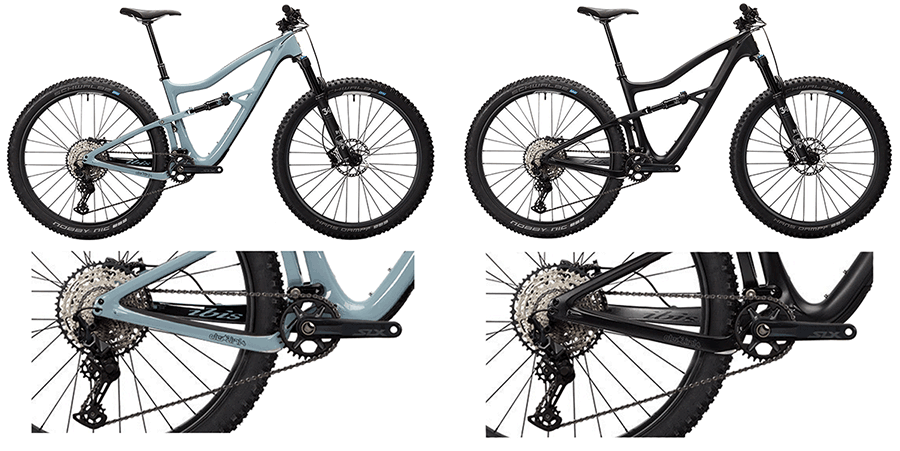
Ibis Ripley – One of the most iconic short-travel playbikes available.
Trail and Cross-Country mountain bikes offer limitless fun on various terrains. There are quite a few different mountain bike types out there, but in this review – we’ll be focusing on the lighter end of the spectrum, bikes that are considered as short travel full-suspension mountain bikes.
- You may also like: 15 Best Full-Suspension Mountain Bikes to Consider
Best Short-Travel Full-Suspension Mountain Bikes
1 . orbea – oiz h20.
Best XC Full-Suspension Mountain Bike

Aluminum / 12-Speed Shimano Deore / 29×2.35″
MSRP: $3,599 Jenson USA
Fork : Fox 32 Float Rhythm, 120mm travel Shock : Fox i-Line DPS Performance, 120mm travel Wheels : Orbea OC1 25c
The Orbea Oiz H20 is a sleek full-suspension XC bike built for speed and efficiency. With a premium aluminum frame, quality components, and World Cup geometry, you’ll be smashing your PRs with the Oiz in no time.
It’s ideally suited to cross-country or long-distance trail riding, with a 12-speed Shimano Deore/XT groupset that includes a 10-51T cassette.
Fox provides both the I-Line DPS Performance shock and the 32 Float Rhythm fork. To complement the lightweight Orbea OC1 rims, you get 29×2.35″ Rekon Race EXO tires.
Head tube angle: 68º / Seat tube angle: 74º / Chainstay: 435mm
Buy on Jenson USA
2 . Santa Cruz Bicycles – Blur C S
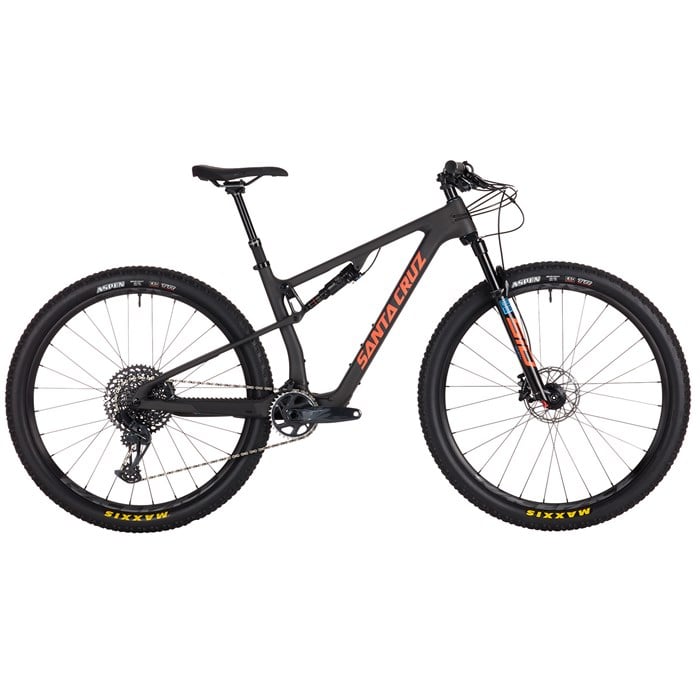
MSRP : $5,549 Evo.com
Fork: RockShox SID SL Select 100mm travel Rear Shock: RockShox SIDLuxe Select+ 100mm travel Wheels: RaceFace AR Offset 29″
The Santa Cruz Blur is the famous MTB brand’s race-ready XC bike, designed to be lightweight, fast, and efficient.
The Blur C S uses Santa Cruz’s more affordable carbon grade, which has excellent stiffness and strength characteristics that help maximize power transfer.
A 100mm travel RockShox SidLuxe Select+ shock is enhanced by a patented SuperLight suspension linkage that keeps the weight low but enhances rear-end traction on trickier sections.
This build comes with a SRAM GX Eagle 12-speed, 10-50T drivetrain with Level TL hydraulic disc brakes. Other notable components include the fast-rolling Maxxis Aspen 2.4″ tires, an SDG Tellis dropper for extra descending control, and lightweight RaceFace AR Offset rims.
Pick the Santa Cruz Blur C S if you’ve got lofty XC ambitions and the budget to match.
Buy on evo.com
3 . Pivot – Mach 4 SL Ride
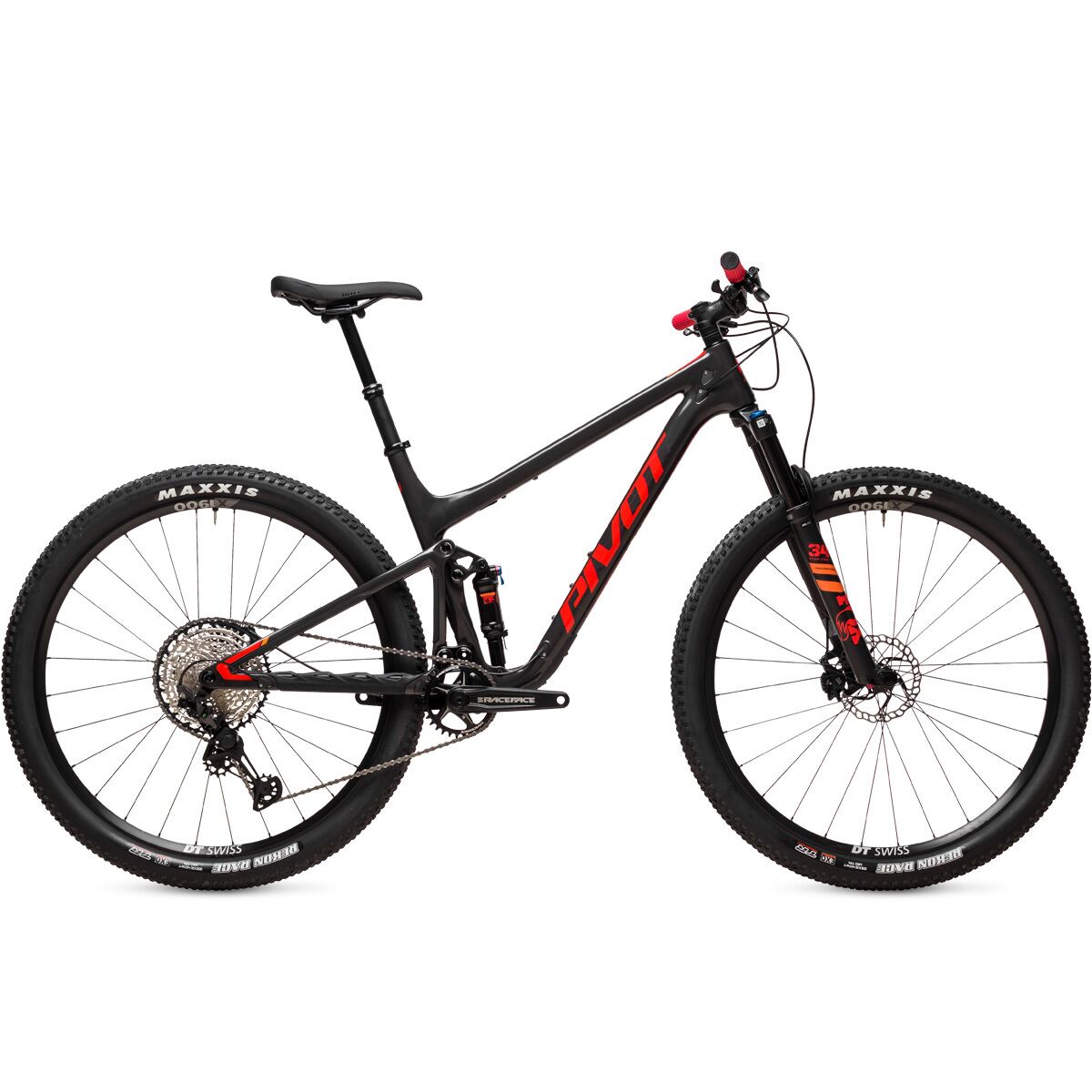
Carbon / 12-Speed Shimano XT/SLX / 29×2.2″
MSRP: $6,199 Competitive Cyclist
Fork : Fox Float 34 Performance Step-cast 120mm Shock : Fox Performance Float DPS 100mm Wheels : DT Swiss X1900 alloy
The Pivot Mach 4 SL Ride is a sleek full-suspension XC MTB by a lesser-know but high-end MTB manufacturer, perfect for racers who want top performance.
The full carbon frame is incredibly light and strong, built for 29″ wheels and DW-Link suspension that perfects anti-squat characteristics for a snappy, responsive feel and extra traction. This model comes with race-ready 2.2″ Maxxis Ardent Race EXO tires.
The Mach 4 SL Ride has 100mm rear and 120mm fork suspension. In addition, you’ll have ample gearing from the 12-speed Shimano XT/SLX drivetrain. Thankfully, Pivot includes a Fox Transfer Performance Elite dropper post with 100 to 150mm travel depending on the size.
Choose the Pivot Mach 4 if you want to take your XC riding to the next level with a bike that’s ready for aggressive riding.
Buy from Competitive Cyclist
4 . Niner – Jet RDO 4-Star
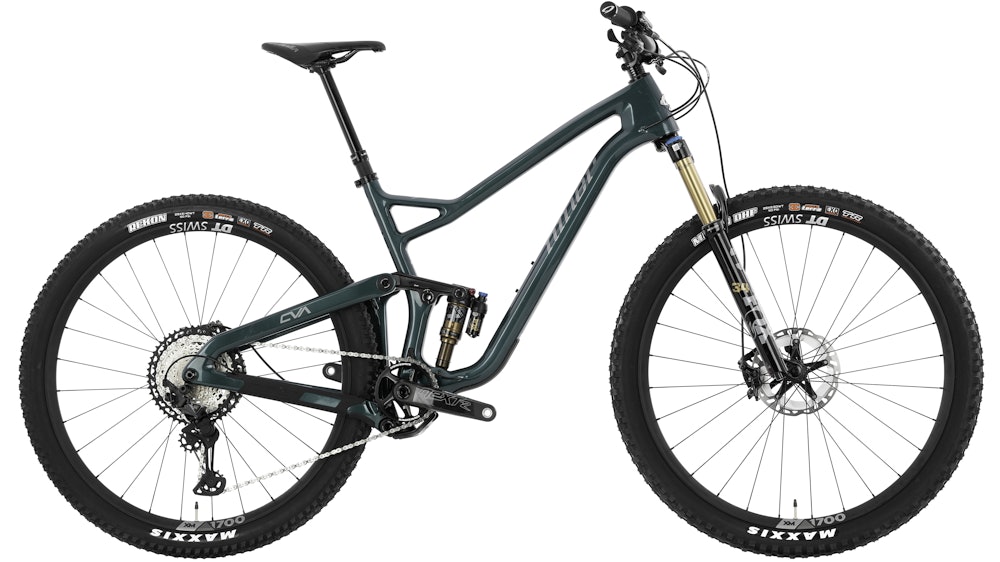
Carbon / 12-Speed Shimano XT / 29×2.6″
MSRP: $6,799 Jenson USA
Fork : Fox 34 Float Factory GRIP2 EVOL 130mm travel Shock : Fox Float X Factory EVOL 120mm travel Wheels : DT Swiss XM-1700 Spline 30
One of the more expensive offerings on our list, this Niner full-suspension mountain bike is a burly trail/XC bike with modern trail geometry and top-quality parts.
The RDO Carbon frame features Niner’s CVA suspension platform, integrated protection, and 2.6″ tire clearance. The 130mm travel Fox Float Factory fork and 120mm Float X Factory shock provide a plush feel on rough trails while the CVA design improves the pedaling efficiency of the system.
A 12-speed Shimano XT drivetrain comes with RaceFace Next R carbon cranks and a 10-51T cassette. 180mm rotor XT hydraulic disc brakes round out the groupset.
An unusual inclusion is the Schwalbe Nobby Nic Addix Speedgrip 2.6″ tires which are very versatile and tough but add a little more weight. Finally, you have a KS Lev SI dropper with 100 or 150mm of travel.
Choose the Jet RDO 4-Star if you want a highly-capable trail/XC bike with innovative design features, solid components, and long-lasting quality.
Head tube angle: 66.5º / Seat tube angle: 76º / Chainstay: 430mm
5 . Rocky Mountain – Element Alloy 30
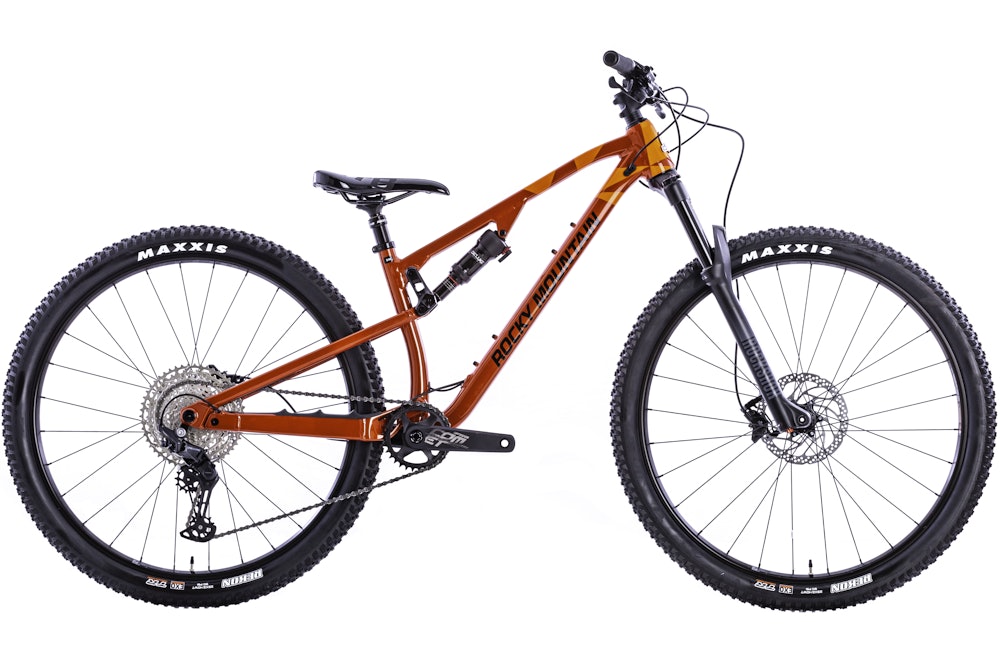
Aluminum / 12-Speed Shimano Deore / 29×2.4″
MSRP: $3,089 Jenson USA
Fork : RockShox Recon Gold 130mm Shock : RockShox Deluxe Select+ 120mm travel Wheels : WTB ST Light i27 TCS 2.0 TR 29″ (27.5″ on XS frame)
The 29″ Rocky Mountain Element Alloy 30 is a cross-country/trail MTB with a do-it-all personality.
The FORM alloy frame has relatively aggressive trail geometry which pairs well with a RockShox Recon Gold 130mm fork, Deluxe Select+ 120mm shock, and Toonie Drop dropper post for confident riding on most trails.
The groupset includes Shimano’s Deore M6100 drivetrain with a 10-51T cassette with MT4100 hydraulic disc brakes. This setup and Maxxis Rekon 2.4 makes climbing easier and descending safer.
Head tube angle: 65º / Seat tube angle: 76º / Chainstay: 436mm
6 . Yeti – SB120 T1

Turq-Series Carbon / SRAM X01/GX Eagle / 29×2.5/2.3″
MSRP: $8,200 Jenson USA
Fork : Fox Factory 34 GRIP2 130mm Shock : Fox Factory Float DPS 120mm Wheels : DT Swiss XM1700
The SB120 is a Yeti full-suspension MTB focused on cross-country and trail riding. This bike has an eye-watering price but has the spec and performance to match.
The Yeti SB120 T1 is built for speed and versatility with 29″ wheels and modern trail geometry. This is balanced by confidence-inspiring and premium 2.5/2.3″ Maxxis Minion DHF/Aggressor EXO tires.
A blended SRAM groupset consists of a 12-speed, 10-52t X01/GX drivetrain that provides reliable and durable performance and G2 RSC four-piston hydraulic disc brakes. The wide gear ratio allows for easy hill climbs while powerful brakes ensure safe descents.
Consider the SB120 T1 if you want a high-end trail bike for tackling a wide variety of trails.
Head tube angle: 66.5º / Seat tube angle: 76.5º / Chainstay: 433-443mm
7 . Co-op Cycles – DRT 3.3
A reliable, affordable XC bike

Aluminum / 12-Speed Shimano SLX / 27.5 or 29 x2.4″
MSRP: $3,299 REI
Fork : RockShox Revelation Motion Control RC 120 or 130mm Shock : RockShox Deluxe Select+ 120 or 130mm Wheels : WTB ST Light i30 TCS
The DRT 3.3 is a cross-country bike with plenty to offer beginner or intermediate XC mountain bikers. It features progressive wheel sizing and suspension travel based on frame size, Airsprung RockShox suspension, and premium Maxxis High Roller or Dissector tires.
This bike has a lightweight but strong aluminum frame that helps keep the price down without sacrificing too much performance. This is boosted by a Shimano SLX 12-speed with a 10-51t climbing cassette and powerful Shimano SLX disc brakes for controlled descending.
Head tube angle: 66/67° / Seat tube angle: 75° / Chainstay length: 433/441mm
Buy on REI.com
8 . Juliana – Wilder C R TR
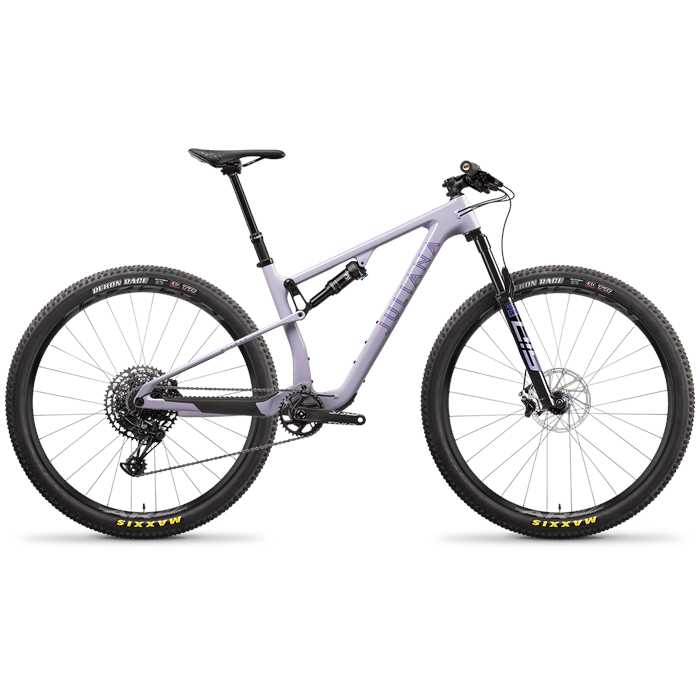
MSRP : $4,899 Evo.com
Fork: RockShox SID RL 120mm travel Rear Shock: Fox Float Performance DPS 115mm travel Wheels: RaceFace AR Offset
Julianna’s Wilder is a race-ready trail bike designed to tackle the toughest trails with confidence. As Santa Cruz’s women-specific brand, Julianna takes advantage of its VPP suspension system to provide the Wilder with unbeatable suspension performance.
Large 29″ RaceFace AR rims and slack geometry allow you to roll over any obstacle on the trail. In addition, female-tailored geometry and a Carbon C frame ensure the Wilder is painless to maneuver.
Finally, this bike is built on an SRAM NX Eagle drivetrain and paired with grippy Maxxis Rekon Race tires and powerful SRAM Level T hydraulic disc brakes to ensure smooth climbing ability and controlled descending.
Buy on Evo.com
9 . Marin – Rift Zone 1
Best value full-suspension mountain bike

Series 3 Aluminum / 11-Speed Shimano Deore / 29×2.3″
MSRP: $1,899 Jenson USA
Fork : RockShox Recon Silver RL 130mm Shock : X-Fusion O2 Pro R 125mm Wheels : Marin Aluminum Double-Wall
The Rift Zone is a 29-inch trail mountain bike designed for speed over fast, flowy trails.
Multi-Trac suspension improves big hit absorption and delivers a more efficient pedaling platform for the 130mm RockShox Recon Silver RL fork and a 125mm X-Fusion O2 Pro R rear shock.
Vee Tire Crown Gem 29×2.3″ tires are durable but lack some grip in the corners and are slightly slow for this type of bike.
The Rift Zone 1 runs a typical 11-speed Shimano Deore drivetrain with Shimano MT201 hydraulic disc brakes and is finished off with a budget alloy seatpost instead of a dropper.
This is a solid XC/trail bike that offers excellent value for money in the entry-level category of full-sus bikes.
Head tube angle: 65.5º / Seat tube angle: 76º / Chainstay: 425mm
Buy on JensonUSA.com
10 . Norco – Fluid FS 2

MSRP: $2,499 Jenson USA
Fork : RockShox 35 Silver R, 130mm travel Shock : RockShox Deluxe Select, 120mm travel Wheels : Stan’s NoTubes Flow D
The Norco Fluid is a full-suspension mountain bike with an innovative progressive frame design for enhanced fit and performance. It features 130mm of front travel and 120mm in the rear, with a reliable Shimano Deore 12-speed drivetrain and matching Shimano MT420 hydraulic disc brakes.
Norco chose Stan’s NoTubes Flow D rims with Maxxis Dissector 2.4″ tires for their excellent grip and durability. For a seatpost, you can rely on an X-Fusion Manic dropper. Every detail is accounted for on the Fluid FS 2, making it an excellent value trail bike.
Head tube angle: 66º / Seat tube angle: 76º / Chainstay: 431mm
Buy from JensonUSA.com
11 . GT – Sensor Sport

Aluminum / MicroSHIFT Advent X, 10-Speed / 29 x 2.3″
MSRP: $2,300
Fork : RockShox Recon Silver, 140 mm Shock : X-Fusion 02 Pro RL 130mm travel Wheels : WTB Aluminum rims
The GT Sensor Sport is a full-suspension trail mountain bike designed to handle almost any trail out there .
This bike can smash climbs and thunder down descents with ease thanks to GT’s LTS rear linkage technology which soaks up trail chatter and improves traction.
The lightweight, durable aluminum frame is fitted with a RockShox Recon Silver RL 140 mm fork and an X-Fusion 02 Pro RL 130 mm shock which offer decent performance for this price range.
This bike takes rolls along smoothly and corners confidently with 29″ wheels wrapped in WTB Breakout 2.3″ tires. Finally, you can rely on a MicroSHIFT Advent X 10-Speed drivetrain for smooth shifting and powerful but inconsistent Tektro HD-M275 hydraulic brakes.
Head tube angle: 65.5º / Seat tube angle: 76º / Chainstay: 435mm
Buy from Jenson USA
12 . Alchemy Bikes – Arktos 120

Carbon / 12-Speed Shimano XT / 29×2.3″
MSRP: from $4,699 Alchemy Bikes
Fork : Fox 34 29 Factory Kashima 130mm travel Shock : Fox DPX2 Factory Kashima EVOL 120mm travel Wheels : Industry Nine 29 Enduro S Hydra
The Alchemy Bikes Arktos 120 is a full-suspension XC/trail mountain bike that’s perfect for riders who enjoy charging uphill and thundering down descents.
The Alchemy carbon frame is ultra-lightweight and laterally stiff, and the seat tube allows longer dropper posts like the stock Fox Factory 175mm Transfer dropper.
The Arktos runs on Alchemy’s patented Sine Suspension dual-linkage platform. This system provides next-level performance through enhanced efficiency on climbs and improved handling and traction on chunky descents. The 130mm and 120mm Fox Factory Kashima suspension soaks up all but the most aggressive hits.
The Arktos 120 comes with a choice of three 12-speed groupsets (Shimano XT or SRAM GX/X01). Each has a hill-crushing cassette and 180mm-rotor hydraulic discs. Finally, burly Industry Nine enduro rims are fitted with Maxxis Minion DHF and DHR 29×2.3 tires, providing plenty of capability but adding some extra weight.
Consider the Arktos if you want high-end performance and an award-winning carbon frame at a reasonable price.
Head tube angle: 65.75-66.5-º / Seat tube angle: 77.75-78.5º / Chainstay: 437mm
Buy on Alchemy Bikes
13 . Pivot – Trail 429 Pro
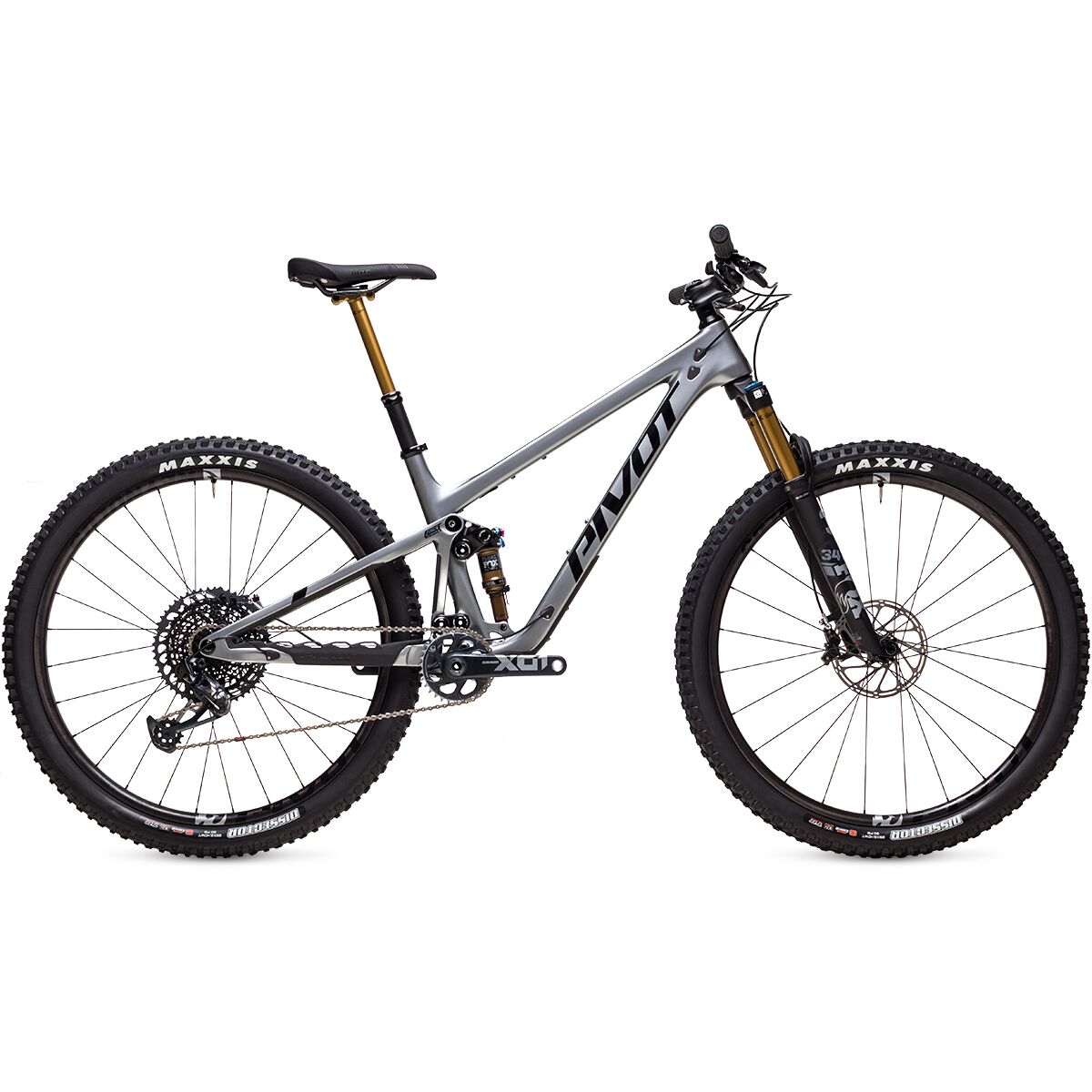
Carbon / SRAM X0 Eagle / 29×2.4″
MSRP: $9,900
Fork : Fox Factory 36 GRIP2 140mm travel Shock : Fox Factory Float X, 130mm travel Wheels : Reynolds Blacklabel carbon
Pivot Cycles is a relatively new bicycle company that has already won awards for its innovative design.
This can be seen on its Trail 429 Pro 29er full-suspension trail/XC bike, a lightweight carbon beast with top-level parts. It’s a professional XC bike for advanced riders, with modern trail geometry in the low flip-chip setting that provides confidence on steep descents.
The suspension is tight, with a Fox Factory 36 140mm fork up front and 130mm Factory Float X shock on the rear. The DW-Link platform and carbon fiber build kit allow you to get more power from each pedal stroke, making this a highly efficient climber.
Using the 12-speed SRAM X0, 10-52t drivetrain you get perfect shifting every time and plenty of gears for steep grades. In addition, the Trail 429 has powerful four-piston SRAM G2 RSC hydraulic disc brakes.
Don’t miss out on the Pivot Trail 429 Pro if you’ve got a huge budget and want unbeatable trail performance to match.
Head tube angle: 66-66.5º / Seat tube angle: 75-75.5º / Chainstay: 430-432mm
Buy from Mike's Bikes
14 . Santa Cruz Bicycles – Tallboy R

Aluminum / 12-Speed SRAM NX Eagle / 29×2.4″
MSRP: $4,199
Fork : FOX Rhythm 34, 130mm travel Shock : Fox Float DPS Performance, 120mm travel Wheels : Race Face AR Offset 30
The Tallboy is of the most popular Santa Cruz full-suspension Mountain Bikes and this version has a tighter, more grounded feel, perfect for attacking bumpy terrain at high speed.
With the Santa Cruz Flip-Chip upper link, you can fit 29″ or 27.5″ rims and tires, although it comes standard with 29×2.4″Maxxis Dissector/Rekon EXO tires on Race Face AR Offset 30 rims.
The 12-speed SRAM NX Eagle groupset runs a wide-ratio 11-50T cassette for easy climbing and includes SRAM Guide T four-piston hydraulic disc brakes.
It’s finished off with a Burgtec Enduro MK3 stem, handlebar, SDT Tellis dropper, and Cane Creek 10 IS integrated headset.
Head tube angle: 65.7º / Seat tube angle: 76.8-76º / Chainstay: 436mm
15 . Juliana – Joplin 4 C R
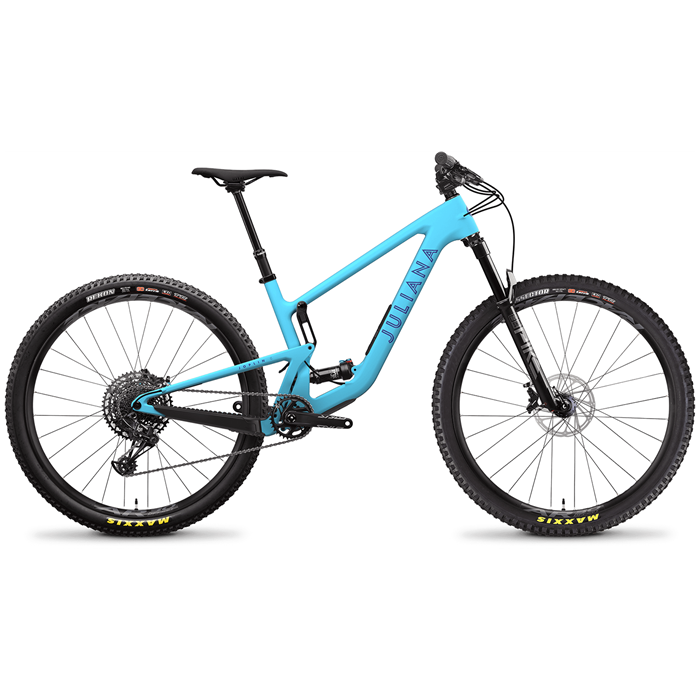
Carbon C / 12-Speed SRAM NX Eagle / 29×2.4″
MSRP: $5,299 Evo.com
Fork : RockShox Pike Base 130mm Shock : Fox Float Performance DPS 120mm travel Wheels : Raceface AR Offset 30
The Juliana Joplin is a women’s full-suspension trail/XC mountain bike built for speed.
The premium Santa Cruz Carbon C frame is fitted with a RockShox Pike Base fork with 130mm of travel and a Float Performance DPS 120mm rear shock. These components are enhanced by the tailored lower-link VPP suspension that improves pedaling efficiency and traction.
The drivetrain is a 12-speed SRAM NX Eagle with an 11-50t cassette for steep climbs and for braking you have SRAM Guide T hydraulic discs.
Finally, the Juliana Joplin 4 C R has an SDG Tellis dropper and 2.4″ Maxxis Dissector/Rekon 3C MaxxTerra EXO tires to provide confidence when descending on fast, chunky trails.
Choose this women’s mountain bike if you love days on the trails with lots of elevation gain and a variety of trails.
Head tube angle: 65.7º / Seat tube angle: 76-76.7º / Chainstay: 430-433mm
16 . Ibis – Ripley AF
🏆 Best all-around mountain bike for every terrain

Aluminum / 12-Speed Shimano Deore / 29×2.4″
MSRP: $3,799 Jenson USA
Fork : Fox Float 34 Performance, 130mm travel Shock : Fox Performance Float DPS, 120mm travel Wheels : Blackbird Send Alloy Max Clearance 2.6″
Coming in at just under $4,000, this is one of those bikes that outperforms its price tag. Straight off the bat, the 12-speed Shimano Deore groupset is impressive with hydraulic disc brakes.
Naturally, it has a premium quality aluminum frame with superb DW-Link suspension technology, offering 120mm of rear travel from Fox Performance Float DPS shock. With a similar kit upfront, you get 130mm of travel on the Float 34 fork, and it’s all rounded off with Blackbird rims and 2.4″ Maxxis DHR II and Dissector tires.
Head Tube Angle: 65.5º / Seat Tube Angle: 76º / Chainstay length: 432mm
17 . Yeti – SB115 C2
CARBON C1 BIKE

Available in 3 designs
Carbon / 12-speed SRAM GX Eagle / 29×2.5″, 2.3″
MSRP: $6,200 Competitive Cyclist
Another top-class mountain bike from Yeti , this combination XC and trail bike attacks both the hills and the drops with equal vigor and aggression. The lightweight carbon frame combined with the 12-speed SRAM GX Eagle 10-52T cassette makes easy work of hills, while the Switch Infinity rear suspension technology combined with 130mm travel on the Fox Performance fork makes downhills a breeze.
You get added support from a thick 2.5″ Maxxis Minion DHF front tire and 2.3″ Aggressor on the rear, wrapped around DT Swiss rims. Oh and let’s not forget the Fox Transfer dropper seat post for added ease and enjoyment!
Head tube: 67.6 / Seat Tube: 74.1 / Chainstay: 437mm
Buy on Competitive Cyclist
18 . Santa Cruz Bicycles – Blur
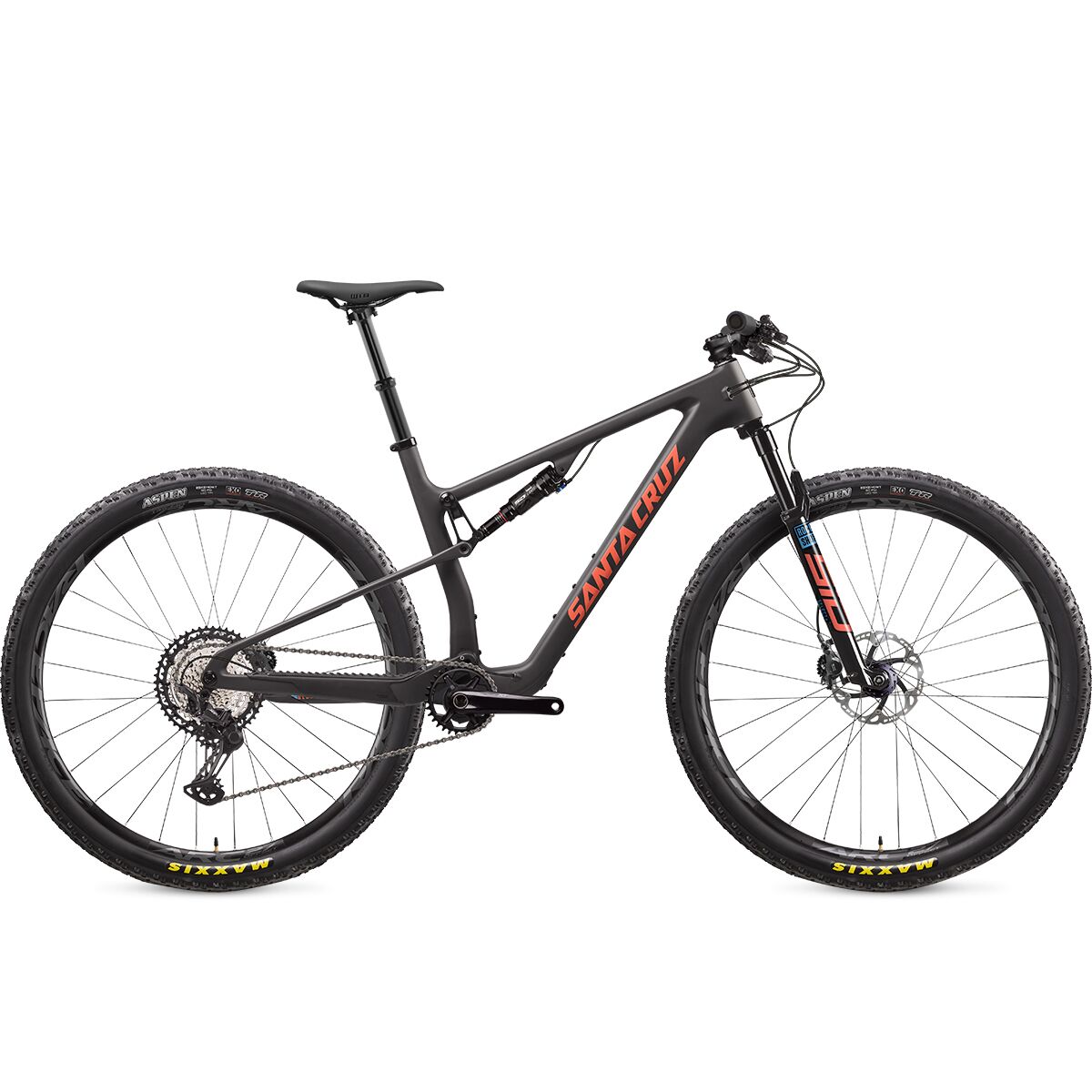
Carbon C / 12-Speed Shimano XT / 29×2.4″
MSRP: $6,599
Fork : RockShox Sid SL Select+ 100mm travel Shock : RockShox SidLuxe Select+ 100mm travel Wheels : Race Face ARC Offset 27
The race-ready Blur XC bike from Santa Cruz is designed for fast riding on cross-country trails.
The SuperLight suspension linkage combined with a 100mm RockShox Sid SL Select+ fork and SidLuxe Select+ shock provides plenty traction on the rougher stuff.
Fast-rolling 29er wheels, Maxxis Aspen 2.4″ XC racing tires, a stiff and lightweight carbon frame, and agile geometry give the Blur its high-performance personality.
The groupset is a 12-speed Shimano XT with four-piston hydraulic disc brakes and plenty of gearing from the 10-51t cassette.
Consider the Santa Cruz Blur if you’re ready to take your XC rides to the next level.
Head Tube Angle: 65.7-65.4 / Seat Tube Angle: 77.5-76.8 / Chainstays: 423-433mm
Buy on Mike's Bikes
19 . Cannondale – Habit Carbon 1
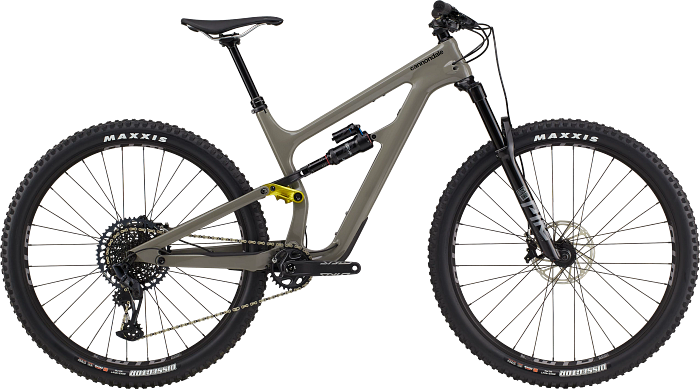
MSRP: $5,500 Planet Cyclery
Every XC rider comes across an unexpectedly steep descent every now and again, leaving them in a precarious situation with an inadequate bike. The Cannondale Habit Carbon 1 rises to this challenge, offering an XC-specific bike that can tackle steep downhills with confidence.
It achieves this with the addition of a Cannondale DownLow dropper post combined with Cannondale’s Proportional Response Tuned suspension system. The RockShox Pike Select+ 140mm fork has slightly longer than usual travel for an XC bike, with the 130mm RockShox Super Deluxe Select+ rear shock to match. A wide-range SRAM GX Eagle drivetrain with a 10-52t cassette and SRAM G2 RSC hydraulic disc brakes make up a solid mountain-ready groupset that can tackle climbs and descents with ease.
HT: 66° / ST: 74.5° / Chainstay: 435mm
Buy on Planet Cyclery
20 . Evil – Following LS GX
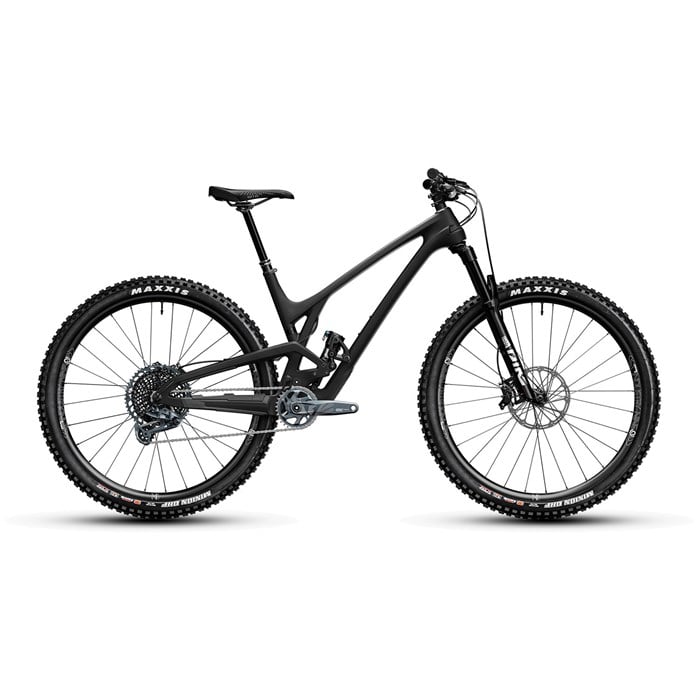
MSRP: $6,450 evo.com
Evil Bikes is known for making high-quality mountain bikes that push the boundaries of design and innovation. The ‘Following’ is its versatile XC offering – a high-speed MTB with 29″ wheels, semi-compact geometry, and mid-range travel that can tackle unusually harsh conditions
The proprietary DELTA suspension system and RockShox Deluxe Ultimate RCT shock are both highly tunable to adapt to varying conditions so if you feel like doing some downhill riding, simply adjust it to your needs and hit the trails. On this version of Evil’s Following, SRAM provides decent 12-speed gearing and instant braking with its mid-level GX Eagle groupset and G2 RS disc brakes.
Where Can You Ride a Short-Travel Mountain Bike?
Short travel mountain bikes are ideal all-rounder bicycles for fast and zippy trails, whether it is flat or hilly.
Downhill mountain bikes with lots of travel are ideal for extremely rough terrain with big drops and large obstacles but provide a disadvantage on flatter terrain.
The less stiff your suspension is, the more speed you lose when riding fast on flat terrain. So you need to choose a bike that best suits the type of riding you intend to do. For most All-mountain, Cross-country, and Trail riding, you shouldn’t need more travel than 100-130mm. MTB bikes with travel between 140-180mm are intended for intense downhill and enduro-style riding.
Of course, many of these bikes have adjustable suspension, so in some cases, you can change it for the terrain of that day. However, if you don’t intend on ever tackling extreme downhills, big jumps, or huge drops, then there is no need to spend the extra on advanced suspension with unnecessarily long travel.
Other Factors to Keep in Mind
Carbon vs. aluminum: which is better.
Which is better: Carbon or Aluminum for a full-sus. MTB? Well, carbon has taken over the whole cycling industry for a while by now, and it is not different from the mountain bike scene. As carbon-tubing gets better each year, there is a reason why mountain bikers prefer carbon over aluminum. Carbon simply has the right ‘feel’ to the whole ride, while providing enough durability and ways to form a bike.
Tires & Tire Pressure
It is recommended to use more air in the rear tire when on trails.
- 29″ – 18-28 psi. Plus-size tires or on wider wheels (Ibis) can be run on lower,11-18 psi range
- 27.5″ (650b) – 16-30 psi.
Lowering your tire pressure means you create more contact with the ground so if you have thin tires, less pressure will provide more grip. However, while this may be a bit more comfortable offroad it comes at the sacrifice of speed on flatter ground. Depending on your weight, you should try to find a perfect balance that isn’t too low or too hard.
Tubeless tires can usually run lower pressure since there is no tube to pinch. Similarly, wider rims can also accommodate lower tire pressure. These are all factors to consider when pumping your tires.
Suspension set-up
You should always tune your suspension correctly to accommodate your weight and riding style. This can be done by rocking up and down on the bike to measure your ‘sag’ rate and then adjusting the air or spring pressure accordingly.
If you’re going to be hitting big jumps or drops, you’ll need a wider, looser suspension to take heavy impact. If you’re riding mostly flat trails, you’ll want it stiffer so you don’t over-compress and lose speed on each little bump.
Compression / Sag / Rebound
The Sag, as mentioned earlier, is important to measure and set accordingly before heading out on the trails. Once that’s done, set the rebound damping by pushing on the front suspension and seeing if you get any ‘bounce’. Tighten it until it only rebounds once, doesn’t bounce up and down.
For the compression settings, you’ll need to specify them according to your riding style. Different shocks have different settings, so it’s down to your style and preference. Basically, add more compression damping if you want tighter traction on corners, or less if you want more absorption on big drops.
Rider Weight
It’s important to get the correct weight distribution on a full-suspension bike otherwise you could injure yourself on the trails. The longer wheelbase a bike has, the more stable it will be, so heavier riders should consider this factor.
Bottom bracket height is also important, as the higher the less stability you get but it can’t be too close to the ground either for obvious safety reasons. Generally, these measurements can all be perfected for you in-store when you buy a new bike. It’s always a good idea to have a professional fit your bike for you.
Share this on:
About the Author

Mark Hartley
Leave a reply cancel reply.
Your email address will not be published. Required fields are marked *


- Cycling Magazine
Top 5 XC and short travel trail bikes for 2022
Bikes that let you go faster and have more fun.

There are a ton of exciting new cross country bikes rolling out in 2022 and, for the most part, they follow a trend. More travel, more relaxed geometry, and more fun mixed in with the traditional light weight and efficiency. As XC bikes gain travel and follow the general trend to progressive geometry, they’re getting closer and closer to the traditional territory of trail bikes. Lines may be blurring, but one thing is crystal clear: all of these bikes are a good time.
What separates a short travel trail bike from an cross country bike these days? Travel numbers mean less than intention these days. Honestly, most of these bikes would be happy pulling double duty. Want to race one weekend and head out on trail shreds or a big epic ride the next? No problem. All of these bikes are efficient enough to ride with intention but still solidly build to slow down, cruise through corners and hunt for fun side hits instead of always sticking to the race line.
Top five 2022 short travel mountain bikes
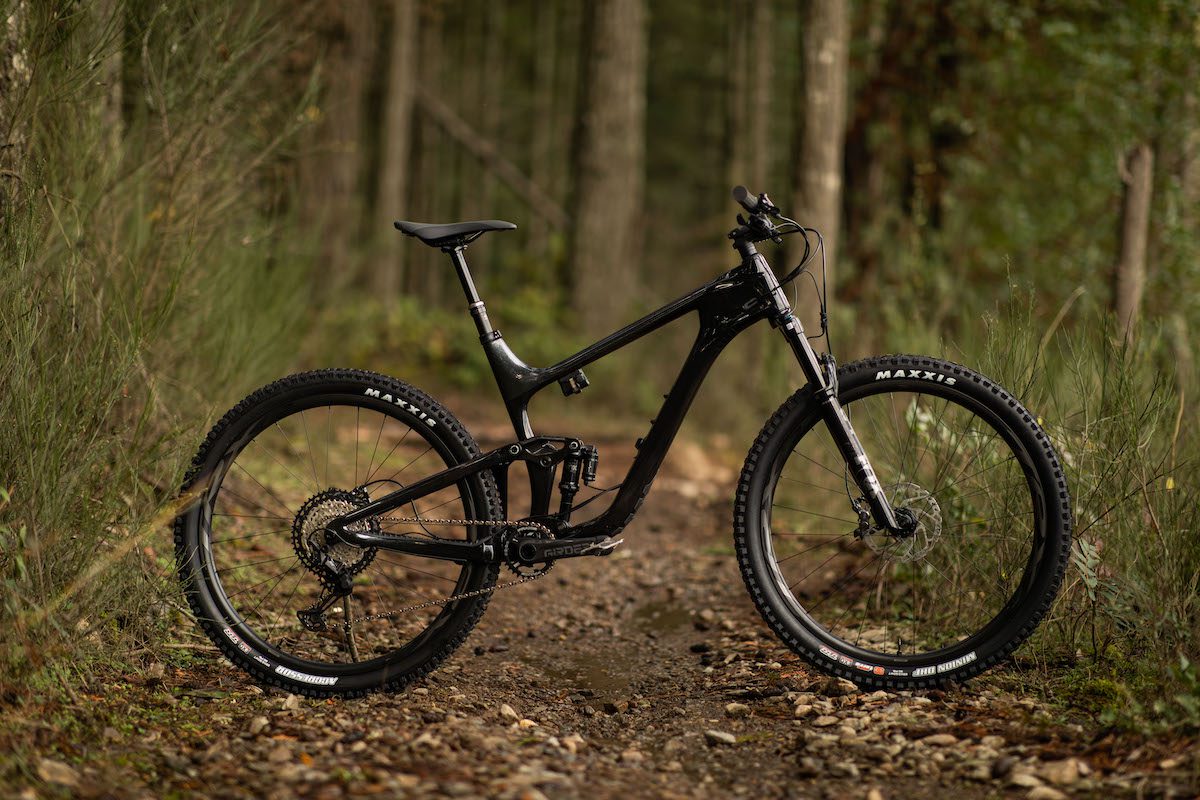
Giant Trance Advanced Pro 29
Giant is clear that the Trance isn’t an XC race bike but its travel numbers, 120-mm out back with a 130-mm front, put it in the short travel category. Instead, it’s focused on maximizing enjoyment while climbing and descending. Paired with Fox’s Live Valve electronic suspension technology, it’s a spry and responsive ride that makes even the most mellow trails exciting while staying composed when the going gets rougher.
RELATED: First look: 2022 Giant Trance Advanced Pro 29
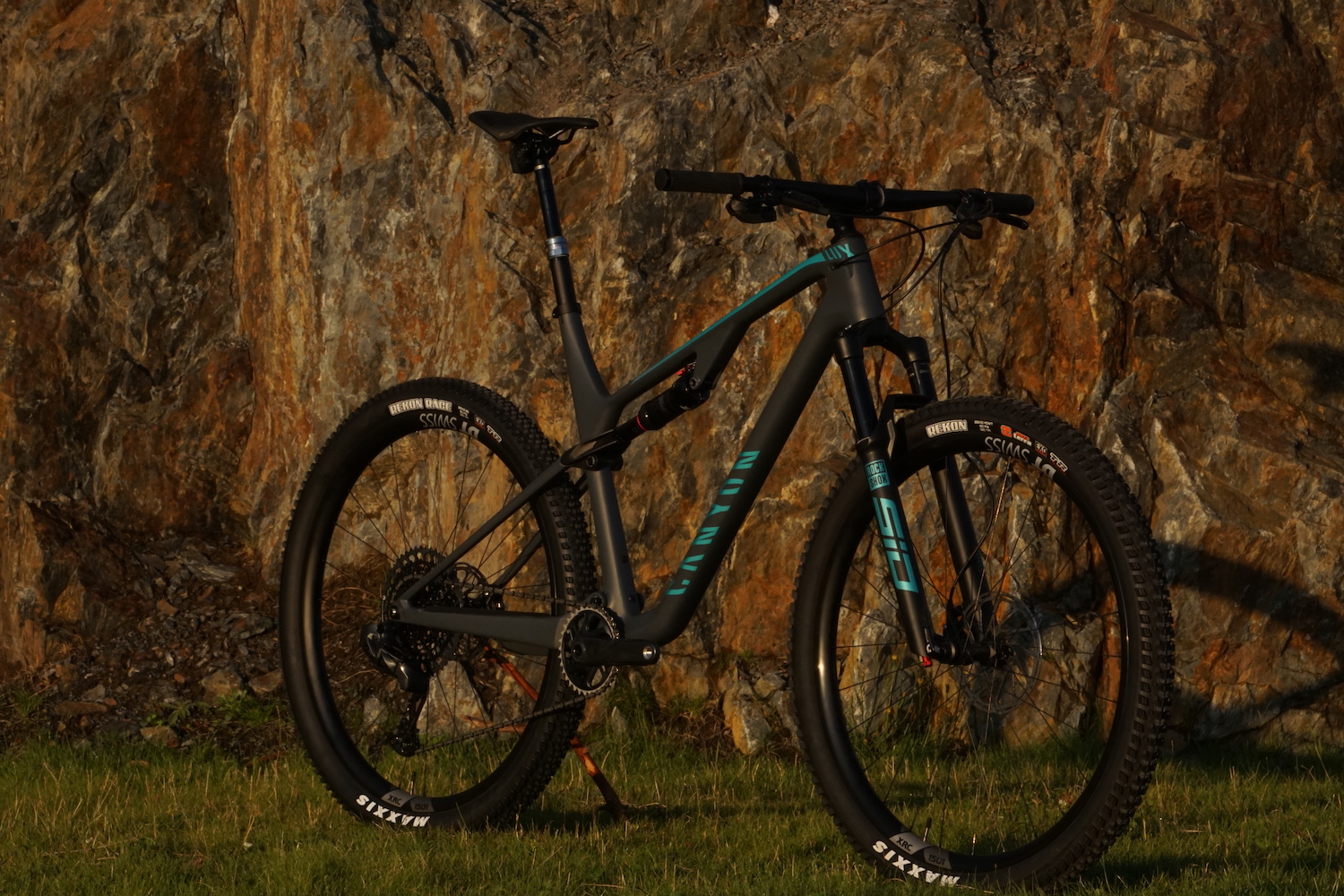
Canyon Lux Trail
Canyon takes its World Cup pedigree Lux and adds a bit more forgiveness and a bit more fun and calls it the Lux Trail . It’s still whip-fast and highly capable as a cross country race bike, especially for marathons or stage races. But, with slightly more relaxed geometry and an extra 10-mm geometry, it’s more enjoyable to ride on days when you’re not racing or when you venture onto more challenging trails. The Lux Trail doesn’t shine less than the pure-race Lux SL, just glows with a little different light.
RELATED: Canyon Lux Trail adds travel without losing race pedigree
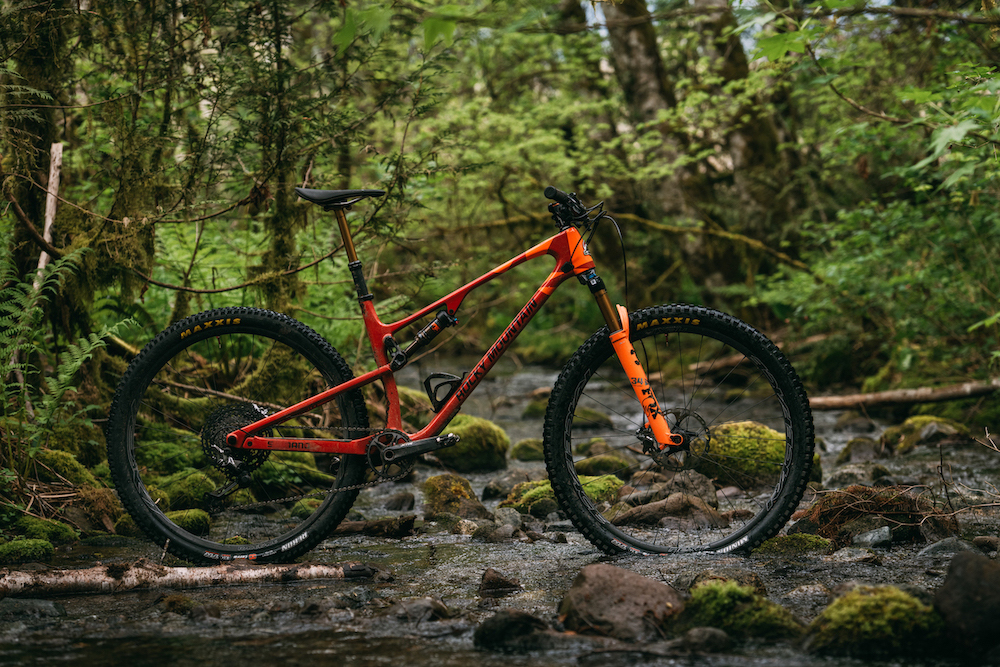
Rocky Mountain Element
Traditionally Rocky Mountain’s cross country race bike, the Element gets a major re-invention for 2022 . It’s still a cross country race bike, if your idea of cross country includes the roughest trails and rowdiest stage races around. At 120-mm rear travel and 130 front, this lightweight XC-whip is ready for whatever trails you throw at it. With space for two water bottle cages in the front triangle and a longer dropper post, the Element is all set to take you on big adventures or short track races.
RELATED: Rocky Mountain rolls out sleeker, more powerful Element
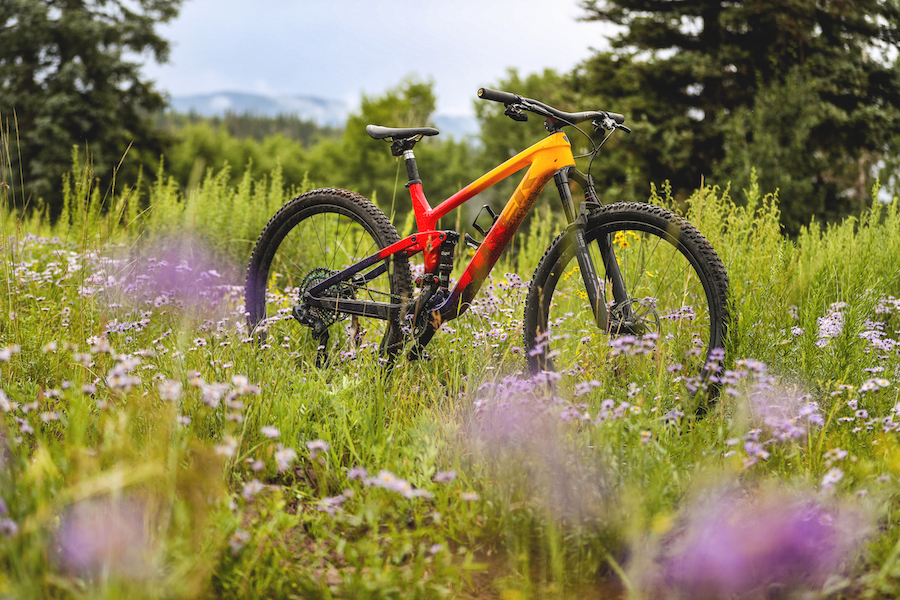
Trek Top Fuel
With the Supercaliber laser-focused on racing, Trek frees the Top Fuel to roam farther afield . The bike’s cross country heritage still shines through in efficient pedalling and sharp handling but, with balanced 120-mm travel and more progressive geometry, the Top Fuel is more comfortable and more capable than in years past.
RELATED: Trek trail tunes the Top Fuel
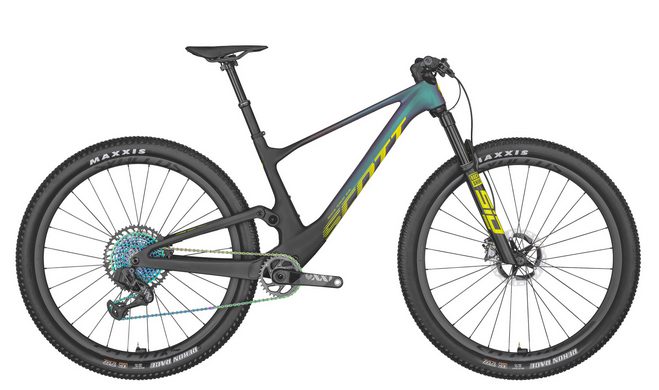
Scott Spark 120
Scott’s world championships-winning cross country race bike looks a little different than most. Cleaner, even when it’s covered in mud. That’s because Scott’s gone all-out on the engineering, creating a sleek looking frame that hides cables, hoses and even the rear shock out of sight. It’s also part of the new breed of XC bike hitting the 120-mm travel range, front and rear, to keep pace on the new-school World Cup tracks. Looks pretty. Goes fast (or at least Nino Schurter does). Might not be the easiest to wrench on at home, but who cares when you’re winning races, right?

- Email address: *
- Email This field is for validation purposes and should be left unchanged.
Looking for ways to get better at overhangs? Ask Scout, our new AI chat.
BEST WEEK EVER
Try out unlimited access with 7 days of Outside+ for free.
Start Your Free Trial
Powered by Outside
The Best Mountain Bikes of 2022
Rigs to put a smile on anyone’s face.
- Share on Facebook
- Share on Reddit
Heading out the door? Read this article on the new Outside+ app available now on iOS devices for members! >","name":"in-content-cta","type":"link"}}'>Download the app .
Specialized S-Works Turbo Kenevo SL ($15,000)
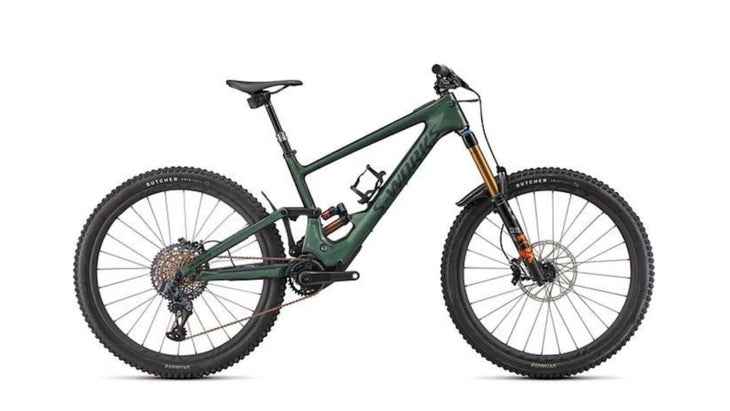
Say what you will about Specialized and its $15,000 e-bikes, but damned if the brand doesn’t make a good $15,000 e-bike. The Kenevo SL provides just enough assist with its 240-watt, 35-newton-meter SL motor. It’s not the sort of e-bike we could soft-pedal up every widowmaker climb, but this 42-pound welterweight monster with 170 millimeters of travel (front and back) is remarkably capable and handles much like a traditional bike. The motor’s main benefit is getting us to more downhill, though it makes technical climbs and descents a lot more fun too. That’s because the extra sprung weight makes a steady bike even steadier, without feeling like the juggernaut that so many full-powered e-bikes are. (Still, the lower-link Enduro suspension system is plenty supportive, even with a motor and battery to carry.) Hopefully, this is a sign of things to come.
Cannondale Jekyll 1 ($6,100)
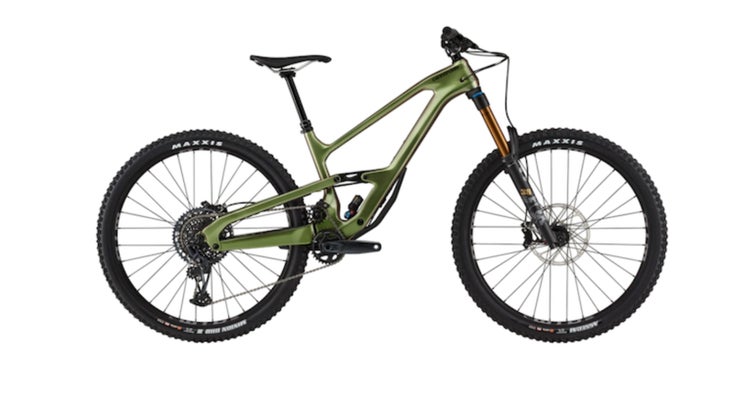
We rode no fewer than six high-pivot bikes in the past year. Each of them was good in its own way, but the Cannondale Jekyll was good in the most ways. While some bikes in this subcategory were sluggish on the climbs, the Jekyll was smooth and efficient. That feel, paired with the high-pivot platform’s natural ability to track the ground and maintain momentum, makes the Jekyll a bike we could actually live with long-term as an everyday ride. Point it downhill, and it’s every bit as bloodthirsty as we’ve come to expect a high-pivot bike to be. But, critically, it never felt like it was riding us, as may similar rigs can. Cannondale’s designers also designed each size frame separately, making subtle tweaks to each, which meant that testers from five-foot seven to six-foot two all noted the same thing on their rides: this bike rips. And, if all of that isn’t enough, you can also get into the full-carbon Jekyll 2 starting at $4,500.
Sponsor Content Canyon Bicycles Spectral 125 CF 9 ($6,299)
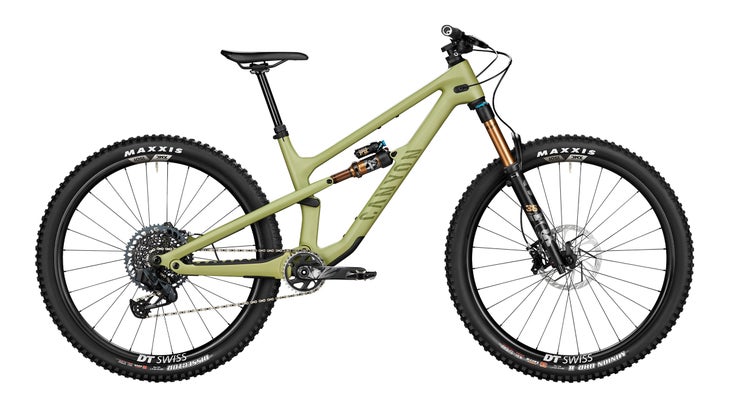
Short on travel, big on shred. The Spectral 125 is one of the most capable, short-travel 29ers on the market. With a quick-climbing, ultra-efficient pedaling performance and progressive geometry to boost your confidence on descents and rough terrain. Experience pure trail riding fun!
Orbea Rallon M-Team ($7,999)

Maybe the high-pivot revolution isn’t your scene. Thankfully, not all top-end enduro bikes are going that way. Exhibit A: the Rallon. This rig was still one of the most capable bikes we tested, but somehow the 160-millimeter rear-travel 29er never felt like too much bike. It’s the sort of enduro ride that likes to goof off once in a while, with a supportive suspension and reasonable geometry numbers. And in case you really want to have fun, every Rallon comes with an extra suspension link that allows you to swap in a 29-inch rear wheel. This bike is full of nice little touches like that. Other welcome features: the extra-robust pivot hardware and bearings, hidden tools inside those pivots, and deep customization options, from technical components like wheels and shocks to aesthetic elements including the color of every part of the frame. As a result, the bike takes some time to produce, but we’re all used to that by now.
Ibis Ripley AF Deore ($3,200)
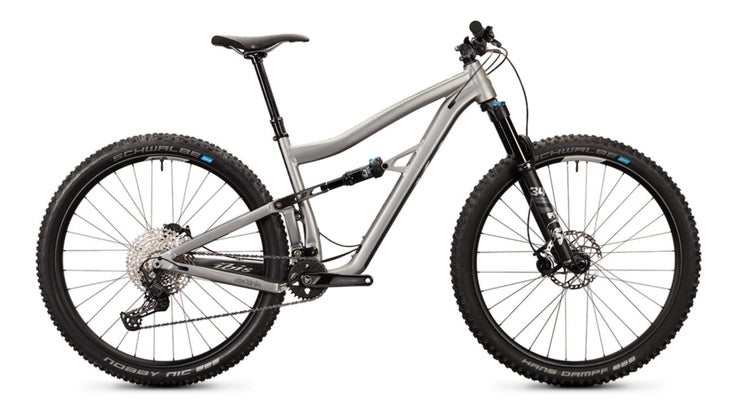
Following up on its successful Ripmo AF (Aluminum Frame), Ibis has given the same slightly-more-aggressive, much-more-affordable treatment to the Ripley. Since the Ripley AF has a slacker head angle and a supportive suspension feel, our testers considered it to be in the same league as the Santa Cruz Tallboy or the Transition Spur. The big difference is that you can get into a Ripley AF for a base cost of $3,200. That relatively reasonable price tag buys you Shimano’s Deore 12-speed drivetrain, two-piston Deore brakes, and a Fox 34 Performance Elite fork, none of which needs an upgrade out of the box. But all of those features are just the icing on the cake. The cake itself is the Ripley’s incredibly dialed DW-link suspension, together with the bike’s supernatural mix of traction and efficiency on the climbs. And thanks to smart specs and geometry, it’s just as otherworldly on the descents.
This post contains affiliate links, primarily provided by our priority partner REI.com . We may earn a commission if you buy through these links. Read more about our policy.
Popular on Climbing
"The Nutcracker" explores the mental challenges of solo climbing and the tactics Cornell used to help him send the route.
- climbing films
- Documentary
- Ice Climbing
Related content from the Outside Network
How climbing and rock and ice are stronger together, climbing book club: the climbing staff discusses peak nutrition, summit roundtable podcast: demonstrations at crags, summit roundtable podcast: climbing competitions return.

Santa Cruz Tallboy Review
by Kyle Scott | Jan 4, 2021 | Bike , Mountain Bikes , Short Travel Mountain Bikes
Table Of Contents
Build options.
- The Bottom Line
- Price Comparison
Best Downhill Short Travel Bike of 2021
- Climbing Ability 80% 80%
- Downhill Ability 100% 100%
- Overall Fun 90% 90%
Travel: 120mm rear/130mm fork
Head Tube Angle: 66.5
Seat Tube Angle: 76.2
Reach: 470mm (large frame)
Weight: 30.63 lbs
Price: $6,999
What We Like: Downhill ability
What We Don’t: A bit heavy
Built to be a charger on the downhill, the Tallboy does not disappoint. With a Trail frame but an Enduro mindset, this bike seems like it can do it all. Sure, it does not climb as well as the Ripley or the Fuel, but you will never hit a corner as fast on those bikes as you will on the Tallboy. With three styles of frame material and a huge variety of build options, the Tallboy is a great option for riders who may spend more time in the tailgate of their buddy’s truck than pedaling to the top of the mountain. It will do the climbs, but the downs are where the real fun is at, so we named the Tallboy the Best Downhill Short Travel Bike of 2021 .
Compare to Similar Products
See Our Best Short Travel Mountain Bike Review 2021

Ibis Ripley
Buy Now at Ibiscycles.com
Compare Best Prices
- Climbing Ability 90% 90%
- Downhill Ability 90% 90%
Upgraded Rear Suspension
Bottom bracket has had some issues.
Seat Tube Angle: 76
Reach: 475mm (large frame)

Santa Cruz Tallboy
Buy Now at Backcountry.com
Downhill Ability
A bit heavy.

Marin Rift Zone
Buy Now at Marinbikes.com
- Downhill Ability 80% 80%
Budget All Day Rider
It is heavy.
Head Tube Angle: 66.6
Reach: 480mm (large frame)

Revel Ranger
Buy Now at Worldwidecyclery.com
- Climbing Ability 70% 70%
- Overall Fun 80% 80%
Downhill Prowess
Seat angle could be steeper.
Head Tube Angle: 67.5
Seat Tube Angle: 75.3
Reach: 473mm (large frame)

Norco Optic
Buy Now at Norco.com
App To Dial In Custom Suspension Settings
Slow on climbs.
Head Tube Angle: 65

Evil the Following
Buy Now at Evil-bikes.com
DELTA Link Rear Suspension
Expensive build options.
Head Tube Angle: 67.9
Seat Tube Angle: 77

Yeti SB 115
- Downhill Ability 70% 70%
New Rear Linkage
Not different enough from the yeti sb100.
Head Tube Angle: 67.6
Seat Tube Angle: 74
Reach: 450mm (large frame)

Trek Fuel EX
Buy Now at Trekbikes.com
Down Tube Storage
Suspension sag while climbing.
Head Tube Angle: 66
Seat Tube Angle: 75

Orbea Occam
Buy Now at Jensonusa.com
Upgraded Rear Suspension, Customized Colour Options
Left hand only water bottle access.
Reach: 474mm (large frame)

Trek Top Fuel
- Climbing Ability 100% 100%
- Overall Fun 70% 70%
Super Lightweight
Knock block in headset.
Head Tube Angle: 68

Banshee Phantom
Buy Now at Bansheebikes.com
High Quality Components
Seat Tube Angle: 76.6
Reach: 470mm

Specialized Stumpjumper ST
Buy Now at Specialized.com
New Rear Suspension Linkage, SWAT Bottom Bracket Storage
Seat Tube Angle: 74.5

Alchemy Arktos ST
Buy Now at Alchemybicycles.com
High Quality Build Components
Low bottom bracket, under bottom bracket water bottle attachment..
Head Tube Angle: 66.1
Seat Tube Angle: 75.5
Reach: 454 (large frame)
The capability of short travel bikes is becoming wildly impressive and with the new Santa Cruz Tallboy , as things are getting dialed. It is available in three different frame materials, so that no matter your budget, you can ride this trail basher. Santa Cruz is raising the bar when it comes to the short travel 29” world.
The new Tallboy comes with 120mm of rear travel on a new (but borrowed) lower-link VPP suspension system and a 130mm fork to give you the ultimate experience no matter what the trails throw at you. While being compared heavily to the Trek Fuel and the Ibis Ripley , the Tallboy really stands alone as a descender and is built for ultimate confidence while catching air or taking corners way too fast. This is why we named it the Best Downhill Short Travel Bike of 2021 .

Now available in three frame materials: aluminum, carbon C, and carbon CC, the Tallboy is affordable to a whole range of riders. The new lower-link VPP suspension layout has opened up the frame triangle. The lower shock mount also comes with a flip chip that can flip into HI or LO mode and will make all of 0.2-degree of difference in certain aspects of the geometry. The largest difference it’ll make is 3mm of bottom bracket height change. So it won’t change your world, but at least the option is there. Santa Cruz has added a ribbed chainstay protector to keep things quiet and a wee little fender that protects the Fox shock from the muck that you’ll be ripping through in no time.

With a steeper seat tube angle, 76.2-degrees, the Tallboy handles like a traditional XC bike on the uphills. The Tallboy may not be able to compete with the Ripley on the climbs but every bike has its nuance. The Tallboy is super easy to manage at low speeds and has a very efficient suspension while climbing. The shortened chainstay helps to keep the back end under control, and the new seat tube angle allows for you to keep the weight on the front wheel and keep it on the ground too.

Here is where the Tallboy shines. With the bottomless feel provided by the rear suspension and a slack head tube, 65.5-degrees in the LO setting, the Tallboy likes to cruise downhill and to do so quickly. This bike is right in that sweet spot of XC bike meets Enduro—the climbing ability coupled with total confidence riding downhill. It is a poppy bike that just wants to party and show you a good time on the way to the after-party.

There are seven build options for the Tallboy. Two of the options come on an aluminum frame, starting at $2,799 for the D version and going up to $3,399 for the R build. There are then three Carbon C frame options ranging from $4,199 to $5,999, each coming with different cassettes, brakes, forks, etc. The final two versions are made with Carbon CC. The X01 build has a wired drivetrain, and the XX1 RSV comes with the SRAM XX1 AXS wireless drivetrain and will set you back $10,499.
Along with the prebuilds, there is an aluminum frame only price of $1,999 and a Carbon CC frame only price of $3,099.

What is the difference between Carbon C and Carbon CC? Well Carbon CC is just a bit lighter but just as stiff, and that is all there is to it. Without going into too much detail, it is worth checking out the website to figure out what you’re willing to spend on a bike. Are you after the lightweight carbon frame or will a better drivetrain on an aluminum framework for you? I do like that Santa Cruz has offered an aluminum frame just so that more people have an opportunity to try out a full suspension ride and enjoy the great outdoors.

The Bottom L ine
The Santa Cruz Tallboy could become a one quiver bike for the right rider. It rides just fine on the way up hills with great handling with a responsive suspension. Unless you’re truly bombing down some wild roots and nasty chunder and need that massive travel, the Tallboy can handle just about anything you throw at it. The geo is set up for all-day in-saddle comfort, and downhill riding on this bike is just so much fun. All of these reasons made the decision easy to name the Tallboy the Best Downhill Short Travel Bike of 2021 .
It may not be as light or as good of a climber as the Ibis Ripley, but the downhills is where the Tallboy shines and shows its true colors. It is poppy and feels more bottomless than the Ripley, which seems hard to do. The Tallboy keeps you in a great position while you’re flying off terrain and kickers, hitting the landing, and hungry to dive into some berms and brown powder.
With a variety of frame composite types and build setups, the Tallboy is affordable for a variety of riders and just wants to get you outside having a good time.

Compare Prices From Retailers Below
You help support Gear Hacker by purchasing from our retail partners.
You Might Also Like

Best Short Travel Mountain Bike Review 2021

Norco Optic Review

Ibis Ripley Review

Evil the Following Review

Specialized Stumpjumper ST Review

Orbea Occam Review
^ Back to Top ^
- Register New User
- First Looks
- Friday Fails
- Community Blogs
- Fantasy League DH
- Places Directory
Video: Welcome to the 2022 Downcountry Field Test
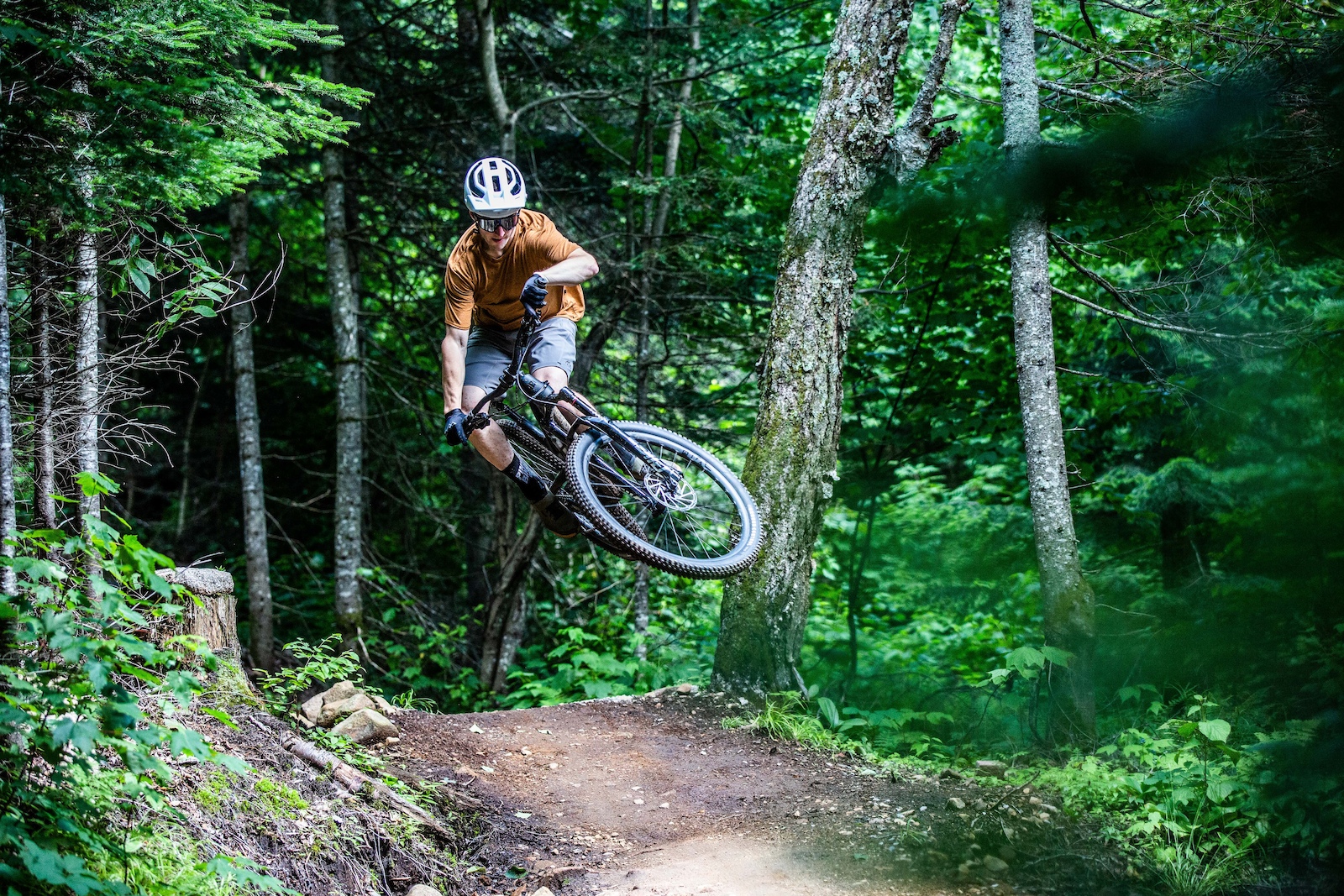
Cool Features

7 Best Trail Mountain Bikes of 2024
For versatile bikes that can tackle long climbs and moderately technical descents, we break down the year’s top trail models.
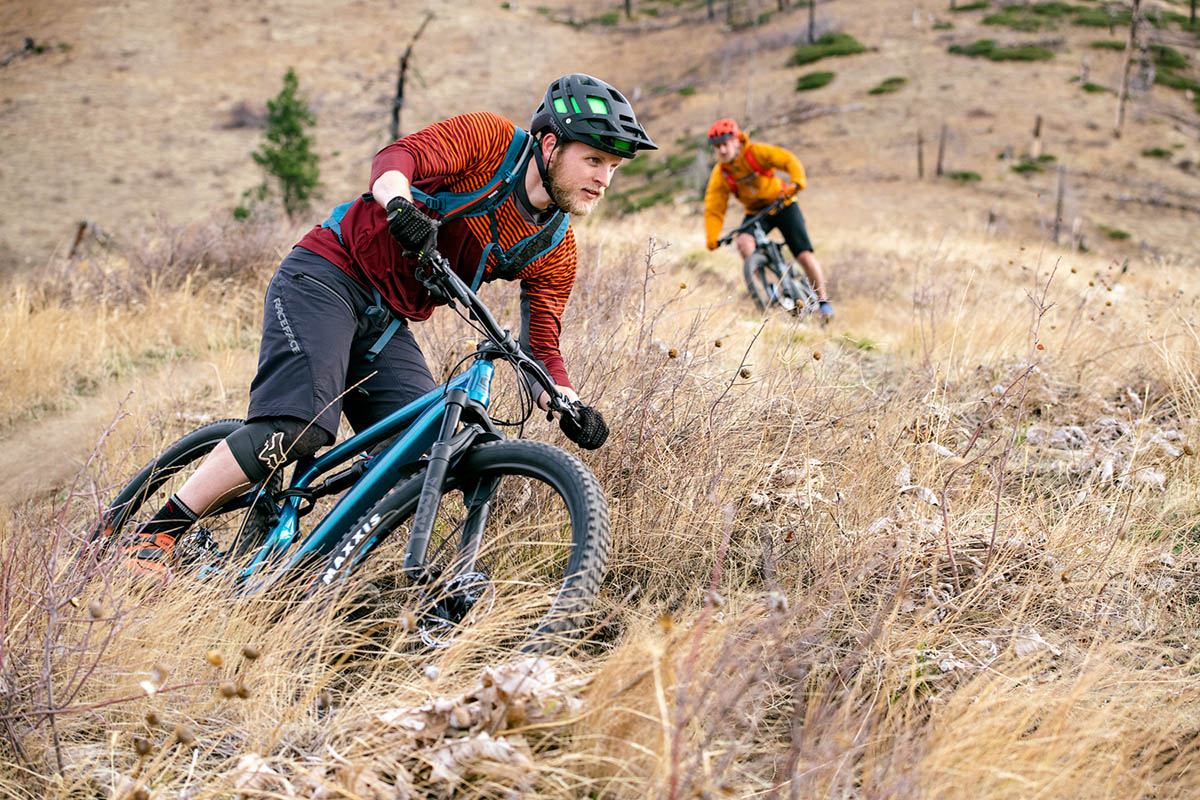
Switchback Travel ( Jason Hummel )
We use affiliate links and may receive a small commission on purchases. Read more about us .
From smooth and flowy post-work rides to rough and rowdy all-day backcountry epics, the trail mountain biking category covers a wide range. And with rapidly changing technology and an ever-growing number of options, it can be hard to nail down the best ride for your needs. We’ve been testing designs from beginner-oriented hardtails to fast and fun full-suspension rigs since 2021, and below we outline our top seven picks for 2024 broken down by type and best use. Finally, we firmly believe your mountain bike should cost less than a down payment on a house, so we’ve capped the price at $6,000 on sale. For more background information, see our buying advice and comparison table below the picks.
Editor’s note: This guide was updated on June 26, 2024, with an overhauled list of picks to reflect 2024 offerings. We also included information about our testing practices and swept the guide to ensure all information was up-to-date at the time of publishing.
Our Team's Trail Mountain Bike Picks
- Best All-Around Trail Mountain Bike: Santa Cruz Hightower S
- A Close Second (That's More Playful & Customizable): Specialized Stumpjumper Evo
- Best Downcountry Trail Bike: Specialized Epic 8 Evo Comp
- Best Hardtail for Trail Riding and Bikepacking: Salsa Timberjack XT 29
- Best E-Mountain Trail Bike: Specialized Turbo Levo Comp Alloy
- Best Value in a Full-Suspension Trail Bike: Ari Cascade Peak Pro
- Best Entry-Level Trail Bike for Beginners: Salsa Rangefinder Deore 11 29
Best All-Around Trail Mountain Bike
1. santa cruz hightower s ($5,899).
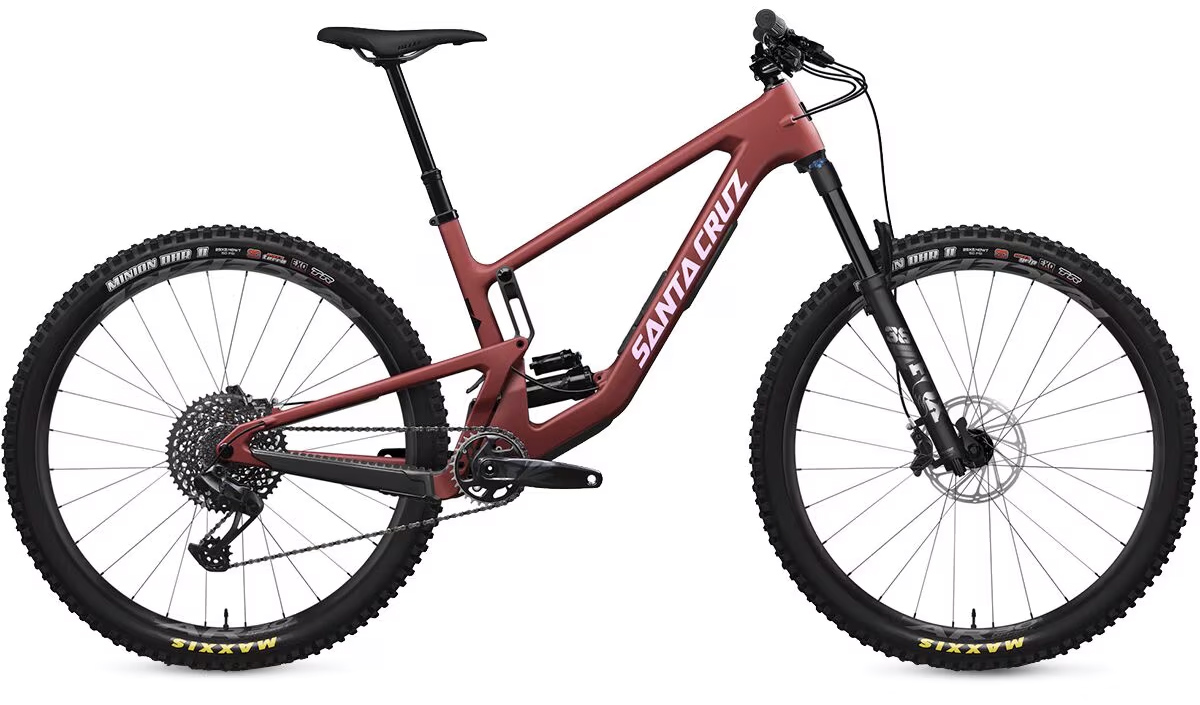
With high-end bikes growing increasingly expensive each year—four on this list alone are $5,000 or more—it’s no wonder that lots of folks are looking for one bike to do it all. Santa Cruz’s Hightower is exactly that: a well-rounded and highly capable rig that can handle almost any terrain you throw its way. Highlights include a reasonably light carbon build, a fantastic SRAM GX Eagle drivetrain, 29-inch tires that smoothly roll over rocks and roots, and a just-right amount of suspension (150mm up front and 145mm in the back) to balance long stints of uphill pedaling and steep, technical descents. In short, the Hightower is a point-and-shoot downhill machine that doesn’t skimp on climbing performance, striking a hard-to-beat balance for many riders.
Santa Cruz does have a reputation for high prices, and the Hightower is no exception. That said, the brand’s lifetime warranty on its frames is one of the best in the business, and the bike is built to last with high-quality components throughout. It’s not the strongest climber out there—for that, we turn to lighter and more flickable designs like Yeti’s SB135 —but the Hightower puts it all together better than most at a much cheaper price point than the Yeti, earning it our top spot this year. It’s also worth noting that you can upgrade to a smoother, more consistent, and easier-to-maintain wireless drivetrain (with the GX AXS build kit) for $5,599 at the time of publishing. See the Santa Cruz Hightower S
A Close Second (That’s More Playful and Customizable)
2. specialized stumpjumper evo expert t-type ($6,300).
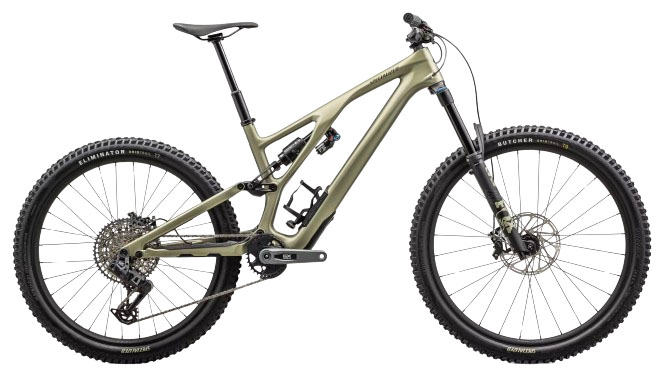
The Stumpjumper has a storied history in the world of cycling: It was the first mountain bike made for the masses and helped popularize the sport, and Specialized has had decades to dial in overall performance and refinement. The mid-range Evo Expert T-Type model is a real winner, particularly for those who put a premium on downhill prowess. Compared to the Hightower above, the Stumpjumper offers a bit more squish, along with a mullet setup—a 29-inch tire up front and 27.5-inch tire in the back—for added playfulness on the descent. And we’d be remiss not to mention the adjustable geometry, which offers the ability to fine-tune the head tube angle (by 2 degrees) and bottom bracket height (by 10mm) to suit your needs and riding preferences.
What’s not to like with the Specialized Stumpjumper Evo Expert T-Type? In addition to the steep $6,300 price tag, the bike is no featherweight at nearly 33 pounds and not a particularly strong climber—if gnarly downhills aren’t at the top of your priority list, there are plenty of more well-rounded options to consider, many of which are cheaper (including the Hightower above). The mullet setup is also a little polarizing and does take some getting used to, although we’ve come to love the best-of-both-worlds compromise. For a similarly burly option at a slightly cheaper price point, we also love Santa Cruz’s Bronson ($5,899), although the Stumpjumper Evo gets the slight edge in overall refinement with a higher-quality fork and shock. Again, it’s not the best all-rounder out there but is an excellent tool for soaking up bumps on technical terrain and hitting features at your local bike park. See the Specialized Stumpjumper Evo Expert T-Type
Best Downcountry Trail Bike
3. specialized epic 8 evo comp ($5,000).
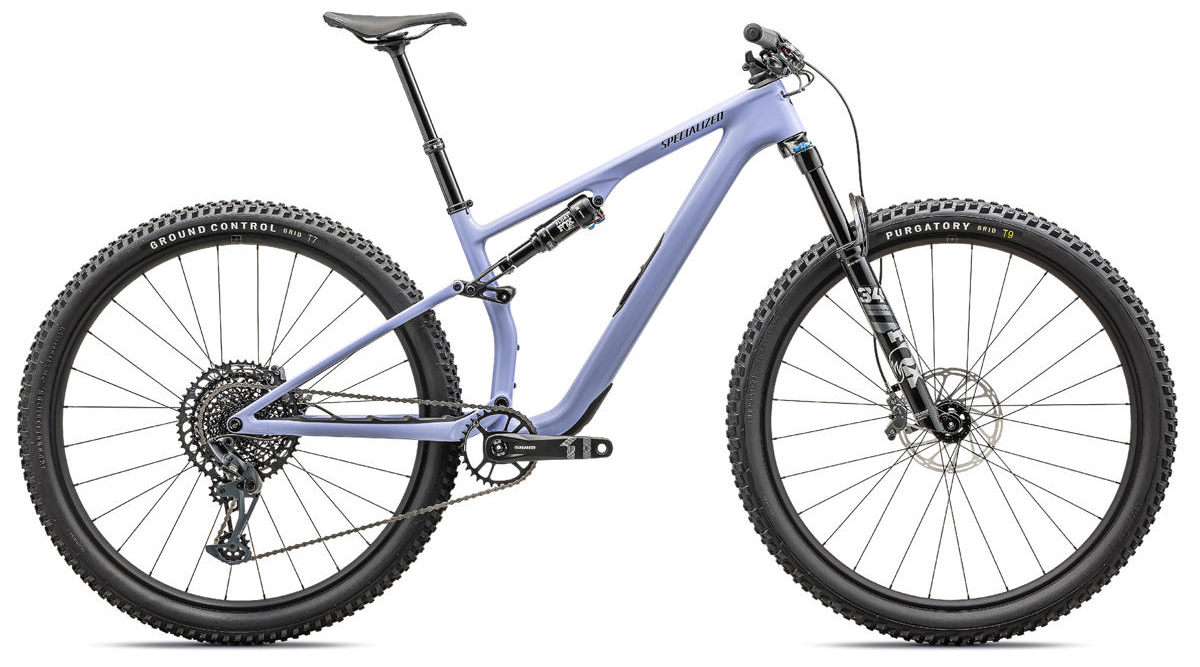
One of the latest buzzwords in mountain biking, “downcountry” bikes are purpose-built for efficiency, with lightweight carbon frames, trail-friendly geometry, and shorter travel than all-rounders like the top-ranked Santa Cruz Hightower (they're essentially more downhill-friendly XC rigs, hence their name). In other words, whereas the options above emphasize downhill performance, these bikes are all about the up. The Epic 8 Evo Comp from Specialized is our current favorite in this growing category. Listed at around 28 pounds (for a medium frame), it’s a competitively light and fast build that nicely blends the agility and speed of a cross-country rig with the capability of a trail bike. In sum, it’s an ideal companion for big days in the alpine, snagging local singletrack KOMs on Strava, or if your local terrain involves a lot of long, pedal-intensive climbs.
Other than sacrificing some downhill performance for climbability, the biggest downside here is cost: Specialized bikes don’t come cheap, and the Epic Evo 8 Comp is a relatively steep investment at $5,000. If you’re on a tighter budget, consumer-direct pioneers Canyon and YT Industries also make compelling—and more wallet-friendly—alternatives in their Lux Trail and Izzo , respectively. Regardless of which option you choose, we think of downcountry bikes as the MTB equivalent to skimo skis: You can put some serious uphill miles on them, and they’re decently capable descenders, too. But for those looking for best-of-both worlds performance, we’d opt for a heavier and beefier option like the Hightower or Specialized’s own Stumpjumper above. See the Specialized Epic 8 Evo Comp
Best Hardtail for Trail Riding and Bikepacking
4. salsa timberjack xt 29 ($2,499).
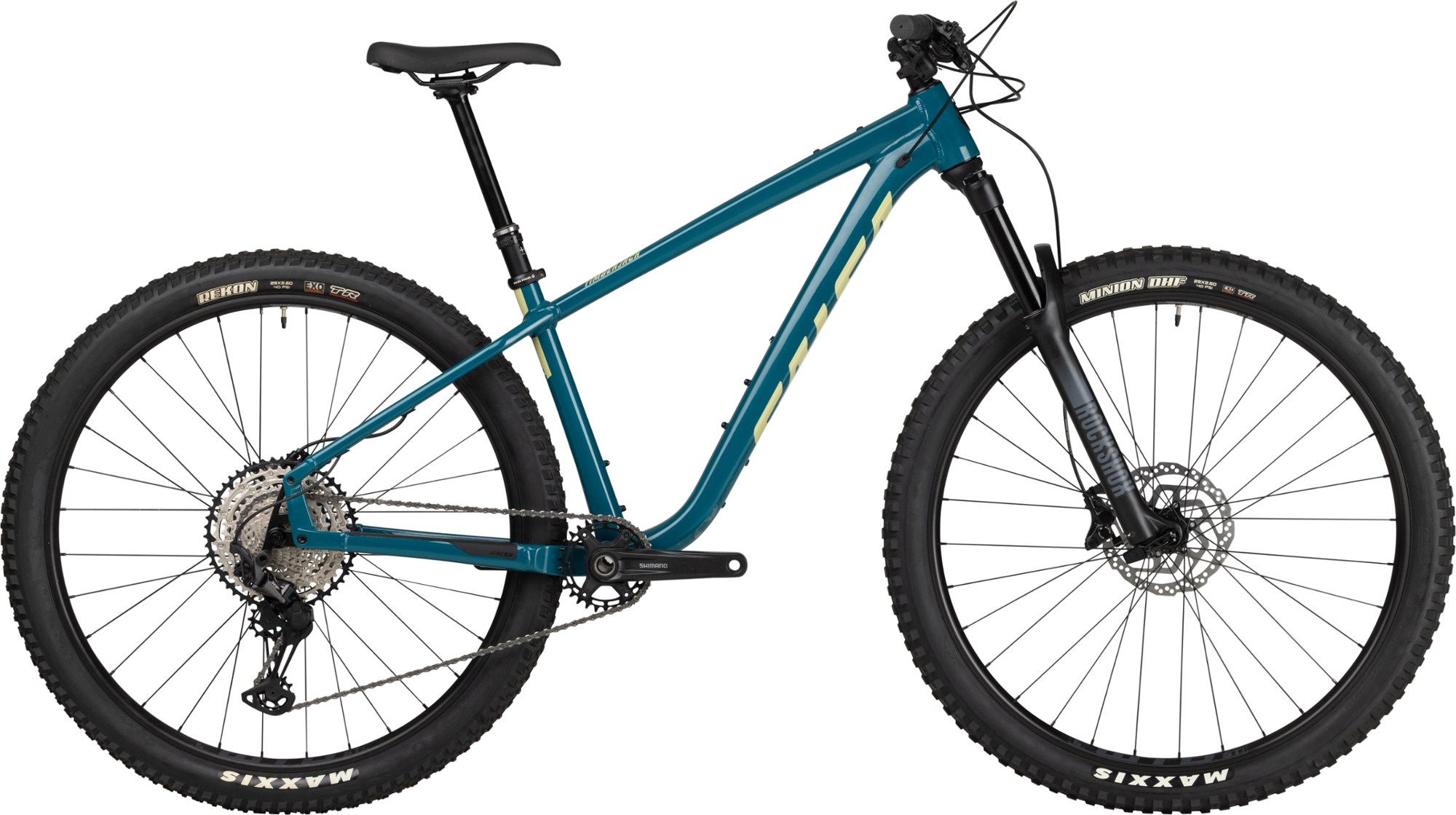
Minnesota-based Salsa Cycles is best known for their bikepacking, touring, and gravel-oriented designs, but they’ve made some serious headway in mountain biking of late. Their Timberjack XT 29 hardtail is a case in point with its well-thought-out spec package and adaptable design. The bike’s burly 2.6-inch tires and highly adjustable 130-millimeter RockShox 35 Gold RL fork provide more than enough cushion for rocky and rooty descents (by hardtail standards). And the relatively slack geometry and fast-rolling tires encourage shenanigans like popping off trailside lips and manualing down the trail. What we really like about the Salsa, however, is its nod to bikepacking: You simply won’t find too many other hardtails that offer as many mounting locations for gear as the Timberjack.
What’s not to like with the Salsa Timberjack XT 29? For starters, the burly construction and wide tires mean the bike isn’t as nimble or fast as a more cross country-focused design. Even a comparable option like Santa Cruz’s Chameleon , which has the same amount of travel but checks in a few pounds lighter and features a mullet setup, is noticeably more playful. And it almost goes without saying that a full-suspension rig will be the more comfortable ride when the going gets rough. But again, the Timberjack is a very solid performer that’s built to last, and it will save you a good chunk of cash over an equivalent full-suspension design (rear suspension is spendy). Bonus: It's available through REI, which means there's a good chance you'll be able to try it out before you buy—not to mention, co-op members get a year of free adjustments, the option for free in-store assembly, and 20% off shop services, among myriad other benefits. See the Salsa Timberjack XT 29
Best E-Mountain Trail Bike
5. specialized turbo levo comp alloy ($7,000).
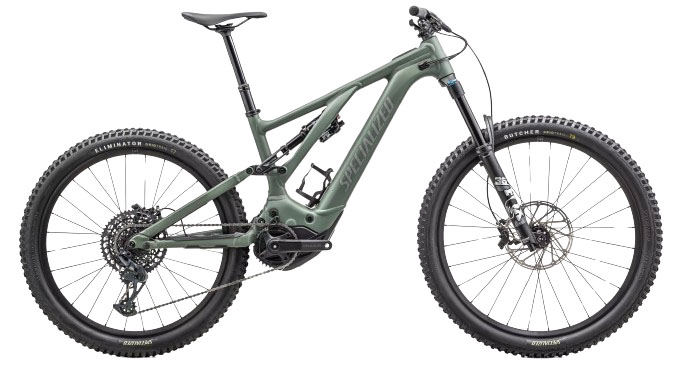
Specialized has been at the forefront of electric mountain bikes in North America, and their Turbo Levo is a leading all-mountain design. The latest bike is a real grin-maker—trust us on this one—and received a host of improvements that set it apart. Its mullet setup (a 29-in. wheel at the front and 27.5-in. wheel at the back) gives it a balanced and easy-to-control feel but still can smash through technical terrain, and its electronics have seen nice upgrades in durability and refinement over the years. Plus, like Specialized’s Stumpjumper Evo above, the Turbo Levo Comp offers the ability to tweak the head tube angle and bottom bracket height to dial in the geometry to your preferences. Overall, among a fast-growing and competitive field of e-mountain bikes, we think the latest Turbo Levo is at the top of the list.
Currently, the biggest barrier to an e-mountain bike of any kind is price. Despite packing an aluminum frame, the Turbo Levo Comp here costs a steep $7,000, and carbon models start at a whopping $9,000. Additionally, the extra drive system adds a significant amount of weight—it’s not uncommon for e-bikes to weigh upwards of 50 pounds or more (for reference, the Turbo Levo Comp is around 52.5 lb.). This added heft also has performance drawbacks, and we’ve found the Turbo Levo is quite a bit less flickable and more reluctant to get off the ground than the brand’s analog Stumpjumper Evo (or the lighter but less powerful Levo SL e-bike ). Finally, land managers and lawmakers are still trying to figure out where e-bikes fit into outdoor recreation. Regulations vary by state and riding area, but oftentimes they technically are not legal to ride on singletrack trails (although we’re seeing increased access each year). See the Specialized Turbo Levo Comp Alloy
Best Value in a Full-Suspension Trail Bike
6. ari cascade peak pro ($2,999).
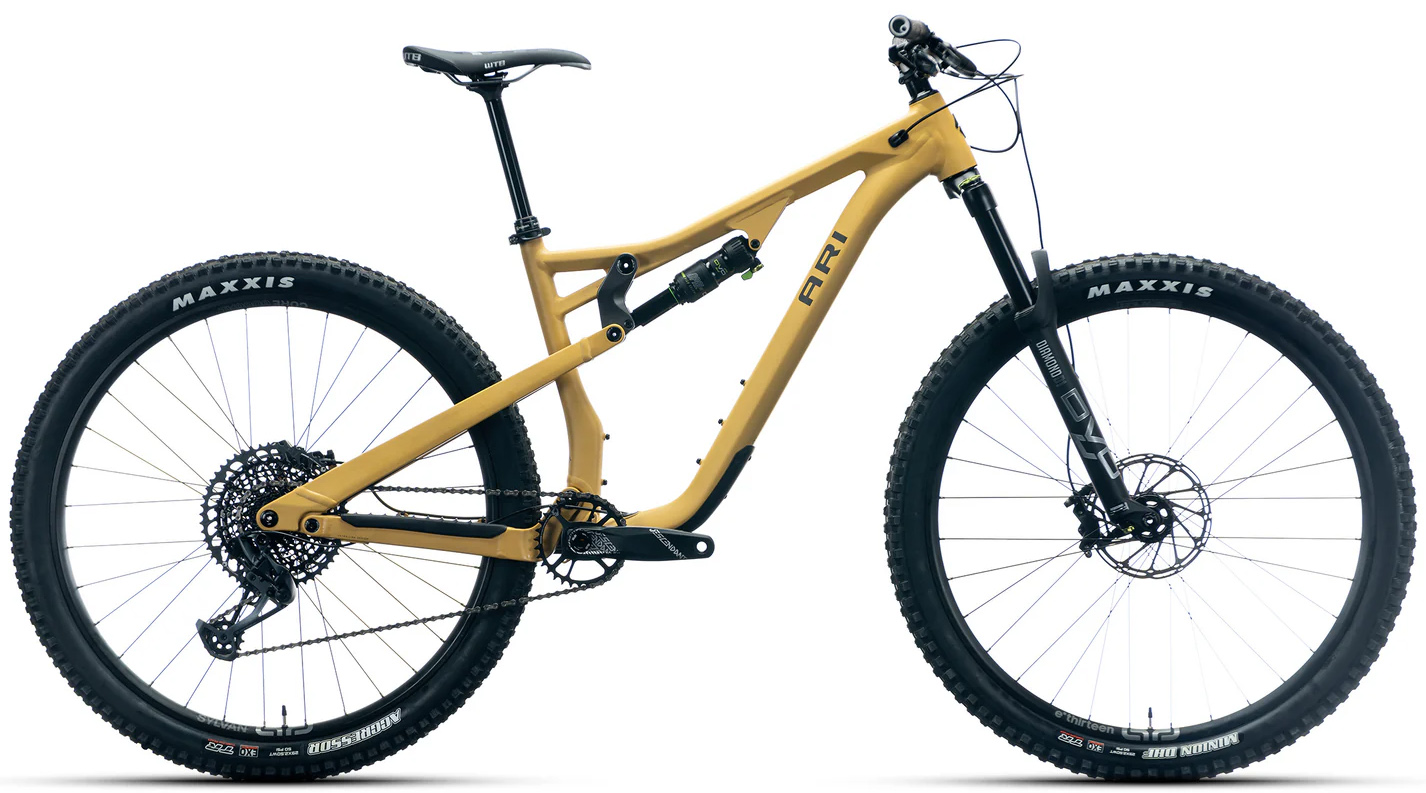
There’s no way around it: Full-suspension bikes are an expensive breed. Fortunately, we’ve started to see high-end tech trickle down into the cheaper end of the market, and there are currently several competitive options for under $3,000. The Ari Cascade Peak Pro is a case in point. At $2,999 full MSRP and $2,799 on sale at the time of publishing, the Cascade is by no means cheap but offers a stellar build for the price: The rugged aluminum alloy frame, combined with a SRAM GX Eagle drivetrain and nice balance of suspension for both the up and down, make for a fun and sturdy ride even on rough and rowdy singletrack. In short, unless you’re looking for a lightweight racing rig, the Cascade Peak Pro will save you serious cash without sacrificing too much in terms of geometry, build quality, and components for most recreational riders.
While we consider the Ari Cascade Peak Pro to be a stellar all-around value, you can certainly go cheaper. For example, Polygon’s Siskiu T8 costs a more wallet-friendly $2,399—earning it a spot atop our list of the best trail bikes under $2,500 —although we’ve heard a few negative stories related to customer service and warranty claims (always a risk with buying from a consumer-direct brand). But with the Cascade, you get a lifetime frame warranty (Polygon covers full-suspension frames for 5 years), and you can return the bike no questions asked within 30 days of purchase. These benefits—along with Ari’s detailed fit guide —help offset the biggest pitfall of buying consumer-direct: the wholly subjective battle of dialing in the right fit sight unseen. For value-focused riders looking for a capable aluminum build, YT’s Jeffsy Core lineup is also worth considering. See the Ari Cascade Peak Pro
Best Entry-Level Trail Bike for Beginners
7. salsa rangefinder deore 11 29 ($1,199).
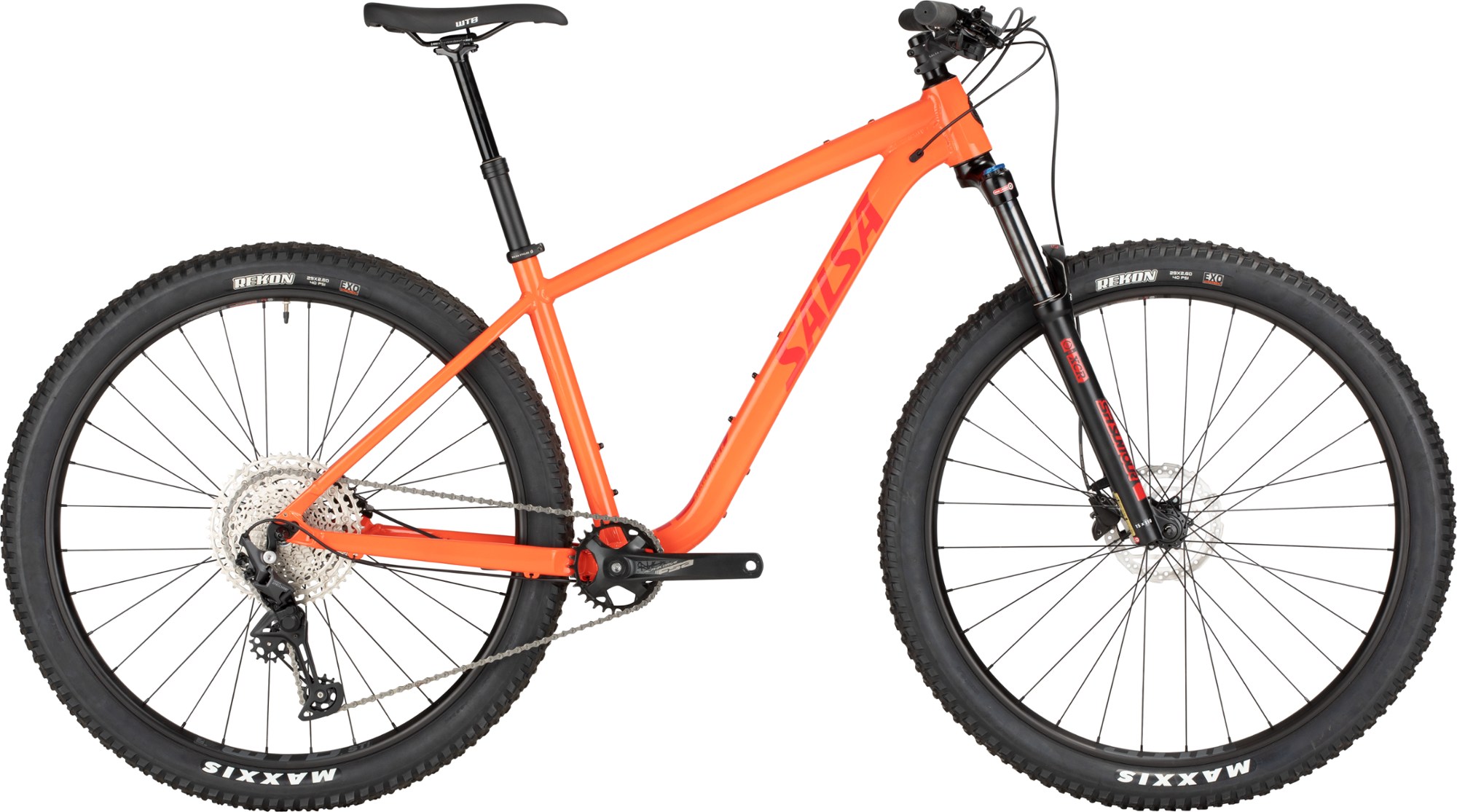
Entering the world of mountain biking can be daunting: Dropping thousands of dollars on a new bike isn’t feasible for many, especially when you’re still dialing in your riding style and preferences. Not to mention, the world of budget bikes is full of true clunkers that lack the durability and rideability of more premium (read: pricier) designs. Enter the Salsa Rangefinder, a solid all-rounder that will allow you to progress without breaking the bank. The 120 millimeters of front travel offers ample squish for mellow singletrack, long gravel rides, and even easy bikepacking missions, and the 11-speed drivetrain is realistically all most beginning riders need. It even includes a dropper post, which isn’t always the case at this price point. And like Salsa’s own Timberjack above, the Rangefinder is available through REI, which comes with a host of benefits that are particularly enticing for new riders.
What do you sacrifice by saving with the Salsa Rangefinder? As expected at this price, you’re not getting the most modern geometry or highest-quality components. Combined with the short travel on the front fork, this limits the terrain on which you can ride—those looking to push their limits and tackle steep, aggressive lines will almost certainly want to upgrade to a more capable rig (ideally one with rear suspension, but even Salsa’s Timberjack above is a better choice). And while we consider the Rangefinder to be a great value for a capable starter bike, there are plenty of cheaper options available— Co-op Cycles’ DRT lineup is a great place to start, with options from around $600. We consider these bikes a little too limited and dated to recommend for extensive trail riding, but they’re nevertheless compelling for easy-going riders on a tight budget. See the Salsa Rangefinder Deore 11-Speed 29
Trail Mountain Bike Comparison Table
About our testing process.
Finding the right mountain bike can be a tough affair. The market is loaded options, prices are sky-high, and riders need to pin down key priorities and preferences before buying—including but not limited to riding style and terrain, fit, purchasing convenience, and cost. Fortunately, the Switchback team is well versed in two-wheeled adventures. Former editor-in-chief John Ellings put together our initial list of seven top trail mountain bikes back in 2021, drawing from his decades of experience charging down the rocky and rooty trails of the Pacific Northwest. Contributing editor Nick Mott took over in 2024. Based in southwest Montana, Nick can never pass up exploring his local trails on bikes old and new.
It wasn’t easy dialing in the streamlined list of seven top trail mountain bikes that you see above. In order to earn a spot, each bike had to stand out in some way, and many of the options above excel in several areas. Strong on-trail performance is an obvious way to win us over, and we try to get our hands on as many designs as we can to put them through their paces on techy singletrack, long slogs on forest service roads, and everything in between. Overall build quality is another important factor and includes everything from the frame to the drivetrain, fork, brakes, tires, and other key components. Finally, we’re acutely aware that mountain bikes can cost an arm and a leg, so we make sure to balance each bike’s performance with its price. (Note: If you’re on a tighter budget, we’ve also put together lists of the best trail mountain bikes under $1,500 and best trail mountain bikes under $2,500 ). As the market continues to grow and evolve, we’ll be sure to update the list above to reflect our current favorites.
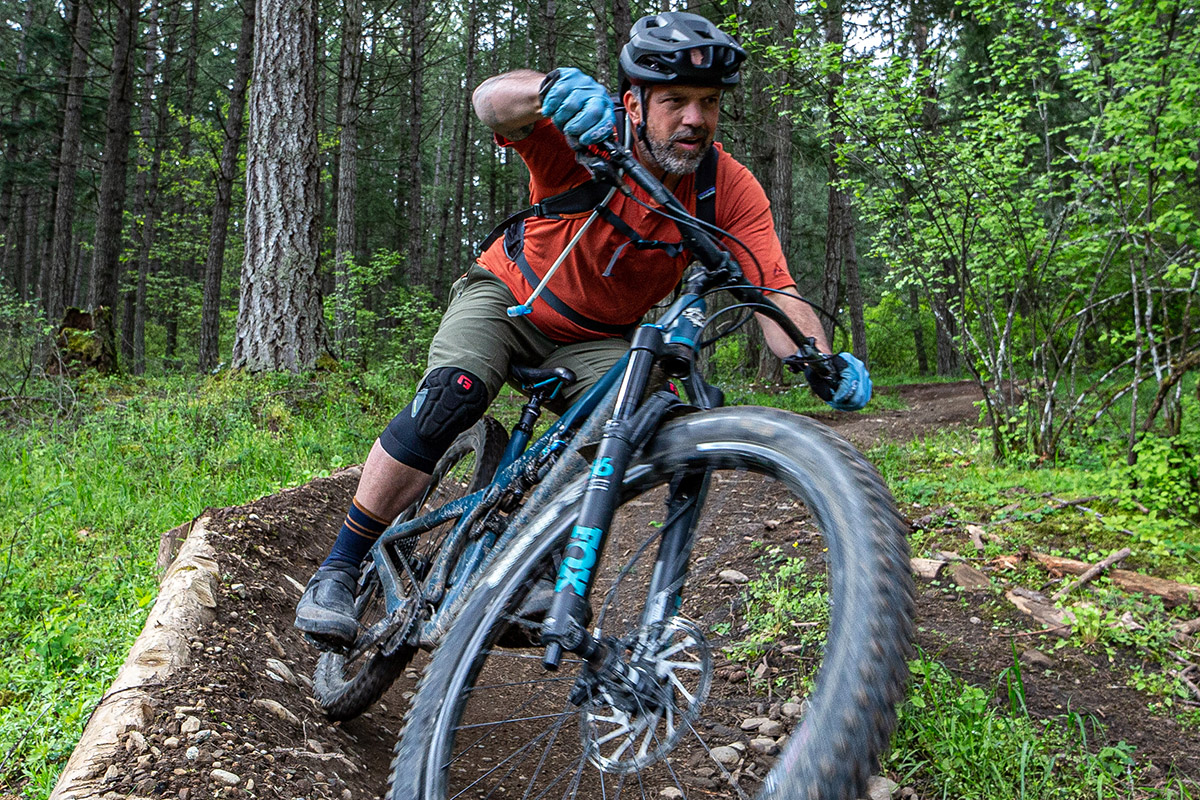
Trail Mountain Bike Buying Advice
Frame material: carbon fiber vs. aluminum, full-suspension vs. hardtail, wheel size: 27.5 vs. 29er, drivetrain and gearing, electric mountain bikes (e-mtbs).
- Unisex vs. Women's-Specific Models
Trail Bike Price Guide
Buying a mountain bike online, consumer-direct bikes.
- Should I Buy a Used Bike?
As a whole, aluminum-framed bikes still dominate the trail category, but carbon fiber is becoming increasingly common. What’s driving its growing popularity? The main advantages are less weight—approximately 1 pound depending on the frame—and increased stiffness. The additional rigidity of the material compared with aluminum leads to better power transfer and higher efficiency. For committed cyclists, those are pretty convincing performance advantages.
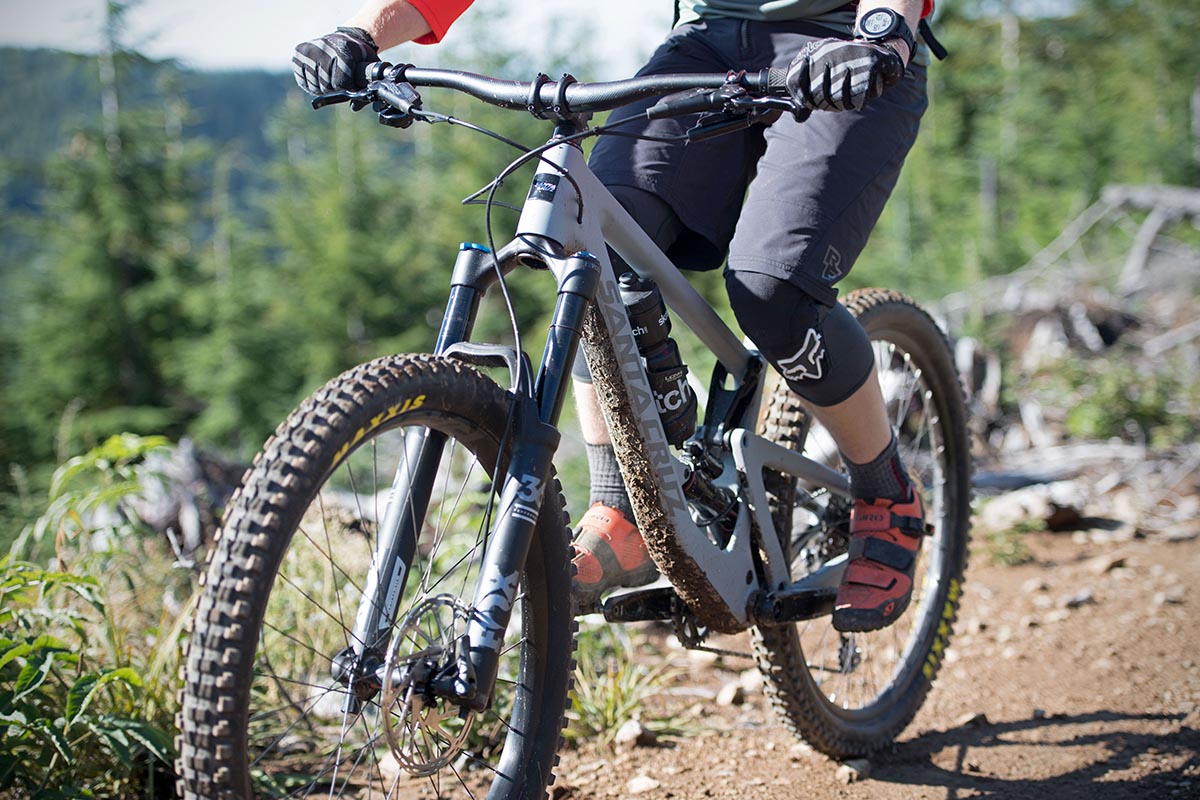
Carbon does come with its fair share of downsides, however. Right off the bat, you can expect to pay about a $1,000 premium for upgrading from an aluminum to carbon frame. Additionally, aluminum does a better job absorbing impacts from trail debris and surviving a high-speed crash (carbon can crack from hard hits). Finally, aluminum is easier to be recycled once a bike has reached the end of its life, although that’s still a hotly debated topic. In the end, it often comes down to budget: Carbon has plenty of advantages, but it’s a hard sell if you’re only dabbling in the sport. And we can’t help but think that the extra cash may be better spent on a visit to Whistler instead.
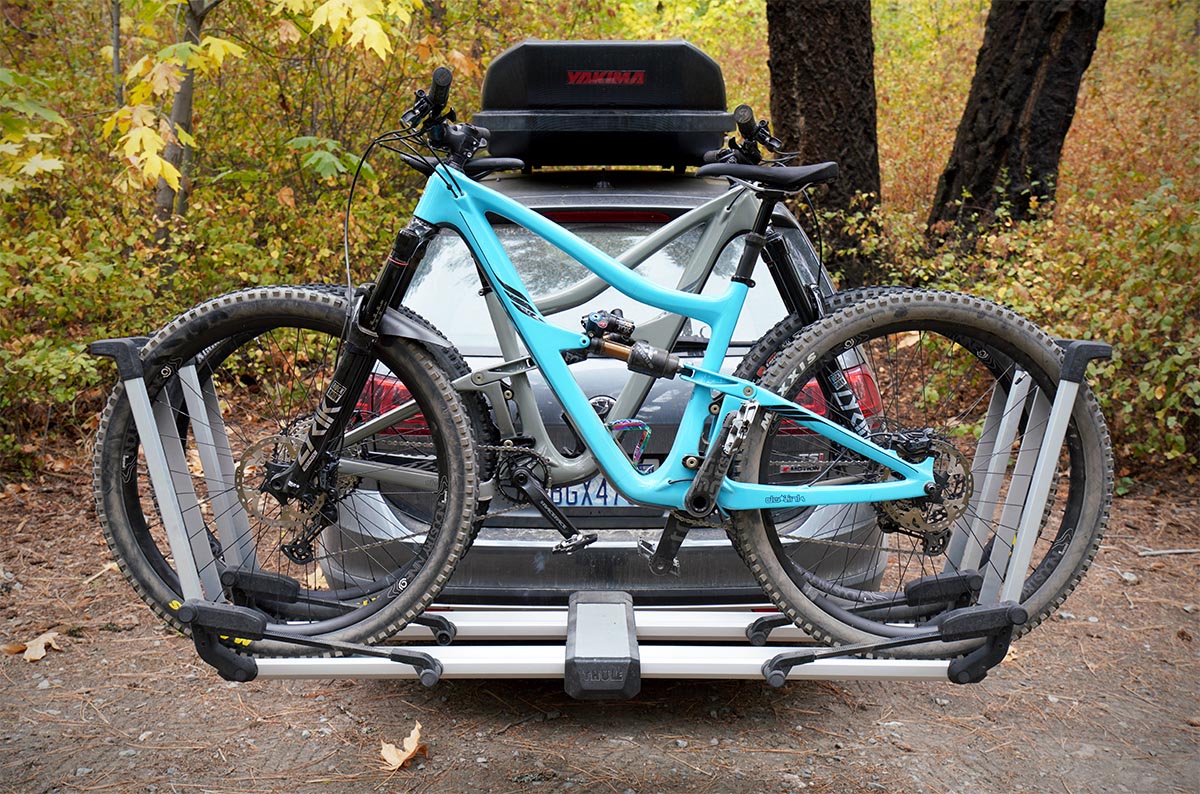
When buying a new trail bike, one of the most commonly asked questions is: Should I buy a hardtail (suspension fork only at the front) or full-suspension (includes both a front suspension fork and rear shock) model? There are a number of factors to consider when making this choice. Are you on a tight budget? Are you just starting out? Are your local trails smooth and with few obstacles? If so, a hardtail is probably the best choice for you. However, should your local terrain be rooty and rocky, or maybe you just like going downhill fast, then a full-suspension rig probably is the better option. This is just the tip of the iceberg, however, and we break down the additional considerations below.
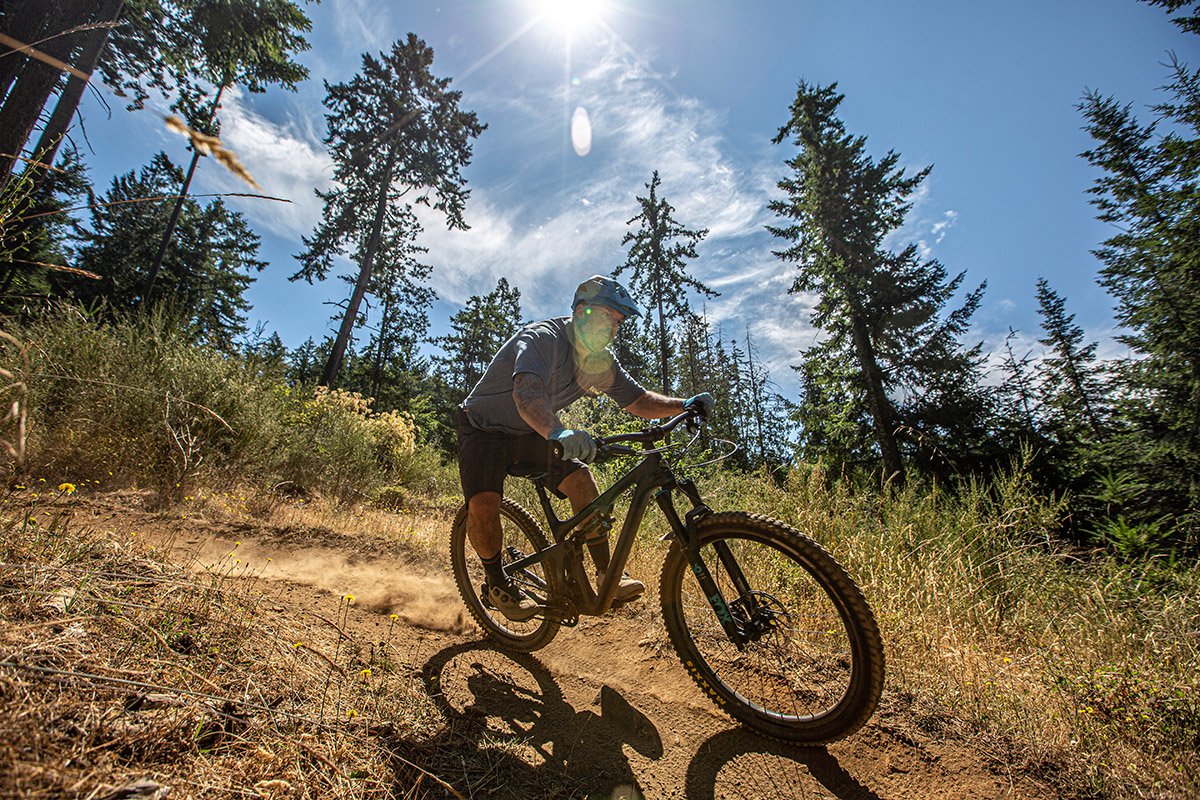
Performance In terms of overall riding performance, hardtail and full-suspension mountain bikes each come with their fair share of pros and cons. Starting with hardtails, their lower weight and lack of suspension travel makes them fast and easy to pedal quickly. As a result, they excel on long rides and climbs. But should the going get rough—especially on the downhill—a full-suspension bike quickly takes the lead. The added rear suspension helps soak up bumps and offers a much more comfortable ride in general. FS bikes are the weapon of choice for most intermediate to advanced riders. Having said that, full-suspension designs like our top-rated Santa Cruz Hightower typically weigh more, are significantly more expensive, and will not be as efficient at climbing or on non-technical trails.
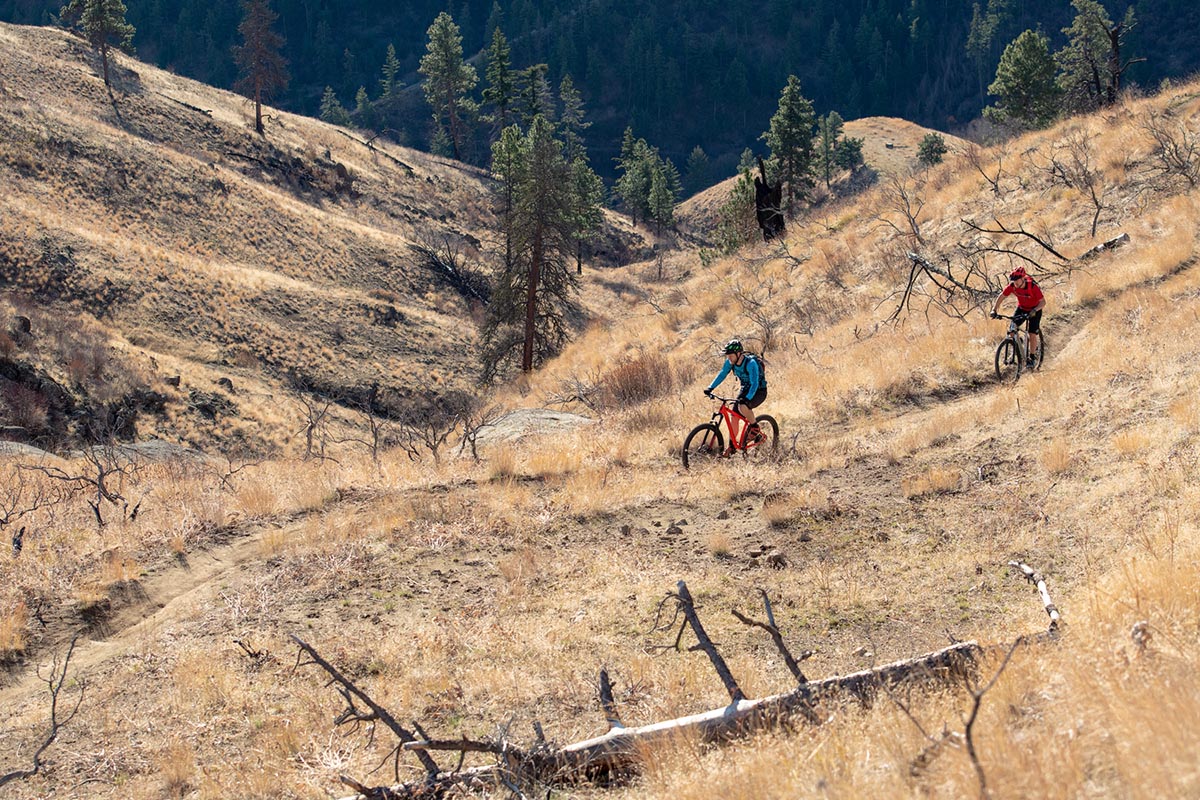
Maintenance If you’re looking for a simple and low-maintenance bike, then hardtails take the cake. Their lack of rear suspension means they forgo any bushing, bearing, or pivots that generally require extra care and attention. This becomes especially true should you live in a wet and muddy climate, which can wreak havoc on full-suspension bikes if they go unmaintained. Because of these characteristics, it’s not uncommon for dedicated mountain bikers to own a full-suspension bike for summer use and a hardtail for when the trails turn to slop. Bikes like the Salsa Timberjack are able to hold their own against short-travel full-suspension rigs yet are much simpler to keep fresh should you often ride in the rain.
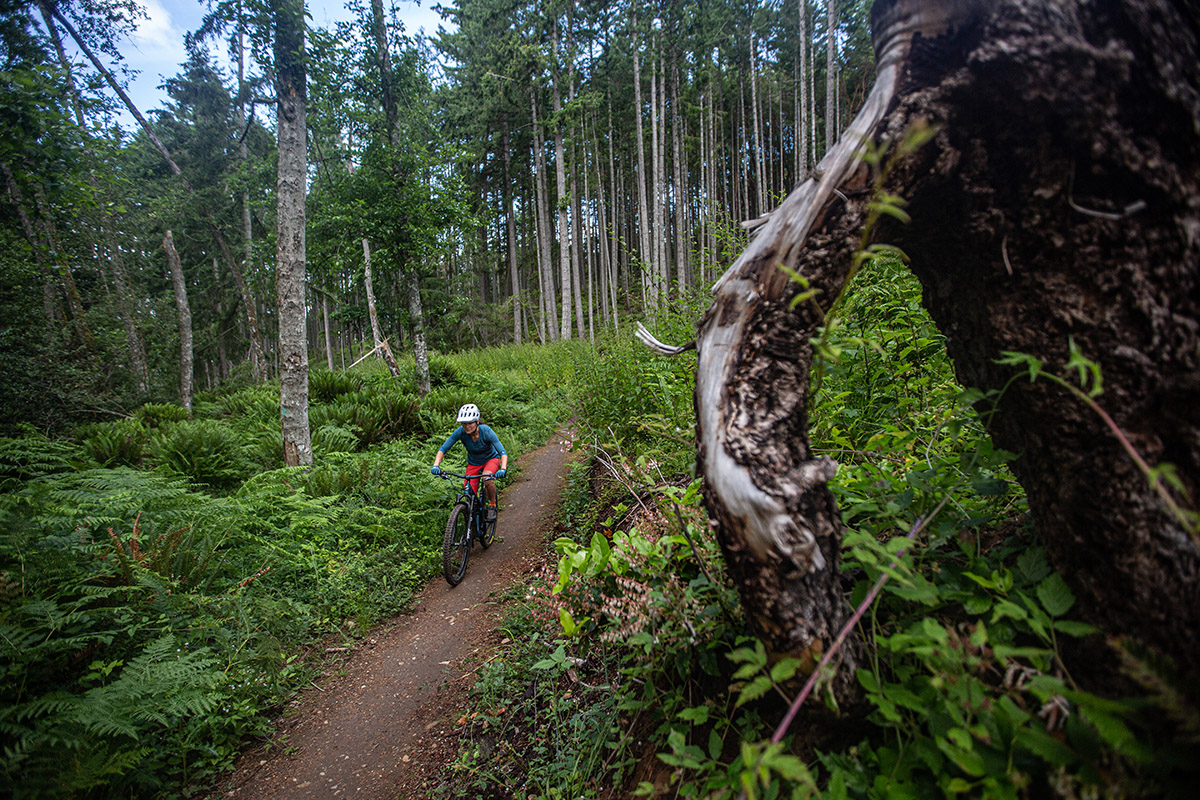
Price Once again, if a low price is your top priority, then hardtails are the clear choice. Quality full-suspension trail bikes, with their added rear shock and linkage, are simply too complex to design and build on the cheap. From the list above, the $2,999 Ari Cascade Peak Pro is about as low as we’d advise going with a full-suspension design (there are a few just below $2,000 that are suitable as well). Sure, you could certainly spend less than that on a bike from a big-box store, but in reality, it’s going to ride terribly. The parts won’t last, the suspension will be overwhelmed, and you’ll be quickly wishing you bought a lighter and more comfortable hardtail instead.
.jpg)
For 2024, most quality hardtails and full-suspension rigs—including all of those on our list above—utilize a 1X setup. What you get by only having the gearing at the back is improved ergonomics and efficiency—there’s only one shifter to manage—and less weight. In addition, with budget-friendly designs like the 1 x 12 Shimano Deore, you can still get a very wide gear range without breaking the bank. For riders committing to the sport and planning to tackle steeper terrain, we consider a 1X setup to be a worthy upgrade. And a final note here: SRAM and Shimano dominate the 1X market, and in general, as price goes up, weight goes down and shifting smoothness and reliability improve.
.jpg)
Unisex vs. Women’s-Specific Models
Many trail bikes are made in a unisex style and a range of sizes (typically from “S” to “XL”). This can work well for both men and women, although riders on the shorter end of the spectrum can run into some challenges getting an ideal fit. Some brands like Specialized address this by offering a wider range of sizes within the unisex line. Taking their Stumpjumper Evo as an example, the bike is made in six frame sizes with varying geometry to accommodate different heights. For many women, simply having an array of size options is all they need to get a great fit.
In addition, a number of brands make dedicated women’s mountain bikes. In the past, these mostly have been shrunken-down versions of the unisex models in different colorways. And while that’s still true in some cases—especially on the budget end of the spectrum—many quality brands make women’s-specific trail designs with retuned suspensions, handlebars that are narrower with smaller-diameter grips, and reshaped frames. There also are women’s-only bike brands, including Juliana (Santa Cruz’s sister brand) and Liv (Giant). Liv Cycling in particular really stands out as a leader with a growing collection of XC, trail, and e-mountain bikes for women. In the end, a unisex design like the aforementioned Stumpjumper can be a great pairing for many lady riders, but there are a number of potential benefits in opting for a women’s-specific model.
.jpg)
The majority of us do a significant amount of shopping online, so why not do the same when purchasing a mountain bike? They’re certainly more complicated to figure out than a set of dish towels, but there’s a lot of recent movement towards online sales from consumer-direct brands (more on this below), major retailers like REI Co-op and Competitive Cyclist , and even manufacturers themselves like Diamondback. If you’re considering going this route, it’s important to ask yourself a few questions before clicking that buy button. Are you comfortable doing basic assembly and mechanical projects? Will someone be at home to take delivery and sign for your new ride? And, perhaps most importantly, are you comfortable choosing the right size and style of bike without taking a test spin?
One of the most important pieces of the new bike puzzle is getting the correct size, which can be the difference between riding your bike down the hill or wanting to throw it down the hill. Luckily for us, most reputable online retailers and brands provide a significant amount of fit-related information. Size charts are often tailored to specific models, and you’ll then get size recommendation based on your height or inseam length. Taking this a step further, Competitive Cyclist offers one of the most comprehensive fit guides we’ve seen, compiling measurements for your inseam, forearm, lower leg, and more. Taking this detailed approach is one way of ensuring you wind up on a bike that fits you properly.
.jpg)
Should I Buy a Used Bike?
The trail bikes listed above are the latest and greatest in their respective categories, but purchasing a used model is a great way to save and cut down on waste. To start, keep in mind that mountain bike technology has been rapidly evolving even in the past few years, so we recommend picking up a pretty new design. Further, it’s a good idea to closely inspect the bike in person to make sure you’re not buying an unmaintained money pit. With the drivetrain, verify that the chainring teeth are shaped like triangles and less like shark fins. If they look like the latter, it’ll likely need to be replaced. The frame, brake pads, and chain should also be inspected for undue or heavy wear. Finally, see if the rubber seals around the suspension components are cracking or if oil is running on the outside of the fork—both are signs that service is required.
If you’re not comfortable with checking a bike’s mechanical soundness, it’s often worth having a local shop take a look (or you could purchase a former demo bike from a shop, so you can ensure it was properly maintained). Even a modest hardtail can set you back a few hundred dollars, and higher-end models hold their value well enough to justify getting a professional opinion. We recommend calling ahead to make sure they offer the service and that they can fit you in. In the end, used bikes have their place—especially for those just getting into the sport—but it’s a good idea to make an informed, smart decision. Back to Our Top Mountain Bike Picks Back to Our Mountain Bike Comparison Table
Read More From Switchback Travel
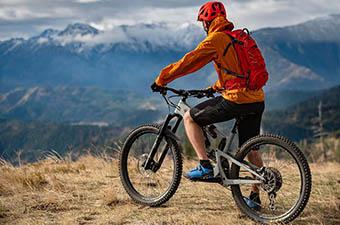
Mountain Biking Gear Reviews
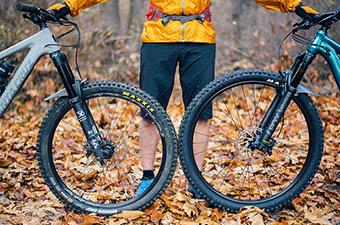
27.5 vs. 29er Mountain Bikes
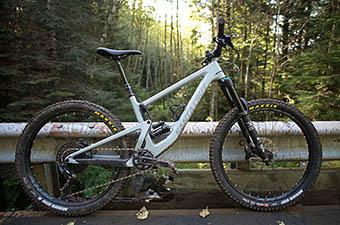
Best Mountain Bike Brands of 2024
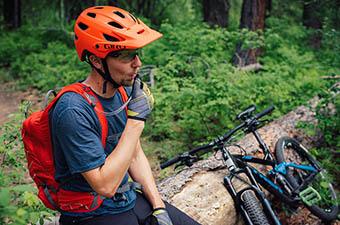
Best Mountain Bike Helmets of 2024
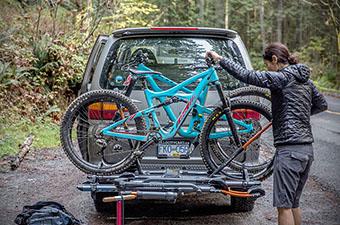
Best Hitch Bike Racks of 2024
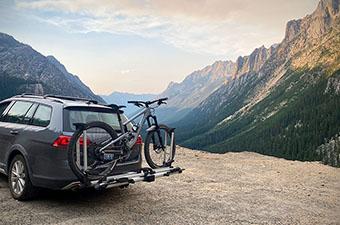
Thule Helium Platform 2 Review
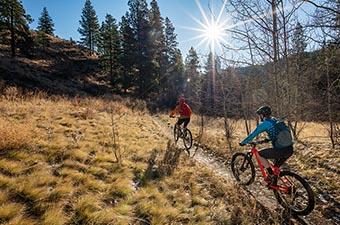
How Much Should You Spend on a Mountain Bike?
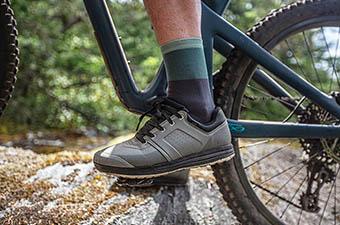
Best Mountain Bike Shoes of 2024
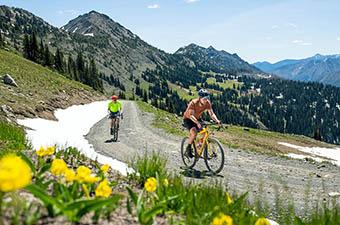
Best Gravel Bikes

Mobile Menu
Megamenu - desktop hamburger menu.
- Hiking Gear
- Backpacking Gear
- Biking Gear
- Camping Gear
- Footwear Reviews
- Climbing Gear
- Skiing Gear
- Winter Gear Reviews
- In-Depth Gear Reviews
- Hiking Shoes
- Hiking Boots
- Trail Running Shoes
- Mountain Bike Shoes
- Approach Shoes
- Climbing Shoes
- Beginner Climbing Shoes
- Mountaineering Boots
- Winter Boots
- Rain Jackets
- Down Jackets
- Synthetic Jackets
- Fleece Jackets
- Hardshell Jackets
- Softshell Jackets
- Windbreaker Jackets
- Ski Jackets
- Winter Jackets
- Hiking Pants
- Hiking Socks
- Trekking Poles
- Baby Carriers
- Running Vests
- Backpacking Tents
- Backpacking Packs
- Backpacking Sleeping Bags
- Backpacking Sleeping Pads
- Backpacking Stoves
- Backpacking Food
- Water Filters
- Altimeter Watches
- Handheld GPS
- Mountain Bike Helmets
- Mountain Bikes
- Mountain Bikes Under $1,000
- Mountain Bikes Under $2,000
- Gravel Bikes
- Bike Brands
- Kids' Bikes
- Hitch Bike Racks
- Camping Tents
- Rooftop Tents
- Camping Sleeping Bags
- Camping Mattresses
- Camping Chairs
- Camping Stoves
- Duffel Bags
- Rock Climbing Shoes
- Climbing Helmets
- Climbing Harnesses
- Climbing Quickdraws
- Belay Devices
- Climbing Ropes
- Climbing Backpacks
- Winter Gloves
- 4-Season Tents
- Ski Helmets
- Ski Goggles
- Ski Backpacks
- All-Mountain Skis
- Ski Bindings
- Backcountry Skis
- Backcountry Ski Boots
- Skis for Beginners
- Hardpack Skis
- Mirrorless Cameras
- Full-Frame Cameras
- DSLR Cameras
- Point-and-Shoot Cameras
- Travel Cameras
- DSLR Lenses
- Mirrorless Lenses
- Lofoten Islands
- Lofoten Hiking
- Hardangervidda
- Jotunheimen
- 10 Great Norway Hikes
- Public Huts
- Torres del Paine
- Chalten and Glaciares
- Lake District
- Patagonia National Park
- Milford Sound
- Abel Tasman
- Marlborough
- Great Walks
- Adventure Towns
Add adventure to your inbox
- Privacy Policy
- Terms of Service
© 2024 Switchback Travel. All Rights Reserved. No part of this site may be reproduced without our written permission.
FIND A SHOW NEAR YOU
Tickets for Warren Miller’s 75 are now on sale.
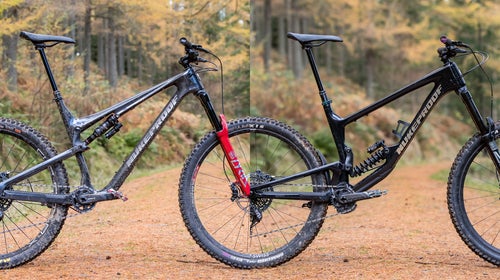
Short or Long Travel: Which Is the Best All-Around Mountain Bike?
How much slower does a modern long-travel bike climb? And what are the differences downhill?

- Share on Facebook
- Share on Reddit
New perk: Easily find new routes and hidden gems, upcoming running events, and more near you. Your weekly Local Running Newsletter has everything you need to lace up! >","name":"in-content-cta","type":"link"}}'>Subscribe today → .
If you want one bike to do everything, how much travel should it have? All bikes have to find a compromise between climbing and descending performance, and suspension travel is usually seen as a good indicator of where a bike sits on that spectrum.
But recently, short-travel trail bikes are a lot more capable, while long-travel bikes are much better at climbing. So how much slower is a modern long-travel bike uphill? And what are the differences downhill?
Caught up in all this is the question of tire choice. How much of the difference in climbing speed between an enduro bike and a trail bike comes down to the tires? Can fast-rolling tires close the gap? And can sticky tires make a short-travel bike descend as well as a long-travel one? Let’s find out.
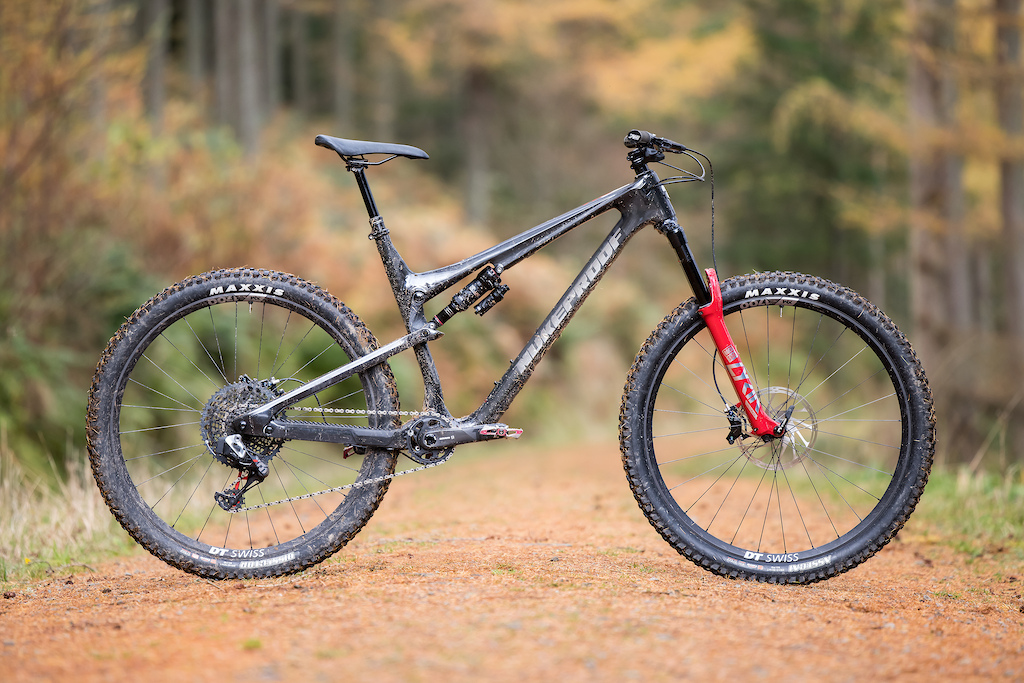
Nukeproof Reactor
• 130 / 150 mm travel • Weight as tested: 14.4 Kg / 31.7 lbs (“trail” tires, 200 mm rotors) • Size tested: XL • Price: $7,062
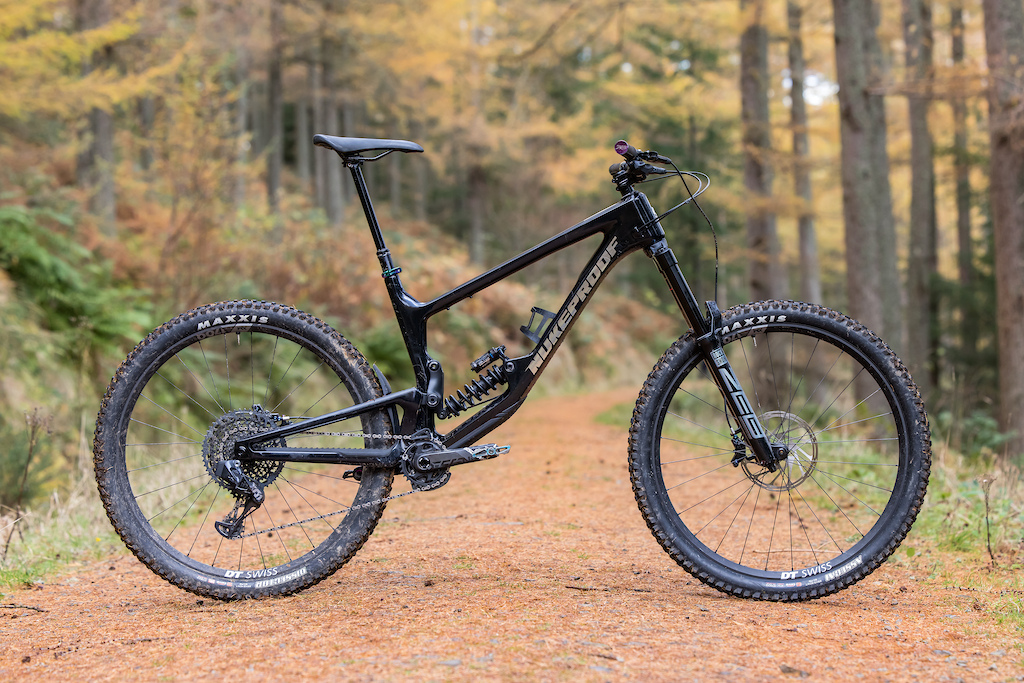
Nukeproof Giga
• 170 / 180 mm travel • Weight as tested: 15.2 Kg / 33.5 lbs (“trail” tires, air shock) • Size tested: XXL • Price: $7,415
To make things as comparable as possible, I got hold of a Nukeprof Reactor RS and a Nukeproof Giga RS. The Reactor has 130 millimeters of rear travel and 150 millimeters up front, while Giga serves up 170 millimeters (rear) and 180 millimeters (front). These models have identical brakes, drivetrains, and cockpits. With the same wheels and tires fitted, only the frame and fork are different. Both use full-carbon frames and RockShox Ultimate-level suspension. The Reactor has a Lyrik fork to the Giga’s Zeb, but the difference in chassis diameter is appropriate to the travel offered in each case.
Although the photos used here were taken with a coil shock fitted to the Giga, the testing was carried out with a RockShox Super Deluxe air shock to match the shock on the Reactor. I upgraded the rear rotor size on the Reactor to 200 millimeters so both bikes could accept the same wheels for comparative testing.
I set both bikes up with 30 percent shock sag and suspension settings as I would normally have them.
For the most part, I used the wheels that came stock on the Reactor for both bikes to remove the variable of tire choice. These tires were a Maxxis Dissector, EXO+ casing, MaxTerrra compound (rear) with a Maxxis Assegai, EXO casing, MaxxTerra compound (front). For brevity, I’ll call these the “trail” tires from now on. Fitting these tires and the air shock to the Giga dropped its weight to a respectable 15.2 kilograms – only 800 grams (1.8 pounds) more than the Reactor with the same wheels.
I also tested with a stickier pair of tires (fitted to another alloy wheelset for easier wheel swaps). These were a Maxxis Assegai in DoubleDown casing, MaxxGrip compound on the rear, with a Schwalbe Magic Mary, SuperGravity casing, Soft compound, on the front. We’ll call these the “enduro” tires. These wheels/tires weighed 600 grams more than the trail wheels/tires.
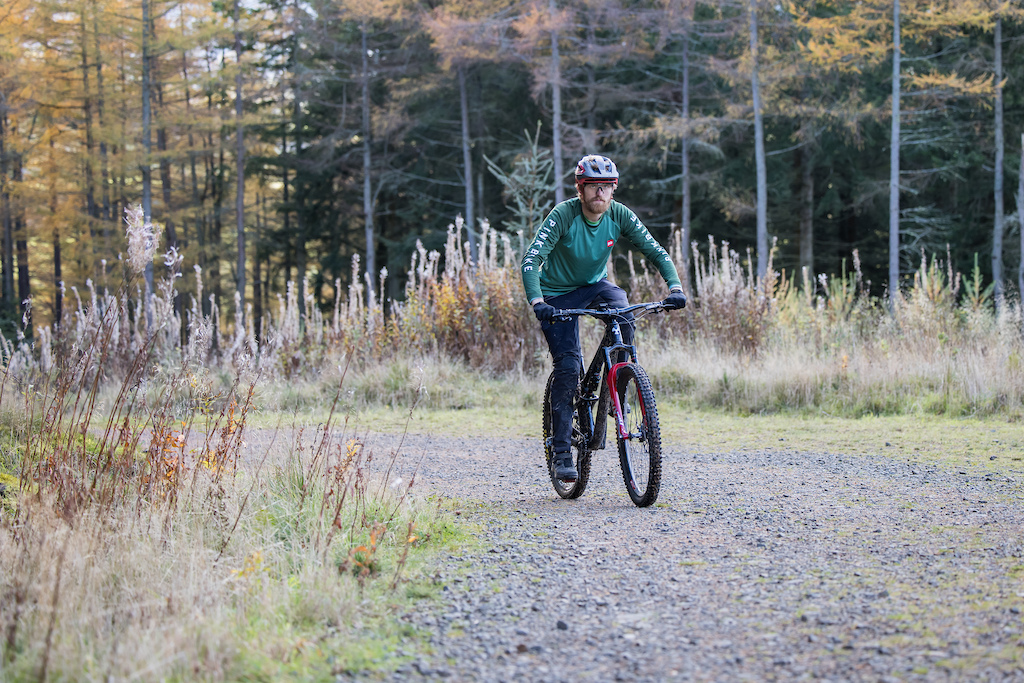
For the climbing test, I used a pair of SRM power meter pedals to control my effort, which I kept at a steady 250 watts. I rode both bikes up the same gentle and smooth fire road climb. I used a short climb so I could do five laps on each bike in quick succession and take an average. If I only did one or two longer climbs on each bike, there would be no way of knowing if any difference in times was down to the bike or just a fluke.
I did this first with the trail tires at my usual riding pressures (23 and 26 psi) then I re-tested the Reactor with the enduro tires. Here are the times:

As you might expect, the Giga was slower on average than the Reactor, but the average time was only 0.8 percent slower. Because the Reactor wasn’t consistently quicker, and the average difference between the bikes was so small, we can’t be sure from these numbers if the difference between the bikes is real or just a fluke. In science terms, the difference wasn’t statistically significant.
But even if we take the 0.8 percent difference at face value, that’s about what we’d expect from the weight difference between the two bikes alone, suggesting the travel per se (i.e. the pedaling efficiency) wasn’t having any effect.
In contrast, with the enduro tires fitted, the Reactor went 4.1 percent slower, or 3.4 percent slower than the Giga with the trail tires. In both cases, these are statistically significant differences, because the Reactor with Enduro tires was consistently slowest. To give that some context, over a half-hour climb, the enduro tires would add about one minute and fourteen seconds to the Reactor’s time. Or to go at the same pace, you’d need to produce about 260 watts instead of 250 watts; if you’re already working hard, that could be very noticeable.
The added weight of the heavier tires would only be expected to slow things down by at most 0.6 percent, so most of that difference is down to rolling resistance. This added drag will make covering ground slower on the flat and even downhills too (so long as traction and braking aren’t what’s limiting speed).
Subjectively, you can feel a little pedal bob from either bike, but there isn’t dramatically more with the Giga. The position is quite different due to the Reactor’s lower stack height and slacker seat tube angle (74.5 degrees vs. 78 degrees); this stretches out the spine which feels much less comfortable to me, especially on long climbs. Doing timed testing over technical climbs is virtually impossible because the time can vary so much from one run to the next depending on line choice, technique and luck, but when riding over bumpy terrain the Giga is noticeably smoother. The softer suspension obviously helps here but having your weight further in front of the rear axle also reduces how much your weight lifts when the rear wheel moves over a bump. Though I can’t put a number on it, I much preferred the Giga for technical climbs.

To see how they compare for descending, I chose a short local trail I know well with a good mix of roots, rocks, steep twisty sections and flat fast sections. It’s not the most technical trail in the world and it’s definitely not the roughest, but on the day of testing (which was a couple of days before taking these photographs), it was wet and slippery, making it a good challenge. To level the playing field and keep things simple, I stuck with the trail tires on the Giga and the enduro tires on the Reactor.

The Giga went first, and despite doing two laps to get up to speed on the course before getting the timer out, I shaved 2-3 seconds off my time from one run to the next. This is always a problem with timed testing. My first time on the Reactor (my fourth timed run of the day) matched the first run on the Giga. It improved from there but levelled out at one minute and sixteen seconds.
I did one more run on the Reactor with the trail tires and matched my fastest times, suggesting the stickier tires weren’t much of an advantage on this course anyway. I’m sure that on a more treacherous course—or in the hands of a rider who is better at finding the limit of grip—the enduro tires would become a significant advantage.
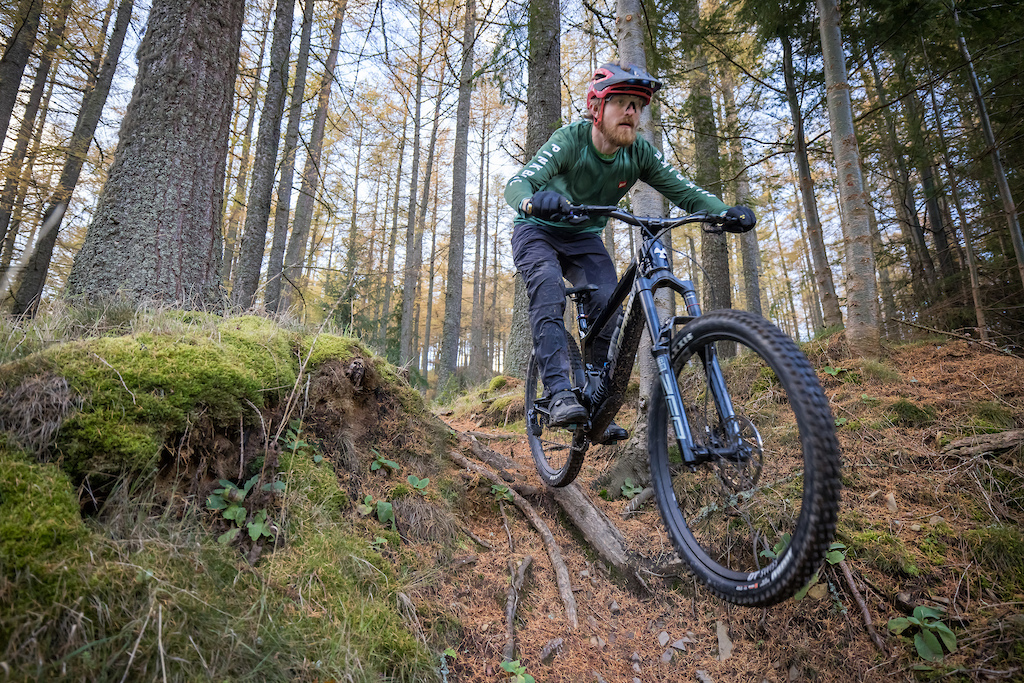
Subjectively, the enduro tires felt much more damped and surefooted and I was locking up less on the steep sections, but this didn’t seem to translate into more speed for me. Even with the sticky tires on the Reactor, the Giga felt much smoother, calmer, and more stable. The higher bar and slacker head angle combined with suspension that feels more settled “in the travel” makes going faster feel more within my comfort zone. I also felt like there was more time left on the table with the Giga, whereas the last two runs on the Reactor would be hard for me to improve on.
Because there are so many variables at play when descending, I wouldn’t read much into the times themselves. But they reveal that, although I felt closer to the edge on the Reactor, I was in fact going slower.

Closing Thoughts
The biggest takeaway for me is just how much difference tire choice makes for climbing speed. Sure, the enduro tires I tested are pretty draggy, but they’re not DH tires or mud spikes, and the trail tires (with an Assegai up front) are far from the fastest you can get. In fact, they held their own even on slippery descents.
I’m sure plenty of people don’t care about going slightly faster or feeling more comfortable on steep descents; in fact, I often hear people say they find it more fun to have a sketchier ride at slower speeds. But if that’s the case, why not fit slicker tires which will offer a real boost in climbing speed as a bonus? You could always use the lockout or run 10 percent sag if you want your enduro bike to feel sketchier! Personally, I have more fun on a long travel bike as it gives me the confidence to try new lines or ride them with more commitment.
The other surprise was that the Giga was barely slower uphill than the Reactor with the same tires, and if you want to close the efficiency gap even more you could always use the lockout.
One caveat here is that a power meter may not be the best way to measure and control effort in an efficiency test when comparing suspension efficiency. I discuss this with Mike Levy in this episode of the Pinkbike Podcast , but the bottom line is that I think the power meter method is valid for measuring efficiency when pedalling sitting down (as in this test), but it doesn’t work for out-of-the-saddle sprinting, and that’s where the extra travel is more likely to be a disadvantage.
It’s also fair to say the Reactor isn’t the fastest-climbing short-travel bike out there. But the Giga probably isn’t the most efficient among 170 millimeter+ bikes either. It’s based on a downhill bike and it’s designed to be even more gravity-focussed than Nukeproof’s Mega enduro bike. More to the point, it doesn’t have a huge amount of anti-squat , and higher anti-squat levels would probably make it climb even better. In one of Levy’s efficiency tests , the 170 millimeter-travel Santa Cruz Nomad (which has quite a lot of anti-squat) was faster than the 130 millimeter Ibis Mojo (despite having slower tires), suggesting a long-travel bike with generous anti-squat can be as just as efficient as a shorter travel one.
The bottom line is that ample suspension travel needn’t be a hindrance uphill, but grippy tires will slow you down a lot. So if you want one bike to do everything, it might make sense to pick a long-travel bike with a spare set of fast-rolling tires for mellower rides.
This article first appeared on our sister site, Pinkbike .
- Mountain Biking
Popular on Outside Online

Enjoy coverage of racing, history, food, culture, travel, and tech with access to unlimited digital content from Outside Network's iconic brands.
© 2024 Outside Interactive, Inc
Hottest mountain bikes for 2022
- Danny Milner
- September 7, 2021
There’s no shortage of scintillating new hardware coming onto the market next year. And with a bit of luck, some of it might actually be available to buy!

With the Raaw Jibb, Pivot 429 and Guerilla Gravity Trail Pistol, to name just three, there’s definitely no shortage of scintillating new hardware coming onto the market next year.
We’ve put together a list of the 12 up-and-coming best mountain bikes for 2022, from XC and down-country whippets to full on enduro bikes, and everything in-between.
XC/Down-country bikes:
As trail bikes pile on the pounds and start to give full-blown enduro bikes a run for their money on the scales, so people are turning to skinnier alternatives in order to reinject some frenetic pace back into their rides. Where reduced mass meets progressive, modern geometry, new life is being breathed into traditional XC bikes. It’s even spawned a whole new category: down-country. Hey, you know how much the bike industry loves a new buzzword.
This year’s two big releases on the XC front are the Santa Cruz Blur (also known as the Juliana Wilder) and the Scott Spark. Both will be covered at length in our bike review section very soon, so instead we’ll look at a few lesser-known alternatives here.

With progressive geometry and 120mm of travel via a DW-Link suspension design, the Pivot 429 claims to offer a category-defying ride. Yes, while Transition was first to the down-country party with its razor-sharp Spur, other north American boutique rivals are rapidly filing in behind.
In terms of reach, the carbon-framed Pivot runs very similar sizing to the Ibis Ripley AF (next page), although there are five options instead of four – but the head angle is 1° steeper at 66°, the chainstays are a hair shorter at 430mm and the BB is a fair bit taller at a claimed 340mm. If that still sounds too progressive for you, a flip-chip lets you jack up the BB by 7mm and steepen the head angle by half a degree.
According to Pivot, the 429 uses its new ultralight Hollow Core carbon tech that loses 300g from the previous frame weight, while it also boasts a custom-tuned ride feel depending on the size. There’s also a more progressive linkage to help generate extra support and pop while charging hard. Price? Well you’re looking at £7,249 for the entry-level Pro XT/XTR model.

Guerilla Gravity Trail Pistol
Guerrilla Gravity Trail Pistol
Based in Denver, Colorado, Guerilla Gravity takes a unique approach to design and manufacturing. In contrast to most brands, GG actually makes its own carbon frames in Colorado, but manages to stay competitive by using a modular design and a sales-direct strategy. Details of its aerospace-derived Revved production process are closely-guarded, but the general gist is that the carbon lay-up is automated, rather than applied by hand, there are time-savings during the curing process, and once out of the oven, the frames require less sanding and finishing.
Another radical ingredient in the GG USP is the modular element. By purchasing a new seatstay kit (yes, you’ll also need a fork and shock), you can convert your 120mm Trail Pistol into a Gnarvana enduro bike. Alternatively you can play with chainstay length and wheel size to tune the bike’s handling. The included Geo Adjust Headset also lets you tinker with the reach.
With that many options, it’s almost not worth talking about specific numbers, but for what it’s worth, the three sizes on offer come with a reach range from 458mm to 523mm, 430mm chainstays, a 65.4° head angle, 333mm BB height and 78° effective seat angle. There’s room inside the front triangle for a bottle and a gear strap, and the 120mm of rear-wheel travel is designed to be matched with a 140mm-travel fork. Complete builds start at £4,300, which seems like pretty good value for something as radical as the GG Trail Pistol, and because each bike is built to order, you’re looking at a lead time of seven to nine weeks.

Ibis Ripley AF
Sizzle and pop might be something you expect from your breakfast, rather than your mountain bike, but according to Ibis, that’s exactly what you’ll get with the new Ripley AF. Packing a thrifty 120mm travel paired with a competitively-priced alloy frame and modern geometry, dull moments should be few and far between.
Like every bike in the Ibis range, the Ripley AF uses Dave Weagle’s DW-Link suspension layout, with the shock driven off the swingarm by a yoke that splits around the steep seat tube. To make room for a water bottle within the front triangle, there’s an S-bend down tube, while the low standover heights and generous insertion depths mean you can run long dropper posts and choose a frame size based on reach rather than saddle height.
Talking of sizing, the Ripley AF comes in four options, with a reach that extends from 425mm up to 500mm on the XL. Low stack heights make for a racier position than, say, the Raaw Jibb, but the 65.5° head angle is anything but XC. Skimpy 432mm chainstays across the board should make for a flickable machine, but Ibis still claims clearance for 2.6in tyres out back.
Complete bikes cost from £3,599 and Ibis UK distributor 2Pure says your best bet to secure a model is to put in an order at your local Ibis dealer. Incoming bikes are always prioritised to orders with customer name’s attached, although 2Pure only gets around a week’s notice on new shipments, so can’t predict future stock levels.

With a CV that includes stints at both Scott and Ghost, Ruben Torenbeek had no shortage of experience before he set up his own brand – Raaw Bikes – back in 2016. Since then Raaw has built up an enviable reputation almost exclusively through positive reviews and word of mouth. Its first model was the 160mm-travel Madonna, and this has now been joined by the 135mm-travel Jibb. Yes, that’s a bit more than the 120mm stipulated by the down-country judiciary, but as it’s a bike that, in Ruben’s own words, “lets you get away with murder”, the Jibb certainly encapsulates the right spirit.
Constructed using 6066 T6 alloy, the Jibb runs 29in wheels, comes in four frame sizes and is available with either a signature raw or matt black finish. It uses a very conventional four-bar linkage layout, with a rocker link driving a shock mounted in line with the seat tube, but it’s the details that set it apart from big-name rivals. Large-diameter pivots are all secured with 5mm Allen bolts, fully sealed bearings abound, and there is a gear strap mount, water bottle provision and integrated frame protection to ensure the frame is as user-friendly as possible.
While Raaw is no longer at the bleeding edge of geometry, the Jibb is still a progressive bike, with a reasonably slack 65.5° head angle, healthy 470mm reach for the size large, steep actual seat angle and proportional chainstays to help maintain a good weight balance across the size range.
Frame kits cost from £1,651.45 and Raaw says that it should have stock of all sizes and colours with various shock options now, with a further shipment due in the winter.

Diet E-bikes:
Lightweight, low-power e-bikes might not have the car park wow factor of their full-fat cousins, but for certain riders, the analogue-like dynamics combined with the opportunity to double your power, represents a dream come true. While Lapierre was one of the earliest adopters with its eZesty model, the category got a major credibility boost when Specialized brought out the Turbo Levo SL last year followed by the burly Kenevo SL back in spring. Orbea has also pitched in with the sleek-looking Rise, but we have a feeling this is just the tip of the iceberg, as other brands adopt Shimano’s EP8 motor wired to custom, lightweight 300Wh batteries.

Rotwild R.E375
German brand Rotwild has been around a long time now and back in the 90s it used to sponsor Nukeproof team manager Nigel Page here in the UK. More recently has it really begun to specialise in e-bikes. For a time it boasted one of the biggest batteries on the market with a 750Wh unit plugged into its R.X750 and R.E750 models, but now the pendulum has swung in the opposite direction. The R.E375 (and shorter-travel R.X375) marry a Shimano EP8 motor with a lightweight 375Wh carbon-sheathed battery. And unlike most of its competitors, the battery is quickly removable, so you can swap in a freshie or easily charge it indoors.
The full carbon frame runs 29in wheels, a four-bar linkage suspension design pumping out 170mm of travel, and uses the clever integrated Eightpins dropper seatpost. Rotwild hasn’t held back with the geometry either. A 63.5° head angle is mated to a 77° seat angle, 445mm chainstays and a 350mm BB height. There are three sizes, with 460mm, 485mm and 510mm reach measurements. You may recognise those numbers from the Specialized Kenevo SL – they’re virtually identical. On paper, the Rotwild also boasts a bigger battery and, with 85Nm of torque, a much more powerful motor.
Price for the Pro spec with Fox Factory suspension and Shimano XT drivetrain is €8,999 but there’s also a Core model that retails for €7,499 with Fox Performance series suspension.

Forestal Cyon
The electric revolution has sparked several completely new entrants to the mountain bike market: Haibike, GreyP and Moustache, to name but a few. One you may not have heard of is Forestal, an Andorran-based brand with an impressively sleek and innovative range of lightweight e-bikes.
Its line-up includes an enduro bike (the Siryon), a downhill bike (the Hydra) and a trail offering – the Cyon. At the heart of every Forestal is the carbon frame, EonDrive motor and single-pivot suspension layout. Starting with the frame, the claimed weight is 2.2kg (without motor) and it uses high-modulus T1000 fibres blended with lower-modulus T800 and T700 to tune the stiffness and compliance. Reinforcing the shock area is an asymmetric bridge between the seat tube and top tube similar to those used by Specialized and Orbea.
A chunky swingarm connects to Forestal’s Twin Levity linkage system to provide 150mm of travel, while the EonDrive motor boasts a minimal weight of 1.95kg yet still packs a claimed 60Nm of torque – that’s almost double the grunt of the similar-weight Specialized SL 1.1 motor. According to Forestal there’s no additional friction through the drivetrain when disengaged, and the motor is hooked up to a 360Wh Aurora battery that can be expanded by a further 250Wh with a range extender.
What really sets Forestal apart from the rest, even Goliaths such as Specialized, are details like the touchscreen dashboard integrated into the top tube, the vast array of data and integration this can feed you and the bonkers chemical paint finishes that promise to light up as you ride. Prices for this enthralling piece of design start at €8,299 and Forestal is aiming for new Cyon orders to be delivered between late September and mid-October.
Mullet bikes:
Ignoring the somewhat puerile penny-farthing comparisons, the roots of the modern mullet mountain bike can be traced right back to the 80s. That’s right, at the same time that pop stars and footballers were flaunting the classic business-at-the-front, party-at-the-back haircut, so Cannondale was offering versions of its alloy mountain bike with a 26in wheel up front and a 24in wheel out back. Over 30 years later, the mullet bike is back with a vengeance. Why? Well, two reasons really. One, because they give shorter riders the chance to enjoy the improved rollover and stability of 29in wheels up front, while reducing the chance of buzzing their butts on the rear tyre. And secondly, because they can crank up the fun factor by adding agility in turns while also building into a (theoretically) stiffer and stronger wheel.
Already this year we’ve had big guns like Santa Cruz embrace the mullet with the new Bronson, while Specialized has resurrected memories of the classic Big Hit with last summer’s Status and newly released Turbo Levo. But plenty of other brands are getting in on the act, with the likes of Transition, Saracen, Propain and Orange also offering mullet models.

Santa Cruz Bronson
Last year Santa Cruz took its first tentative steps into the mullet – or MX in the brand’s own parlance – market with the Bullit. Now the Bronson becomes the first naturally-aspirated model with mixed wheels. Equipped with the latest lower-link driven VPP configuration delivering 150mm of travel, this is a trail bike with the emphasis on fun. Aside from slick detailing and rider-friendly features such as easily serviceable bearings, comprehensive frame protection and threaded bottom brackets, Santa Cruz brings its generous sizing range to the table. Five frame sizes are on offer, all with low standover heights and short seat tubes, while the proportional chainstay lengths introduced on the 5010 mean no one should be left hanging off the back of the bike – unwillingly, anyway.
Prices start at £4,999 for the R spec with the cheaper (heavier) carbon C frame and stock is actually looking good, with bikes in most dealers across the country and regular resupply drops.

Transition Patrol
With 160mm of travel front and rear, and mixed wheel sizes, the alloy- framed Patrol is what Transition describes as a ‘pure bred party animal’. It uses the brand’s familiar four-bar layout with Horst pivot and rocker link, but the shock now anchors to a pair of ribs that bridge the base of the seat tube and the down tube. Held within said bridge is a geometry- adjust chip offering 0.5° head and seat angle variation and 7mm of BB height change. Stout pivots and muscular forgings abound, and the overall effect is of a seriously hench chassis.
And take one look at the geometry and you’ll be in no doubt about the intended use of the Patrol: a 63° head angle (slackest position), 333mm bottom bracket and size-specific chainstays indicate how hard it is straining at the reins. Throw in the option to run angle or reach-adjust headsets, as well as dual-crown forks, and you’ve got a party that’s guaranteed to get wild.
Prices start at £3,699 for the Deore and NX builds and there’s a container-load of bikes due in the UK at the end of August. With strong pre-orders though, it’s still worth checking with your local dealer before setting your heart on one.
The venerable hardtail remains just as relevant heading into 2022 as it did 40 years ago, and while development has slowed in terms of materials and geometry, this has allowed brands to focus on fine-tuning the details and maintaining value-for-money as a priority.

Whyte 629 V4
Whyte hasn’t put a foot wrong in the hardtail market for many years now, with the award- winning 901 and 905 setting the benchmark for hardcore hardtail performance. For 2022 both these models get a fresh lick of paint, but if you want a faster-rolling alternative with equally sorted trail geometry, the 629 V4 looks like a smart choice. Costing £1,750, it gets a 6061 alloy frame, RockShox 35 Gold RL fork with 120mm travel, a SRAM NX Eagle drivetrain and grippy Maxxis tyres. There’s also a KS dropper post so that you can make full use of the low standover height and generous reach to really slash some turns. Whyte says its new hardtail range is in shops now, but to check with your local dealer for specifics.

Ribble HT Trail AL 29
Shaking free from the shackles of its roadie roots, Ribble Cycles’s first stab at a mountain bike in many years was bold – progressive angles and a purist-approved choice of either titanium or steel frame tubing gave the brand credibility from the get-go. To bolster the line- up there’s now also an alloy hardtail model that shares the same hardcore attitude and wallet- friendly price. It’s built from 6061 aluminium, runs 29in wheels, and is designed to work with a 130mm-travel fork up front. The three frame sizes are all furnished with modern geometry, including a 64° head angle, while the reach goes from 445mm on the medium to 483mm on the large. Complete builds – running a SRAM SX drivetrain/RockShox Recon fork – start at £1,399 while the top-end Pro model gets GX Eagle and a RockShox Revelation fork for £1,999. Currently there’s availability in all sizes, and the brand’s website displays accurate stock levels.

Cannondale Jekyll
High-pivot idler bikes:
Aside from Brexit and Covid, 2020/21 will be remembered for the high-pivot idler bike. Last month we tested both the Deviate Highlander and the Forbidden Druid, and this month we swing a leg over the Druid’s bigger sibling, the Dreadnought. Then there’s the Cannondale Jekyll (pictured) and Norco Range that we covered in Buzz Gear last month, and the immaculate UK-made ARBR Saker. But we don’t expect the trickle of new idler bikes to end there – a new Devinci and a new GT are both being tested at the Enduro World Series currently, and will probably see a public release before the year is out.
Super enduro bikes:
Just when you thought the bike industry had run out of potential bike niches, along came Nukeproof with ‘Super Enduro’ to categorise its new 180mm-travel Giga. Never one to take itself too seriously, Nukeproof did this knowing it would ruffle a few feathers, but since the Giga arrived, both Transition and Evil have brought out bikes that also fit the Super Enduro mould.

Evil Insurgent
While it’s just 2mm shy of 170mm travel, there’s nothing else that could be described as reserved about the new Evil Insurgent. Available in two versions – a freeride/park machine with 27.5in wheels, and an enduro/ DH sled with a mullet set-up – Evil’s most capable model pulls no punches. The new sculpted frame design incorporates a much steeper seat angle than previously – 76.9° effective in the steeper position – along with a 64° head angle and 500mm reach on the largest of the four frame sizes. Evil has also adopted Super-Boost (157mm) rear dropout spacing, which has allowed it to increase the width of the main pivot for greater stiffness and bearing durability.
Prices start at €7,549 and frames and complete 27.5in bikes are in stock now. All the parts to build the MX model should be available by September.

Transition Spire
If you love riding a downhill bike, but hate pushing it back up the hill, the Spire could be the bike for you. With 170mm of travel front and rear and 740mm wheels (that’s 29in in old money) the Spire is not lacking in mills. A sub-63° head angle (with the flip-chip in the slack position) will give rock-solid stability at World Cup pace, but the 79.6° (size small) effective seat angle points to an efficient twiddling position to get back up for another run. Depending on the depth of your wallet, there are alloy and carbon frame options and both materials are dual-crown compatible. Prices for the carbon models start at £5,799, while the alloy version kicks off at £3,699.
- UK Politics
- News Videos
- Paris 2024 Olympics
- Rugby Union
- Sport Videos
- John Rentoul
- Mary Dejevsky
- Andrew Grice
- Sean O’Grady
- Photography
- Theatre & Dance
- Culture Videos
- Fitness & Wellbeing
- Food & Drink
- Health & Families
- Royal Family
- Electric Vehicles
- Car Insurance Deals
- Lifestyle Videos
- Hotel Reviews
- News & Advice
- Simon Calder
- Australia & New Zealand
- South America
- C. America & Caribbean
- Middle East
- Politics Explained
- News Analysis
- Today’s Edition
- Home & Garden
- Broadband deals
- Fashion & Beauty
- Travel & Outdoors
- Sports & Fitness
- Climate 100
- Sustainable Living
- Climate Videos
- Solar Panels
- Behind The Headlines
- On The Ground
- Decomplicated
- You Ask The Questions
- Binge Watch
- Travel Smart
- Watch on your TV
- Crosswords & Puzzles
- Most Commented
- Newsletters
- Ask Me Anything
- Virtual Events
- Wine Offers
- Betting Sites
Thank you for registering
Please refresh the page or navigate to another page on the site to be automatically logged in Please refresh your browser to be logged in
The Independent's journalism is supported by our readers. When you purchase through links on our site, we may earn commission. Why trust us?
11 best trail bikes that’ll help you tackle tough terrain
We hunted down sets of wheels for both the uninitiated and regular riders alike, article bookmarked.
Find your bookmarks in your Independent Premium section, under my profile
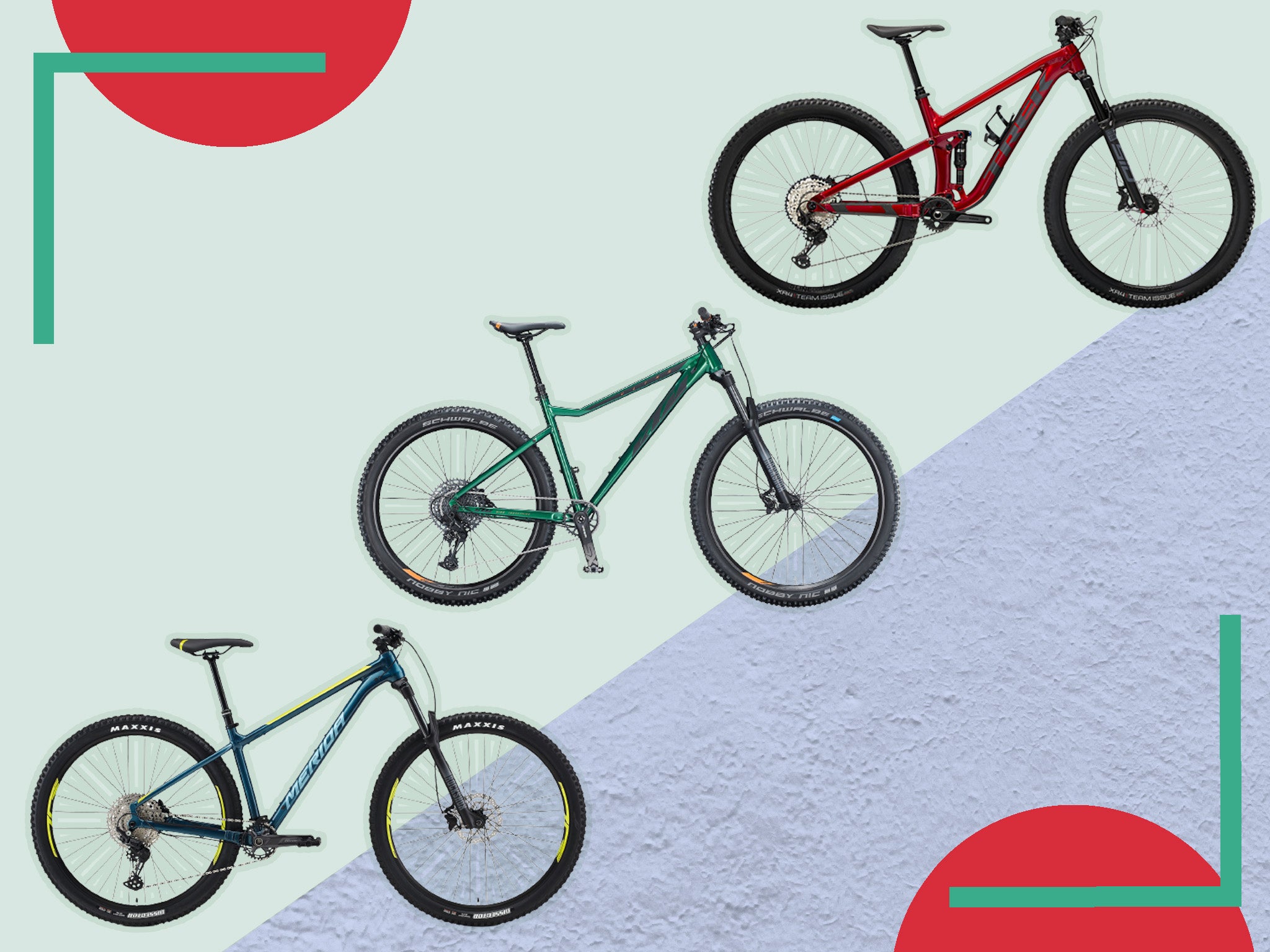
Sign up to our free weekly newsletter for insider tips and product reviews from our shopping experts
Sign up for our free indybest email.
The best kind of exercise is the kind that doesn’t feel like exercise, so when you’re hurtling down a knife-edge trail on two wheels with your heart in your mouth, it’s about as far away from the treadmill as you can possibly get. It’s this adrenaline rush that’s one of the big appeals of trail riding and why it’s such a big sport in the UK, attracting more and more rookie riders every year. That’s why we started hunting for the best bikes across a range of price points.
Now, there’s more terminology to get your head around when buying a trail bike than you could possibly imagine. You’ll hear all about the geometry of the bike (its head angles, seat angles and reach), whether it has boost spacing and how progressive the suspension is. However, we’ll leave that to the specialist mags, because what we’re aiming to do here is concentrate on the main categories that, essentially, every bike can be broken down into: frame, suspension, spec and overall ride.
The frame is where the aforementioned geometry comes in, but let’s swerve the maths lesson because what we were looking for was how all those frame angles combine to position you on the bike and keep your weight well-balanced between the wheels. This means you can ride confidently, whether you’re enjoying a nice, relaxed blue trail or going hell for leather down a techy track.
Modern trail bike frames are designed around suspension (or travel ) and you can choose between hardtails and full-suspension bikes. Hardtails may not be as fast over the rough stuff as full-suspension, but they shouldn’t be any less fun to ride. They’re usually more affordable, too, because there’s no rear shock absorbers to add to the cost, and frames are less complex. Bikes with short travel tend to be “poppier”, which, as the name suggests, makes for a livelier bike.
When it comes to the spec, we’re referring to everything fitted to the frame, from the group set (which comprises all the components that drive and stop the wheels), to the wheels themselves. Finally, we quite simply wanted to experience how well the bike performed out there on the trail. For example, did it cope with going up hills and down hills equally, or was it more geared to one rather than the other?
- 8 best folding bikes that are lightweight and practical
- 9 best gravel bikes for pedalling off the beaten track
- 10 best cycling bags that’ll keep your essentials safe
- 10 best rowing machines for building muscle
A quick word on dropper posts, which in our opinion, are one of the biggest innovations in trail riding. They simply raise and lower the seat by way of a cable and lever located on the handlebar, but can revolutionise your riding, as they make for a more natural, fluid experience out on the trails. This will make your time even more enjoyable, so we’ve made sure that most of the £1,000+ bikes in this round-up have dropper posts fitted as standard.
How we tested
We took all the bikes we could get our hands on out for a spin in all conditions – dry, wet and even wetter. We had a range of testers – from total novices to battle-scarred vets – to get to know the bikes over stiff hills, technical trails and single-track woodland before reporting back over a cup of Bovril.
Individual brands often prioritise different ride characteristics, giving each machine its own feel. That’s why the most important metric for a trail bike isn’t always a tangible one – it’s a result of the bike being greater than the sum of its parts, so that it imparts confidence.
Finally, after testing throughout the muddy months, these are the bikes that got our pulses racing and offered all the thrills without the spills.
The best trail bikes for 2022 are:
- Best all-rounder – Trek top fuel 8: £3,850, Tritoncycles.co.uk
- Best for versatility – Speicalized stumpjumper comp alloy: £2,850, Sigmasports.com
- Best value hardtail – VooDoo braag: £575, Halfords.com
- Best hardtail – Trek roscoe 7: £1,510, Trekbikes.com
- Best for control – VooDoo bizango: £750, Halfords.com
- Best for ride quality – Saracen ariel 30 pro: £2,999.99, Saracen.co.uk
- Best aggressive hardtail – KTM ultra evo dim: £1,499, Ktm-bikes.at
- Best up-hill bike – Merida big train 500: £1,650, Startfitness.co.uk
- Best for quick learners – Orbea laufey H30: £1,269.84, Sigmasports.com
- Best confidence booster – Vitus sentier 29 VR: £1,199.99, Vitusbikes.com
- Best for the bike park – Nukeproof giga 290 carbon: £5,499.99, Nukeproof.com
Trek top fuel 8
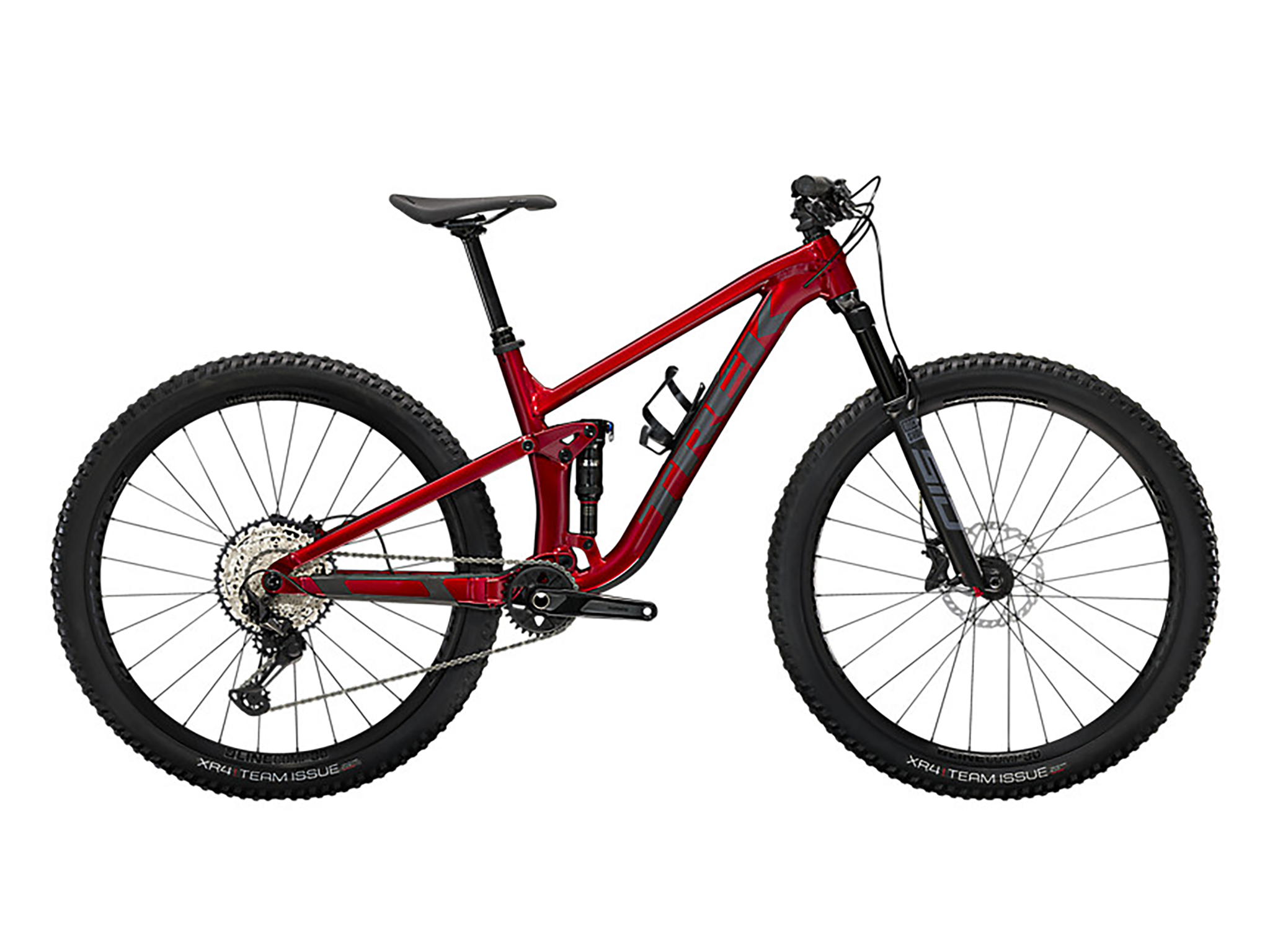
Best: All-rounder
Rating: 9/10
We loved the geometry of this full-suspension bike, with its aluminium alloy frame. It effortlessly set the rider up and offers good weight distribution, particularly on the climbs.
Don’t let us give you the impression that it means you’ll be in trouble when you’re coming back down, though. The bike is unbelievably agile and supremely reactive, whether you’re putting in a burst of pedal power at the trail centre or carving your way through the forest.
With 120mm of travel at the front and back end, the bike does have a lot less travel than is commonplace. However, you really won’t miss it, because the outstanding suspension set-up will turn almost any kind of riding into an exhilarating rollercoaster ride.
Well specced out with quality components and four piston brakes that offer up all the stopping power you’ll need, the bike allows you to climb with gusto and never stutter on the descents. This means you can really develop your skills as a rider, no matter what level you’re starting from.
The top fuel features what the manufacturers call “down-tube” storage (which you don’t get on many bikes) and consists of a neoprene case that slots into the frame itself and can hold tools and snacks. The bottom line, though, is that this bike is a tonne of fun and quite literally bounces down the trail.
Speicalized stumpjumper comp alloy
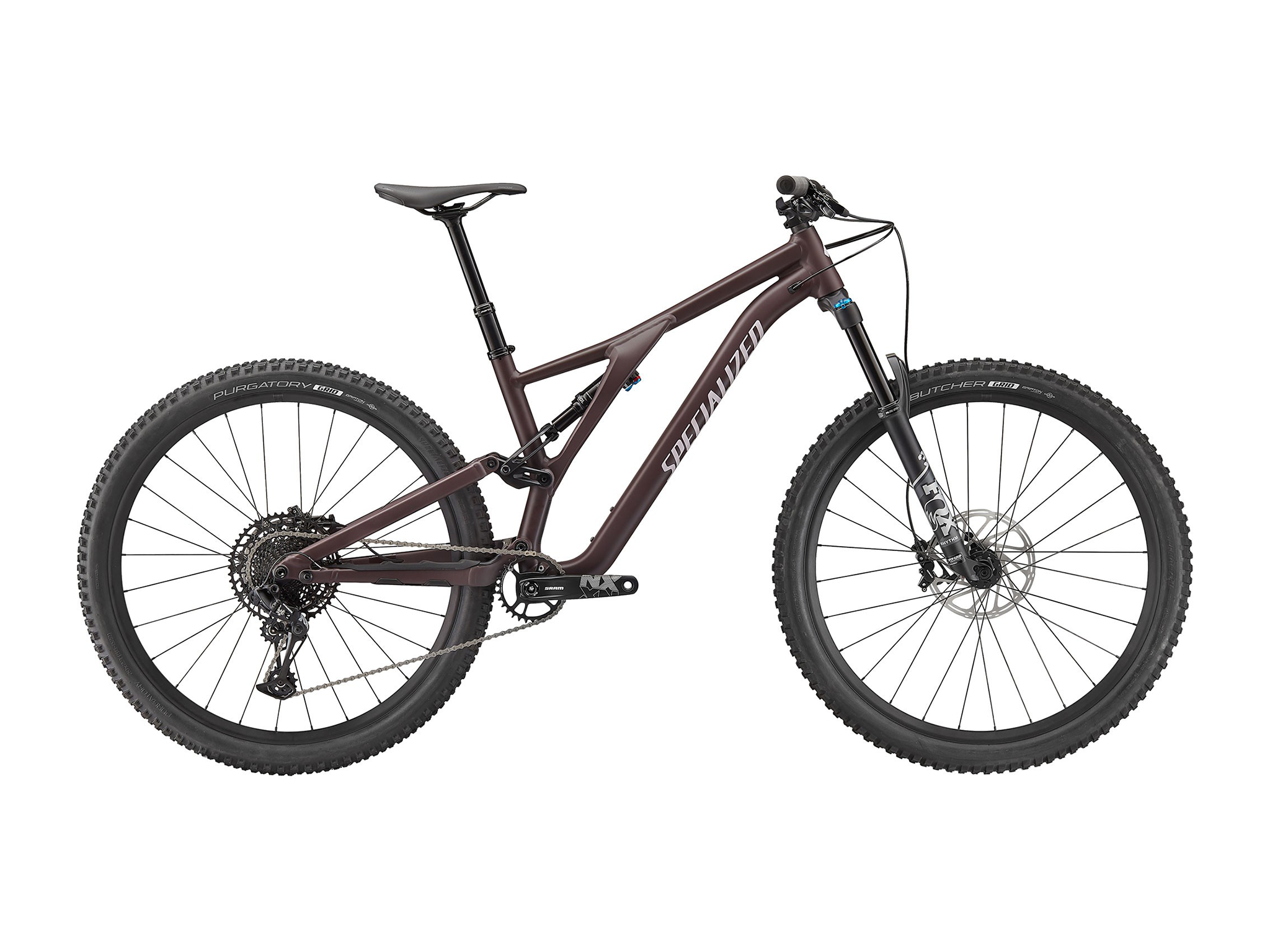
Best: For versatility
After the reintroduction of the stumpy by Specialized in 2020, we waited patiently for an alloy version, and when it finally arrived, we were mightily impressed. It’s so much more than a budget copy of its carbon alter ego, though retains a lot of the same characteristics, componentry and adjustable geometry. The latter means that you can really dial into your ride style, but even if you don’t touch anything , the stumpjumper can deliver epic thrills going up and down.
With 150mm travel at the back and 160mm at the front, the full-suspension bike is capable of taming a range of terrain, and we felt right at home and well balanced whether we were in the saddle or out of it.
The spec, as you’d expect from Specialized, doesn’t disappoint and the bike has plenty of surprises up its sleeve – or hidden away in its tubing. These include the unique SWAT storage system, which pops out of a door in the down tube and can be used to carry anything from tubes to snacks.
Voodoo braag
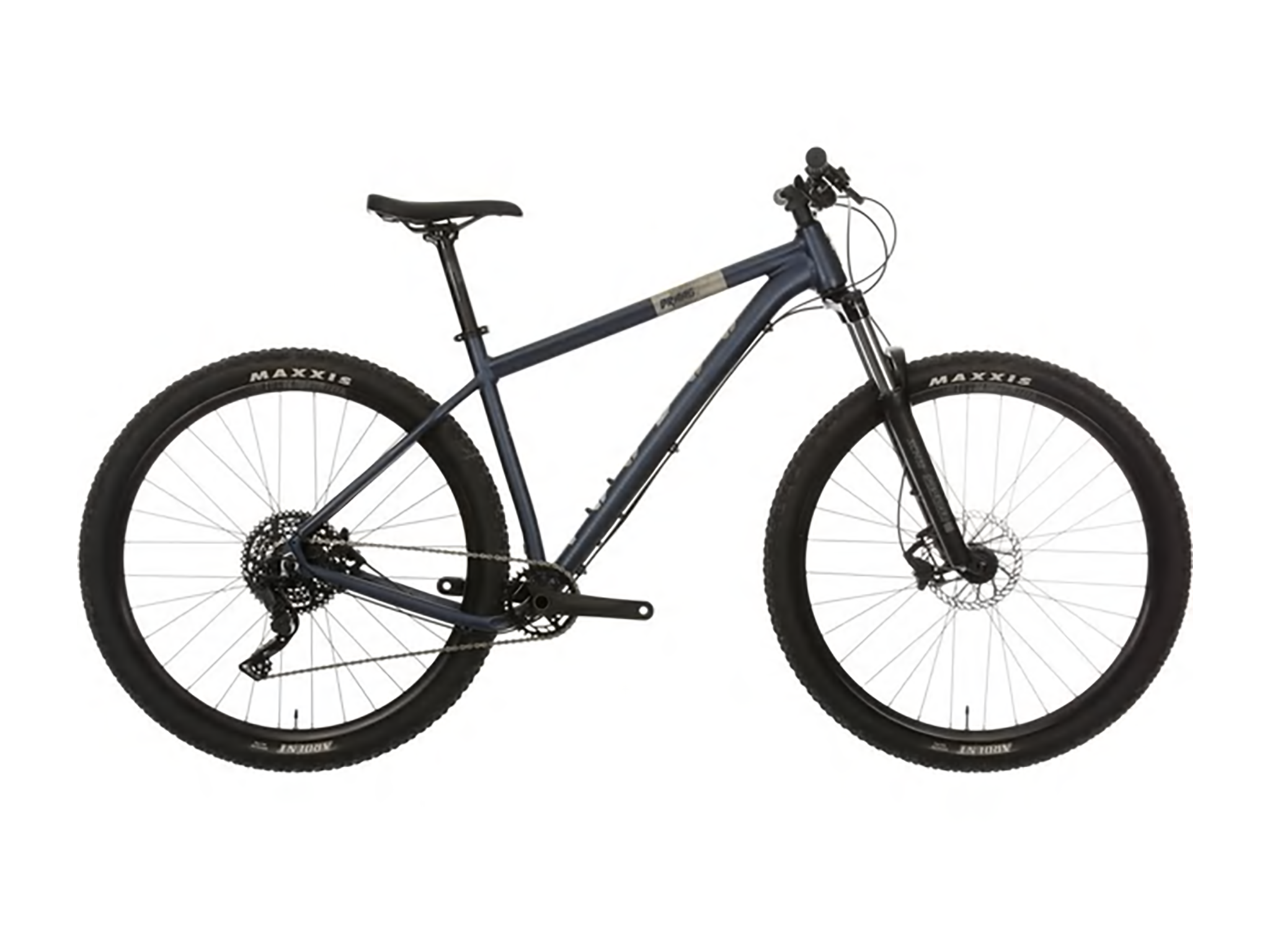
Best: Value hardtail
The Halfords brand has decided to go back to the drawing board for its 2022 bike range and has come up with something quite special with this aluminium-framed hardtail. The bike is composed going down hill, really digs in on the hills, and smooths out even the trickiest of corners.
The geometry puts you in a secure riding position but allows for all the right moves when you decide to put the power down through the pedals. Plus, you can really shift, thanks to a 1x drivetrain with a nine-speed cassette – this is an unusual find for a bike in this price category, which usually comes with a double chainring and smaller cassette. The single-ring also makes it easier for new riders to quickly find the right gear.
The build quality of the braag echoes that of a bike twice the price, and the spec backs this up with a good tyre combo, hydraulic brakes and a well-thought-out cockpit, which makes the bike easy to control at speed and imparts confidence as you mature as a rider.
Talking of rider progression, this bike will grow with you, as it’s easily upgraded, with the potential to swap in a dropper post, go for tubeless tyres and change the fork, which comes with 120mm of travel as standard.
Trek roscoe 7
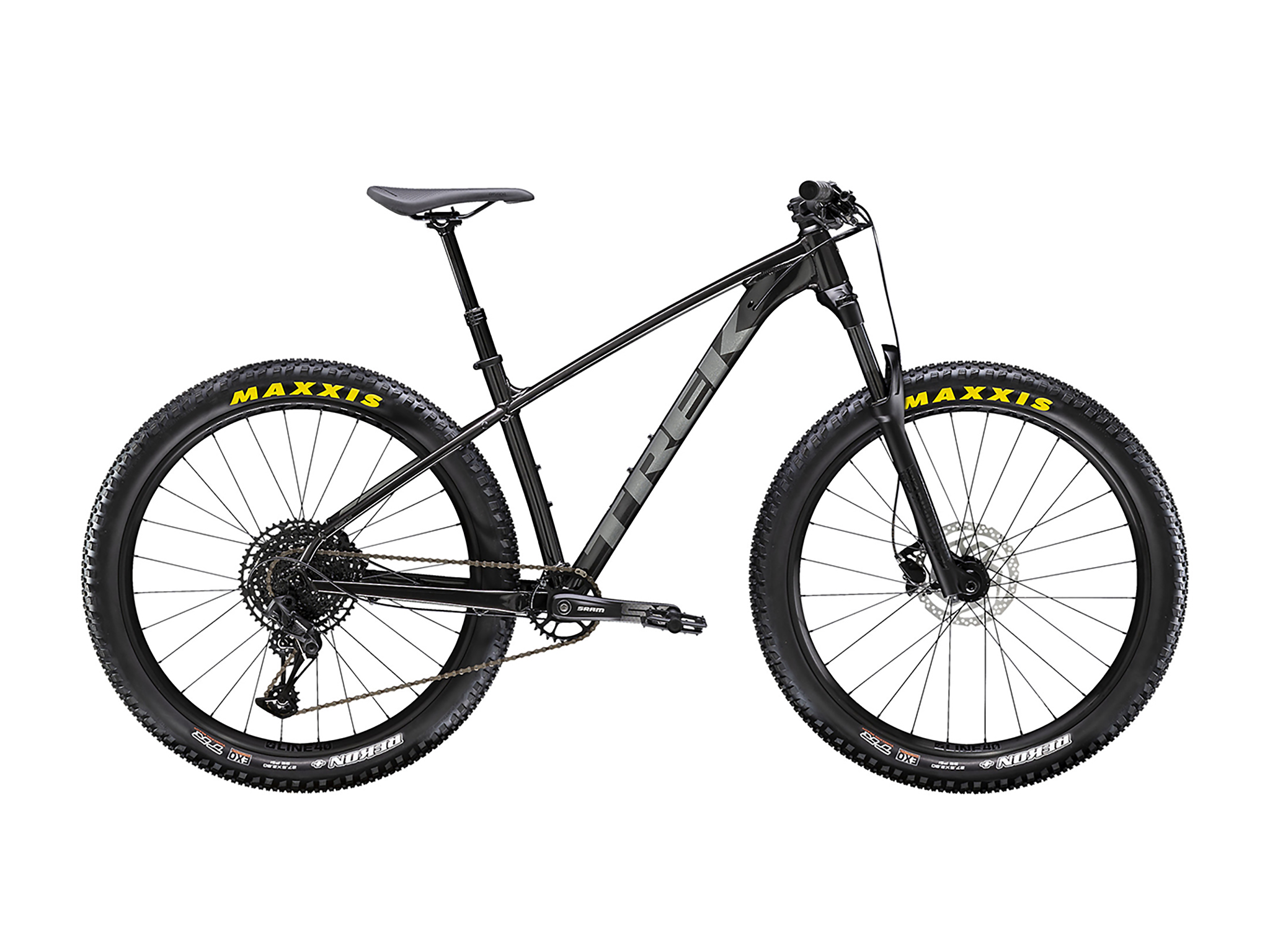
Best: Hardtail
Rating: 8/10
The updated Roscoe hardtail has an aluminium alloy frame loaded with brand-new kit, including a 1x12 drivetrain, Shimano gears and a dropper seat post for aggressive trail riding, if that’s your thing. This means if you’re a fast-learner, you won’t outgrow the bike too quickly because all the components will continue to back you up as you become more confident and adventurous.
The bike’s geometry is set up to give you the confidence to tackle a range of trails, and this is backed up further with Trek’s own well-cushioned, large-volume tyres, which offer plenty of cushioning – a particular benefit on a hardtail. What’s more, the air-sprung 140mm travel in the fork really helps to smooth out uneven ground, and is easy to set up for your riding style and weight.
The roscoe 7 is currently unavailable online, but you can order it in-store at a retailer near you.
VooDoo bizango
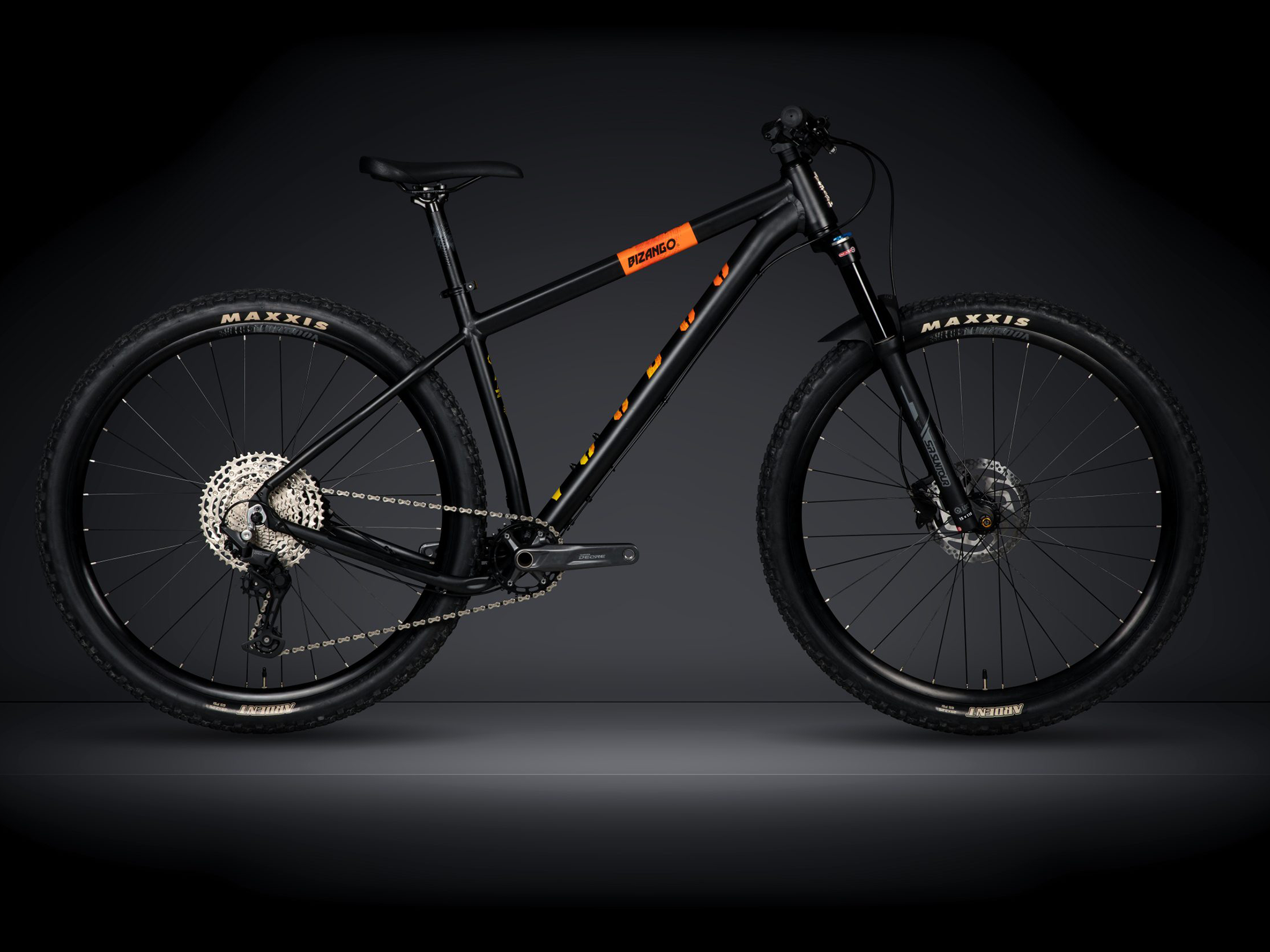
Best: For control
Another hardtail offering from Halfords for 2022, the bizango’s aluminium frame does a great job of setting the rider up for all-day riding, thanks to some confidence-boosting geometry that allows for plenty of movement in the saddle. This means you can easily set yourself up in a position that will take the sting out of any climbs that come your way, as well as make you feel stable enough to burn down the hills and remain stable in the corners.
The bike can hold its own on techy sections of the trail, too, and the air-sprung 120mm fork soaks up plenty of punishment, so it’s another great starting point if you’re looking to get into trail riding for the first time.
The drivetrain converts pedal power efficiently, while the hydraulic disc brakes are always on hand if you need to ease off. The tyre combination gave a good balance of grip and support, and roll well over uneven terrain.
The bizango comes with a rigid seat post, but you can swap that out for a dropper as and when you need it. Shifting gears was effortless and just added to the fact that this bike is a ready-to-ride all-rounder.
Saracen ariel 30 pro
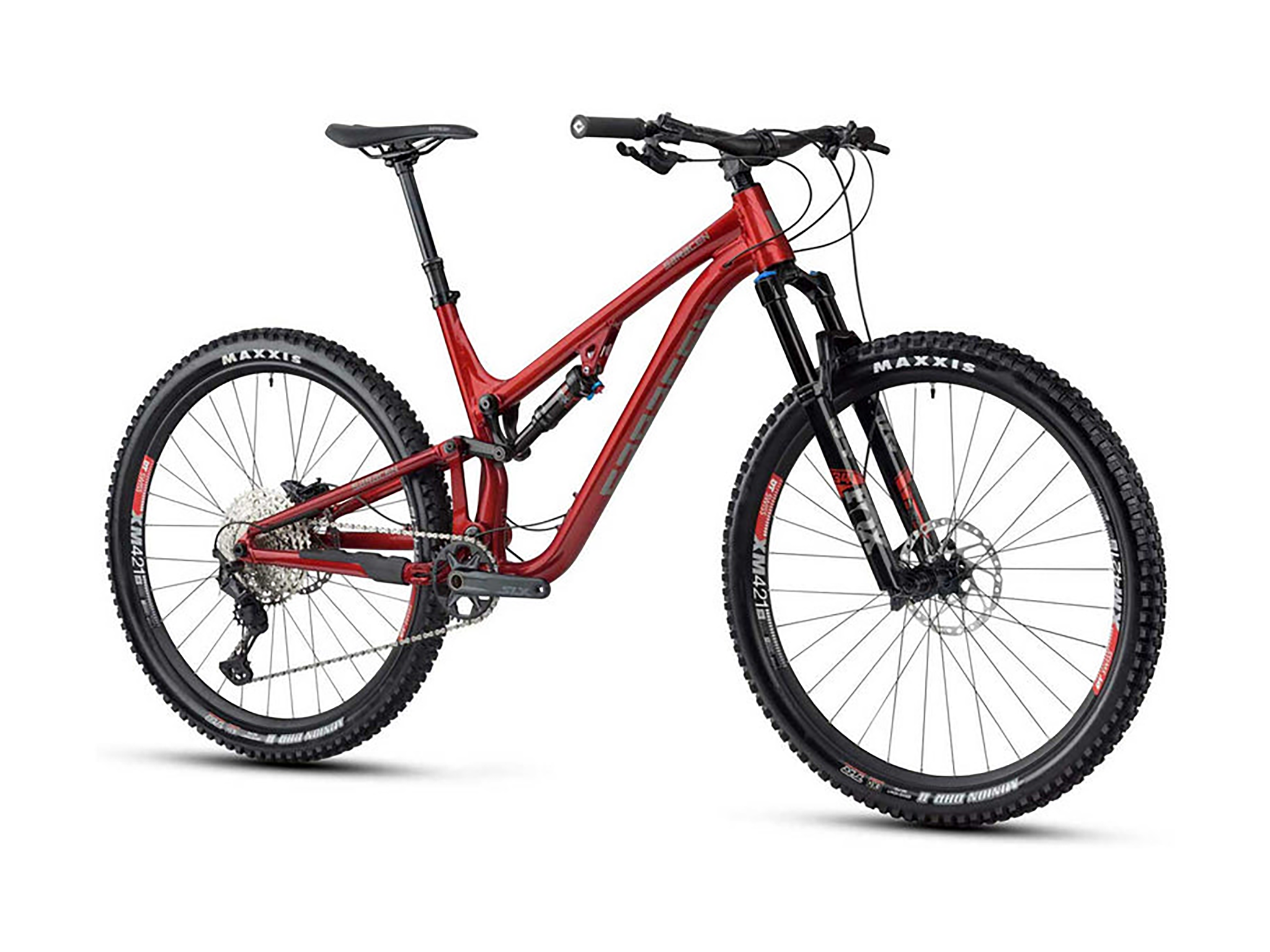
Best: For ride quality
We’ve had a lot of excellent experience with bikes from this legendary UK manufacturer, which relaunched in 2020. This homegrown full-suspension with aluminium frame is no exception – Saracen has clearly put a lot of thought into what kit it wanted bolted to the bike, as well as the stability of the geometry.
The ariel 30 pro is beautifully balanced and the components will put a smile on the face of aggressive riders, as well as anyone who just wants to get off the beaten track and have some fun.
With 130mm of travel front and rear, the bike will have no problem eating up the ground ahead – even when you’re going flat out – and will get you from top to bottom without you ever feeling like you’re out of control.
The stop and go kit was extremely effective, with the four-piston hydraulic disc brakes delivering plenty of stopping power when needed, while the 12-speed gears meant that we were never found wanting on the ups or the downs.
Throw in a dropper seat post and a comfortable, confidence-inspiring cockpit, and you begin to understand why Saracen has such a good reputation. The fact that the brand is now online-only also means it can deliver bikes without inflating its prices, which is why you’re getting a helluva lot of bike for your money with the ariel.
It’s out of stock at the moment, but you can easily sign up for an email notification for when it’s back on the website.
KTM ultra evo dim
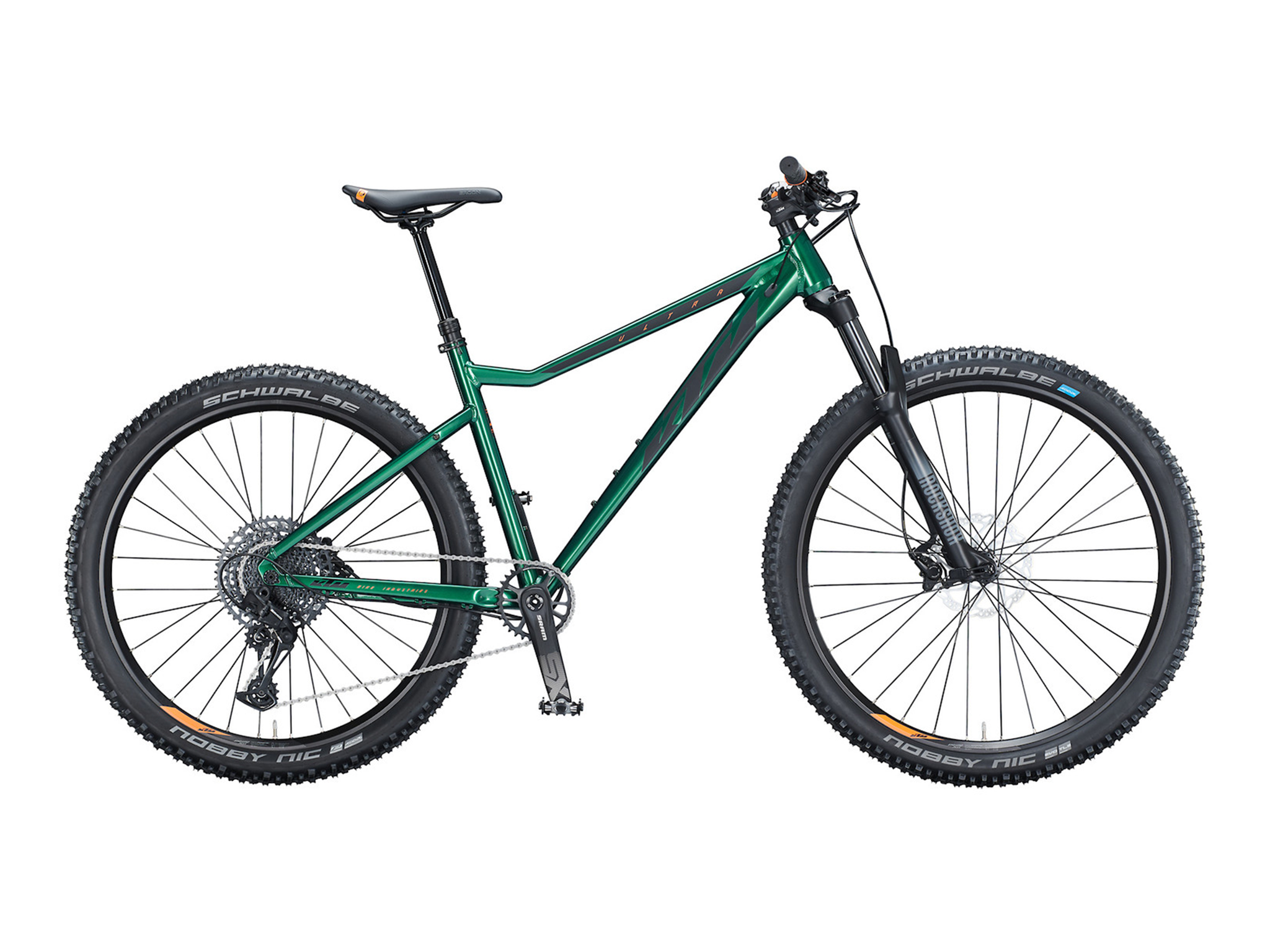
Best: Aggressive hardrail
Rating: 7/10
When bike manufacturers suffix a bike with EVO, it usually means that it’s a more aggressive bike when it comes to going down hill, and this demon hardtail from Austrian manufacturer KTM certainly lives up to that billing.
Tyres can make or break a bike and the KTM is sporting a mullet, which is delicious bike speak for a model with mixed wheel sizes. These really add to the fun factor of the overall ride, thanks to the smaller back tyre, which makes for some great handling – we were never in danger of being stuck in a trail’s turns, even when we entered with more speed than we probably should have.
The aluminium alloy frame’s geometry makes the bike feel very agile – with the 130mm of travel out front adding to the enjoyment – while the hydraulic disc braking is sharp enough to make us feel secure.
The 150mm dropper post makes it easy to find the optimum position whether you’re climbing, descending or just making progress over the flat. The 1x12 drivetrain offered up plenty of pedal efficiency, while the lovely wide handlebar added to the reassuring sense of control you have in the saddle.
Merida big train 500
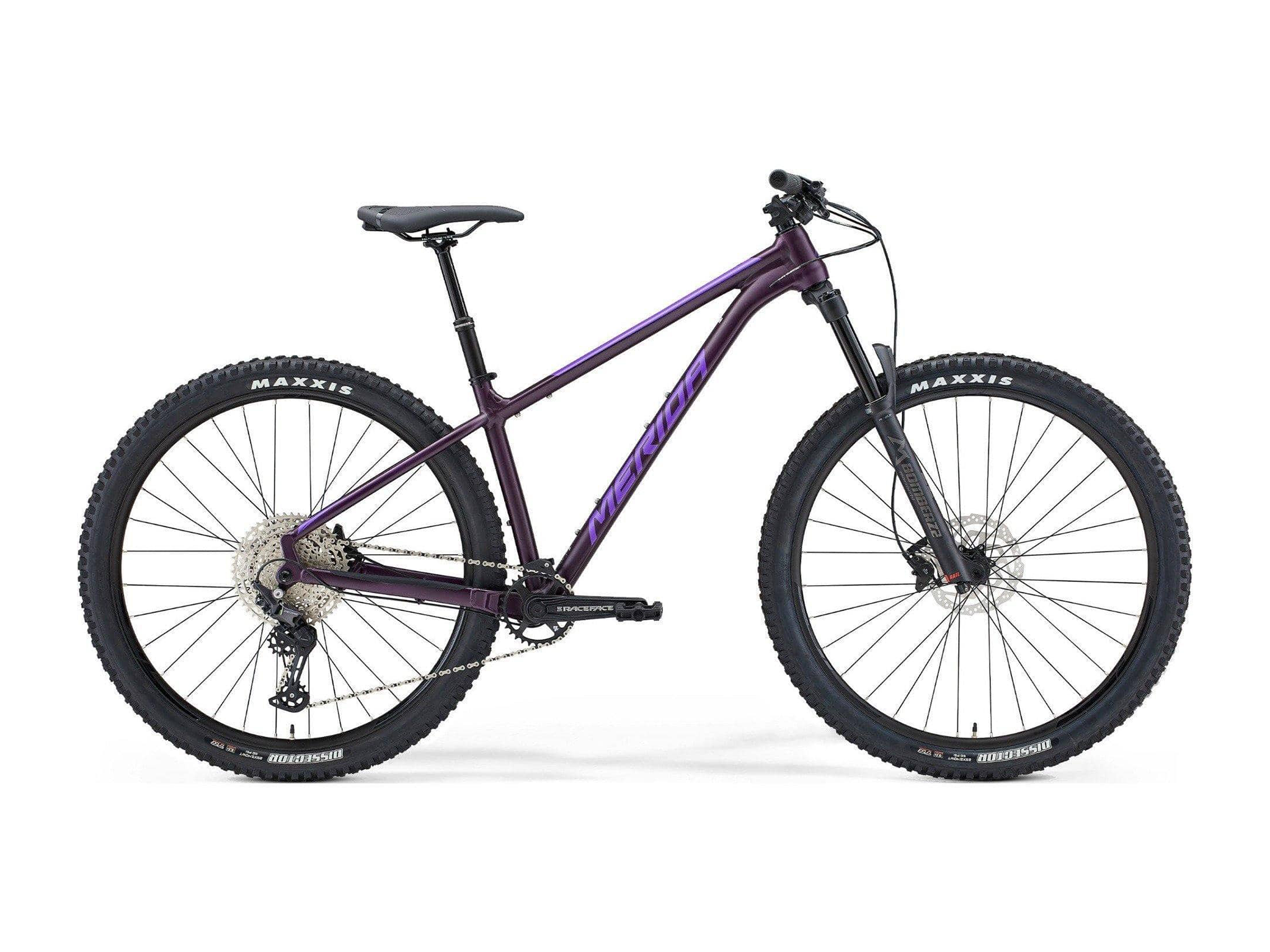
Best: Up-hill bike
If you’re heading for the hills, then you’d better make sure you take Merida’s big trail with you. The geometry of its aluminium alloy frame is such that it allows you to power down on the pedals while keeping your weight forward, which is perfect for those lung-busters.
Having said that, we had no problem finding a nice natural position on the flat, and the 150mm dropper means you can concentrate on any descents without worrying about hitting either the frame or the saddle. Plus, there’s more than enough room to manoeuvre when the riding gets more technical.
Hardtails are all about having fun, and this bike definitely lives up to that billing. It’s bolted with all the tools you’ll need to keep going all day – from hydraulic discs and a fork with 140mm to a wide handlebar and a 1x12 drivetrain.
Orbea laufey H30
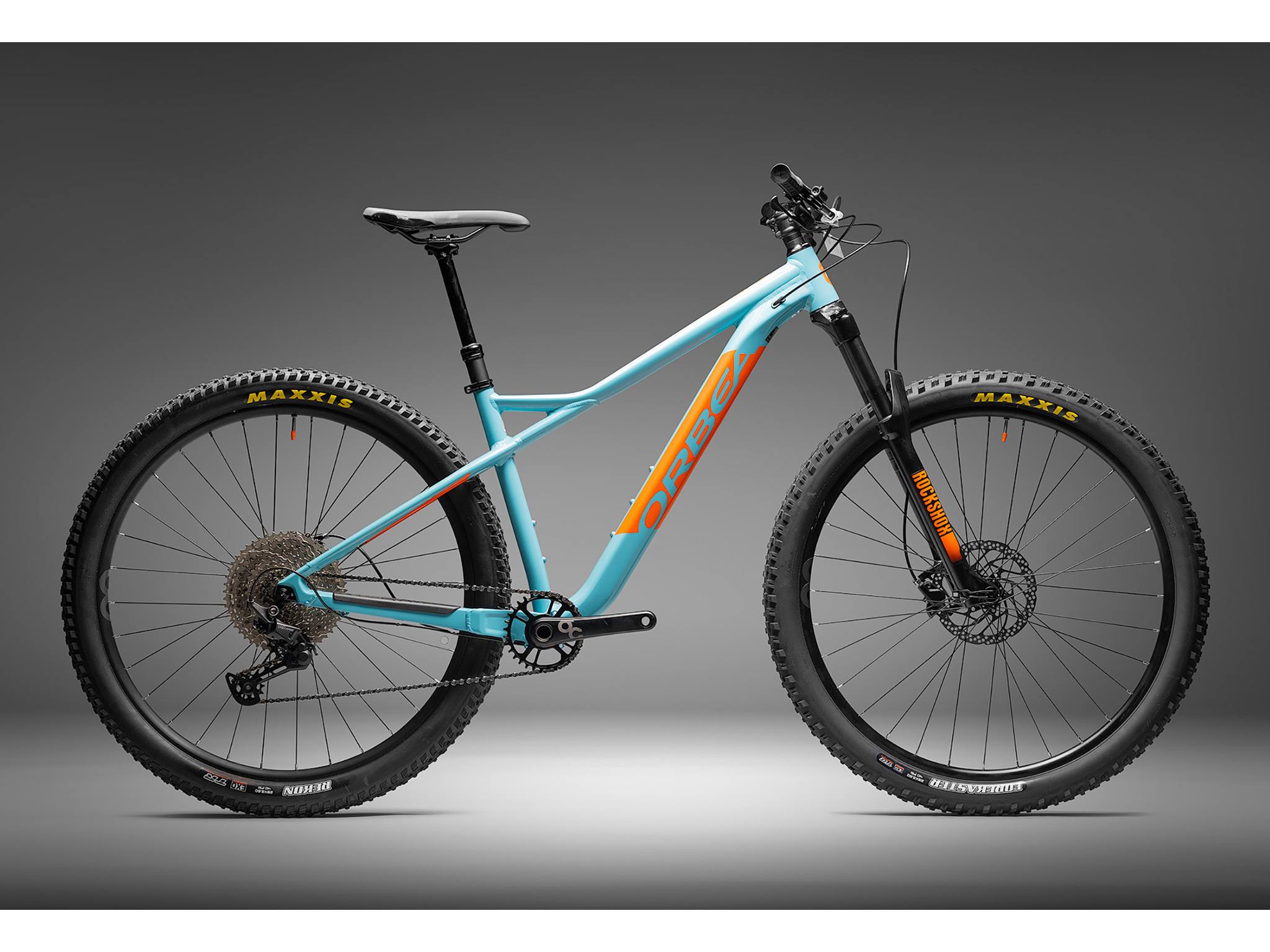
Best: For quick learners
This hardtail sports confidence-inspiring geometry, which places you in a well-balanced position in the saddle, while the 140mm fork means you can take on the trail without having to keep backing off. Having said that, there are hydraulic disk brakes should you need them to cool off a particularly hair-raising descent, and the dropper post means you can find a stable position going down and pushing up.
The rest of the bike’s spec is pretty special, too, with a quality drivetrain and a wheelset that’s grippy and good for acceleration and rolling speed.
The components are well suited to ensure you can push your limits safely as you progress up the learning curve and become more experienced.
Vitus sentier 29 VR
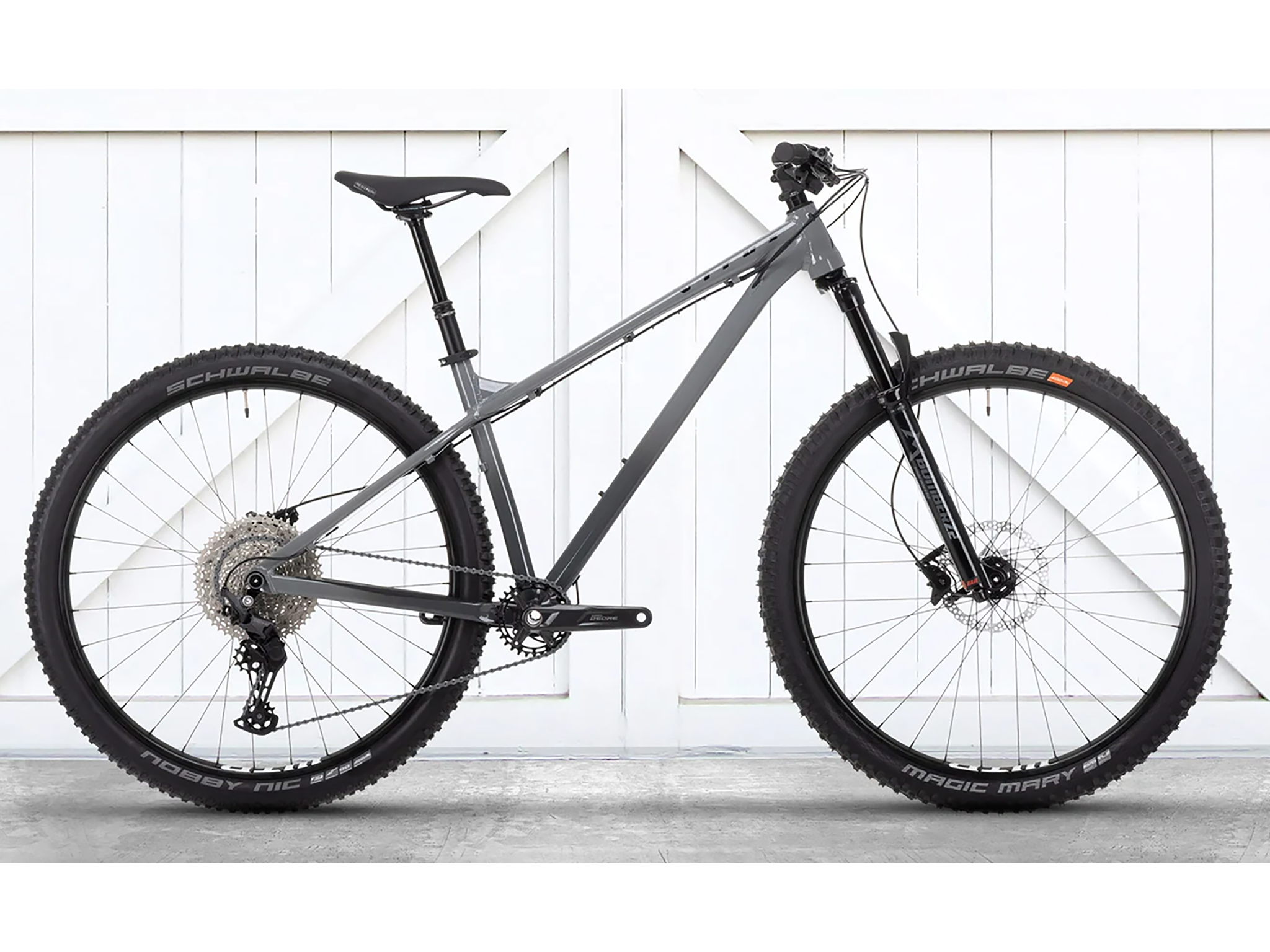
Best: Confidence booster
It’s obvious how important confidence is when it comes to riding two-wheels, especially when those two wheels are being asked to do more than just go in a straight line. So, step up the sentier, with a geometry and general purpose that seems to be all about strengthening your skill set and making you a better rider.
A lot of thought has gone into outfitting this bike, with a quality group set and a front fork that offers 140mm of travel with good progression, so the suspension seems to become more effective, the more you ask of it.
The brakes performed well in both wet and dry conditions, while the tyres were good for both rolling speed and grip. It’s all topped off with a nicely set-up cockpit, which adds to the overall feeling of control going up, down and in the turns, too.
Nukeproof giga 290 carbon
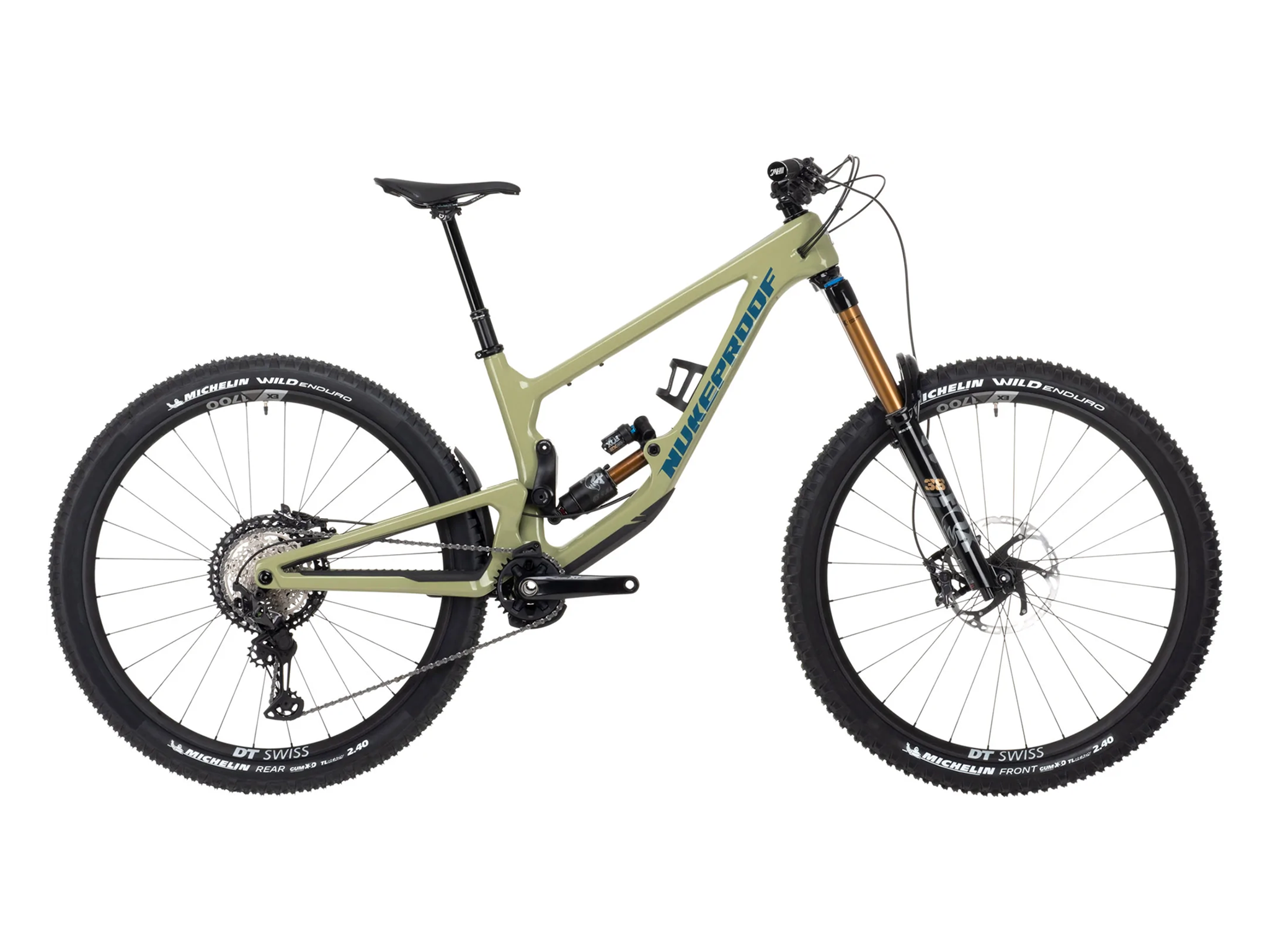
Best: For the bike park
If there’s one thing that you need to tackle a bike park, it’s good brakes. That’s why the impressive four piston stoppers fitted to this version of the giga 290 offer power, reliability and the option to get you out of trouble.
At a bike park, one of the things that you can almost guarantee is that you’re going to be spending quite a lot of time in the air, so suspension suddenly becomes your best friend. The giga 290 gets airborne very easily, and is equipped with incredibly versatile suspension, which does an amazing job of taking the sting out of your landings, while also providing plenty of grip in the corners.
In order to get the most out of a bike park, you need a ride that oozes confidence, and that’s exactly what you’ll feel in the saddle of this beauty.
The verdict: Trail bikes
Trek has pulled off a neat trick with the top fuel 8 by building on the bike’s roots as a racer and evolving the geometry. In doing this, Trek’s turned it into a trail bike that still retains that super-quick pedigree but is bolted with components that will appeal to a huge cross-section of riders, from those who like to attack from the first pedal stroke to those who are just out to end the day spattered with mud and grinning from ear to ear.
Voucher codes
For the latest discounts on cycling gear and other sports essentials, try the links below:
- JD Sports discount codes
- Under Armour discount codes
- New Balance discount codes
Planning to hit the road for a longer period of time? Then check out what we’re bringing on our 18-month cycle trip in the Americas
Bike Awards 2022 | The 11 Best Mountain Bikes
11 Superb Bikes for Slaying Singletrack, Ripping Bikeparks, and Trail Riding
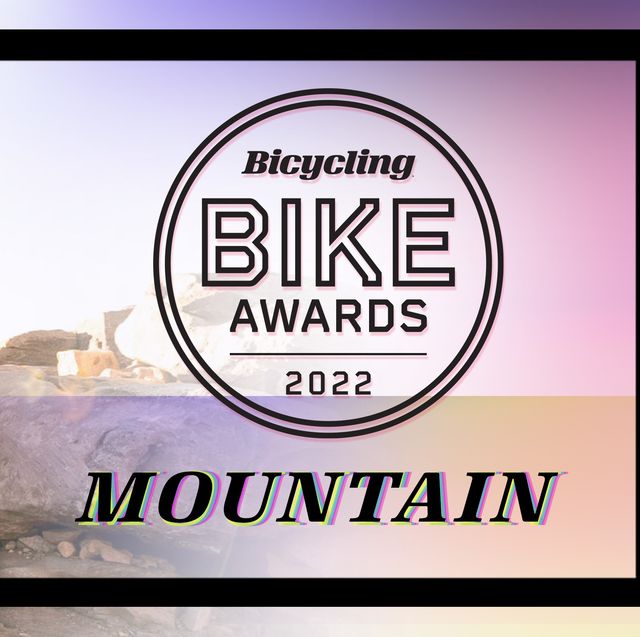
Juliana | Wilder X01 AXS TR Carbon CC $9,450 // 23.7 LB (Small)

Purpose-built for the XC rider who has outgrown 100mm-travel bikes, the Juliana Wilder can take on more challenging trails, bigger features, and wilder terrain. At just under 24 pounds—in a size small—and with 115mm-travel in the rear, it’s an XC bike that is just as capable as many heavier-weight trail bikes.
Juliana sweats the details in the frame geometry. By incorporating chainstay lengths specific to each frame size, the brand delivers on the Wilder’s intentions of a snappy, fun ride. You’ll find this bike easy to flick between roots and rocks of any size. This bike begs you to let your hair down and rip the party lines.
The Wilder still responds with urgency when you want to be the first woman on the singletrack after the spicy gravel climb. The X01 Eagle AXS Shifting and 12-speed, 10-50 tooth cassette lend you the smoothness and grace you might be lacking once your heart rate gets pinned in pitch or battle. Once you crest the summit, drop the butter-smooth, RockShox Reverb Stealth dropper post and let the Wilder wile out.
Beyond the Wilder’s ride quality, the bike is loaded with nice details. A tiny chainguide offers that little bit of extra security. Cable routing is fully internal, giving the bike a sleek, almost spacecraft-like majesty. The pairing of Industry Nine Hubs and Reserve 28H Carbon Rims is a great choice for climbing efficiency, lifespan, and reliable engagement. Parts of the frame most vulnerable to chain slap and trail spew are protected with a molded rubber coating.— Taylor Kuyk-White
Read Full Wilder Review Juliana Wilder Gallery
Rocky Mountain | Element Carbon 90 $9,590 // 24.6 LB (Medium)
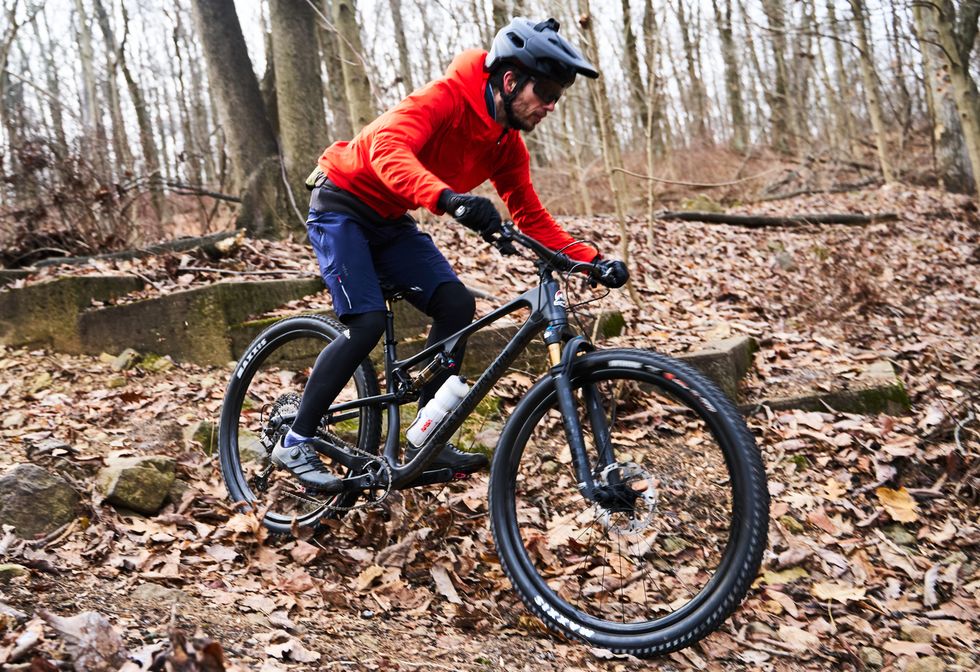
The new Rocky Mountain Element sheds the “race” from its cross- country race bike roots and becomes a better bike in the process. For most of us, a World Cup–level race bike doesn’t make a ton of sense, but until very recently it’s been the only option for riders who like to ride fast uphill as well as down. The Element does nearly everything a race bike can do, and a whole lot more.
With its relatively low weight, trail-oriented geometry, and ample suspension travel, it’s capable on even the most technical East Coast rock-crawl- style trails. But if you primarily ride or race mostly smooth, flowy trails without a lot of elevation change, the Element’s 120mm of rear wheel travel and 130mm fork might actually be too much bike.
The Element excelled on more rugged terrain. The combination of the reworked suspension design, shock tune, and low weight felt incredibly efficient under hard pedaling, even with the suspension fully open. This combination shined brightest on technical climbs, where the Element tracked the ground well without ever feeling like it was wallowing in its mid-stroke.
For riders looking to ride a bit of everything, from technical climbs to steep and fast descents, who have no interest in dragging around a 30-plus-pound trail bike but find XC race bikes to be too limiting, the Element strikes the balance perfectly.
Read Full Element Review Rocky Mountain Element Carbon 90 Gallery
⚡ Yeti | 160E T1 $13,000 // 50.8 LB (Medium)
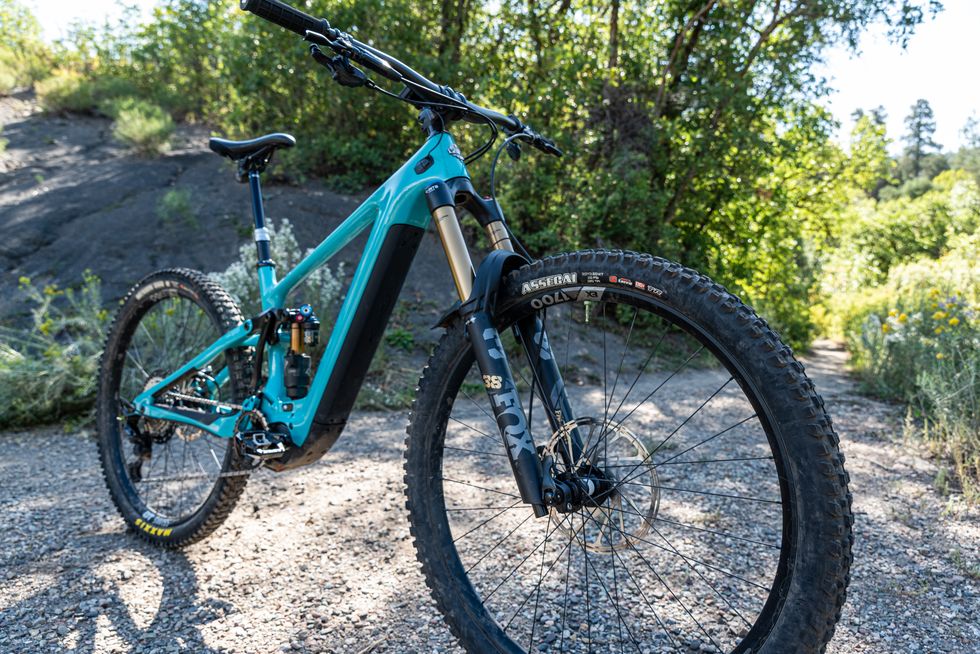
Yes, it has a motor, but to classify Yeti’s first e-bike as anything other than an enduro race bike is foolish. It rides like it was made to take the shortest, fastest line through every bit of terrain you can imagine; it unpuckers the pucker lines. Yeti’s new, and e-bike-specific, six-bar rear suspension is just short of a revelation, offering traction, support, control, and efficiency that’s close to a new benchmark for mountain bike suspension. But take heed: If you’re not going to pin it 100 percent of the time, you may be better off with bikes more suited to all-around riding. Yeti’s crew made the 160E for e-bike racing, and the ride experience leaves little doubt that they achieved their goal.
Read Full 160 E T1 Review Yeti 160 E T1 Gallery
Specialized | Stumpjumper Evo Pro $8,600 // 30.3 LB (S3)
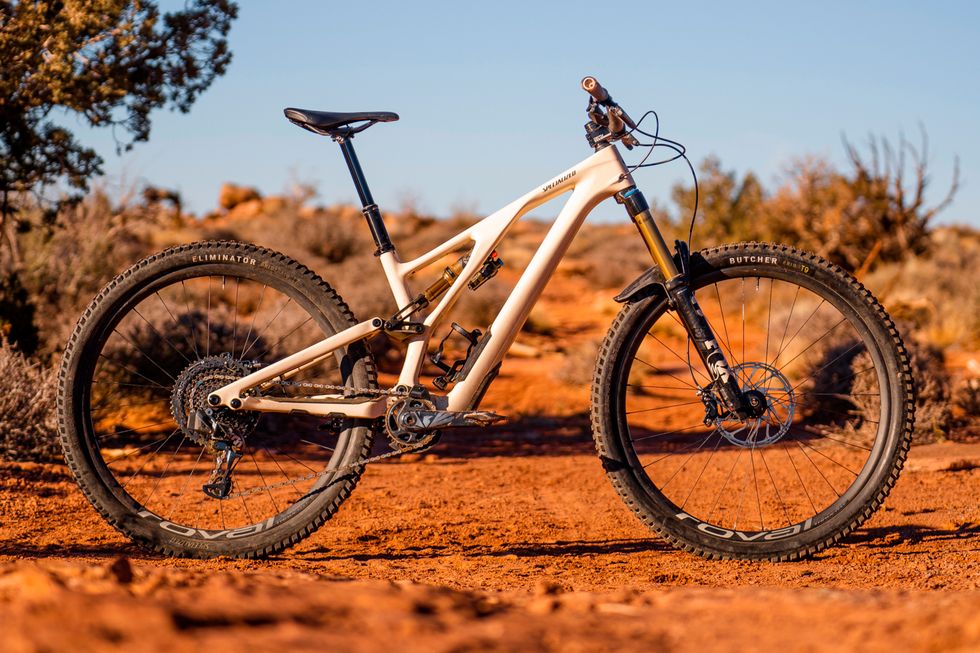
Specialized | Stumpjumper Evo Elite Alloy $5,800 // 33.4 LB (S3)
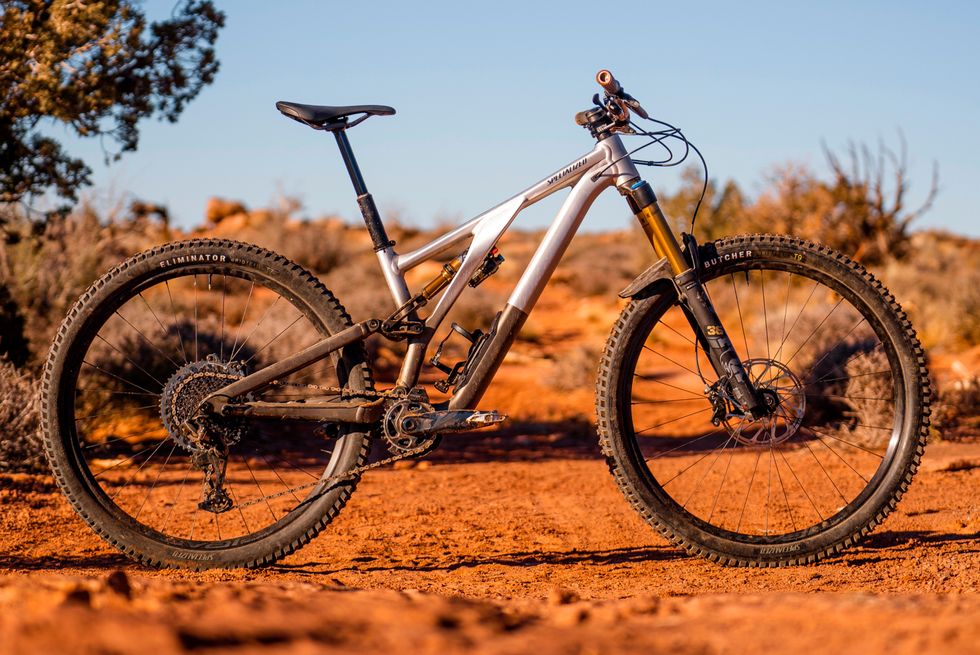
Here we have two Specialized Stumpjumper Evos with the same Fox Factory suspension (150mm rear, 160mm front), same tires, same geometry, and same features (1x12 drivetrain, SRAM Code brakes, internal frame storage, adjustable geometry, optional link to correct suspension and geometry when running a 27.5 rear wheel). The $2,800 price difference mainly comes down to materials: one using a carbon frame (with carbon rims and carbon handlebar) and the other being aluminum-framed (with aluminum rims and aluminum handlebar). They are both superb mountain bikes. As Specializeds, they don’t exude the ephemeral zest of a boutique brand, which means something to some riders. But they lack for nothing on the trail. They are two of the most well-rounded mid-travel trail bikes you can buy right now. Uphill, downhill, flow trails, tech trails, high speeds, low speeds—they are the definition of balanced performance.
But which one should you buy? The aluminum bike is the smarter purchase. If dropping $8,600 on a mountain bike is no big deal, then get the carbon bike. But for many, spending $5,800 on a mountain bike is rough enough. After riding both bikes back-to-back, we don’t think there’s enough difference in the way they feel or perform to make the carbon bike worth the additional money.
What it really comes down to is bike weight and how much it means to you. The carbon bike is not quite 10 percent lighter—30.3 pounds for the carbon and 33.4 for the aluminum. If you climb a lot—and especially if your climbs are steep—climbing is easier and faster on a lighter bike. A rider on a 10-mile-long climb with a 10 percent grade, and holding 200 watts of power, will get to the top about two minutes quicker on the lighter bike. Is a handful of minutes on every long, tough climb worth $2,800 to you? If it is, there’s your decision.
As for us, we’re not buying a 30-plus-pound 150mm bike with uphill PRs in mind. If there had been a significant difference in the way the two bikes handled or performed, we might be swayed. But there wasn’t. There was only a slight difference in the reactivity between the bikes. Not surprisingly, the lighter carbon bike changed direction a tiny bit easier and popped a little more on hits. But it wasn’t a $2,800 difference. Note, however, that a three-pound difference might be more significant to smaller or less powerful riders.
We don’t want the performance of both these bikes to get buried in this comparison. Both of these Stumpjumper Evos are superb bikes—almost annoyingly good. Specialized packed a lot of features and adjustability into a clean-looking bike. The Stumpy’s FSR rear suspension is about a gazillion years old, but on the Evo it realizes its potential to be one of the best, most well- rounded—meaning climbing performance, bump control, sensitivity, support, braking traction, climbing traction, pedal kickback—systems found on a modern mountain bike. The geometry and handling meet the needs of today’s riders and trails but remain accessible to less-skilled riders. It’s hard to imagine a rider in the market for a trail bike who wouldn’t be well served by the Stumpy Evo.
Specialized Stumpjumper Evo Pro Gallery Specialized Stumpjumper Evo Elite Alloy Gallery
Santa Cruz | Chameleon D AL $2,400 // 32.5 LB (Large)
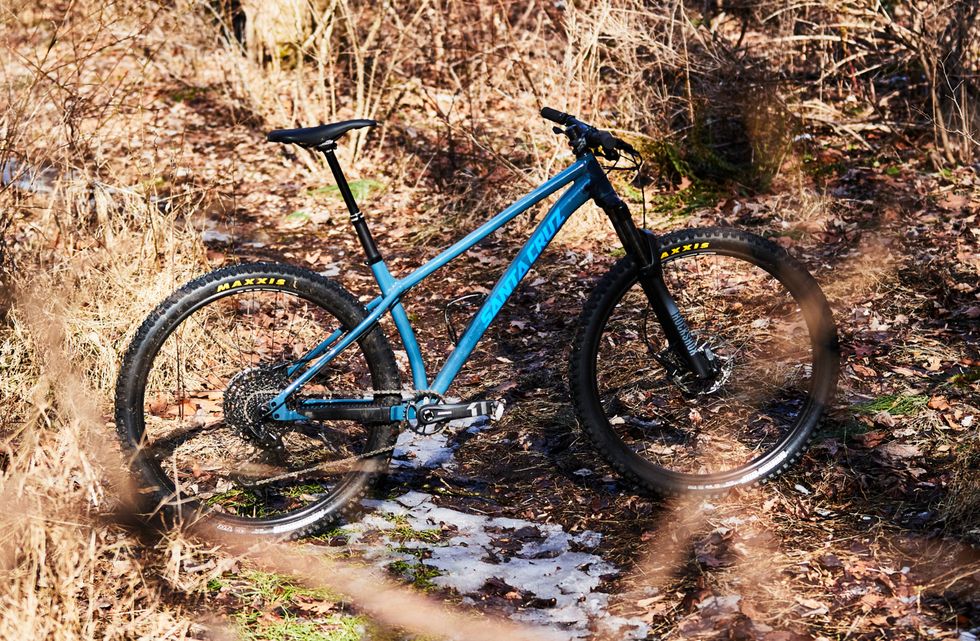
Aluminum hardtails are the unsung heroes of mountain biking. Often passed over for flashier carbon-fiber rigs or complex full-suspension designs, a good aluminum hardtail remains a great option for lots of riders hitting the trails. Whether you want to go fast but don’t need big travel or can’t be bothered with the extra maintenance of a full-suspension bike, if this sounds like you, the Chameleon might be your next bike.
Offered in either dual 29-inch wheel or MX (29-inch front, 27.5 rear) wheel configurations, the $2,400 Chameleon D AL comes with 12-speed SRAM Eagle drivetrain, grippy Maxxis tubeless tires, and an SDG dropper post. The Chameleon frame has tons of standover clearance, and the dropouts can be easily swapped if you want to run the bike as a singlespeed.
Santa Cruz Chameleon D Gallery
YT | Capra Uncaged 6 $9,499 // 32.0 LB (Medium)
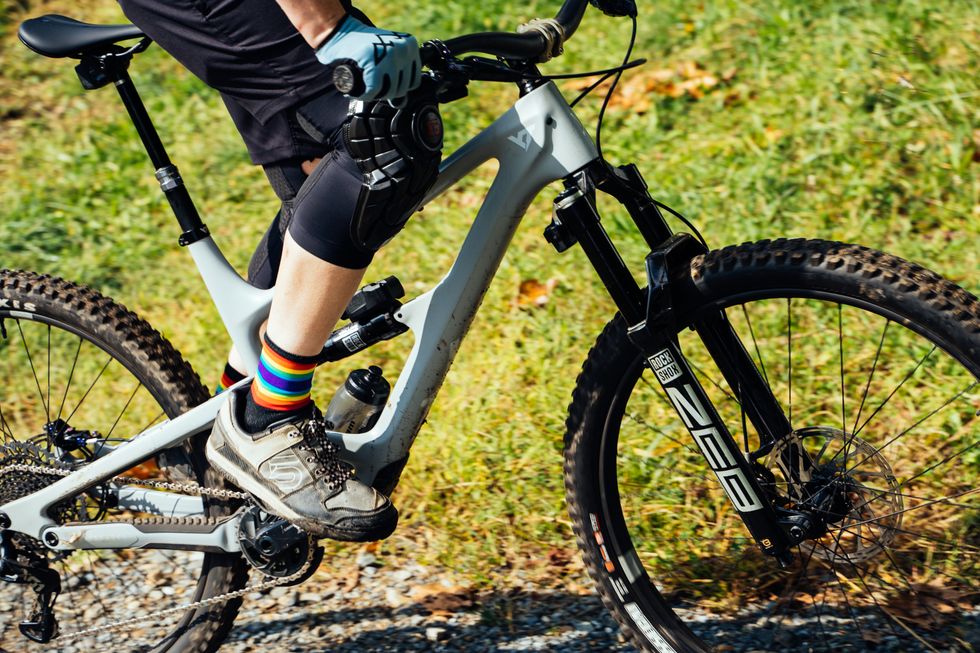
No bike that we tested in the past year captivated our team the way YT’s Capra did. The 170mm-travel 29er arrived with the force of the first-gen iPhone—promising wondrous tech and rare utility. That tech comes from RockShox’s Flight Attendant smart-suspension system married to a surprisingly light and lively long-travel 29er.
The bike is made for winning Enduro World Series races and rallying in bike parks. It feels nearly unflappable on all-out descents, with the stiff frame and supportive suspension providing precise control in corners. But the Capra also impressed us with how energetically it ascended techy climbs and happily cruised down flow trails.
The bike’s inherent versatility makes it an excellent platform for RockShox’s Flight Attendant system. The new platform uses wireless sensors on the fork, in the shock, and in the crankset to change suspension performance based on the terrain. Those sensors make calculations every five milliseconds, and relay that info to actuators in the fork and shock to quickly—but not instantaneously—change the suspension’s damping mode between open, pedal, and firm settings.
Equipped with that killer tech, the Capra becomes a big bike with few limits—something that devours big hits and wild descents but that you won’t mind climbing or pedaling on mellower trails. If you’re not an early adopter of tech, or if the Capra Uncaged price deters you, YT offers less expensive versions without Flight Attendant that start at $4,499. If dual 29-inch wheels aren’t for you, YT also has mixed-wheel sizes (29-inch front/27.5-inch rear) available on Capra MX models.
YT Capra Uncaged Gallery Flight Attendant Video
Scor | 4060 ST GX $6,600 // 30.5 LB (Medium)
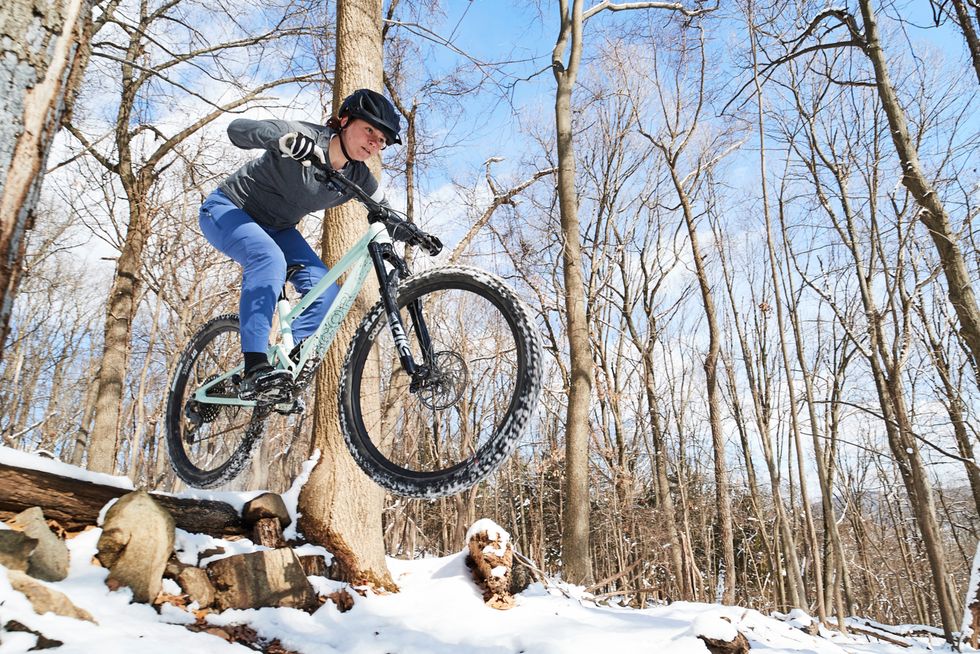
Fun, like obscenity, is hard to define but always knowable. I don’t usually say a bike is “fun” in a review; riding bikes is inherently fun and therefore almost all bikes are fun. But there are bikes—like this SCOR 4060 ST—that make the word rise to the top of my brain. The feeling manifests as involuntary hoots that punctuate moments and features on the trail. I don’t know exactly what ingredients make a bike feel more fun than others, but it has something to do with a bit of extra quickness in the handling, a little more pop in the suspension, and a bit more whip in the frame—all qualities this SCOR has.
I’m also mightily impressed by the 4060’s dual-link suspension, which pedals crisply for efficient climbing while also offering a nice balance of sensitivity, support, and control in all phases of its travel. But while the 4060 ST feels quick and ready to change direction with a light touch, it’s also adequately calm at higher speeds, inspiring confidence when I pushed my limits in demanding terrain.
I think these traits stem from its snappiness. I find that many of today’s long, slacked-out mountain bikes don’t respond quickly enough at trail speeds, and require a lot of muscling. That can feel unnerving like they’re pulling me along where they want to go. Some of my favorite bikes—this SCOR, Evil’s Following, Spot’s Mayhem 130—all have a bit more quickness, an “on the toes” feel—less stable. The SCOR may not plow the chunderiest chunder at freakish speeds like a bro-sled, but that’s not the point of this bike. It’s a great trail bike that’s unapologetically entertaining. And that’s something to celebrate. —M.P.
Scor 4060 ST GX Gallery
⚡ Santa Cruz | Heckler CC MX $13,300 // 48.3 LB (Medium)
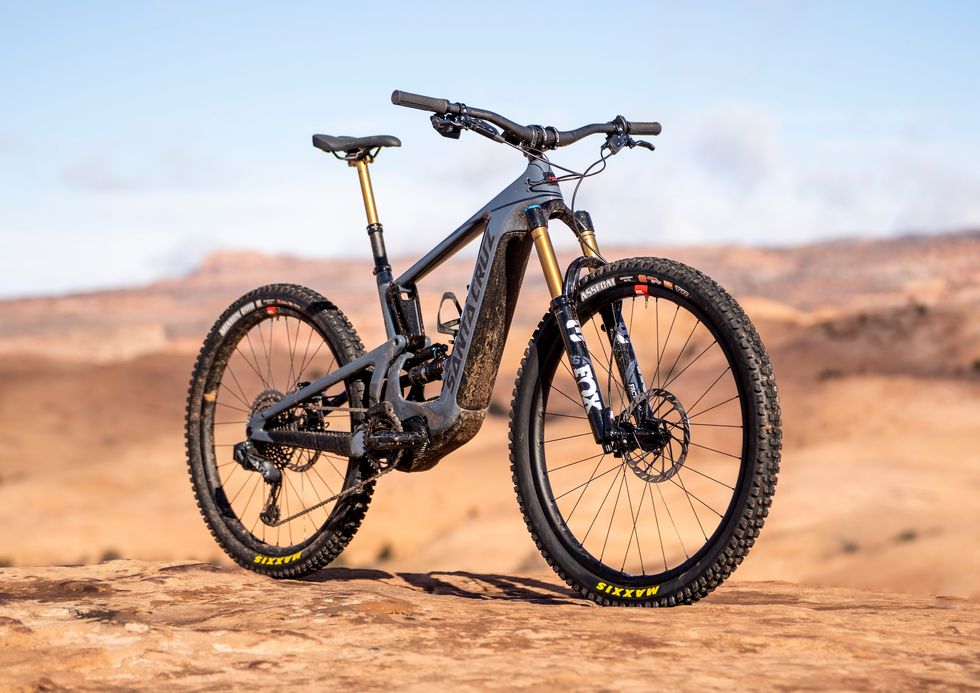
Santa Cruz’s second-generation Heckler e-bike received a number of updates that differentiate it from the bike’s original version, but the three key points are: a much larger 720Wh battery, a geometry- and suspension-altering flip-chip, and a dual 29-inch wheel option (in addition to the 29-inch front/ 27.5-inch rear mixed option on the MX). These changes make an already good e-bike even better. Between the Shimano motor system and its Santa Cruz-iness, the Heckler is a no-fuss e-bike, with no unnecessary, annoying apps or awkward controls. The riding position, geometry, and handling are a bike reviewer’s nightmare: All are so sorted there’s nothing to criticize. That makes the new Heckler both capable and approachable. It’s easy to use and ride, but always ready when you want to push your limits.
Read Full Heckler Review Santa Cruz Heckler CC MX Gallery
Marin | Alpine Trail Carbon 2 $4,500 // 34.8 LB (Large)

With 29-inch wheels and 160mm front/150mm rear travel, there’s no getting around that this is a lot of bike, but it performs well on proper terrain.
The Alpine Trail Carbon doesn’t use gimmicks, just a sturdy carbon main frame and aluminum rear triangle, reliable suspension design, and go-fast downhill geometry. Smooth shifting comes by way of a Shimano XT/SLX drivetrain while stopping duties are handled by four-piston SLX brakes. For suspension, the excellent-performing Fox 38 fork handled everything we threw at it, from big bike park jumps to rock-strewn chutes.
The normally great Fox Float DPX2 rear shock was out of its comfort zone in the bike park. The more gravity-oriented Float X, or even a DHX coil shock, would be a better fit for those long and rocky descents.
Marin Alpine Trail Carbon 2 Gallery
Liv | Embolden 1 $2,300 // 31.5 LB (Small)
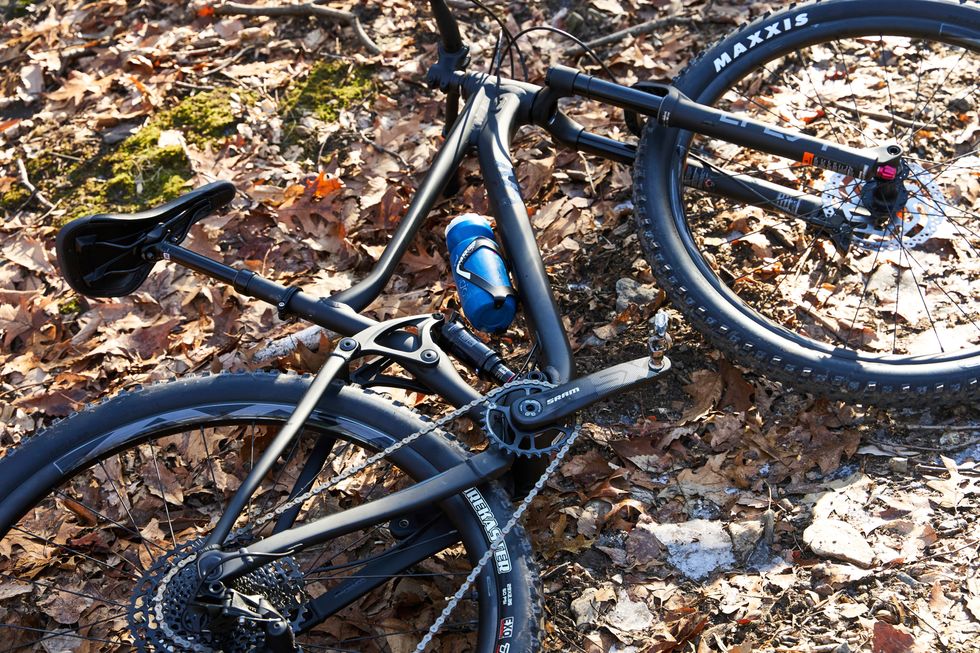
Mountain bikes don’t have to be expensive to be capable on the trail; the Embolden proves it. With a 12-speed SRAM SX Eagle drivetrain, Shimano hydraulic disc brakes, Maxxis tubeless tires, RockShox Monarch rear shock, and Giant-branded 130mm-travel suspension fork and dropper post, the Embolden 1 is A LOT of bike for the money.
The Embolden has 120mm rear travel from its aluminum FlexPoint single-pivot full-suspension frame. The frame itself features internal cable routing for a clean look, Boost 148mm rear hub spacing and tapered headtube in case you ever want to upgrade your wheels or fork, and lots of tire clearance. As a women-centered brand, Liv has sizing for riders 4'11" to 5'11", all with 27.5-inch wheels for sizes XS–M and 29-inch wheels in S–L.
Read Full Embolden 1 Review Liv Embolden 1 Gallery
As Deputy Editor, Tara Seplavy leads Bicycling’s product test team; after having previously led product development and sourcing for multiple bike brands, run World Championship winning mountain bike teams, wrenched at renowned bicycle shops in Brooklyn, raced everything from criteriums to downhill, and ridden bikes on six different continents (landing herself in hospital emergency rooms in four countries and counting). Based in Easton, Pennsylvania, Tara spends tons of time on the road and trail testing products. A familiar face at cyclocross races, crits, and bike parks in the Mid Atlantic and New England, on weekends she can often be found racing for the New York City-based CRCA/KruisCX team. When not riding a bike, or talking about them, Tara listens to a lot of ska, punk, and emo music, and consumes too much social media.

A gear editor for his entire career, Matt’s journey to becoming a leading cycling tech journalist started in 1995, and he’s been at it ever since; likely riding more cycling equipment than anyone on the planet along the way. Previous to his time with Bicycling , Matt worked in bike shops as a service manager, mechanic, and sales person. Based in Durango, Colorado, he enjoys riding and testing any and all kinds of bikes, so you’re just as likely to see him on a road bike dressed in Lycra at a Tuesday night worlds ride as you are to find him dressed in a full face helmet and pads riding a bike park on an enduro bike. He doesn’t race often, but he’s game for anything; having entered road races, criteriums, trials competitions, dual slalom, downhill races, enduros, stage races, short track, time trials, and gran fondos. Next up on his to-do list: a multi day bikepacking trip, and an e-bike race.
Test Editor Dan Chabanov got his start in cycling as a New York City bike messenger but quickly found his way into road and cyclocross racing, competing in professional cyclocross races from 2009 to 2019 and winning a Master’s National Championship title in 2018. Prior to joining Bicycling in 2021, Dan worked as part of the race organization for the Red Hook Crit, as a coach with EnduranceWERX, as well as a freelance writer and photographer.

Mountain Bikes

The Spot Mayhem 140 is Brilliantly Unconventional

What Were the Best Details on MADE Show Bikes?

What Are the Best Bikes at MADE Show?

The 10 Best Mountain Bikes You Can Buy Right Now
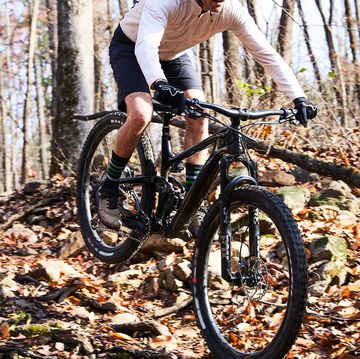
The 6 Best Mountain Bike Shorts

Speed, Balance, Refinement: Trek's Gen 4 Top Fuel

Specialized’s Stumpjumper 15 Changes Trail Bikes

The 10 Best Bike Saddles of 2024

Davison and Garneau Partner for Special Pride Kit

Reviewed: BMC's Fourstroke LT

New Specialized Chisel Full Suspension Reviewed

Little Bike, Big Attitude: Scor’s 2030
The Best Mountain Bikes of 2022

For many years, when the latest and greatest shiny new mountain bikes are released, there’s been no clear “what’s next” in the sport. For 2022, what’s next is unusually well-defined. Downcountry bikes dominate.
If you’re not familiar with this relatively new term, you’re not alone. The term downcountry was recently coined to encompass mountain bikes designed to climb well, with trail/all-mountain suspension, and slacker geometry that rides bigger than it looks on downhills.
Downcountry bikes deliver a hooting and hollering good time when your dropper is down and you’re picking a line, but they won’t weigh you down on a long ride.
Mullet bikes are another 2021-22 trend. Business in the front and party in the back, with a 29-inch wheel in front, and a 27.5-inch wheel in back, mullet mountain bikes started as a user modification. Now more brands are offering a mismatched wheelset standard.
The Bike Market Right Now
If you’re in the market for a bike in the next 12-18 months, if you find what you want online or in a shop, put a deposit on the bike immediately even if you can’t lay down for the full purchase yet.
When you know what you want, ask your local shop to place an order ASAP. You still may not have your bike in hand until next spring. Bike shortages persist, and they may get worse before they get better.
Across the board, bike prices have gone up significantly, so whether you planned to spend $1,000 or $5,000 in the next couple of years, sadly, you won’t get quite as much bike for the money.
Be prepared for parts substitutions. Brands can’t get bike parts, so they’re swapping everything from forks and shocks to brake pads and grips.
Scroll through to see all of our recommended buys for 2021/22 or jump to the category you’re looking for:
- Best Overall
- Best Women’s Mountain Bike
- Best Hardtail
- Most Versatile Bike
- Best E-Bike
- Best Enduro Bike
- Best Trail Bike
- Best Bike Under $1,000
Best Overall: Yeti SB115

“Designed to race, built to rally” is how Yeti describes its SB115 ($5,100+). The bike is fast and smooth, with geometry, suspension, and kinematics that kept me on my line when I crested a highpoint, and then barreled downhill into terrain that would overwhelm other bikes of similar travel.
To make the SB115, Yeti took its BC Bike Race-winning SB100 geometry and gave it a tad more travel for more smiles, whoops, and general forgiveness when you’re picking a high-speed line through rocks, roots, and baby head boulders.
As in all Yetis, the rear shock is paired with Yeti’s signature Switch Infinity, which in the SB115 is turned 90 degrees, lightened up, and fine-tuned to deliver more for less on downhills and climbs. In a full season of riding this bike, the only time I locked out the suspension was on a sustained road climb.
The Switch Infinity pedaling platform is bounce-free with the shock fully opened because Yeti gives its suspension a relatively flat and high anti-squat curve in the beginning and middle of its travel.
But once you go downhill, the link switches direction, dropping the anti-squat and decoupling the chain in sections when there’s no pedaling required to provide full use of all the travel the bike has.
When Switch Infinity switches direction and decouples the chain, it lets the suspension work most efficiently, and it lets you use all the bike’s available travel. If that sounds like a lot of techy mumbo jumbo, what you need to know is that this bike is stable without bouncing and bobbing on climbs, and plusher than you’d think on the downhills.
Yeti’s in-house suspension experts and engineers custom-tune every Yeti shock in tandem with its Switch Infinity to give the SB115 and all Yeti bikes a bottomless feel that the suspension travel numbers don’t necessarily reveal.
We rode this bike all over Vermont, from 30-mile epics that included machine-built flow trails with tabletops and kickers to teeth-rattling root mats on off-camber descents.
It was fast, smooth, and stable. And the plush-when-you’re-deep-in-the-travel suspension — we call it Yeti magic — saved our butts more than once.
- Wheel Size: 29”
- Frame: Carbon
- Suspension: 115/130
- Ultra-versatile bike with the chops to tackle technical terrain
- Heavier than some similarly capable bikes
Check Price at evo Check Price at Yeti Cycles
Best XC: Scott Spark RC Comp

If you’re a rider with a need for speed, Scott’s Spark RC Comp ($4,000+) will rocket you to a new Strava segment PR or shoot you over the finish line of your next XC race.
While the Spark has been in Scott’s line for more than a decade, the newest version, for sale in September, is a major evolution. Scott hid the shock inside the bike’s frame, where it’s protected from dirt and weather. By building the shock into the frame, further reducing this bike’s already impressively light weight.
Inside the frame, the trunnion mounted shock — the shock looks like it’s mounted upside down, combined with larger bearings in the seat tube pivot — enhances this bike’s rigidity for more efficient power transfer.
By positioning the shock lower in the frame, Scott also lowered the bike’s center of gravity, enhancing its stability on sketchy downhills.
In positioning the shock inside the frame, Scott hid the single-pivot setup without putting it out of reach. A sag indicator on the outside helps with setup, pivot bolts are accessible from outside.
If you want to check on the ring that shows how much suspension you’ve used, a window gives you a visual. Removable covers let your shop access the shock for service.
Scott Spark RC frames have a built-in angle-adjust headset that lets you choose a slacker setting to run with a longer fork, or the steeper, zippier head angle setting for racing and a shorter fork.
Headset adjustment doesn’t require cable removal or a brake bleed. Regardless of setup, there’s room for two water bottles in the bike’s front triangle.
Speaking of the cables, this bike has some slick cable routing. The company continues to use its two-lever Twinloc, which lets the rider lock and unlock suspension from the handlebar instead of reaching down to change shock settings between their legs.
That puts extra levers on the dropper post lever side of the bar. The bars and stem have integrated light and GPS docks, and as a bonus, the rear axle is also a multitool.
- Suspension: 120 mm
- Eye-catching
- Available in XC race (RC)
- XC ride (900) and women’s (Contessa) iterations
- Lots of levers on the handlebar
Best Women’s Bike: Juliana Roubion

Mullet bikes are all the rage. On the trail, a mullet bike’s big 29” front wheel is fast and it rolls over everything, while its smaller 27.5” rear wheel gets up to speed fast and gives the bike a more playful feel.
The 2022 Juliana Roubion ($5,949), which is the same frame and the same geometry as Santa Cruz’s 2022 Bronson , is fast, powerful, and easy to control. Code brakes with a 200mm rotor up front and a 180 in the rear have superb stopping power.
Juliana scaled chainstays by frame size to keep the ride consistent even in smaller sizes. And, as with all Juliana bikes, the shock is tuned for a lighter rider, making it easier for smaller, lighter shredders to use all their suspension.
The Roubion is Juliana’s biggest travel bike, made for enduro riding and bike park laps. First ride, we took it to Vermont’s Killington Bike Park and rode every trail the mountain could dish out from blue square Step It Up to double black Goat Skull. The Roubion zipped through corners with rocket ship speed, aired off lips, and sucked up landings with creamy efficiency.
When we pedaled the Roubion up a 30-minute double track to get to one of our favorite local flow trails, despite this bike’s extreme downhill capability, the climb didn’t suck. We kept up with our friends who were on lighter, all-mountain bikes, and soared through everything from wheel-grabbing roots to speed demon corners on the descent.
To ride big features safely, you need plenty of travel, well-designed suspension, and dependable and responsive brakes and tires. This bike had it all, delivered in an eye-catching, clean, matte-painted package that was as head-turning as it was magically corrective when we didn’t quite choose the right landing or wheel placement.
- Wheel Size: 27.5″ rear, 29″ front
- Suspension: 150 mm rear, 160 mm front
- A pedal bike that can also handle the park
- On the big and heavy side of a one-bike quiver for most riders
Check Price at evo Check Price at Competitive Cyclist
Best Hardtail: Kona Honzo DL

If you want to save a few bucks on your next bike without restricting your ability to ride anything, this aluminum hardtail is a great choice.
Built for comfort and a whole lot of fun, Kona updated the geometry of its affordable Honzo to give the bike the same geometry as its mid-travel, full-suspension Process 134.
In the new Honzo DL ($2,699), Kona slackened the head tube for downhill stability and beefed up the suspension fork, spec’ing RockShox’s 140mm travel Revelation RC Debonair, a fork that’s ready to rock and roll.
The bike’s shorter seat tube length lets riders run a longer dropper, which makes riding technical terrain more fun. Kona lets you choose your own level of adventure with the adjustable travel TranzX +RAD post that’s on this bike.
In its new Honzo DL, Kona added adjustable dropouts, which let riders run this bike as a single speed. But we liked it with a 12-speed SX drivetrain, and a broad range of gears that affords. This made steep grinds, rolling punches, and swoopy soaring rollers all in range.
When it was time to put the brakes on, Shimano’s MT410 hydraulics, which use a 180mm front and 160mm rear rotor on this bike, were strong and dependable.
The tires a manufacturer puts on a bike are often an indication of what the bike is meant to do. Kona gives the Honzo DL an aggressive enduro-tread front, with a trail casing, highly rollable, and tenacious traction rear tire.
- Frame: Aluminum
- Suspension: 140 mm
- Can be set up as a single speed
- Big travel for an all-mountain hardtail
- Not as peppy as some other bikes
Check Price at Kona World
Most Versatile Bike: Transition Spur

A lightweight ripper for all-day rides, Transition’s Spur ($3,500+) is a poster child for the new class of downcountry mountain bikes.
Enduro bike-slack with cross-country/all-mountain travel, this lightweight all-day ripper is like a leopard charging through the African veldt. If you’re coming to the bike from a heavy enduro bike, on the Spur you’ll charge uphill at speeds you’ve likely never considered thanks to short chainstays and a nearly 76-degree seat tube angle.
You’ll summit climbs that in the past left you spent. And you’ll find yourself riding further, longer, faster into zones that previously seemed like too much effort. The efficiency and speed of this bike put more terrain in range.
Just as important: The bike’s geometry doesn’t sacrifice downhill fun. The slack 65.9-degree head angle was built so that steep, rooty trails won’t throw you off your line, and so you stay rubber side down on any downhill you tackle.
This is the first uphill-oriented bike Transition has made, but its goal was to keep it just as capable on descents as any other Transition. And it rose to the challenge.
The rear Giddy Up suspension, Transition’s long-link, four-bar signature design, didn’t bob on uphills, though it was active and bump-absorbing. However, at the end of the day, this bike has 120mm suspension front and rear, so there are limits to how big drops and jumps it can absorb.
Thanks to a straight and nearly uninterrupted seat tube, Transition specs the longest possible droppers on this bike. Dropper lengths are scaled to frame size, from 120 mm on a small frame to 210 mm on an XL one.
If you spend most of your time in the park, or on rides where you use all 160 mm of travel on your big bike, don’t expect this to replace that. But do be prepared to be shocked and thrilled by what this bike can handle.
- Suspension: 120 mm front, 120 mm back
- The most downhill fun on a bike of this weight and class
- Order now for next year, carbon only
Check Price at Transition Bikes
Best E-Bike: Rocky Mountain Growler Powerplay 30

With high-volume tires and a proprietary, powerful drive system, slack geometry, and Shimano parts, the hardtail Growler Powerplay 30 ($4,199) is tons of fun.
Rocky Mountain didn’t want to be constrained by someone else’s motor and drive, so the company spent 10 years and $10 million to develop its own drive, called the Dyname system.
It spins more slowly than other drive systems, so there’s less whine, it uses the available battery more efficiently, and it’s quick to charge. Two hours plugged in gets you to 80%. It’s 4 hours until you’re fully charged.
The higher torque of the Dyname system is compatible with a mountain biking pedal pace. The drive system kicks in smoothly with no lag and no spinning out, so whether you’re starting on a hill or getting up to speed it feels natural.
Rocky achieves engagement with a magnetic field sensor that measures the chain position every time the chain is straight, around 1,000 times a second. On trail, that translates to reliable traction, and consistent and predictable power output that feels a lot like riding a pedal bike.
The bottom bracket is part of the bike, not the drive, so there’s less creaking, less wear, and it’s easy for your shop to service. Plus, Rocky Mountain has the best electrical components warranty in the industry at 36 months.
But an e-bike is more than just its drive. A bike’s geometry and spec determine how a bike feels on the trail, whether it’s an e-bike or a pure pedal bike. The Growler is slack for aggressive descending.
The motor and battery give it a low center of gravity that makes it easier to maneuver on steep descents, and that gave it tenacious traction in corners. For the price, there’s no better e-MTB on the market.
- Wheel Size: 27.5”
- Suspension: 130 mm
- High-volume tires absorb shock
- The drive and motor are well-modulated for MTB and are smooth and predictable
- Without rear suspension
- Drops are more jarring
Check Price at Rocky Mountain
Best Enduro Bike: Canyon Spectral 29 CF 9

Strong and tough enough that you could ride the Enduro World Series on this bike, and pedally enough to be a one-bike quiver, the mid/long-travel Spectral 29 CF 9 ($6,299) is Canyon’s big brother to the 27.5-inch wheel that Spectral introduced a couple of years ago.
It’s a big bike that climbs impressively without bobbing around, and that on descents lets us just sit back and enjoy the ride.
At speed, the Spectral 29 CF was stable and able to bomb through whatever line we chose, while nimble enough that it left us grinning until our faces hurt. Technical step-downs, tables, wedges, rock rollers, machine-built flow, old-school singletrack … the Spectral cruised through it all.
The 29-inch Spectral uses a similar frame and four-bar suspension as the 27.5-inch Spectral. But it’s tuned to be less bouncy climbing and more progressive to keep you from ever feeling like you just used all your suspension.
Canyon’s “Triple Phase Suspension” is supple early in the suspension, with good mid-stroke support and progression at the end. It kept our tires on the trail, gave us momentum and speed in berms airing lips, with no bottom out on landings.
We tested the Spectral in Canyon’s “Shred” spec, a relatively high build for riders who put a lot of miles and hours on their bikes. The CF 9 shaves weight off lower-end builds, with components that will last through seasons of a lot of use.
If you’re a rider who gets to pedal several times a week, SRAM’s XO1 drivetrain promises precision, durability, and a massive range with the 10-52 12-speed cassette.
Fox’s DPX2 Factory piggyback shock is smooth and consistent as well as highly adjustable. The Fox 36 Factory 29-inch fork eats up the terrain, and it’s highly controllable, regardless of how boulder-y or bumpy it is.
Spectral’s rear suspension linkage flip-chip gives riders control of this bike’s geometry. Flip it to move the bike’s head tube and seat tube 0.5 degrees, and to change the bottom bracket height 8 mm.
That gives the enduro bike more all-mountain or more DH personality. Wherever the chips are positioned, the long top tube gave us an efficient position for powering up climbs.
Canyon is direct-to-consumer only, which is how it specs Fox Factory suspension, carbon rims, carbon crank, carbon handlebar, the One Up dropper, SRAM X01 drivetrain, and G2 RSC brakes at this price.
- Suspension: 150 mm back, 160 mm front
- Flip-chip lets you fine-tune this bike’s personality
- Feels massive
Check Price at Canyon
Best Trail Bike: Cannondale Scalpel Carbon SE LTD

Take a top-end XC race bike and beef it up just a bit. The Scalpel Carbon SE LTD ($8,300) leans into speed as its calling card, but with added suspension travel to soak up terrain and hits better than a pure XC steed.
The company touts the genre-straddling bike as made for “full-throttle trail riding.” Our experience was just that. Over a summer test and more than 300 miles of ridden trail, the Scalpel consistently crushed for our testers.
We took it on evening sessions for 15-mile sprints on urban trails. Then, in September, an editor raced the bike during a national championship event, citing a “magic carpet ride” experience after hours in the saddle on the rocky, old-school trails of the CAMBA system near Telemark, Wis.
The 29er bike has a Lefty Ocho Carbon 120mm fork and RockShox SIDLuxe Ultimate suspension, making any rut, root, or trail obstacle fade into memory as the dirt blurs ahead. It weighed 24 pounds on our scale (size large), which is respectably light for a feature-full bike that includes a dropper post, two bottle cages, and a tool-stash area on the frame.
Its drab-green carbon frame is sleek and loaded with Cannondale design and tech (FlexPivot carbon plates on the chainstay; asymmetric rear triangle and offset drivetrain). It’s stock with a SRAM X01 12-speed drivetrain, HollowGram 25 carbon tubeless wheels, and top-end components all around, which is requisite on a bike at this price.
Is the Scalpel Carbon SE LTD worth the price tag? Advanced riders needing a “World Cup fast” mountain bike that can also play on bigger terrain will be happy with this rig’s unique design. As Cannondale sums it up, the Scalpel “balances XC race geometry and precision with the vibes of a trail rig.”
- Top-end performance and looks
- Fast + a confidence-inspiring design
- Heavier than pure-XC bike models
Check Price at Cannondale
Best Bike Under $1,000: Giant Talon 1

Made for mellow trails, rec path shreds, and summer adventure cruising, Giant’s Talon 1 ($980) is a great bike for singletrack dabbling and all-the-time adventuring.
The Talon gives riders the option to run 29- or 27.5-inch wheels, so you get a bike with the ride characteristics you want. The aluminum frame Talon 1 comes with either wheel size, as you prefer. The frame geometry adapts to the wheel size you choose.
With 27.5-inch wheels, which spin up to speed quickly but don’t roll over trail obstacles quite as well, the Talon 1 is playful, agile, and easy to get off the ground.
Roll 29-inch wheels, and you might notice that they are slower to get to speed. But once you’re moving, they smooth out the trail and make it easier to stay on top of your bike when the terrain gets technical.
With 100 mm of front suspension, this bike is ideal for cross-country riding, and everyday outings. In the smallest sizes, fork travel is reduced to 80 mm to keep the bike’s angles stable, confidence-inspiring, and fun. The rider position in the cockpit is relatively upright but still maneuverable.
Even though it’s under a thousand bucks, the Talon 1 frame is hand-built in-house by the world leader in aluminum engineering. It’s also spec’d with a reliable and serviceable Shimano Deore drivetrain.
The rims are tubeless-ready, but the tires are not. And the frame is routed for a dropper post, though it doesn’t come with one.
- Wheel Size: 27.5″ or 29″
- Suspension: 80-100 mm front
- Option to run 27.5″ or 29″ wheels
- Hand-built frame
- Dropper routed but not included
- Tubeless-ready rims
- Tires are not tubeless-ready
Buyers Guide: How to Choose the Best Mountain Bike
There are three things you need to think about before you start shopping for a mountain bike: where you’ll ride, how you’ll ride, and your budget.
Where Will You Ride?
If you live where it’s hilly, buy a bike with enough gears to get to the top without walking. Many mountain bikes now come with a 1x drivetrain with a single chainring in the front and a range of gears in the back.
Having one shifter instead of two makes choosing the right gear much simpler. It also makes the drivetrain and your bike lighter. And it cleans up your handlebar, making space for a dropper post lever.
If you buy your bike at a bike shop and not online, it’s easier to get your bike customized with a smaller front chainring to make hill climbing easier.

How Will You Ride?
Buy a bike to match your goals. If you’re all about speed, choose a fast and light bike. Dreaming of a bike that can do a little bit of everything? Opt for an all-mountain or trail setup, which will have more suspension than a cross-country bike and less than an enduro bike.
If you want to huck off big rocks and wooden jumps, or ride lifts at a ski area with your bike and hit jump lines, get an enduro bike with enough suspension to handle the impacts, and also one that’s made for abuse — because the worst kind of bike is a broken one.
If you’ll never leave the rec path, opt for a hardtail, which will save you weight and money.
What’s Your Budget?
The general rule of thumb is the more money you spend on a bike, the lighter and more durable it will be. If you plan to do more technical riding, get the nicest frame you can afford. Parts can be upgraded, but in general, your frame can’t.
Also, get the bike with the best suspension you can afford. A more responsive and tunable suspension will make you a better rider, and it will be more fun.
Bike Types Explained: XC, Enduro, Trail, All-Mountain
A cross-country bike is built for uphill and downhill speed as well as mellower terrain. Most cross-country bikes have 100mm suspension and come with 29-inch wheels, which are faster than 27.5-inch wheels.
To optimize for climbing, cross-country bikes usually have a steeper head tube angle. But recent advances in suspension design are blurring the line between XC and trail bikes.
A trail bike won’t be quite as light as a cross-country bike , and it will usually have more front and rear suspension. Trail bikes are fast uphill with geometry and suspension that’s forgiving and fun riding downhill.
An all-mountain bike is the most versatile style of mountain bike. It will take you almost anywhere you want to pedal.
With a 120-130mm suspension in back, if you have your sights set on big rides that balance climbing and descending, a nimble all-mountain bike is the best choice. They rally through anything but the biggest downhill features.
An enduro bike is downhill-focused, but a bike you can still pedal. Enduro bikes are usually heavier than all-mountain and trail bikes because they have more front and rear travel. This enables you to sail through technical roots and rock gardens, over jumps, and down drops.
An enduro bike will have a noticeably slack geometry. Many enduro bikes now have shorter chainstays and other modern bike kinematics that make them as good pedaling uphill as crushing descents. But they’re made for races where the downhill is timed, but the uphill is not.
If you’re going to ride lifts and hit huge jumps and high speeds and never pedal uphill, buy a downhill bike. It will have a heavy reinforced double-crown fork with a maximum available suspension to reduce flex and help you sail over the biggest jumps and drops.
Expect the bike to be so low and slack that uphill pedaling will be somewhere between a chore and a push. Downhill bikes are designed to rage downhill as fast as you’re willing to go.
Modern bikes have either 27.5- or 29-inch wheels. The smaller (27.5-inch) wheels are more nimble and easy to maneuver, and they often have a more playful feel on the trail. They’re also quick to get moving.
Twenty-nine-inch wheels take more energy to get rolling, but they hold their speed once they’re moving. They also roll over obstacles in the trail more easily than 27.5-inch wheels.
But don’t rule out a bike just because it doesn’t have the wheel size you think you want. A bike’s kinematics and frame design combine with wheel size to give each bike a unique “feel” and skill set. Sometimes it’s hard to tell what you’re rolling without stopping to read the sidewall.
Fatter tires are heavier, but they’re also more stable. What kind of tread you need depends on where you’ll be riding.
A smoother tread is faster, but may also be more slippery. The fattest tires you’ll encounter on a mountain bike are 27.5-plus tires. These extra-wide tires typically measure 2.8 inches and give you confidence-inspiring stability and a more comfortable and forgiving ride.
They also have more rolling resistance, and they’re heavier than non-plus tires. Not every frame can accommodate plus tires. Check the manufacturer’s website.

Mountain bike frames are made from aluminum or carbon. An aluminum frame will be more affordable. Typically, a carbon frame will be more expensive and more forgiving.
Carbon dissipates shock better, and the manufacturer has more control over the characteristics of the bike because it can determine the shape and size of tubes, as well as reinforce and lighten the frame where it wishes.
All carbon is not created equal — many brands have multiple carbon layups. The most expensive carbon build is the lightest and most finely tuned.
A hardtail bike has a front suspension but no rear suspension. Buy one if you’re on a tight budget or if you’re riding relatively smooth terrain. Most hardtails are less expensive and lighter than comparably spec’d full-suspension bikes.
Many also come with wider tires that can supplement the bike’s suspension, especially if you ride with your tires set up tubeless and at lower pressure.
A full-suspension bike has a rear shock and a front suspension fork that compress and extend as you ride to make the ride less jarring and to keep your wheels in contact with the ground, increasing both traction and control.
The best full-suspension bikes won’t pogo. Most shocks and suspension forks can be locked out for more efficient climbing. And most can also be tuned and adjusted to your weight, riding style, and personal preferences.
Ask your shop to help you set your bike up so you have the best experience regardless of how much or little you ride. If you’re getting bucked, or your bike feels too squishy or unresponsive, it’s probably your suspension. The more expensive your bike, the more advanced and tunable your suspension will be.
Dropper Post
A dropper post is a seat post that you can raise and lower with a handlebar-mounted lever. If you’re riding singletrack and your bike doesn’t come with a dropper, add one.
It’s an easy upgrade and one that will instantly make you a better rider. Engage your dropper post and your seat sinks, lowering your center of gravity to make riding technical terrain and downhills easier.
“Spec” refers to the parts on your bike, including drivetrain, brakes, fork and shock, and more. The more expensive a bike, the longer-wearing and more precisely functioning the parts will be.
Maintenance
Lube your drivetrain regularly. If you wait until it’s chirping, you waited too long. Use bicycle-specific lubricant, and apply one drop to every second link. Bike lube cleans and oils the chain.
If you can, leave the lube on the chain overnight. Then, before you ride, hold a rag over the chain while you spin the pedals backward to remove grit, grime, and extra lube.
If you have a full-suspension or front-suspension bike, manufacturers recommend that you have a shop service your suspension every 30 hours of riding. Check brake pads and cables for excessive wear regularly throughout the season.
Buy the Best Bike You Can Afford
When buying a bike, you get what you pay for. More expensive bikes will have longer-wearing parts, lighter and stronger frames, and better wheels.
Buy locally, and you’ll often get extras, including the option to demo bikes before you buy, a 30-day tune-up, professional advice to help you get the best bike for you, and assistance swapping out parts to get your bike dialed for you.
You’re also keeping money in your community. If you’re looking for a deal, ask your local shop if they’re selling their demos or if they have a previous-year bike priced to move. Buy a bike you can grow into.
Frequently Asked Questions
What is the best brand of mountain bike.
The best brand of mountain bike is the one that provides all of the features that you’re looking for. Most brands will offer the basic requirements, so it helps to figure out what features are most important to you.
Some brands specialize in making lighter bikes, others focus on burly downhill bikes, and still others make electric bikes that will give you a boost on steep inclines. Look for any specific features that you want and go with the brand that best suits your needs.
What is the best mountain bike for beginners?
There are so many styles of riding and types of mountain bikes that it can be difficult for beginners to know where to start. One great option is to get a basic, low-end mountain bike like a hardtail with fork shocks.
These bikes are built to handle a wide range of terrain and will accommodate many riding styles. This allows you to try a variety of terrains and styles and decide which one is your favorite.
As you ride, you can start thinking of features that you want on your next bike that would help you as a rider. Because you didn’t break the bank on your first bike, you’ll be able to upgrade to a bike that best suits your needs without taking a big bite out of your wallet
How much should you spend on your first mountain bike?
Unless you know exactly what facet of mountain biking interests you, you’d be better off buying a good used bike or an inexpensive new bike. That way, you’ll be able to learn how you like to ride, and you can take some spills without worrying about excess damage to the bike.
Then, when you know what kind of mountain bike you want, you can upgrade without having to take a second job.
Is it bad to ride a mountain bike on the road?
While they’re built for off-road use, mountain bikes are perfectly fine to ride on roads, though we wouldn’t recommend them for races or century rides.
The knobby tires are a bit bumpier than road tires and the added weight of a mountain bike can wear on you on inclines. They’ll do in a pinch for short commutes or a quick ride to the store, however.
What frame size should I get for a bike?
The proper sizing is crucial for ensuring a comfortable riding position, and it varies depending on the rider’s height. Check out our article on finding the perfect bike size to make sure you find a good fit.
What gear do I need for mountain biking?
The first and most important piece of gear you need is a good b ike helmet , as most head injuries can easily be prevented with the right helmet and a proper fit.
After that, a good pair of shorts with a chamois pad will keep your nethers comfortable while you get used to spending long days in the saddle.
A pair of gloves is also key, as you’ll likely plant a hand if/when you fall off your bike. (I’m looking at the scar on my palm from the one day I forgot my gloves as I write this.)
Bike lights are also a great option for when the sun goes down on a long ride, as well as for added visibility if you ride on the road after dark. Also, mountain bike grips are an often-overlooked upgrade that can go a long way in making your rides more comfortable.

The Best Mountain Bike Helmets of 2024
Our experts put the best mountain bike helmets of 2024 to the test. Whether you need a budget pick or overall winner, we've got you covered. Read more…

The Best Mountain Bike Shoes of 2024
Whether you’re cruising singletrack and charging down hills, traversing hundreds of miles, or speeding through race events, here are the best mountain bike shoes for your ride. Read more…
Follow Us On
Subscribe Now
Get adventure news and gear reviews in your inbox!
Join Our GearJunkie Newsletter
Gear Top Stories Deals
- MAGAZINE OFFERS
- BIKE INSURANCE
- Best Products
- Maintenance
- Accessories
- Long-Term Reviews
- First Look Friday
- Bike of the Week
- Tech Features
- Routes and Rides
- Bike Galleries
- BikeRadar Bargains
- Buyer's Guides
- Fitness & Training
- Sizing & Fit
- Mountain Biking UK
- Cycling Plus
- BikeRadar Podcast
Best trail mountain bikes 2024 | 27 of the best trail MTBs and buyer's guide
The top trail bikes as rated by our expert reviewers, plus our buyer's guide for everything you need to know
Laurence Crossman-Emms / Our Media
Stan Portus
The best trail bikes hit the sweet spot between rowdy enduro bikes and svelte cross-country bikes, delivering performance that's equal parts fun and super-capable.
This has made trail bikes an incredibly popular category among the best mountain bikes in recent years. They give you a bit of everything, and open up the widest range of trails and riding when compared to other types of mountain bike.
The flipside is that choosing the best trail bike for you can be quite a bewildering prospect – there are simply so many options on the market.
Fortunately, you've come to the right place because our expert mountain bike testers have spent years riding and reviewing dozens of trail bikes. This list of the best trail bikes in 2024 will help you find the perfect machine for you.
We've also put together a buyer's guide to trail bikes at the end of this list that explains everything you need to know about this type of mountain bike, from what sort of terrain they are good for to the size of disc brake rotors – we've covered it all!
Best trail mountain bikes in 2024
Whyte t-160 rs.

- £2,999 as tested
- Pros: Fast and reassuring on the descents; well-specced for the money; good climbing ability
- Cons: Seat angle could be steeper
We were so impressed with Whyte's T-160 RS that it won the title of Trail Bike of the Year 2024 .
The British brand has given the bike an almost unbelievable spec list for the money, with a RockShox Lyrik Ultimate fork and a Super Deluxe Ultimate RC2T shock used for suspension.
We found the T-160 RS performed well on rough trails, remaining calm over rocks and roots thanks to the sophisticated suspension.
It's a bit hefty at 16kg, but it tackles climbs with comfort and efficiency – although we'd have liked a slightly steeper seat angle.
- Read our full Whyte T-160 RS review
Atherton AM.130.1

- £7,800 / $7,735 / €7,345 as tested
- Pros: Impressive suspension; agile and composed ride feel; head-turner
- Cons: Pricey; not the latest spec for the price
Atherton's AM.130.1 is made using an additive construction technique that sees carbon tubes connected with 3D-printed titanium lugs, enabling the brand to offer the bike in 22 frame sizes.
A DW6 linkage gives the bike a good balance of sensitivity and support, with its small-bump compliance making trail imperfections disappear without losing response to direct inputs.
The bike comes with SRAM's X01 mechanical groupset, which is far away from the electronic groupsets usually found at this price point.
- Read our full Atherton AM.130.1 review
Boardman MTR 8.9
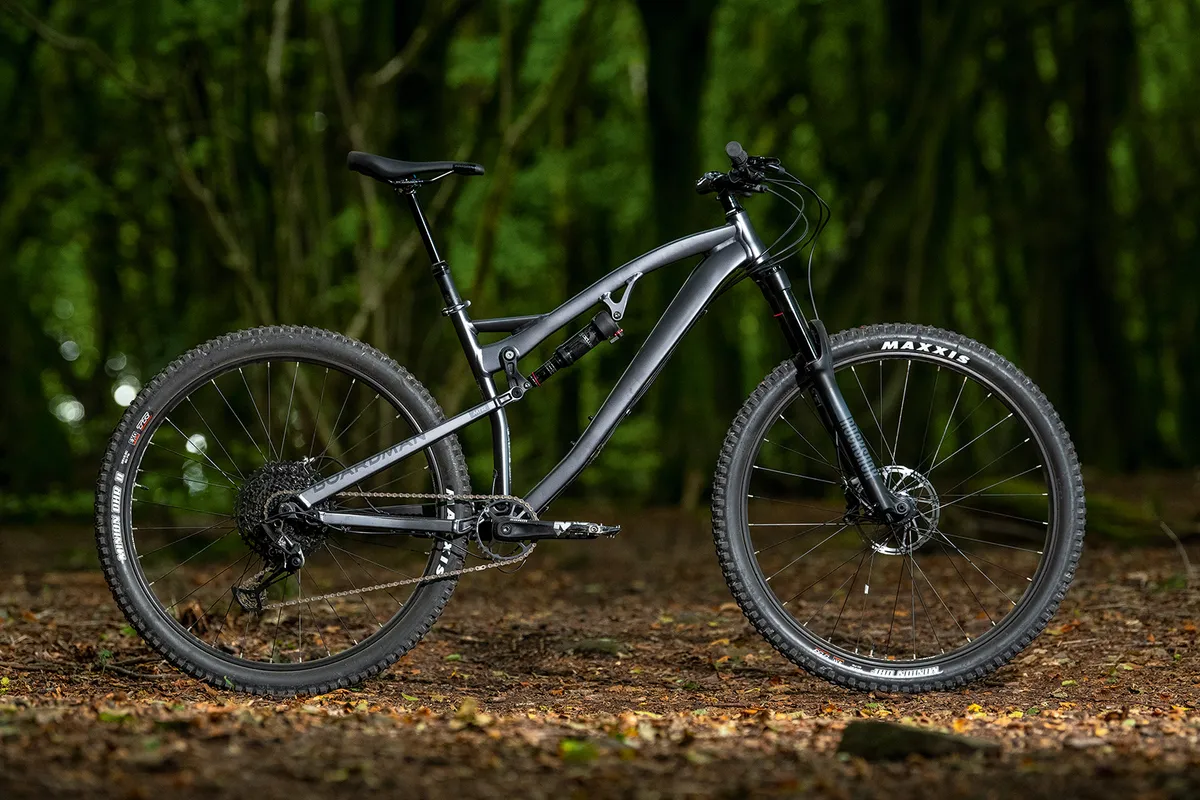
- £1,750 as tested
- Pros: Fantastic all-rounder
- Cons: Limits become clear on extreme terrain
The Boardman MTR 8.9 has the same geometry and suspension as the pricier MTR 9.0.
It has a well-chosen spec that balances cost, performance and strength, with a RockShox front fork, a SRAM NX Eagle drivetrain and Maxxis tyres.
The triple-butted alloy frame looks purposeful and has externally routed cables, making for easy maintenance. There is a bottle mount too, but we found there to be minimal clearance.
The geometry is modern but not extreme with a generous reach, leading to a comfortable ride.
You do have to shift your weight forward to keep front-wheel traction over tricky ascents, and downhill the bike is fairly noisy. So really this is a bike for speedy trail centre rides, rather than super-challenging terrain.
The bike is also ripe for upgrades and, with a few parts swapped out, we think it would be great as a lightweight, mile-munching machine.
- Read our full Boardman MTR 8.9 review
- Buy now from Halfords
Cannondale Habit 4
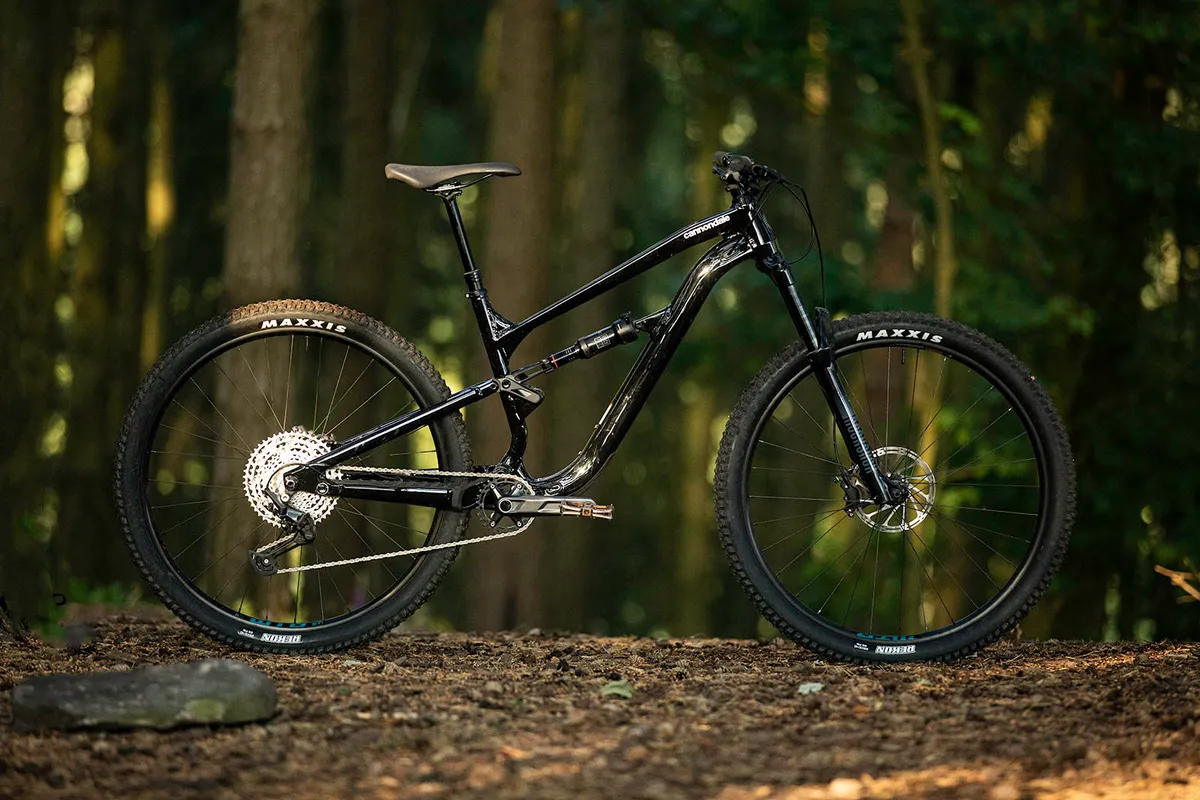
- £2,300 / $2,300 / €2,699 / AU$4,399 as tested
- Pros: Well-balanced; confidence-inspiring ride; fun and flicky
- Cons: Shimano Deore drivetrain can be a little clunky
The Habit 4 impressed us with its playful and balanced ride feel.
Its aluminium frame features size-specific geometry, with Cannondale increasing the chainstay length with the frame size. The bike feels surefooted and quick to turn.
We found the RockShox Recon fork to bind on hard compressions, though this didn't take too much away from the performance of the bike.
A steep seat tube angle of 77.5 degrees makes winching up climbs comfortable, although the bike lacks some of the punchiness of other MTBs on this list.
Canyon Spectral CF7
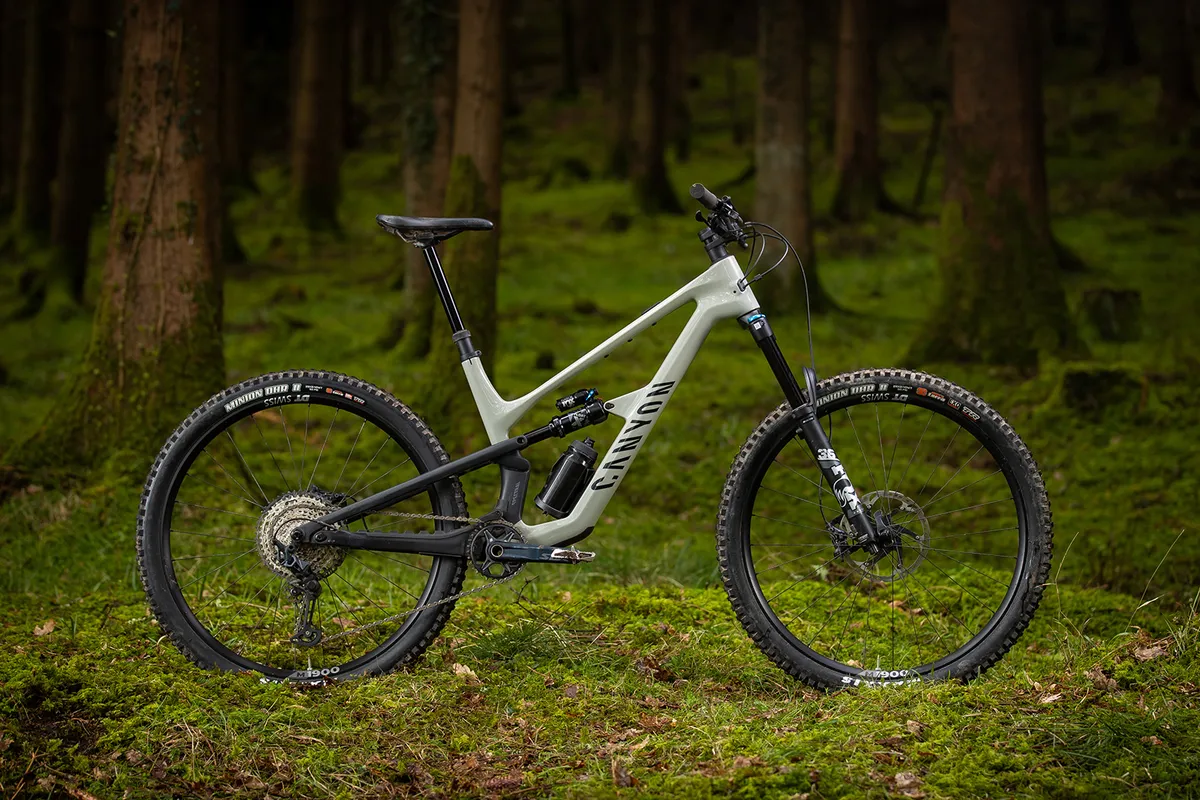
- £3,299 / $3,699 / €3,449 / AU$5.249 as tested
- Pros: Playful character that's stable at high speed; smooth, comfortable suspension; well thought-out geometry
- Cons: Fork isn't the most supportive when riding aggressively; down-tube storage doesn't feel the sturdiest
The Spectral offers impressive ground-covering ability for all-day cruises and a geometry that leaves nothing to be desired on the descents.
It's playful on all gradients and remains settled when ploughing through rough sections of the trail. This is helped by Canyon's KIS (Keep It Stable) system, which uses a pair of springs to connect the top tube and fork steerer.
The bike represents exceptional value, with a carbon frame and fantastic spec list sealing the deal.
While the Fox Rhythm 36 fork proved easy to set up, we felt it could be more supportive for aggressive riding.
- Read our full Canyon Spectral CF7 review
Canyon Neuron 5

- £1,849 / $2,099 / €1,899 / AU$2,949 as tested
- Pros: Fast-rolling on mellow trails; composed ride feel; grippy in most conditions
- Cons: Suspension feels overworked on steeper trails
Canyon's Neuron covers ground fast, with supple suspension that provides good comfort while descending, although, it can feel a tad active on steeper, technical descents.
The bike has a nimble ride feel that helps it eat up trail centre singletrack with ease, with the Schwalbe tyre combo offering fast rolling speeds.
We found the RockShox Recon fork to be a little out of tune with the rear of the bike, and not providing the desired amount of support on steeper terrain.
- Read our full Canyon Neuron 5 review
Merida One-Forty 700
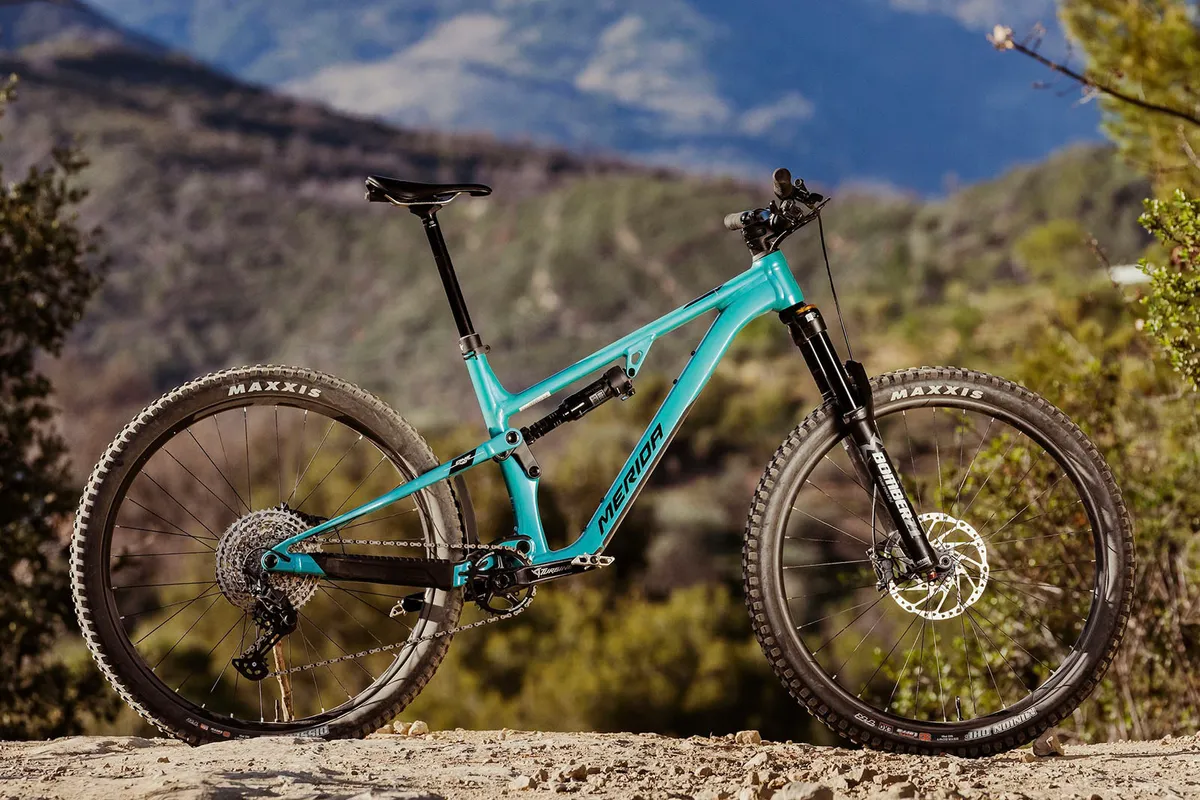
- £3,100 / €3,869 / AU$4,599 as tested
- Pros: Boundary-pushing geometry options; one of the best climbers out there
- Cons: Stem could be shorter; not the smoothest ride
The Merida One-Forty 700 impressed us in testing, winning our Trail Bike of the Year 2023 award.
The carbon fibre frame, which is shared with the longer-travel One-Sixty , uses flex stays in the rear linkage and provides 140mm of rear travel.
Merida has packed serious value for money into the bike, with a RockShox Deluxe Select+ rear shock and a 150mm Marzocchi Z1 fork.
On climbs, the bike has zero wallow and a perky attitude, making the uphills easier than on its contemporaries.
Downhill, the geometry is spot on with composed and accurate handling adding to the ride.
- Read our full Merida One-Forty 700 review
Norco Fluid FS C2
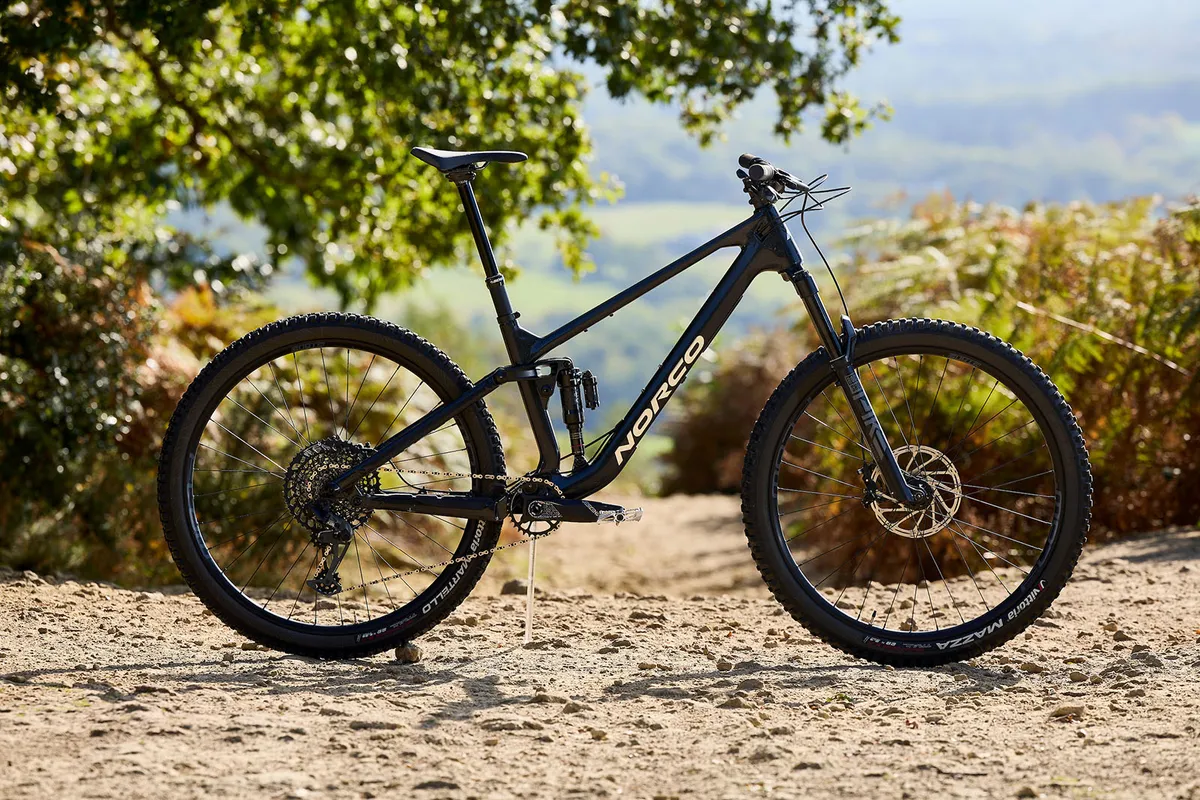
- £4,999 / $4,999 / €5,299 as tested
- Pros: Confidence-inspiring geometry; makes good use of suspension travel
- Cons: Brakes could be more powerful; tyres won't suit everyone
Norco's Fluid FS C2 has a playful agility on the trail that remains composed at high speeds.
With a 140mm RockShox Pike Select+ fork up front and a Super Deluxe Select+ controlling 130mm of rear-wheel travel, the Norco feels planted through rough terrain, balancing a poppy yet bump-gobbling ability.
We found the Fluid capable of all aspects of trail riding, but it was on the hills where it really impressed, with the bike eager to attack short, sharp climbs with grace.
Because it's able to carry a lot of speed down the trail, the SRAM G2 RS brakes feel a little under-gunned in some situations, with the bike deserving of more powerful brakes.
- Read our full Norco Fluid FS C2 review
YT Jeffsy Core 1
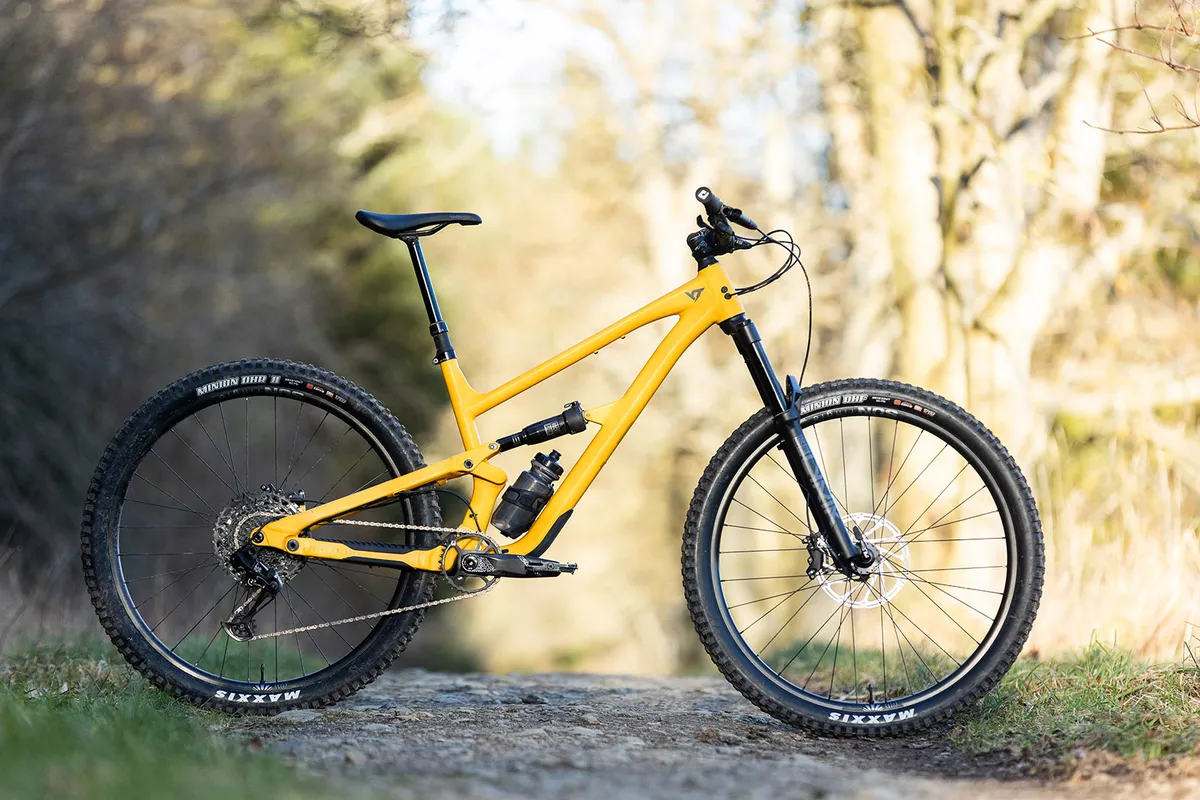
- £2,499 / $2,799 / €2,499 as tested
- Pros: Confidence-inspiring geometry; good spec for the money; fork performs well
- Cons: It's not the the lightest
YT's entry level to the Jeffsy range offers the value for money often associated with the German direct-to-customer brand.
The bike offers impressive capability, tackling enduro trails with ease while remaining playful on mellower trails.
A centred riding position gives you plenty of confidence to push the bike to the limit on the descents. A steep 77.9-degree seat angle puts your weight over the BB, helping on technical climbs.
It's not the lightest trail bike we've tested, but we feel this is less important with it sitting towards the more aggressive side of the segment.
- Read our full YT Jeffsy Core 1 review
Boardman MTR 9.0

- £2,000 as tested
- Pros: Rides with confidence and has excellent brakes; RockShox fork and rear shock
- Cons: Contact points detract from overall package
The MTR 9.0 is Boardman's flagship mountain bike, with an upgraded alloy frame, 150mm RockShox fork, a Deluxe Select+ rear shock and a groupset that is, by and large, comprised of Shimano SLX-level parts.
The bike is happiest heading downhill, where it feels planted, and the Shimano SLX four-piston brakes provide a whole load of stopping power.
The MTR climbs reasonably well. The relatively steep seat-tube angle helps you get your weight over the bottom bracket, and the wide-ranging 10-51 tooth cassettes help winch you up the toughest climbs.
The bike has a dropper post, which is great for such a gravity-focused bike, but the dropper lever is a bit small and not the easiest to use.
The bike rides with more confidence than you might expect and, apart from the dropper lever, there really isn't much to fault.
- Read our full Boardman MTR 9.0 review
- Buy now from Tredz
Boardman MTR 8.8
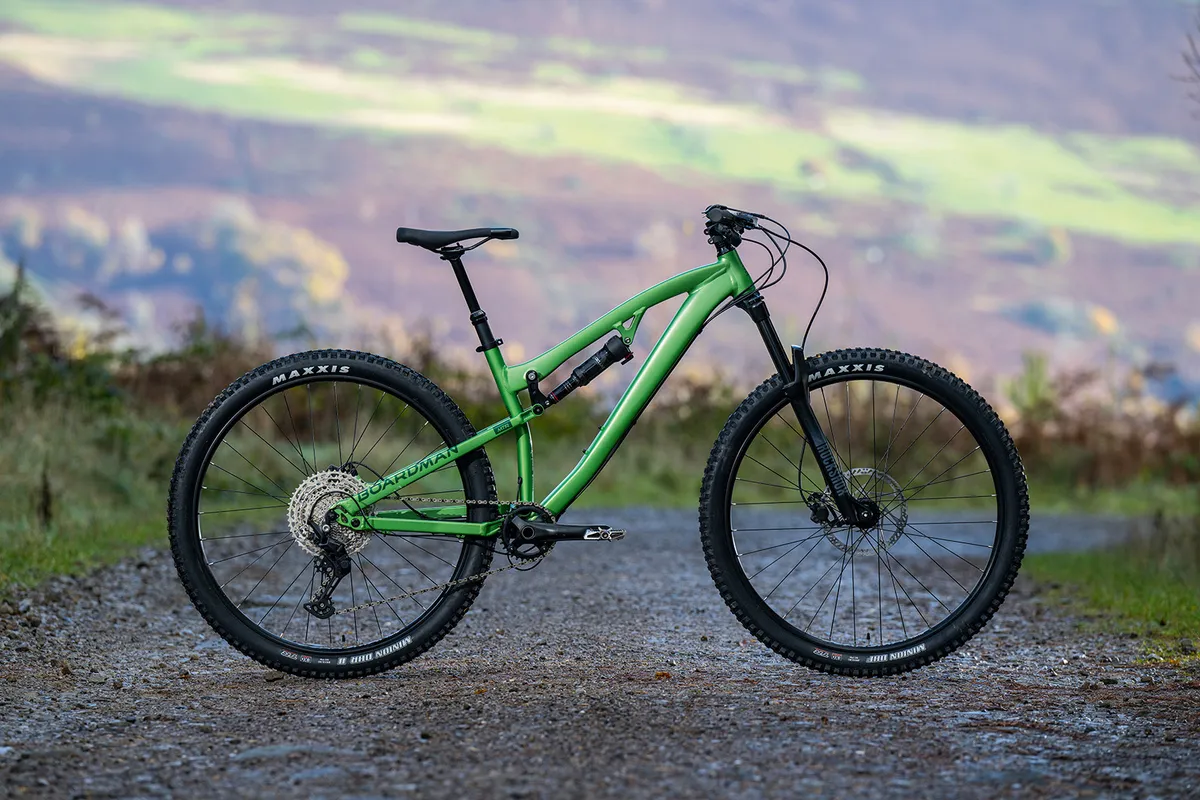
- £1,350 as tested
- Pros: Impressive spec for the price; good suspension feel
- Cons: underpowered brakes; dropper post length
Boardman's MTR 8.8 is built to be the ideal all-round UK trail bike. It's very capable when pointed down a trail, thanks in part to the 145mm of rear suspension controlled by a RockShox Deluxe Select+, and 150mm RockShox Recon Silver RL fork.
Considering its suspension travel, it climbs very well, but it's the descents where the Boardman shines.
In its price range, there aren't many bikes that can provide the same levels of performance. However, a couple of spec changes, such as a longer dropper post and more powerful brakes, would make the riding experience even better.
- Read our full Boardman MTR 8.8 review
Cannondale Habit LT 2

- £3,500 / $3,625 / €3,699 / AU$5,899 as tested
- Pros: Spritely and playful character; good climber; absorbs big hits well
- Cons: Basic suspension dampers aren't the smoothest
The Habit LT 2 is Cannondale's long-travel trail bike with 140mm of rear suspension travel matched to a 150mm fork upfront.
We found the bike enjoyed being pumped and pushed over tough terrain while being able to absorb big impacts when asked to.
The suspension isn't as smooth as forks that use posher dampers, but the confidence-inspiring brakes and geometry will allow you to push the bike on more challenging trails.
- Read our full Cannondale Habit LT 2 review
Canyon Spectral 125 CF 7

- £3,349 / $4,199 / €3,499 / AU$5,349 as tested
- Pros: Aggressive geometry and stiff, low-slung frame; great handling on really steep terrain
- Cons: Sluggish at slow speed on mellow terrain; thin tyres
A shorter-travel trail bike, the Spectral 125 mixes that with a 140mm-travel fork and a long reach geometry that's built for more aggressive riding. It's a different, all-carbon frame from the longer-travel Spectral bikes and saves 100g in weight.
The stiff, aggressive, low-slung frame is great for bikepark laps and climbs, but you need to increase the sag from the recommended values for the bike to handle rock gardens comfortably.
The bike navigates super-steep terrain admirably though, with the long frame helping to maintain stability. It pays to tinker with the Spectral 125's suspension settings and to ride hard to get the best out of the bike.
Want a spec upgrade? We've also tested the Canyon Spectral 125 CF8 .
- Read our full Canyon Spectral 125 CF 7 review
Carrera Titan X
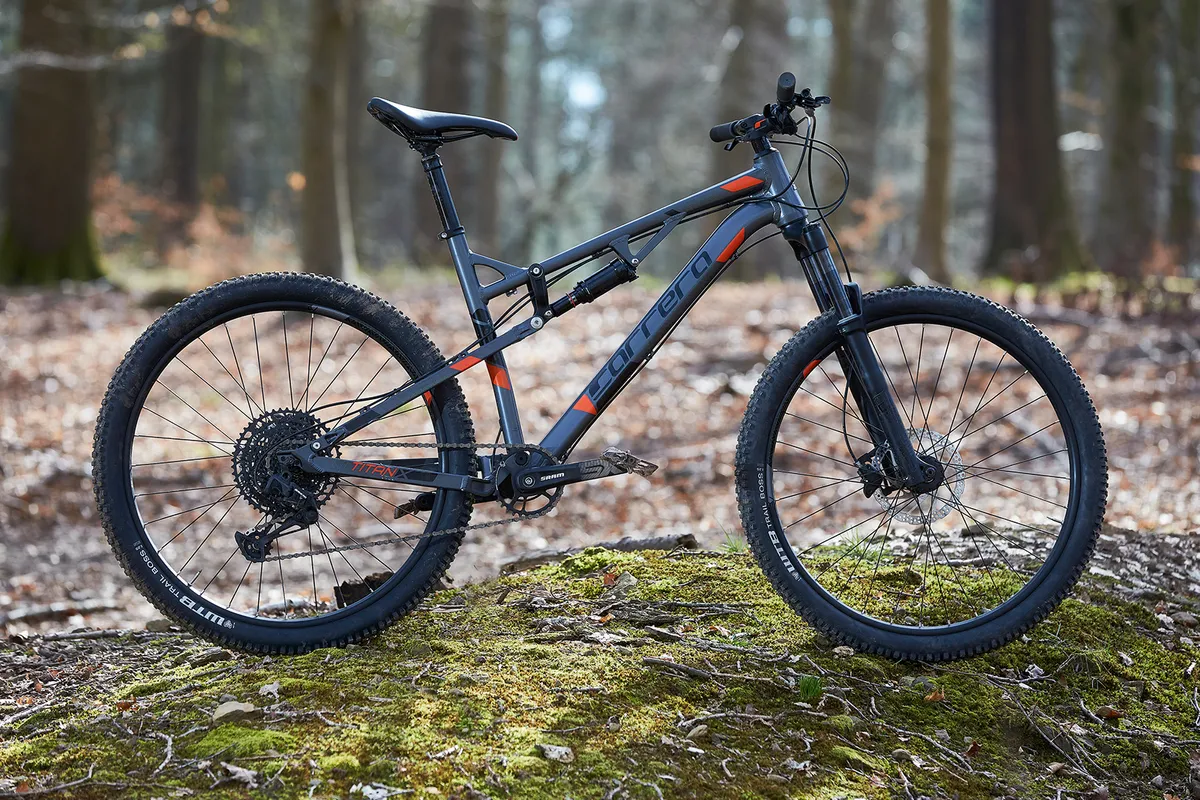
- £850 as tested
- Pros: Excellent spec for the price; a real advantage over hardtails at this price
- Cons: limited size range
Full-suspension bikes for under £1,000 are a rarity, and ones that are as well-specced as the Carrera Titan X are rarer still.
The kit on this bike is really impressive. It has SRAM SX 12-speed gearing with a 1x setup, a Trans-X dropper post and Shimano hydraulic brakes. In short, what you'd expect from a pricier bike.
When it comes to ride performance, the Titan X's suspension works surprisingly well, making this bike a good shout over a hardtail – which is normally the go-to option at this price point.
When climbing, the Titan X's frame is a little cramped due to its relatively old-school geometry, but it winches up hills better than you might expect.
The only real drawback to the Titan X is the limited sizing, and taller riders should stay clear. This is a real try-before-you-buy bike, but if it fits and you're on a budget, it's a compelling option.
- Read our full Carrera Titan X review
Cotic Jeht Silver Mullet
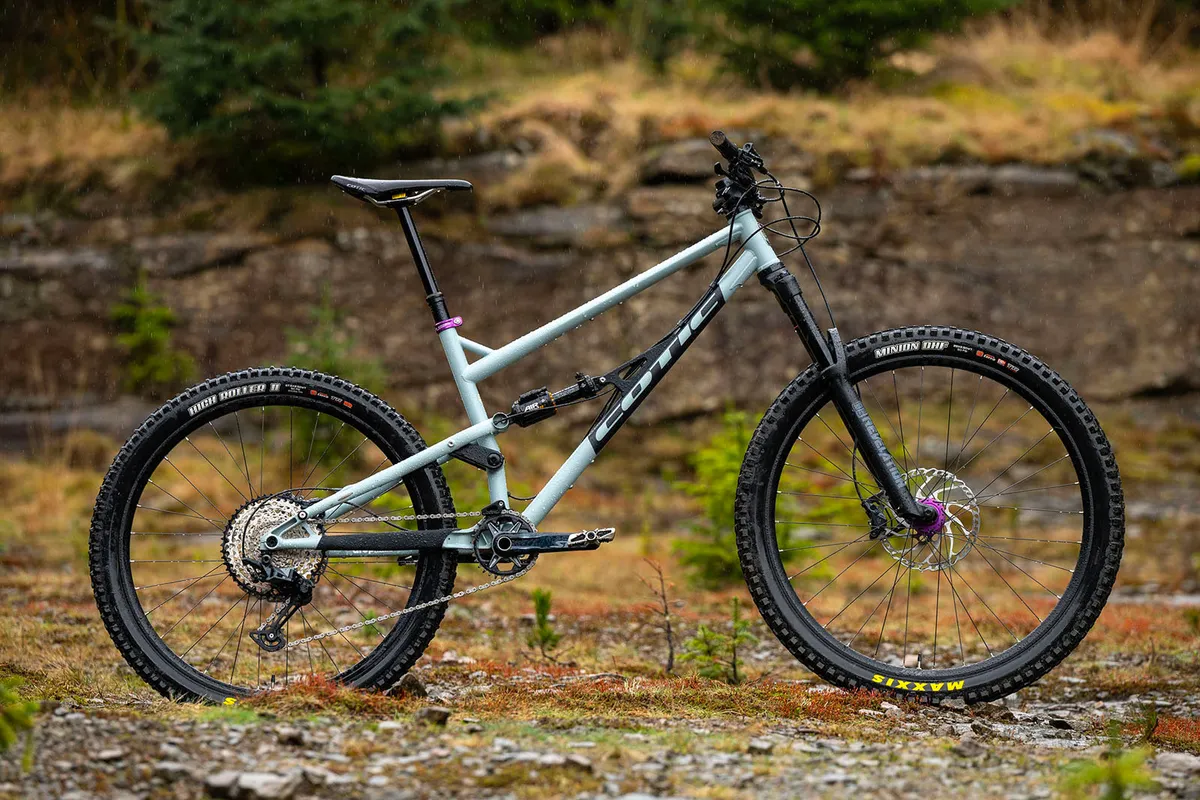
- £3,989 as tested
- Pros: Composed and confident; smooth feeling suspension
- Cons: Stiff suspension under braking; feels large
The Cotic Jeht is made from Reynolds 853 steel with a steel-alloy rear triangle that has 140mm of suspension travel.
Its long, low and slack geometry is on point and allows you to let the bike run through the techiest of sections while still feeling in control.
The Jeht is a fairly tall bike, and when braking the rear suspension isn't as good as some of the competition, especially those bikes using a four-bar design.
The spec can be matched to your pockets, with our test bike featuring an upgraded RockShox Revelation fork with a Charger 2.1 damper.
- Read our full Cotic Jeht Silver Mullet review
Focus JAM 8.9

- £4,799 / €4,699 / AU$6,999 as tested
- Pros: Impressive suspension maintains ground contact well; clever internal frame storage
- Cons: Hefty weight; complicated stem design
With 150mm of travel, the JAM 8 series bikes get a carbon front triangle with neat internal storage and share geometry with the alloy JAM 6 series. There's also tidy internal routing through the stem for the cables.
The new suspension design, with its flip chip, leads to a better-supported mid-stroke than Focus's older system, leading to a more playful ride and less chance of bottoming out. It also helps keep contact with the ground well at the rear on descents.
The mix of agile handling and stable suspension leads to an exciting ride, and it's easy to pick and change your line, although the Fox 36 Performance fork feels more limiting than the rear travel.
- Read our full Focus JAM 8.9 review
GT Sensor Carbon Pro

- £4,199 / $4,750 as tested
- Pros: Incredibly supple suspension; well-balanced geometry; comfortable and confident handling
- Cons: Not the most perky climber; drivetrain spec is lacklustre
The Sensor Carbon Pro has 140mm of rear-suspension travel married to a 150mm fork up front.
We found the bike made good use of the travel, with the quality RockShox suspension providing smooth and supple bump absorption.
On steeper more technical tracks, the Sensor Carbon Pro performs excellently but it's climbing performance isn't as spritely as other trail bikes.
- Read our full GT Sensor Carbon Pro review
GT Sensor Carbon Pro LE
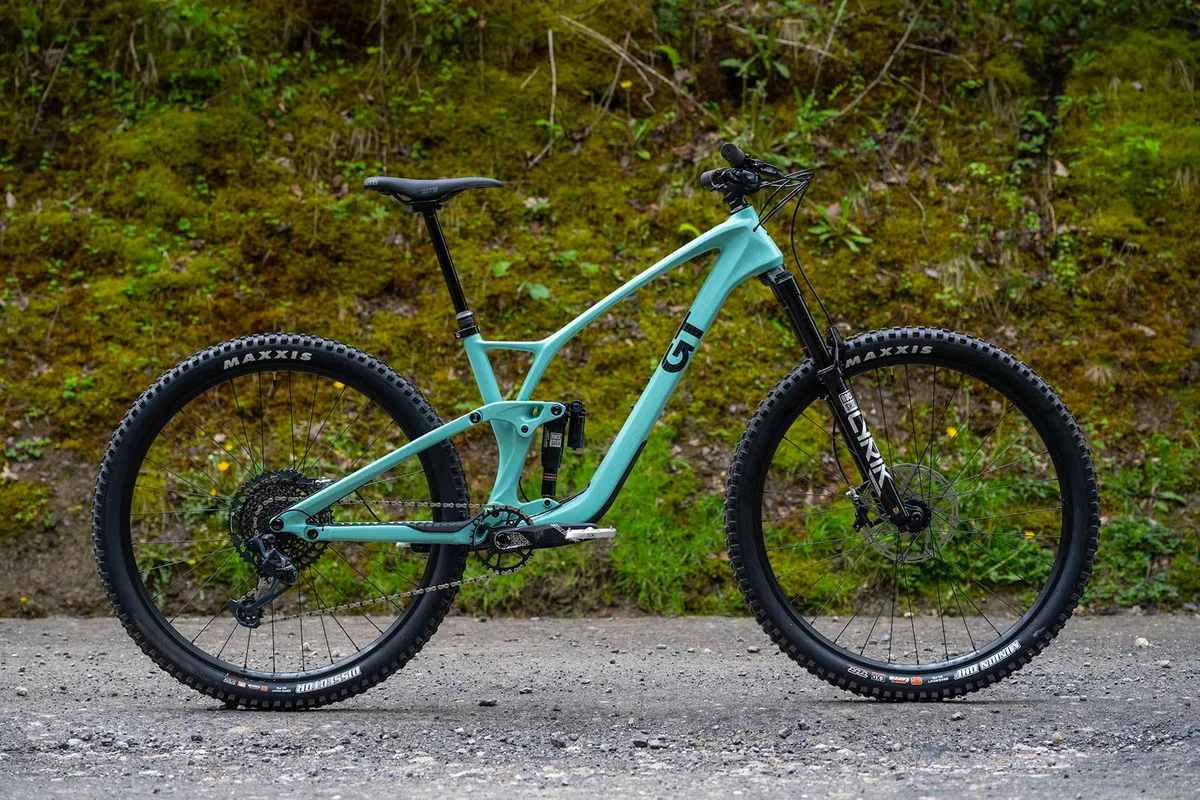
- £5,000 / $5,750 as tested
- Pros: Great for rowdy trail riding; RockShox suspension works very well; ideal for those looking for simplicity
- Cons: Freehub engagement is clunky; SRAM G2 RSC brakes struggle with power down steep trails
GT's Sensor Carbon Pro LE feels very capable on rougher trails considering its suspension travel, with the 150mm fork and 140mm rear-suspension travel combination providing a composed ride on gnarly trails.
The Sensor certainly prioritises downhill prowess, with the bike remaining poppy and responsive whatever the gradient.
The RockShox Lyrik Ultimate fork and Super Deluxe Ultimate shock provide composed damping, but SRAM's G2 RSC brakes are a little lacklustre when shedding speed.
- Read our full GT Sensor Carbon Pro LE review
Kona Honzo ESD
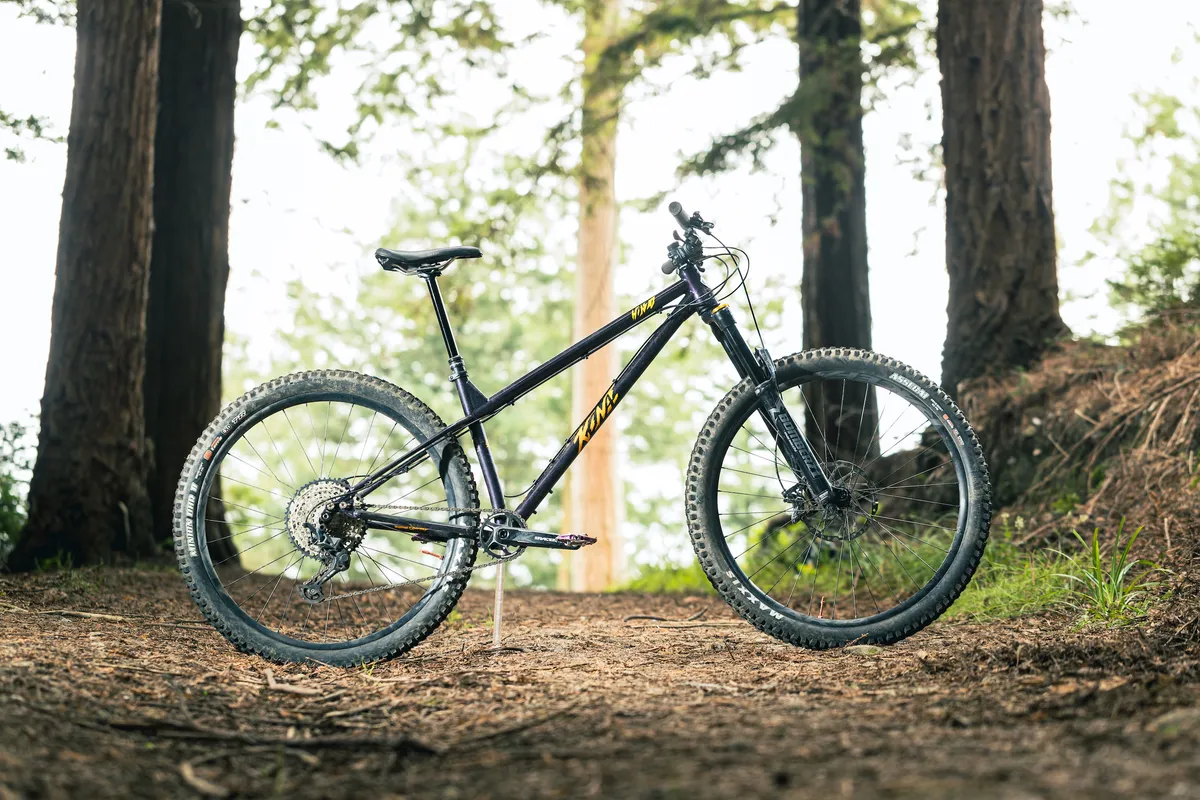
- £2,899 / $3,099 / €3,299 / AU$4,399 as tested
- Pros: Very smooth ride over the rough stuff; descends better than a hardtail should
- Cons: Not great value for money
It may be a hardtail, but the Kona Honzo is long and slack enough to handle the steepest descents, with a braced steel frame, 150mm-travel fork and plenty of room for aggressive rubber. Adjustable rear dropouts enable you to fine-tune your ride or go singlespeed.
There's bags of stability on steep descents and the bike is great at carving wide corners, but shorten the rear end and direction changes come really easily. You've got a 203mm rotor at the front and 180mm out back to help control your speed.
The Honzo's steep 77.5-degree seat tube helps with climbing and it's got plenty of room for the long-travel TransX dropper post.
We were impressed by the climbing performance, aided by a 30t chainring and a wide-range 10-51t cassette, while the bike's length means you can shift your weight around both up and downhill. It's a hardcore hardtail that shows you don't need suspension out back to have fun.
- Read our full Kona Honzo review
Marin Rift Zone XR 27.5

- £3,095 / $3,500 / €3,499 as tested
- Pros: Well-designed frame; excellent rear suspension
- Cons: Brakes lack bite; not the best climber
The Marin Rift Zone XR is built on the alloy Rift Zone frameset which provides top-notch rear suspension while prioritising front-end control.
The Fox Float X rear shock works well to support the rear end, giving the bike playfulness without sacrificing grip.
The bike's poppy character makes for an engaging ride, though the bike requires rider attention on gnarlier sections of trail.
A 'sit up and spin' attitude to climbing is provided by the upright and relaxed position, with the bike featuring more pedal bob than its competitors.
- Read our full Marin Rift Zone XR 27.5 review
Marin Rift Zone 29 XR

- £3,775 / $3,899 / €4,289 / AU$5,499 as tested
- Pros: Fast and stable at speed; clever spec choice; impressive on technical terrain
- Cons: Not the best climber; freehub engagement could be better
Marin's Rift Zone 29 XR is built for the descents, with the frame and suspension offering a great platform for tearing up your local forest.
With only 130mm of rear-suspension travel, the Rift Zone 29 XR proves numbers aren't everything by absorbing big bumps and providing a composed ride feel.
We found the Rift Zone 29 XR wasn't the fastest on the climbs, but it made up for this when pointed downhill.
- Read our full Marin Rift Zone 29 XR review
Merida One-Forty 500
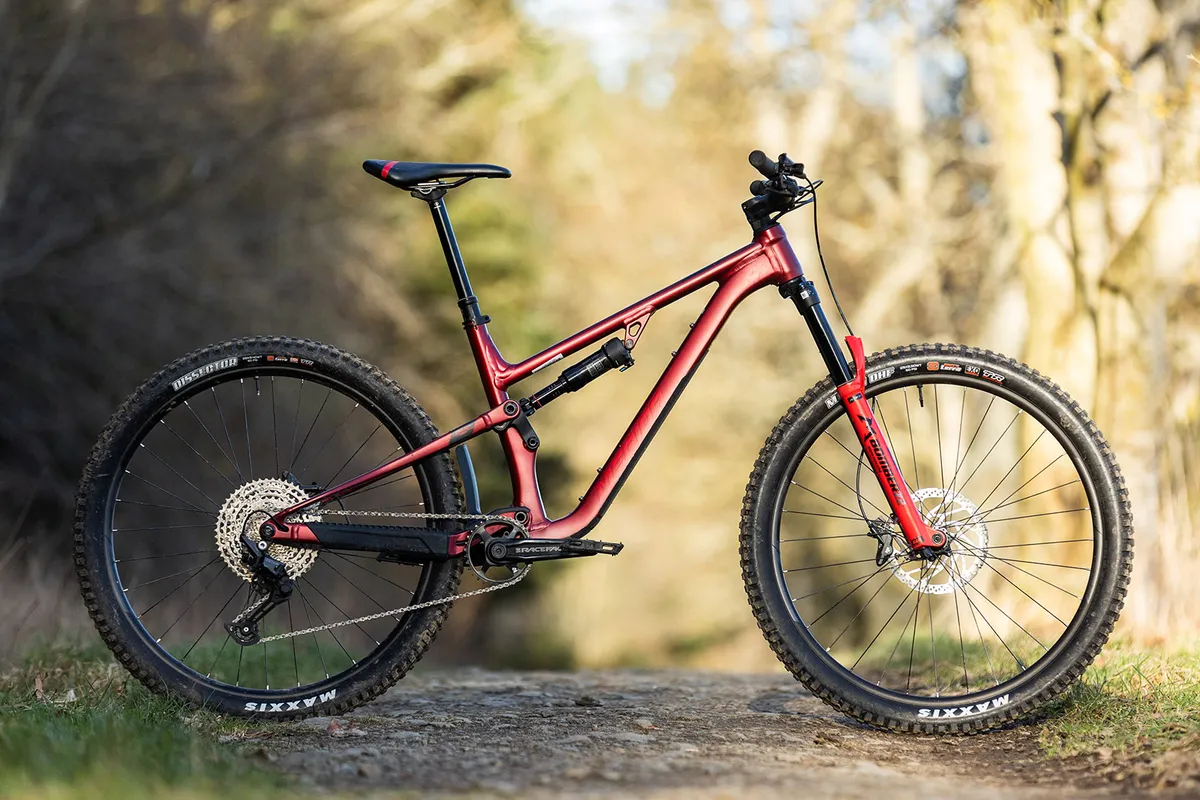
- £2,600 / €3,160 / AU$3,799 as tested
- Pros: Efficient pedalling; playful handling; good spec for the money
- Cons: Rear-end grip isn't the best in the wet; brake bite point can wander
The One-Forty 500 uses the same frame as the One-Forty 700 that we awarded Trail Bike of the Year in 2023.
At this lower price point, the bike remains an impressive performer with eager climbing characteristics and supportive suspension on the descents.
The bike offers an impressive spec for the money, though we did find the Shimano Deore four-piston disc brakes a little unpredictable, with a wandering bite point affecting the accuracy of our braking.
- Read our full Merida One Forty 500 review
Merida One-Twenty 700
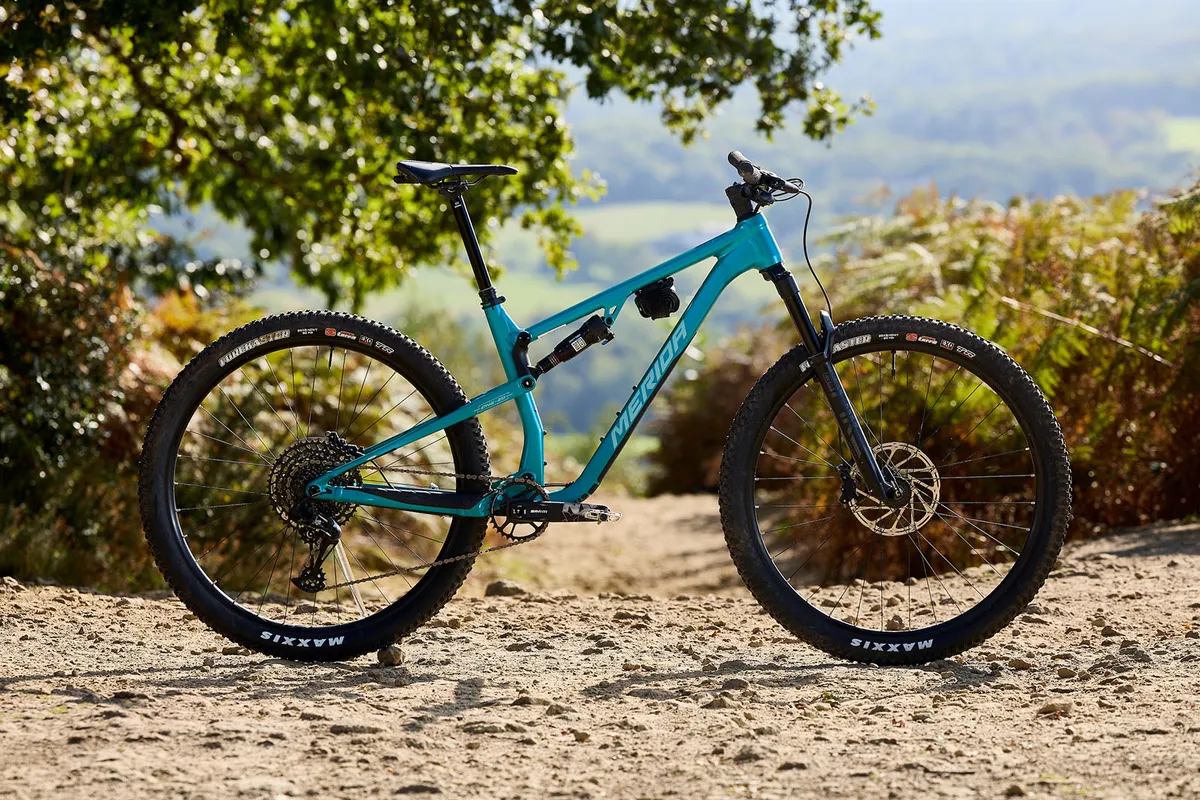
- £3,100 as tested
- Pros: Progressive suspension; confident handling; efficient pedalling
- Cons: Front end is quite harsh; brakes are average
Despite its name, the One-Twenty 700 has 130mm of suspension travel front and rear, which does a stellar job of climbing thanks to Merida's P-Flex flex-stay suspension linkage.
While the bike isn't the most composed on the downhills, the long and low geometry still eggs you on to push the brakes and tyres to their limits.
The RockShox Pike Select fork and a RockShox Deluxe Select shock work well to iron out the bumps, but the SRAM DB8 brakes feel a little underpowered when hitting the trail at full speed.
- Read our full Merida One-Twenty 700 review
Polygon Siskiu T7 29
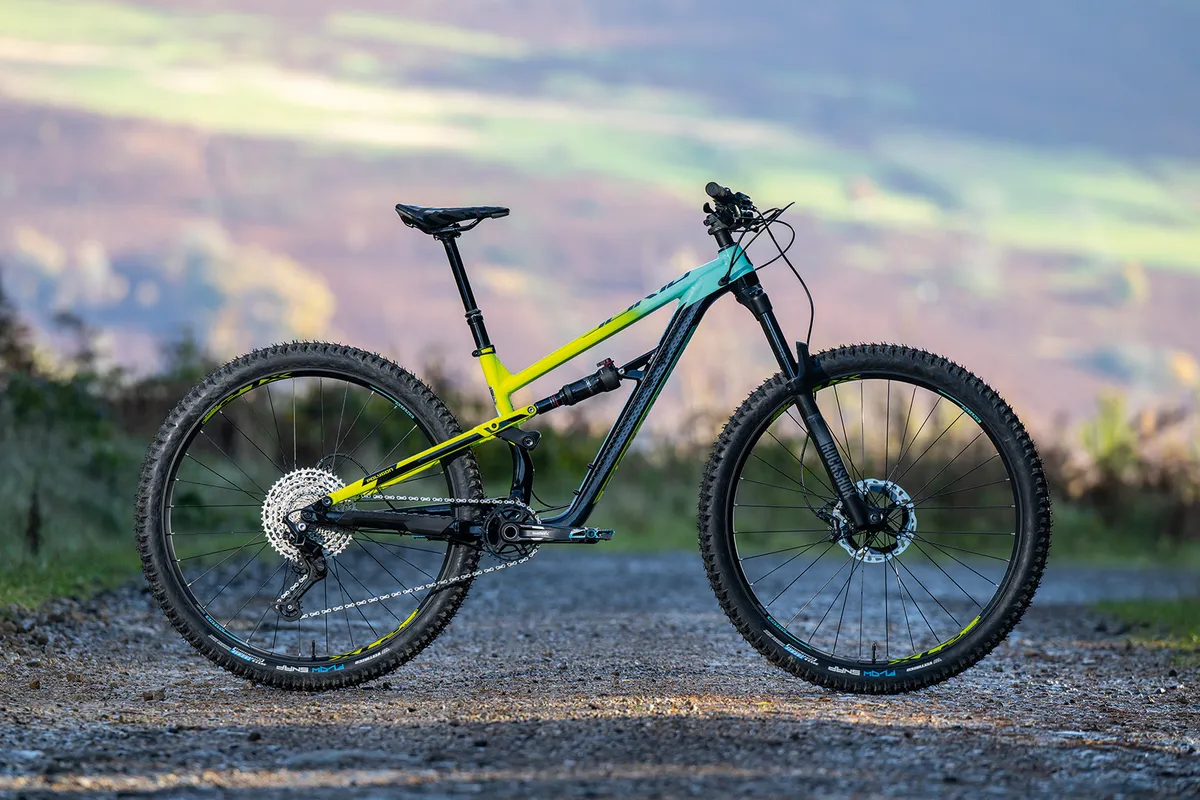
- £1,800 as tested
- Pros: Great trail geometry; impressive value for money
- Cons: Brakes are a weak point
The Polygon features modern trail geometry and decent components that make it very capable on the descents, with the 65.5-degree head angle giving confidence on even the steepest terrain.
A RockShox Deluxe Select+ controls 135mm of rear-suspension travel, while a 140mm RockShox Recon Silver RL fork supports the front. The bike comes with Shimano's Deore 1x12 drivetrain with Tektro's HD-M735 brakes.
Polygon's Siskiu will take all you can throw it, but is maybe not as responsive as bikes twice its price. If you are a GoOutdoors member, however, you can get the bike at the reduced price of £1,600.
- Read our full Polygon Siskiu T7 review
Trek Fuel EX 9.7

- £4,175 / $4,000 / €4,499 / AU$7,500 as tested
- Pros: Excellent frame; well-considered geometry; very capable with great suspension
- Cons: Poor brakes; tyres aren't the best
The Fuel EX frame provides a solid, adaptable and high-performing bedrock to the bike with the geometry and suspension design offering good confidence on the descents.
Our tester found the SRAM DB8 brakes to be a little underpowered when riding aggressively, compromising the bike on fast, technical downhill sections.
The tyres were also behind the competition, making for a less-than-precise ride feel.
- Read our full Trek Fuel EX 9.7 review
Whyte T-140 RS 29er
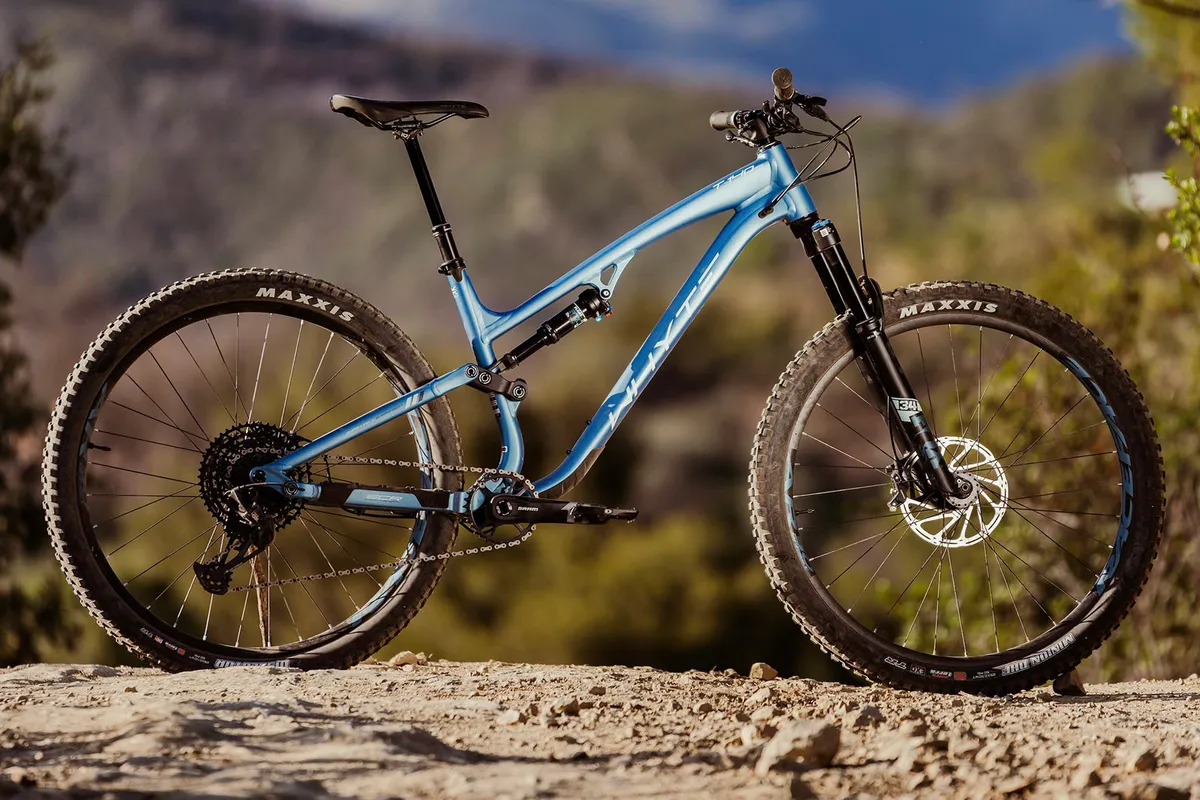
- £4,099 as tested
- Pros: Super-composed suspension; excellent pedalling characteristics
- Cons: Harder riders may push suspension to its limit; size range
Whyte's T-140 RS is a true do-it-all trail bike featuring 135mm of rear travel controlled by a Fox DPS Performance Elite shock and a 140mm Fox 34 Performance Elite fork.
The T-140 RS smoothes the way without fuss, with the rear suspension soaking up small and big hits.
The 34mm stanchion diameter of the fork becomes noticeable on seriously technical sections and can feel squirrelly under heavy braking.
The lightweight chassis helps the bike when pointing uphill.
- Read our full Whyte T-140 RS 29er review
YT Jeffsy Core 3
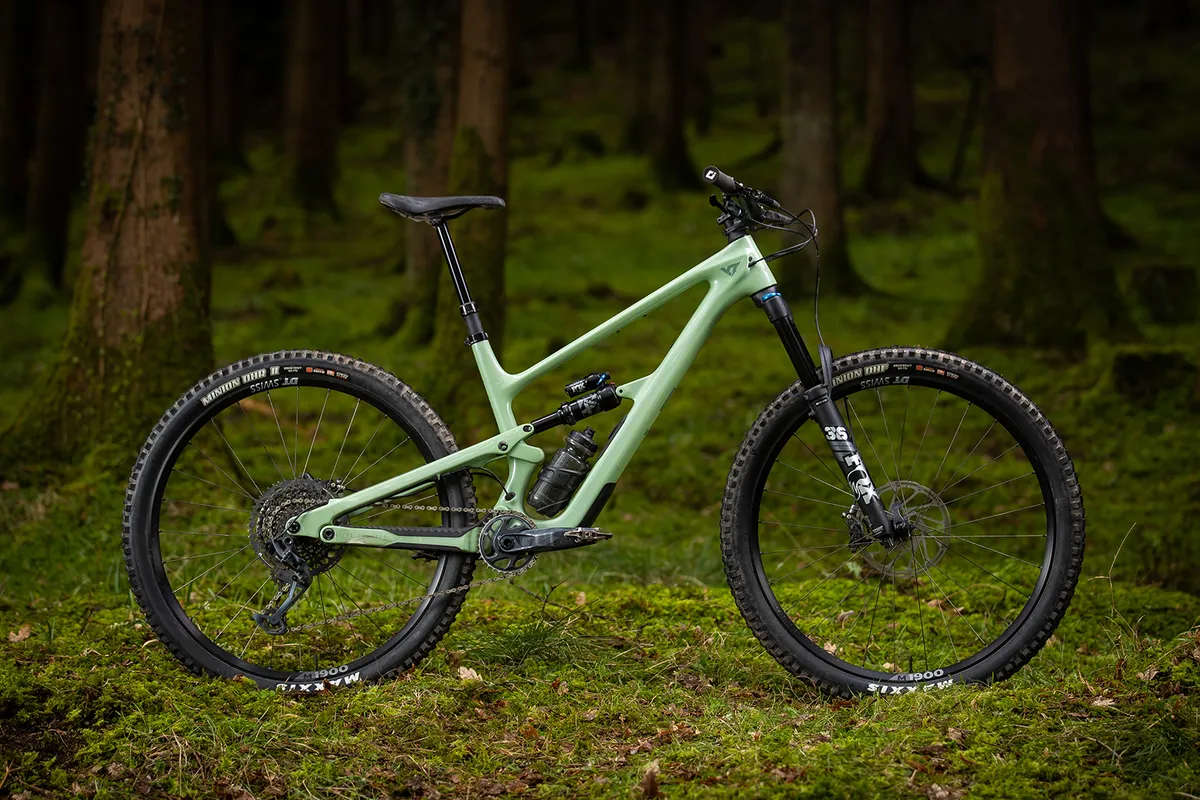
- £3,999 / $4,299 / €3,999 / AU$6,999 as tested
- Pros: Capable climber; fun handling; easy to ride on a variety of trails
- Cons: Less poppy than previous iteration
The Jeffsy performs well on the climbs, with a slight suppleness adding good traction on technical ascents, while keeping an efficient-feeling pedal platform.
Playful handling makes mellow trails entertaining, but the bike feels more mature than the previous version and remains more composed on rough terrain.
This leads to the bike being more capable downhill but at the cost of poppiness on level ground.
- Read our full YT Jeffsy Core 3 review
Why you can trust BikeRadar
BikeRadar has been an authority on bikes and cycling tech since its inception in 2007, delivering the world’s best riding advice.
We have experts testing all types of bikes, parts, clothing and accessories, from road, mountain and gravel bikes to commuting, bikepacking and electric bikes.
Our reviews are always editorially independent – with no exceptions. Our reviewers comprehensively test all products in the real world, always reflecting on performance, value and the wider market when delivering their verdicts and review ratings .
We have more than 15,000 product reviews available at your fingertips, as well as expert buying, maintenance, training, skills, health and fitness advice.
Our annual Bike of the Year test is an industry benchmark and the BikeRadar team consists of some of the most experienced riders and testers in the business.
Trail bike buyer’s guide | Everything you need to know when choosing a trail bike
What is a trail bike.

The trail mountain bike category occupies the space between lightweight, speed-focused cross-country bikes and enduro and all-mountain mountain bikes designed to fly downhill and slowly winch back to the top.
Balancing pedalling efficiency and gravity potential, trail bikes are intended to hit a sweet spot; they aren’t quite as rowdy as enduro bikes but are tougher than cross-country bikes.
They make light work of riding down flow trails with big sweeping berms and can cut it on more demanding terrain too – and you might be surprised at just how capable they truly are.
Really, trail bikes are best for mountain biking in the most general sense and are designed to give you just about enough of everything.
Trail bikes also tend to be relatively affordable when compared to other types of mountain bike. The components don’t have to be super-lightweight as on XC bikes, or heavy-duty enough to survive the rigours of downhill, which helps to keep costs down.
Although enduro and downhill bikes are considered to be the Formula 1 of mountain biking, we think trail bikes are the most important and widest-spanning category, and benefit from economies of scale where bigger production runs also play a factor in keeping prices down.
The affordability of trail bikes combined with their versatility, helps to make them an ideal choice if you’re new to the world of mountain biking or are looking for a one-bike solution to all your mountain biking needs.
What to look for in a trail bike
There are no set rules when it comes to defining what a trail bike is and, like all mountain biking sub-disciplines, they exist on a sliding scale in terms of capability, geometry, suspension travel and price.
However, there are various factors that when put together constitute a trail bike and are worth bearing in mind when looking for one of these versatile machines.
Frame material
Many brands stick to aluminium alloy or carbon fibre for trail bike frames, while some more boutique builders opt for alternative frame materials, such as steel or titanium.
Carbon has the advantage of being lighter and stronger, and can be made to be stiffer than an equivalent aluminium frame, so it's a good choice if zipping uphill and weight are priorities. It does, however, cost more than aluminium.
While it might not have the exotic feel of carbon, or be as lightweight, an aluminium frame is a good call if you’re new to the sport or on a budget, but it’s hard to argue with the desirability and performance of carbon.
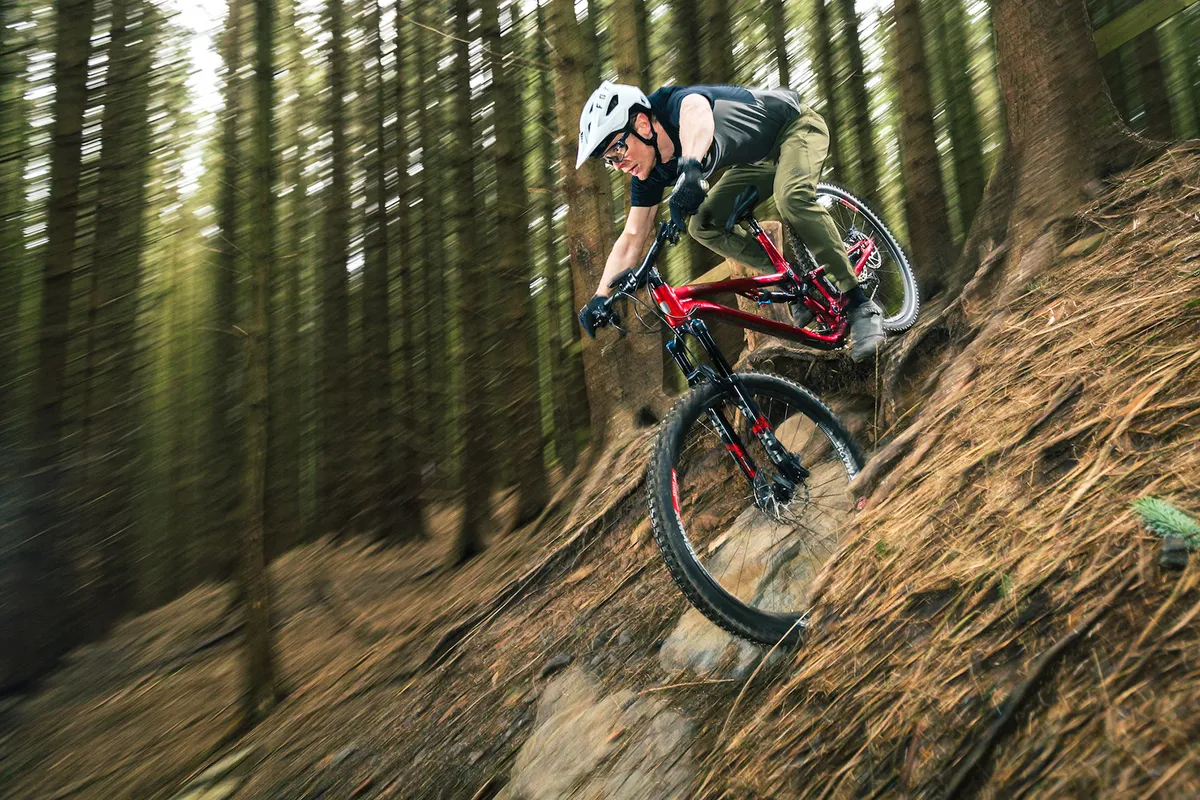
Frame geometry probably has the biggest impact on how a mountain bike handles, with even slight adjustments to the wheelbase, head tube angle and reach determining how a bike feels.
In keeping with their Goldilocks position between XC and enduro bikes, trail bikes have a relatively slack geometry that makes them capable enough to handle most rough descents, while being suitable for all-day epics and plenty of comfortable and efficient climbing.
As a general rule, trail bikes have a head tube angle of between 64 and 66.5 degrees and seat tube angle of between 73 and 78 degrees.
Look for slacker head tube angles if you want a bike that will descend better, because a slacker angle helps give the bike a calmer ride by slowing down the steering. It also makes its wheelbase longer, which helps improve stability at high riding speeds.
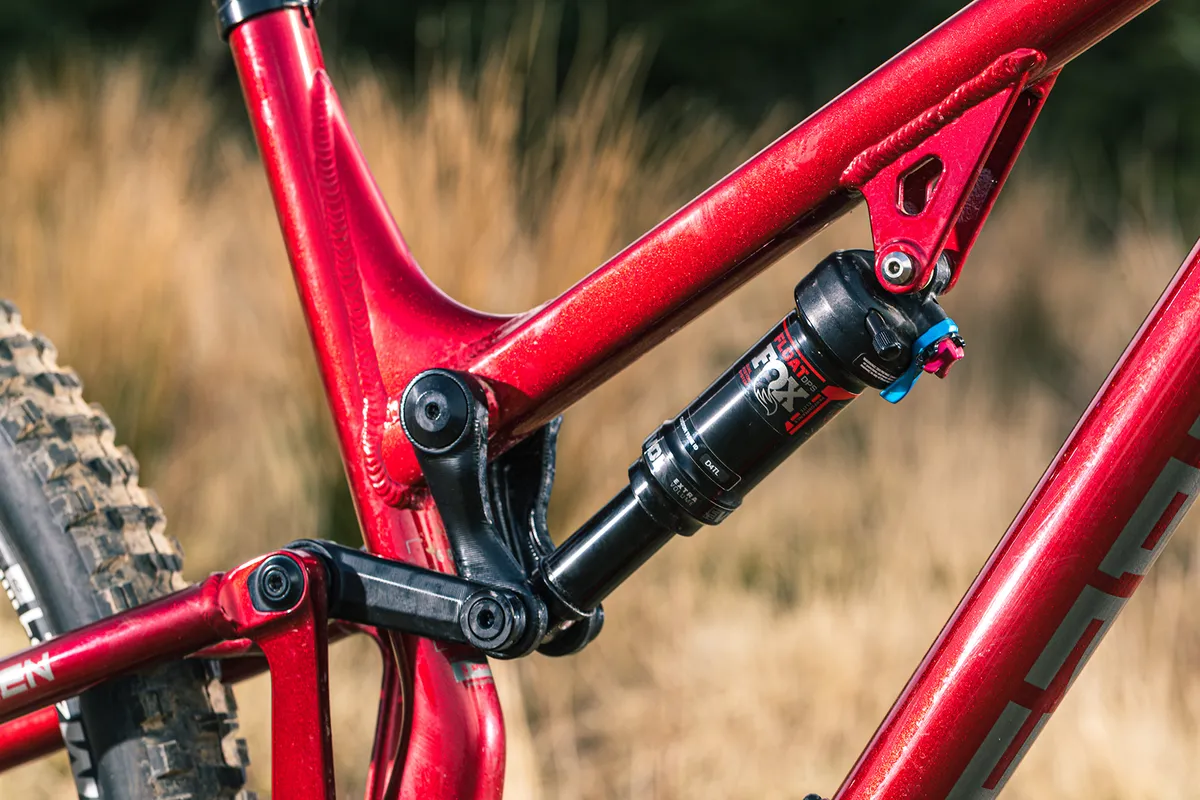
Most commonly, trail bikes have front and rear suspension with between 120mm and 150mm of travel.
As travel increases, a bike will be better suited to riding downhill and less suitable for climbing, so when considering how much travel to go for on a trail bike think about the type of terrain you'll spend most of your time riding and your riding style.
If you ride on rougher, more technical trails, or like to barrel down descents, choosing a trail bike with 140mm or 150mm is advisable.
Shorter-travel bikes won’t descend quite as well, but they are light and efficient so are a good choice if endurance riding and climbing is more your thing.
Wheel size and tyres

There used to be a time when mountain bikes simply had 26in wheels. But those days are long gone, and now mountain bikes come with either 27.5in or 29in wheels.
Both wheel sizes have their advantages and disadvantages . 29in wheels roll over obstacles and hold their momentum more, making them the preference for cross-country and the best downcountry mountain bikes . Compared to 29in wheels, 27.5in wheels are faster accelerating, stronger and more agile, with handling and placement feeling more natural too.
Trail bikes come with either of the two sizes and there isn’t really a right or wrong answer to which size wheels you should go for – you might prefer the snappier feel of 27.5in wheels or value the efficiency of 29in wheels.
One thing to bear in mind when selecting what wheel size to go for is your height. A taller rider will probably benefit from a larger wheel, whereas a shorter rider will benefit from a smaller wheel. Some manufacturers do consider this and provide models with different-size wheels depending on frame size.
Trail bike tyres tend to be chunkier with a decent amount of tread and are around 2.3 to 2.5in wide. These provide a decent amount of grip and help make trail bikes the versatile machines they are.
The best mountain bike tyres can really change how your bike feels, so it’s worth paying attention to what tyres a trail bike is specced with, but also remember that it’s not too hard to swap tyres out for something more suitable for your riding.
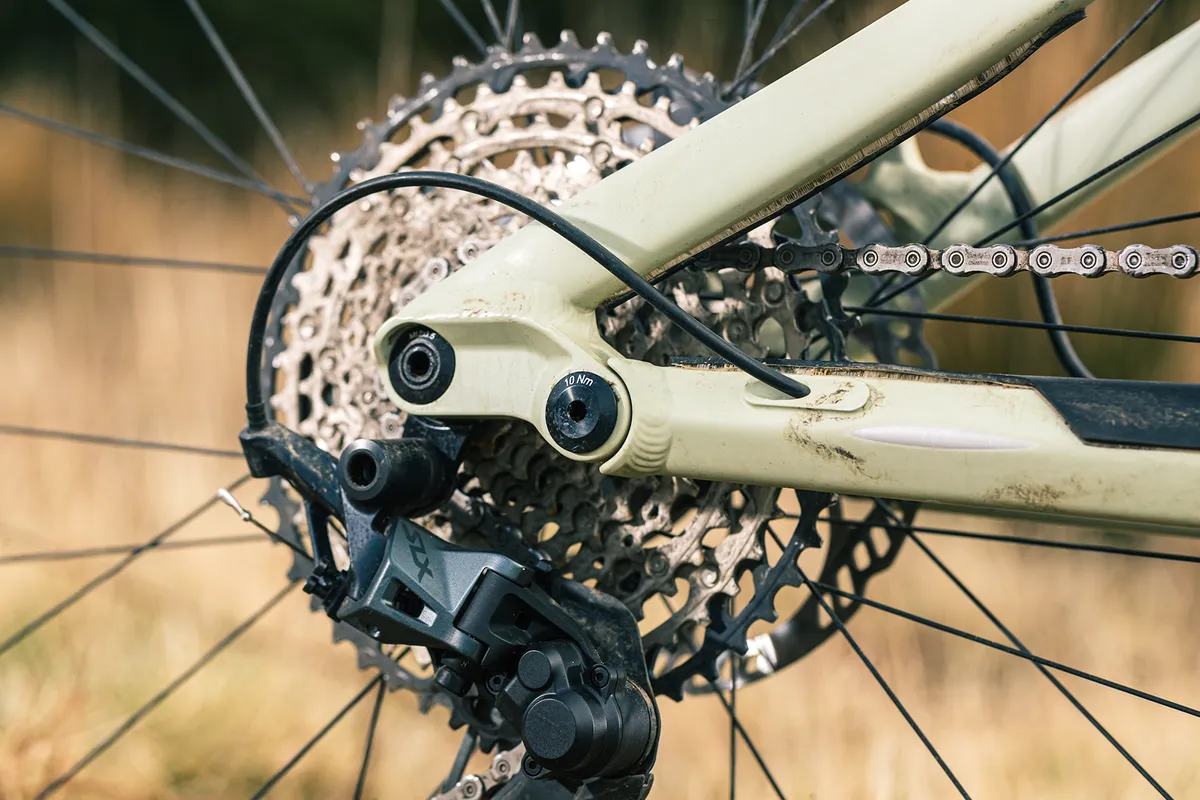
Trail bikes tend to have drivetrains with one front chainring. Thanks to wide-ranging 12-speed cassettes (normally between 10 to 52t), only having one front chainring doesn’t limit climbing potential.
Groupsets such as Shimano Deore XT M8100 are a popular choice on trail bikes. Trail bikes also tend to have easier gearing than speed-focused XC bikes. Front rings are usually between 30- and 34-tooth, while rear cassettes can go up to 52-tooth.
This gives trail bikes a wide range of gears for enough speed on the flat and to help you get up tough climbs.

Like most aspects of trail bikes, the brakes strike a balance between stopping power and weight saving.
Trail bikes will generally come with disc brakes that have two- or four-piston calipers. Four-piston brakes are more powerful and are aimed at downhill riding, where more braking power is needed, but this will of course add weight.
Rotors on trail bikes are often a mix, with up to 200mm both front and back. The larger the disc rotor, the more powerful the brakes will be, but this also comes with a weight penalty.
Hydraulic brakes are standard on all full-suspension trail bikes costing £1,000 or above, and often the best mountain bikes under £1,000 come with these brakes too.
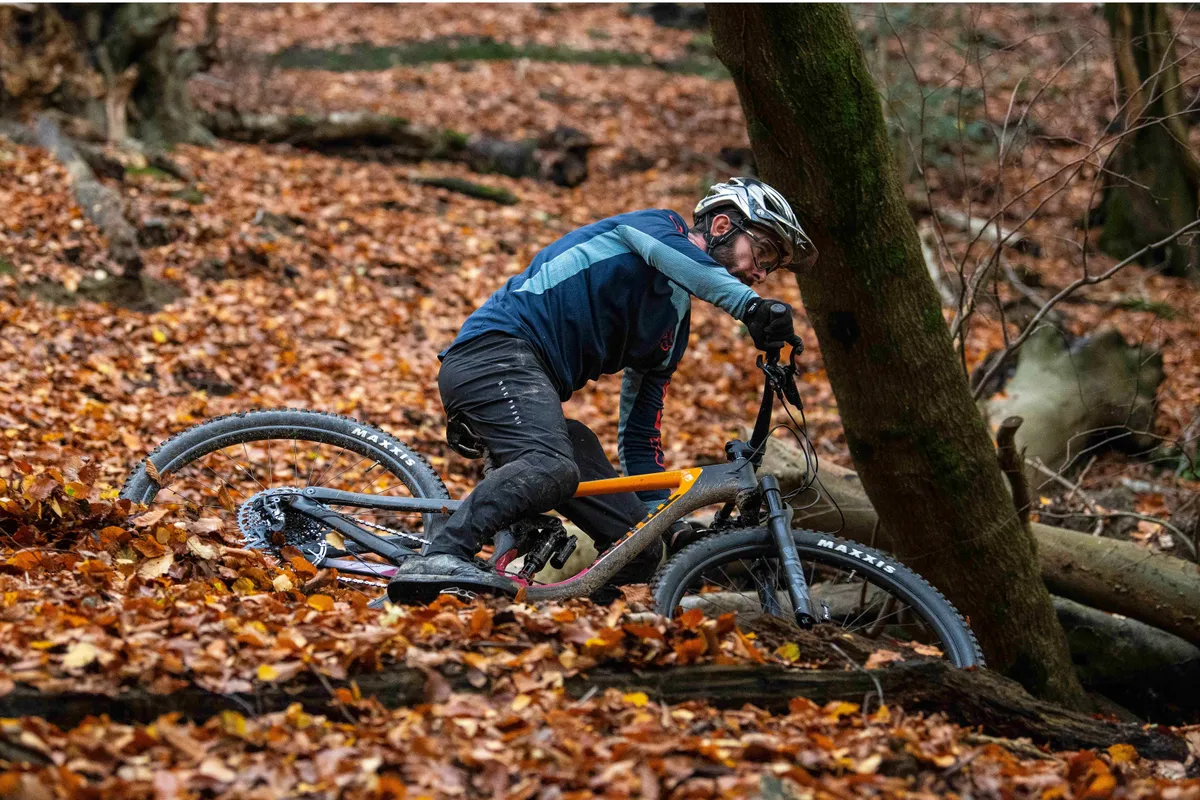
Wide mountain bike handlebars are becoming the norm, and provide extra stability, comfort and control.
Trail bikes follow this trend, many coming with a 760mm or 780mm bar, while some go up to 800mm. Just as smaller-sized trail bikes tend to have smaller 27.5in wheels, they also come with a narrower bar, going down 740mm, to help make the bike a better fit for smaller riders
Dropper posts
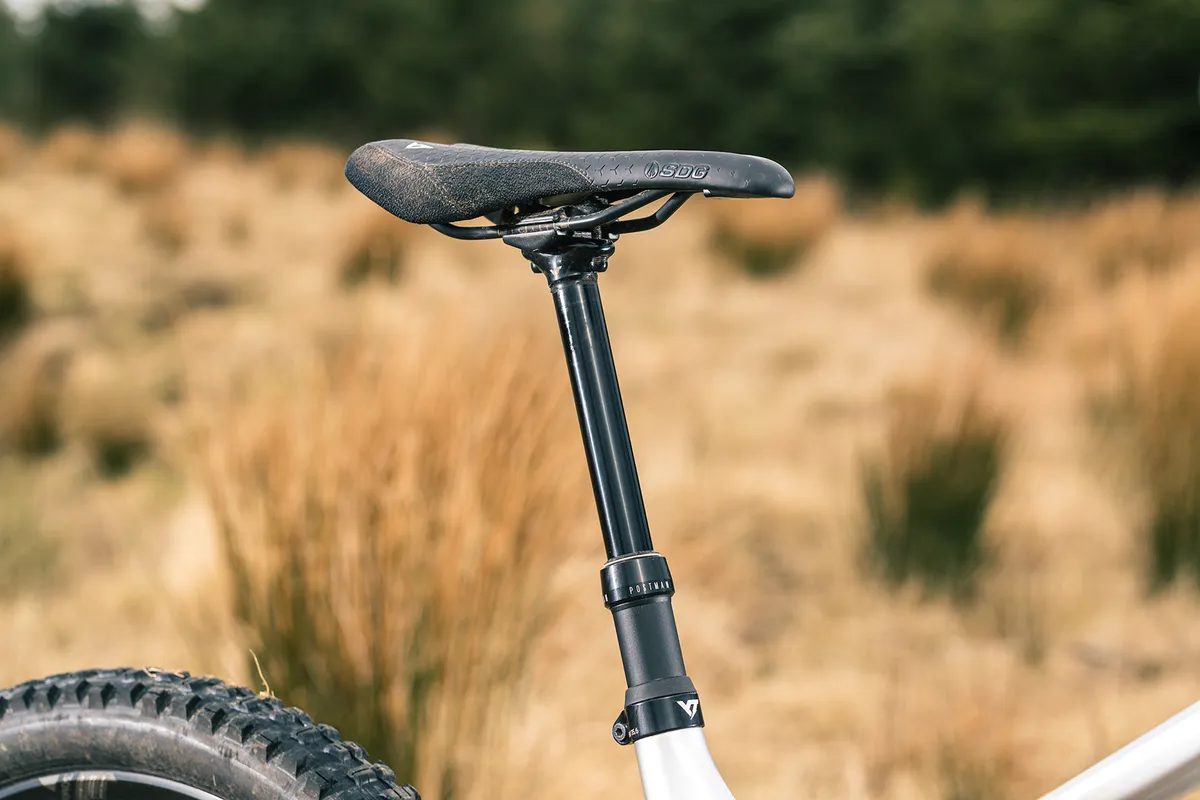
Dropper posts are almost standard on trail bikes.
They allow you to lower and raise your saddle with the flick of a handlebar-mounted button, giving you extra room to move your weight around on descents and the correct saddle height for efficient pedalling.
A dropper post is one of the first upgrades you should consider if your trail bike doesn't have one, because it will open the bike up to a wider range of riding.
Share this article

Content editor
You may also like
Bikeradar newsfeed, best cross-country mountain bikes 2024 | 15 top-rated xc mountain bikes and our buyer's guide, best mountain bike in 2024 | find the right mtb for your riding and budget, the best enduro mountain bikes of 2024 | 25 top-rated enduro mtbs.

- Terms & Conditions
- Subscribe to our magazines
- Manage preferences

The Best Short-Travel Trail Bike – 6 Mountain Bikes in Test

Bikes are growing increasingly versatile, lines are blurring and long-travel bikes are climbing more easily and faster than ever before. But does that mean that short-travel trail bikes are growing more potent on the downhills too?
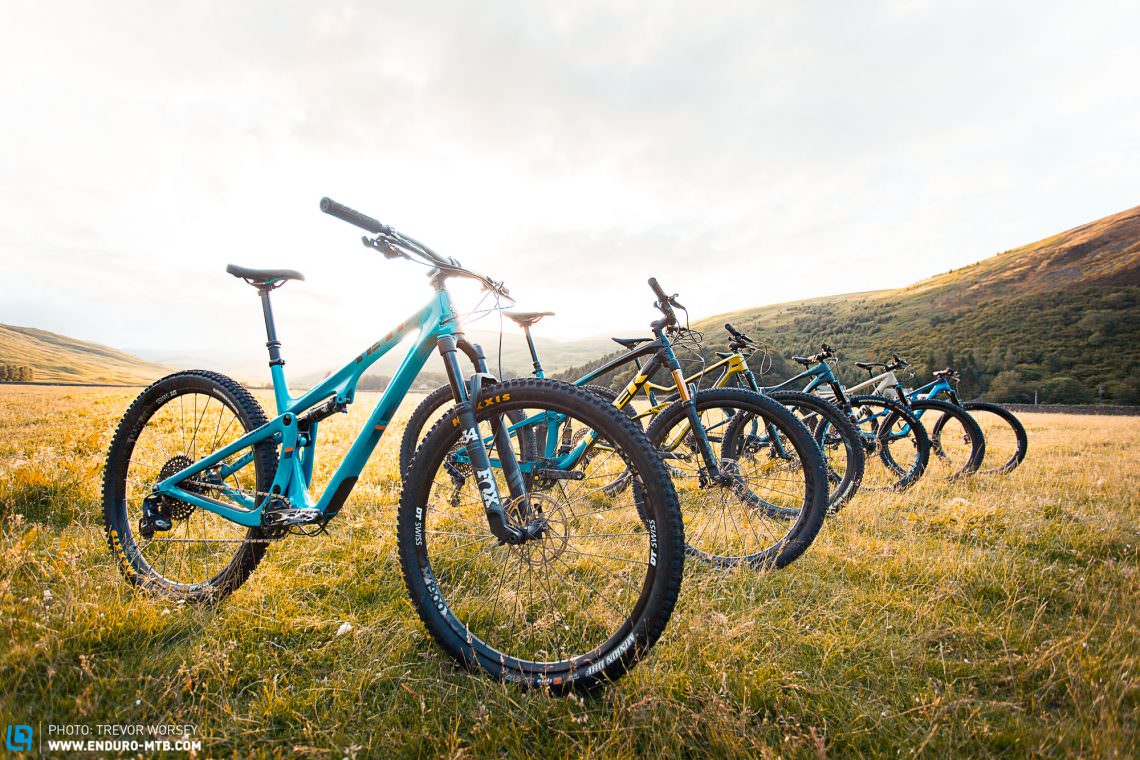
Our trail bikes are changing. We now have suspension kinematics that minimise pedal bob, while maximising big-hit fun. Seat tubes are growing steeper so we can climb better and bikes are growing increasingly lighter. The latest generation of 140–150 mm trail bikes have become the holy grail of do-it-all machines. So why do manufacturers still offer short-travel trail bikes? Is there a benefit to bikes with 130 mm or less travel? Are we missing something? So many questions. It’s time for some answers.
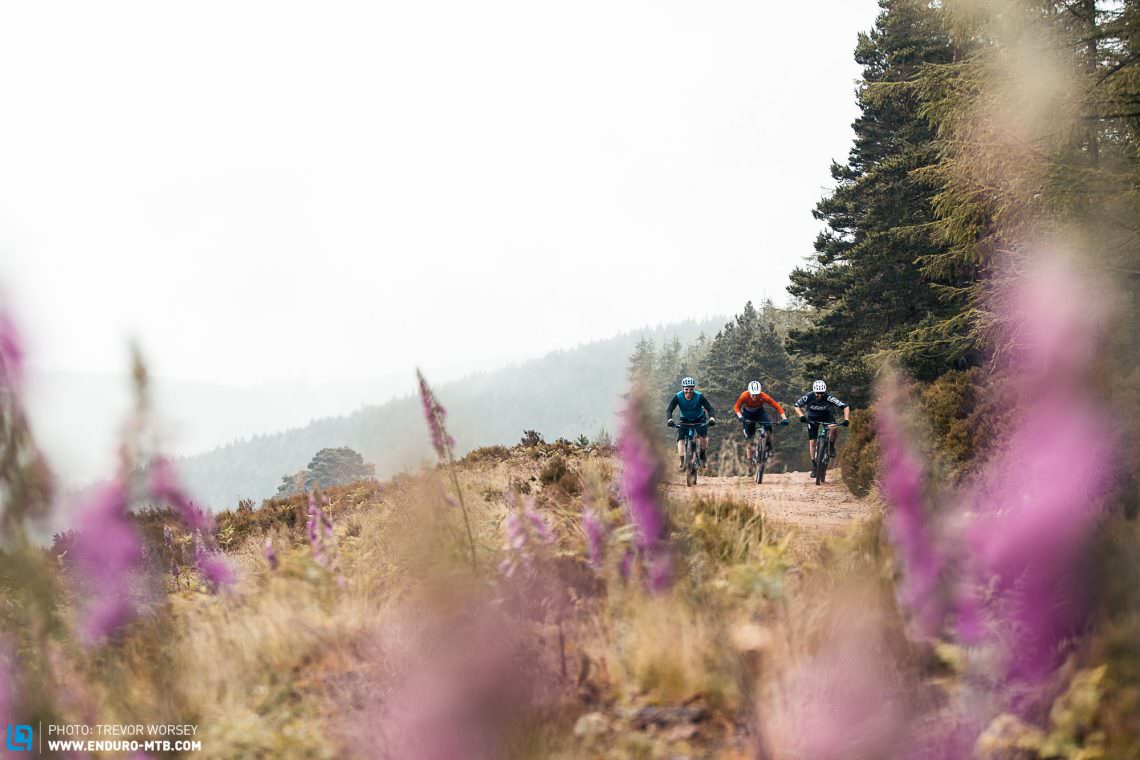
Does short-travel mean less fun?
Does short-travel mean less fun? No way! If your local mountains are more like molehills, and your Sunday ride involves long connections between the trails, a short-travel bike will be a quick-riding passport to adventure and endless fun. On flow trails, a short-travel bike will pump faster through compressions and stay higher in its travel, rewarding you with more smiles and heaps of excitement. On many rides, carrying extra travel only dulls the sensations and feedback from the trail, meaning less agile and engaging handling than a well designed short-travel bike can provide. While a 140–150 mm trail bike is a great choice for many riders, the best bikes in this test show it’s important to choose a bike based on where and how you want to ride, rather than just numbers on a spec sheet.
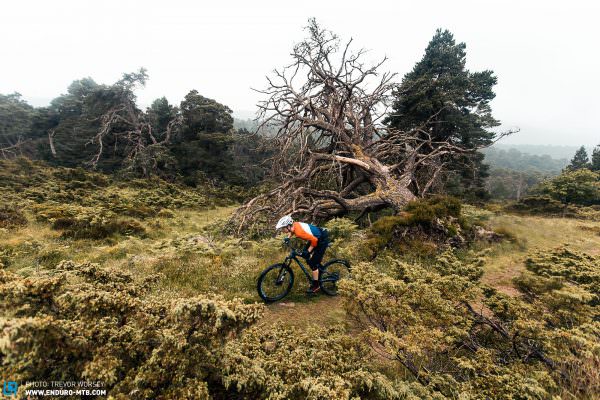
Imagine driving a Dodge V8 and a stripped out rally hatchback down a tight-twisty road. We can guarantee you’ll have more fun in the lighter, more agile rally car.
The short-travel trail bikes in this group test
For this group test, we wanted to include a diverse selection of bikes at a range of prices. On paper, all six bikes share similar geometry (with one exception) and range of application. All are 29ers, a wheel size that best suits the kilometre eating, corner railing nature of a good short-travel bike. The Specialized Epic EVO and Trek Top Fuel both mark a step up in versatility from dedicated XC race machines. They essentially take a racing platform but slack and stretch it out. The Whyte S-120C enters from the opposite end of the spectrum, packaging an enduro bike ethos in a short-travel chassis. Sitting in the middle, the Canyon Neuron, Merida ONE-TWENTY and Yeti SB100 are purpose built to be good at everything from marathon epics to fast laps of your local loop.

Suspension kinematics are important
The saying “It’s not about the size, it’s about how you use it” has never been more apt. With short-travel bikes, progressive suspension kinematics are essential. With less to play with, the suspension needs to maintain control and can’t give up all its travel too quickly. For active riders, the Merida ONE-TWENTY, Trek Top Fuel and Whyte S-120C excel with a supportive kinematics that give just enough travel to smooth out big hits and almost always retaining some reserves. The result is that these bikes provide massive support for pumping to generate free speed from the trail and also provide lots of feedback from the trail. In contrast, the Canyon Neuron and Yeti SB100 have more linear kinematics, sacrificing a little mid-stroke support in pursuit of comfort and control through rock gardens, as well as boosting comfort and reducing fatigue on longer rides.

Be suspicious of a low weight on the spec sheet
If you think that less travel equals less weight, you might have to reconsider. Given how hard we ride our bikes, both short- and long-travel bikes will actually require very similar components and in turn, it becomes hard to cut down weight without significant compromises in performance.
No matter if you have 100 or 150 mm of travel, you’ll still be riding effectively the same suspension units, need the same high-performance tires and will want to be able to brake just as quickly. Many brands make compromises to lower their bikes’ weight, saving a few grams on the scales by fitting inferior components. Brakes are often an easy and not immediately obvious downgrade. Fitting delicate 160 mm rotors on the rear and specifying smaller callipers might save 200–300 g, but the brakes still have to slow down the mass of a hard-charging 80+ kg rider. Do you ride a flow trail slower than an enduro trail? We don’t. Merida is the only brand to get this right, fitting powerful SRAM Code RSC brakes to their ONE-TWENTY. Tires are the next place to cut weight. While short-travel trail bikes do not need to come fitted with super heavy downhill casings, we still expect to see a versatile, capable and above all durable tire.
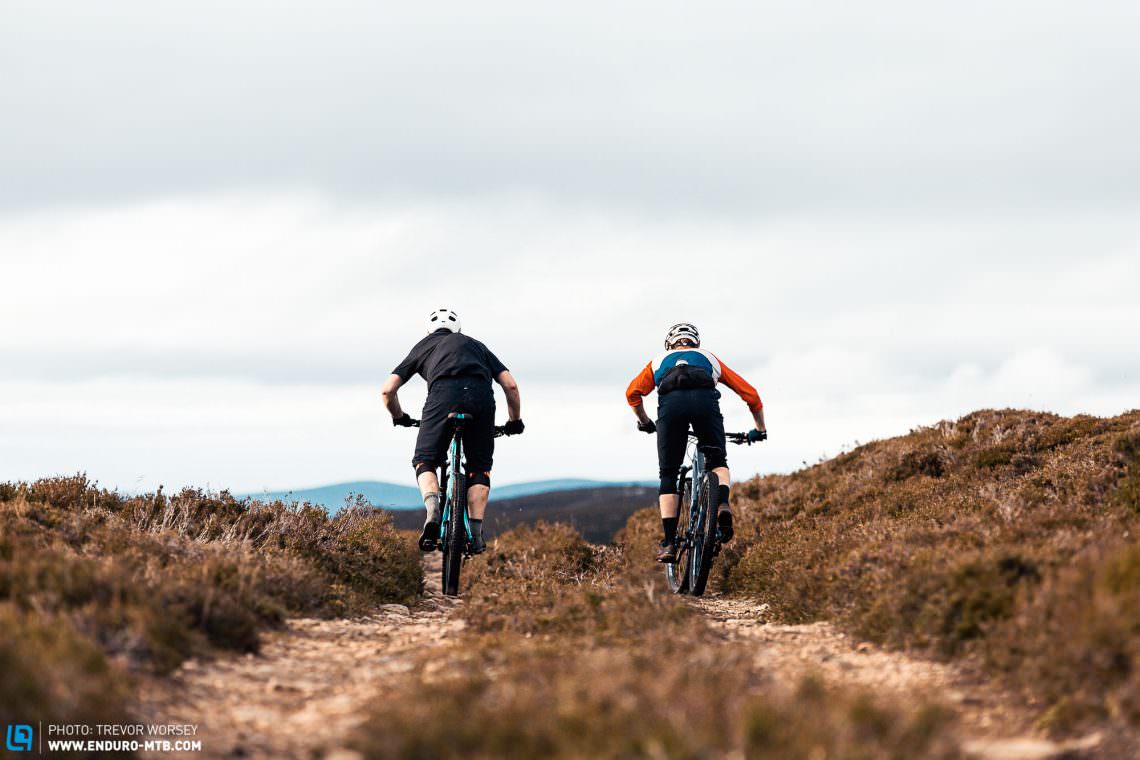
Carbon vs Aluminium Wheels
You can have a lighter bike without performance compromises but it will come at a cost. Spending more allows manufacturers to fit better components that reduce weight while maintaining or even improving performance. We are generally big fans of aluminium rims, especially on harder hitting bikes where they are more affordable if damaged and offer a smoother ride feel. However, lightweight carbon rims accelerate quicker and give the bike a more lively and agile feel, properties that in our test enhance the ride of our short-travel bikes. The Merida ONE-TWENTY 8000 scores well here, saving over 400 g on the combined wheel weight (4.38 vs 4.79 kg) when compared to the Yeti SB100 fitted with similar all-round tires. The Trek Top Fuel and Specialized Epic EVO both have very lightweight wheelsets, but also ‘cheat’ a bit by fitting lighter but less durable and versatile tires for combined wheel weights of 3.94 and 4.02 kg respectively.
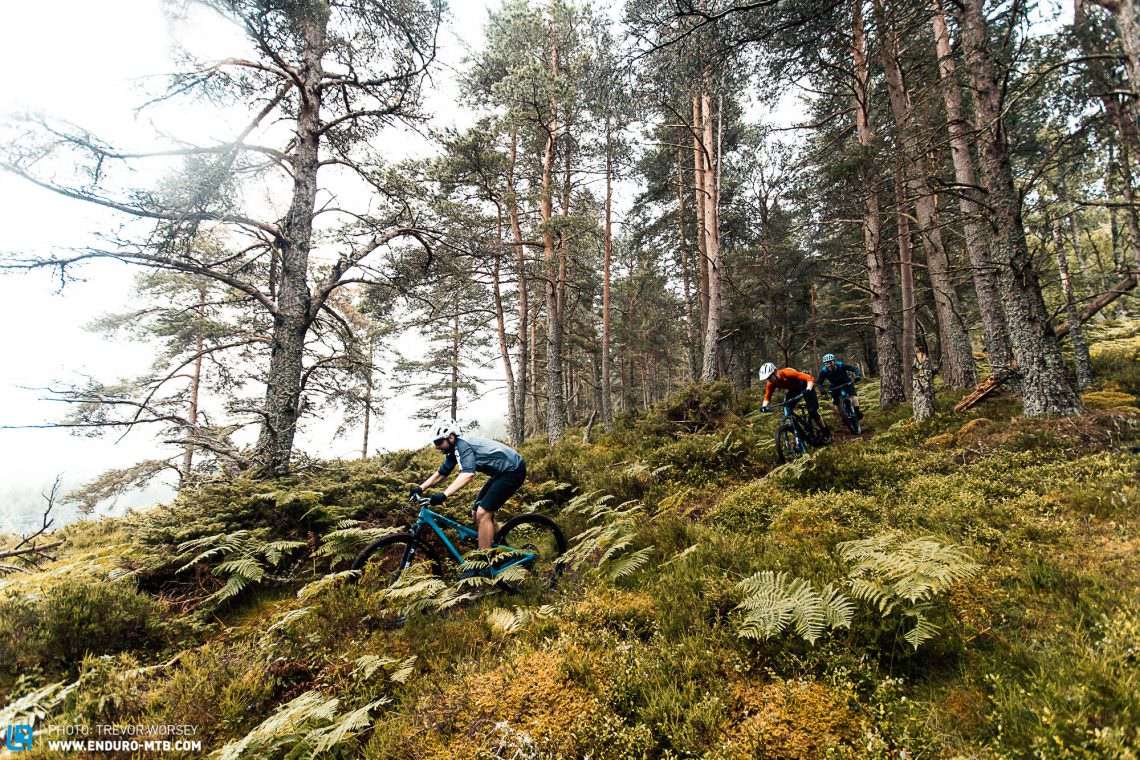
These bikes are made to climb fast so why don’t they have steep seat tubes?
This is a great question and one that consumed our team during much of our testing. The bikes in this group test have an average seat-tube angle of 74.8° , making them slacker than the latest geometry trends in trail and enduro bikes. The Merida again takes the win with a 75.5° seat tube angle, but still falls short when compared to the latest enduro bikes. Take the Yeti SB100: its 74° seat tube angle is far slacker than the newer and longer travel SB130 and SB150 which both have 77° effective seat tubes. It’s true that short-travel bikes sit higher at sag than long-travel bikes, reducing the effective seat tube angle less, but could they learn a lesson in efficiency from their bigger brothers? Yes, they could. All the bikes in this test climbed better with the saddle far forwards on the rails, indicating that slightly steeper seat tubes would benefit overall pedalling efficiency. We hope that short-travel bikes follow the steep seat tube trend that is sweeping through the trail and enduro sector.
Tops & Flops
Often small details can make a huge difference: seamless integration, first-class ergonomics and carefully selected parts. Easier said than done – here are some of the tops and flops from this grouptest.
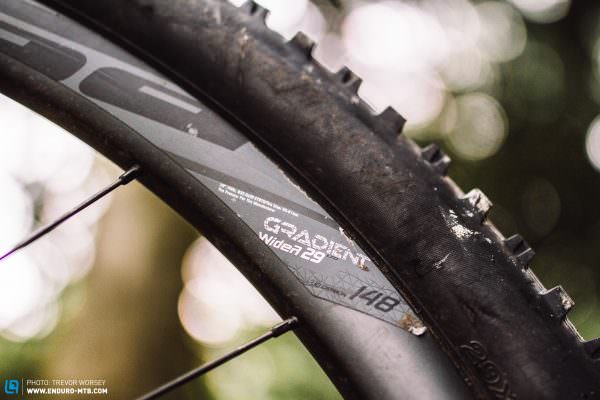
How we tested the bikes and where?
We packed the bikes into the back of a van and headed to the amazing trails of Ballater in the Scottish Highlands. Ballater is the hidden gem of Scottish riding, offering long flow trails, gruelling ascents and an iconic fast and furious ridgeline descent that is the perfect test of a short-travel ripper. We braved the Scottish midges and challenging weather conditions to push the bikes hard. Parts broke, tires were slashed but great fun was had. For a more thorough test of the bikes’ downhill performance, we also challenged them hard on shuttle assisted runs in the notorious Innerleithen bike park.
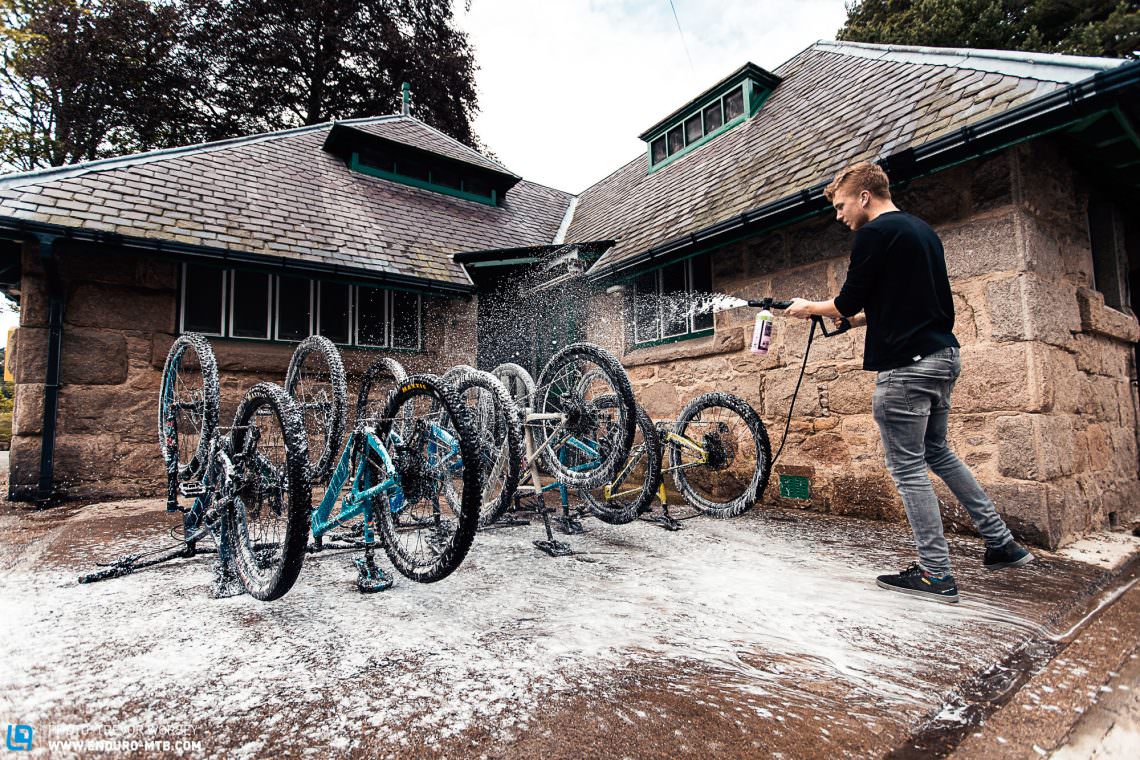
The test team

Six bikes with six very different personalities left us with many surprises. After extensive testing, the biggest surprise has been just how versatile short-travel bikes have become. Yes, many of the tires lacked grip and the brakes were weaker, but we soon found ourselves effortlessly straying onto full-bore enduro trails. The second surprise is just how much fun short-travel bikes are to ride. After-work rides become longer and big climbs are relatively speaking effortless. Staying high in their travel with supportive suspension, they turn even the most boring trails into a playground. Every compression is the opportunity to pump for more speed and every bump becomes the lip of a jump. If your trails are more flow than gnar, you’ll have more fun and smiles on a short-travel bike.

When it came to choosing our favourites, it was a tough call. With an XC oriented build kit, the Specialized Epic EVO was a beast on the climbs but it felt least at home on variable terrain. We also weren’t completely convinced by the Micro Brain shock, especially the noticeable delay before the inertia valve opens the compression damping under compression. The Canyon Neuron is the polar opposite: linear and efficient it would make a perfect bike for comfortable long tours but lacked spark when pushed to the limit. As is usual for Canyon, it does represent excellent value for money though. The Whyte S-120 C is the fastest bike on challenging terrain, where its progressive geometry and capable build kit give it an advantage that can be measured in seconds on the descents However, the uncompromising enduro specification and heavier wheelset is noticeable on the climbs when chasing the best in this test.
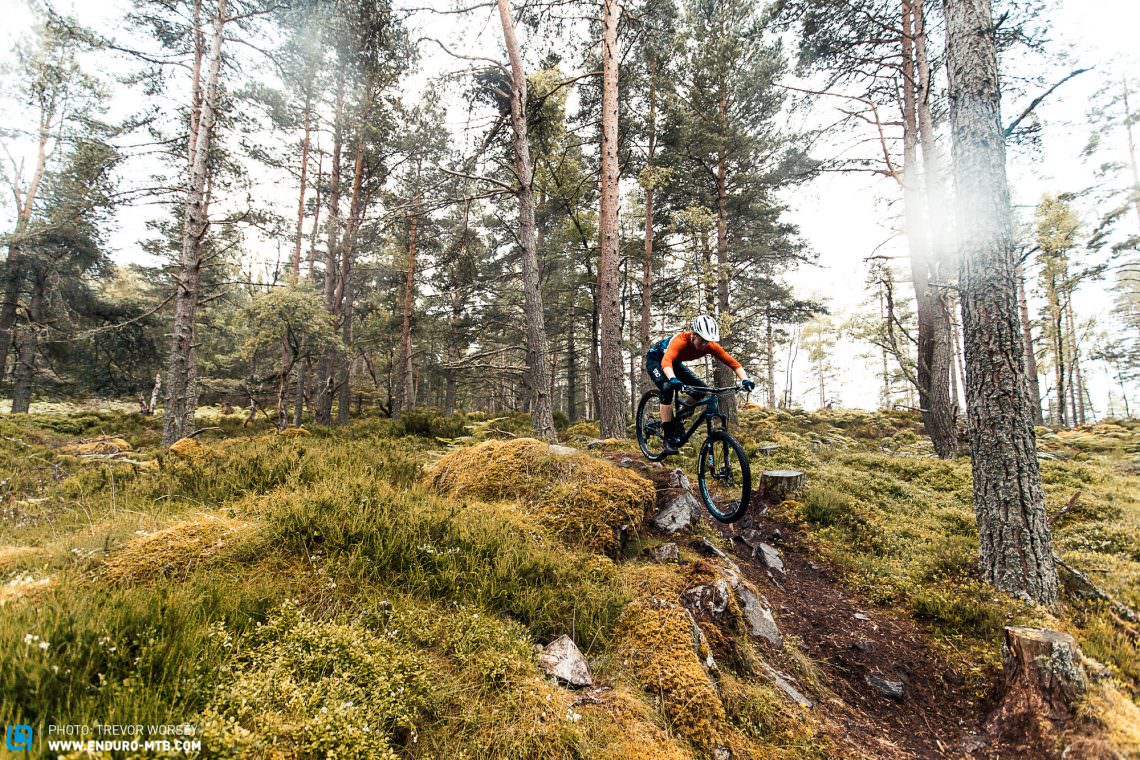
It was almost impossible to separate the top three bikes with all of them receiving high praise from the testers. The Trek Top Fuel is a testament to a new way of thinking. Potent, versatile and fiercely competitive, we can’t think of many situations where it would not excel. It was only the increased complexity of the TwistLoc (a grip shifter style suspension lockout) and the weak brakes that pushed it off the top spot. The Yeti SB100 was also a team favourite, blending effortless ground-covering efficiency with an easy-going playfulness that delighted all our testers. With a beautiful frame that deserves upgraded components, it’s a bike that we would be proud to own. For the first time ever, a Yeti takes our Best Value award. That leaves the Merida ONE-TWENTY : a versatile trail rocket that happily went everywhere and anywhere we took it. With a faultless build kit, great brakes, great suspension and an agile and engaging ride that will delight riders of all experience levels, there is nothing to fault, giving it the well-deserved Best In Test award.
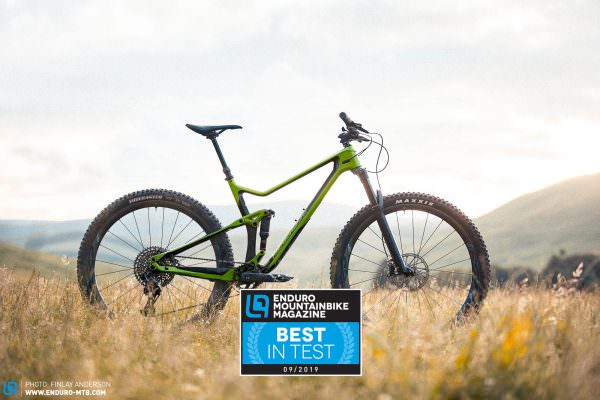
All bikes in test: Canyon Neuron CF 8.0 | Merida ONE TWENTY 8000 | Specialized Epic Expert Evo | Trek Top Fuel 9.9 | Whyte S-120C RS | Yeti SB100 C GX
If you’re looking for a bike with more travel you should definitely check our test about the best enduro bike of 2019: The best enduro bike you can buy
This article is from ENDURO issue #040
ENDURO Mountainbike Magazine is published in a digital app format in both English and German. Download the app for iOS or Android to read all articles on your tablet or smartphone. 100% free!

Did you enjoy this article? If so, we would be stoked if you decide to support us with a monthly contribution. By becoming a supporter of ENDURO, you will help secure a sustainable future for high-quality mountain bike journalism. Click here to learn more .
Words & Photos:
You may also like

Canyon Spectral:ONfly first test – Electrified do-it-all bike?

Don‘t think twice – The new ENDURO issue #061 is here!

BMB Raised Reversed stem on test – stem or control tower?

Roof top tent test – 12 ½ roof tents in direct comparison

NEWMEN Handlebar Advanced 318.25 VGS

Exclusive test: 2025 AMFLOW PL Carbon Pro – What is AMFLOW’s eMTB...
The new Spectral:ONfly is Canyon's lightest e-MTB ever
The Spectral:ONfly comes equipped with TQ’s HPR50 drive system and Canyon's K.I.S steering stabilizing system
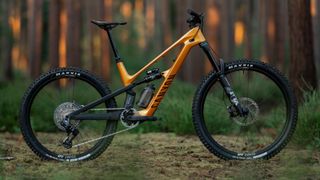
Canyon has released the lightest e-MTB its ever produced. The new Spectral:ONfly combines a TQ HPR50 motor with an e-MTB chassis capable of enduro-level riding, creating what could be its best e-MTB yet.
This isn't Canyon's first lightweight electric mountain bike ; it released the Neuron:ONfly earlier this year, which is equipped with a Bosch SX motor. The latest Spectral:ON is Canyon's first bike with a TQ motor – a system that saves considerable weight compared to most leading e-MTB motors . Despite offering more travel and tougher enduro-proof Category 4E strength, the Spectral:ONfly is significantly lighter than the 19.1kg Neuron equivalent, coming in at a claimed 18.1 kg in its lightest configuration.
More than low-weight numbers make the Spectral:ONfly stand out: burly specs, aggressive geometry, and Canyon's K.I.S technology across all four models.
The Spectral:ONfly 8, Spectral:ONfly 9, Spectral:ONfly CLLCTV, and Spectral:ONfly LTD will be available worldwide except for the US, which will just get the Spectral:ONfly CF 8 and the Spectral:ONfly CF CLLCTV model for now. Sizing goes from XS to XL, while pricing is competitive and starts at €5,599 / £5,199 / €5,599 for the CF 8 model and tops out at €8,999 / £8,349 for the CF LTD.
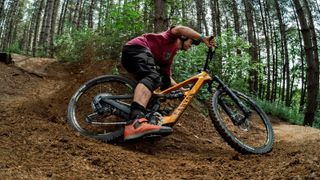
Canyon Spectral:ONfly frame and geometry
The Spectral:ONfly frame follows a similar format to the analog Spectral and Spectral:ON , equipped with 160mm front and 150mm rear suspension, mullet wheel setup, and Category 4E frame.
Geometry is similar too with a capable 65-degree head angle, 76.5-degree seat angle, and 440mm chainstay across all sizes. Reach has been increased by around 10mm across all sizes and the bottom bracket has been lifted by 5mm.
Canyon offer the Spectral:ONfly in four sizes: S, M, L, and XL. Those sizes accommodate riders from 166 cm (5’4”) to 200 cm (6’5”) tall.
There are no flip-chips to change geometry or alter the characteristics of Canyon's Triple Phase, four-bar rear suspension which is said to "smooth over small trail chatter, poppy and efficient thanks to its supportive mid stroke, and bottomless-feeling on the biggest hits."
One significant feature of the Spectral:ONfly is that all models will come equipped with Canyon's K.I.S 2.0 steering system. This is similar to the system first seen on bikes like the Canyon Spectral CF 7 K.I.S and stabilizes handling by recentering the wheel when riding through rough terrain which is claimed to offer predictable handling, filtering out front wheel deflections, and lowering rider fatigue.
The system is adjustable and all bikes will ship with a blanking plate, should riders prefer to hit the trails without K.I.S.
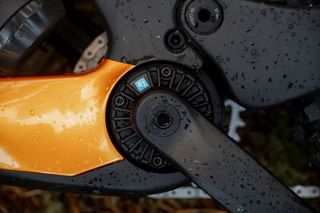
This is Canyon's first TQ-equipped e-bike. The HPR50 is a compact motor that offers up to 50 Nm of torque and 300 W of power. While this output is less than that of lightweight motors from Bosch and Fazua, TQ's HPR50 motor weighs just 1.85 kg and should give the Spectral a more natural riding feel.
The motor is paired with a 360 Wh battery, which can be boosted by up to 44 percent with TQ’s 160 Wh range extender. Battery range is hard to predict due to various influencing factors; however, Canyon claims it's possible to pedal up to 1,000 meters of elevation gain (based on an 85 kg rider, using 65% mid and 35% eco mode) per charge.
Battery life and other metrics can be monitored via a display in the top tube, and the TQ system can be paired with the TQ smartphone app to tune power settings.
The combo of a compact motor and small battery means the Spectral:ONfly has a very svelte frame shape that's almost indistinguishable from the unpowered Spectral.
Our take...
While it could be easy to write off the Canyon Spectral:ONfly as yet another sub-20kg eMTB in a sea of lightweight eMTBs . Not only could this be the best lightweight e-MTB that Canyon makes, but the specs and features like K.I.S mean the Spectral:ONfly stands out amongst the competition.
The Spectral:ONfly is claimed to weigh between 18.1kg and 19.5kg depending on which build you choose, it's not enough to better something like Scott's Voltage eRIDE 900 SL which is claimed to weigh just 17.9kg. That said, lower in the range, the Spectral:ONfly CF 8 is lighter, cheaper, and better specced than the equivalent Scott Voltage eRIDE 920.
For further comparison, Trek's eXE with 150mm/140mm of travel is said to weigh 17.47kg, and Mondraker's extremely expensive NEAT RR SL with 160mm/150mm at 17.9 kg, both of which use the same TQ motor. YT's Decoy SN MX Core 2 comes in at 20.4kg and the Trek Slash+ 9.7 SLX/XT is said to weigh 20.38kg, although these are designed to be full-on 170mm enduro bikes. For an idea of how it compares to Bosch SX powered bikes, the Whyte E-Lyte 150 RSX comes in at 18.9kg and Haibike Lyke SE at 18.5kg.
Canyon Spectral:ONfly release, pricing and spec
Canyon kicks things off with the Spectral:ONfly 8 that's priced at €5,599 / £5,199 / $5,999 and equipped with RockShox suspension, Shimano drivetrain and SunRingle wheelset. The Spectral:ONfly 9 gets Fox suspension and upgrades to an XT groupset and DT Swiss wheels. The Spectral:ONfly CLLCTV is the burliest build with Fox 38 forks, rather than Fox 36, SRAM GX Eagle Transmission wireless drivetrain, SRAM Code Silver Stealth brakes, and DT Swiss HX1700 LS wheelset. Finally, there is the Spectral:ONfly CF LTD with Fox Factory suspension, SRAM XX Eagle, SRAM Code Ultimate Stealth, and Reynolds Blacklabel Expert wheels.
All markets outside of the United States will be able to choose from all of the Spectral:ONfly CF models from September 12th. Canyon USA will offer a smaller product line, both the Spectral:ONfly CF 8 and CF CLLCTV models will be available for consumers in the States, beginning the first week of October.
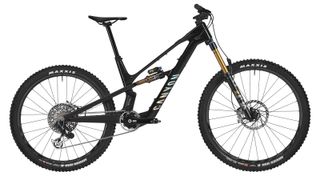
- Motor: TQ HPR 50 (300 W, 50 Nm)
- Battery options: TQ HPR V01 Battery (360 Wh )
- Fork: Fox 36 Factory, 160mm
- Shock: FOX Float X Factory
- Drivetrain: SRAM XX Eagle Transmission, 12-speed
- Brakes: SRAM Code Ultimate Stealth (200/200 mm)
- Wheels: Reynolds Blacklabel Expert
- Tires: F: Maxxis Minion DHR II 2.4 Maxxterra, EXO, R: Maxxis Minion DHR II 2.4 Maxxterra, EXO+
- Seatpost: Canyon G5 Dropper
- Cockpit: Canyon ON AL HB0057, 35 mm clamp (760 mm S, 780 mm M-XL)
- Colors: Dark Matter (P04)
- Bike weight: 18.3kg
- Sizes: S –XL
- Price: €8,999 / £8,349
Canyon Spectral:ONfly CFR LTD

- Fork: Fox 38 Performance Elite (160 mm)
- Shock: Fox Float X Performance
- Drivetrain: SRAM GX Eagle Transmission, 12-speed
- Brakes: SRAM Code Silver Stealth (200/200 mm)
- Wheels: DT Swiss HX1700 LS
- Tires: F: Maxxis Assegai 2.5 Maxxterra, EXO, R: Maxxis Minion DHR II 2.4 Maxxterra, EXO+
- Colors: Stadtwald Sunset (P03)
- Bike weight: 19.5kg
- Price: €7,299 / $7,499 / £6,799
Canyon Spectral:ON CLLCTV
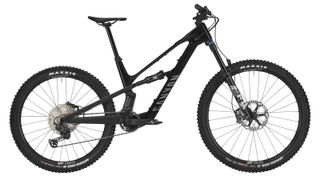
- Fork: Fox 36 Performance, 160mm
- Shock: FOX DPS Performance
- Drivetrain: Shimano Deore XT, 12-speed
- Brakes: Shimano Deore XT (203/203 mm)
- Wheels: DT Swiss H1900 LS
- Colors: Stealth (P01), Barely Olive (P02)
- Bike weight: 18.8kg
- Price: €6,299 / £5,849
Canyon Spectral:ONfly 9

Canyon Spectral:ON CF 8
- Fork: RockShox Lyrik Select, 160mm
- Shock: RockShox Deluxe Select+
- Drivetrain: Shimano Deore, 12-speed
- Brakes: SRAM Code R
- Wheels: Sunringle Trail Expert 329/327
- Bike weight: 18.9kg
- Price: €5,599 / $5,999 / £5,199
Graham Cottingham joined the BikePerfect team as our senior tech writer in 2020. With over 20 years of riding experience, he has dabbled in downhill, enduro, and gravel racing. Not afraid of a challenge, Graham has embraced bikepacking over the last few years and likes nothing more than strapping some bags to his bike and covering big miles to explore Scotland's wildernesses. When he isn’t shredding the gnar in the Tweed Valley, sleeping in bushes, or tinkering with bikes, he is writing tech reviews for BikePerfect .
Rides: Cotic SolarisMax, Stooge MK4, 24 Bicycles Le Toy 3, Surly Steamroller
Height: 177cm
Weight: 71kg
After three days of wild riding and partying, the EX Enduro proves why it's the UK's number one 'must ride' MTB race weekender
Voodoo looks to be working some serious money magic with their latest Canzo and Canzo Pro full-suspension bikes
Endura Women’s SingleTrack Lite shorts review – superb baggies for warmer days
Most Popular
- 2 After three days of wild riding and partying, the EX Enduro proves why it's the UK's number one 'must ride' MTB race weekender
- 3 POC Ventral Air MIPS helmet review – MIPS performance and POC comfort with uninterrupted airflow
- 4 Husqvarna Mountain Cross 5 e-MTB review – can the Swedish moto specialists compete with tried and tested bike brands?
- 5 The WTB Macro XC tire – will this race-ready rubber go straight to the front of the pack? I tested them to find out

IMAGES
VIDEO
COMMENTS
Saddle is a bit too racy. Not that light for a down-country bike. The Neuron is Canyon's back-to-basics trail bike, newly updated for 2023, There are four carbon and four alloy models to choose from, with prices starting from £1,849 for the Neuron 5 and going up to £5,749 for the Neuron CF LTD.
The Best Trail Mountain Bikes. ... This 150mm travel bike has been a mainstay in the Santa Cruz line for nearly a decade and was updated for the 2022 model year with a revised geometry and a move to mixed wheel sizes, also known as mullet or MX. ... The Norco Optic C2 is a short travel bike with an aggressive geometry that is an absolute blast ...
Orbea - Oiz H20. Best XC Full-Suspension Mountain Bike. Aluminum / 12-Speed Shimano Deore / 29×2.35″. MSRP: $3,599. Jenson USA. Fork: Fox 32 Float Rhythm, 120mm travel. Shock: Fox i-Line DPS Performance, 120mm travel. Wheels: Orbea OC1 25c. The Orbea Oiz H20 is a sleek full-suspension XC bike built for speed and efficiency.
Top five 2022 short travel mountain bikes 2022 Giant Trance in Victoria, BC, November 26, 2021. (Photo by Nick Iwanyshyn) Giant Trance Advanced Pro 29.
The Revel Rascal XO Transmission is a wildly capable bike that employs the Canfield Brothers Formula suspension and some cutting-edge thermoset carbon technology. The geometry gives this bike a playful disposition, while its suspension allows you to really push the limits of a 130mm travel bike. The bike's numbers are modern enough to make it versatile but not so modern that it loses its poppy ...
The Epic is the quintessential XC bike, and then there's the Epic Evo. It's like the regular Epic, but after it's had a few vodka Red Bulls. The Evo gains an extra 10 millimeters of travel in the front, loses a degree in the head angle (68.5-degrees) and consequently 10 millimeters in reach (446 for a large).
A longer wheelbase has added a sense of security for your descents. Whereas the old Ripley would have gotten squirrely, the new version minds its manners and handles the cornering efficiently. It was easy to choose the Ibis Ripley as our Best Short Travel Bike of 2021.
Style: Trail Mountain Bike Frame: Full Carbon, 120mm travel, with Maestro suspension system Wheel Size: 29" Fork: Fox 34 Performance Elite Live Valve, 130mm Rear Shock: Fox Performance Elite ...
The Best Mountain Bikes of 2022. Rigs to put a smile on anyone's face. Published May 27, 2022. Travis Engel. from Outside Online Share. Copy link; Email; ... Short on travel, big on shred. The Spectral 125 is one of the most capable, short-travel 29ers on the market. With a quick-climbing, ultra-efficient pedaling performance and progressive ...
Weight: 30.75 lbs. The capability of short travel bikes is becoming wildly impressive and with the new Santa Cruz Tallboy, as things are getting dialed. It is available in three different frame materials, so that no matter your budget, you can ride this trail basher. Santa Cruz is raising the bar when it comes to the short travel 29" world.
1 1. HeatedRotor FL (Oct 26, 2022 at 10:02) these look One step up from real gravel bikes (xc bikes) so well done on picks. 3 4. succulentsausage FL (Oct 26, 2022 at 10:12) Hilarious to see people ...
The best trail bike of 2022 - Introducing 14 of the most exciting bikes of the season in our big 2022 trail bike group test. ... Good to know: the Spectral CFR secured victory in last year's "Best Mountain Bike of 2021" group test, thus entering the race with a huge responsibility on its shoulders. ... Short-travel dropper posts ...
Best Downcountry Trail Bike: Specialized Epic 8 Evo Comp. Best Hardtail for Trail Riding and Bikepacking: Salsa Timberjack XT 29. Best E-Mountain Trail Bike: Specialized Turbo Levo Comp Alloy. Best Value in a Full-Suspension Trail Bike: Ari Cascade Peak Pro. Best Entry-Level Trail Bike for Beginners: Salsa Rangefinder Deore 11 29.
Yeti SB120 T1 GX X01. $7,600 at Jenson USA. Although the new SB120—a 29er trail bike with 120mm rear travel and a 130mm fork—replaces the SB115 as the Yeti's shortest-travel full suspension ...
The Giant Trance 29 3 is an excellent trail bike, and our Top Pick for Short Travel in this price range. This 29er may only have 115mm of rear-wheel travel paired with a 130mm fork, but that doesn't slow this bike down. In fact, this playful and lively ripper is a quick climber and downhill shredder. The Trance 29 is one of a new breed of ...
It's also fair to say the Reactor isn't the fastest-climbing short-travel bike out there. But the Giga probably isn't the most efficient among 170 millimeter+ bikes either.
And with a bit of luck, some of it might actually be available to buy! Hottest mountain bikes for 2022. With the Raaw Jibb, Pivot 429 and Guerilla Gravity Trail Pistol, to name just three, there's definitely no shortage of scintillating new hardware coming onto the market next year. We've put together a list of the 12 up-and-coming best ...
The best trail bikes for 2022 are: Best all-rounder - Trek top fuel 8: £3,850, Tritoncycles.co.uk Best for versatility - Speicalized stumpjumper comp alloy: £2,850, Sigmasports.com
We divided 2022's winning bikes into four main categories: Gravel, Road, Commuter, and Mountain. Click on the buttons below to see our top picks for 2022 in each category, access full reviews for ...
Best Enduro Bike: Canyon Spectral 29 CF 9. Strong and tough enough that you could ride the Enduro World Series on this bike, and pedally enough to be a one-bike quiver, the mid/long-travel ...
The 27 best trail bikes of 2024 as ridden, rated and reviewed by our expert testers, and buyer's guide. ...
There are many mountain bikes on the market with the same technical specs as the bikes in this test. However, we were a lot more interested in the brands' intended uses. ... Our evaluation criteria for the best downcountry bike of 2022 ... Therefore, in addition to short seat tubes and long-travel dropper posts, you should be able to insert ...
The Merida again takes the win with a 75.5° seat tube angle, but still falls short when compared to the latest enduro bikes. Take the Yeti SB100: its 74° seat tube angle is far slacker than the newer and longer travel SB130 and SB150 which both have 77° effective seat tubes.
This isn't Canyon's first lightweight electric mountain bike; it released the Neuron:ONfly earlier this year, which is equipped with a Bosch SX motor. The latest Spectral:ON is Canyon's first bike with a TQ motor - a system that saves considerable weight compared to most leading e-MTB motors. Despite offering more travel and tougher enduro ...